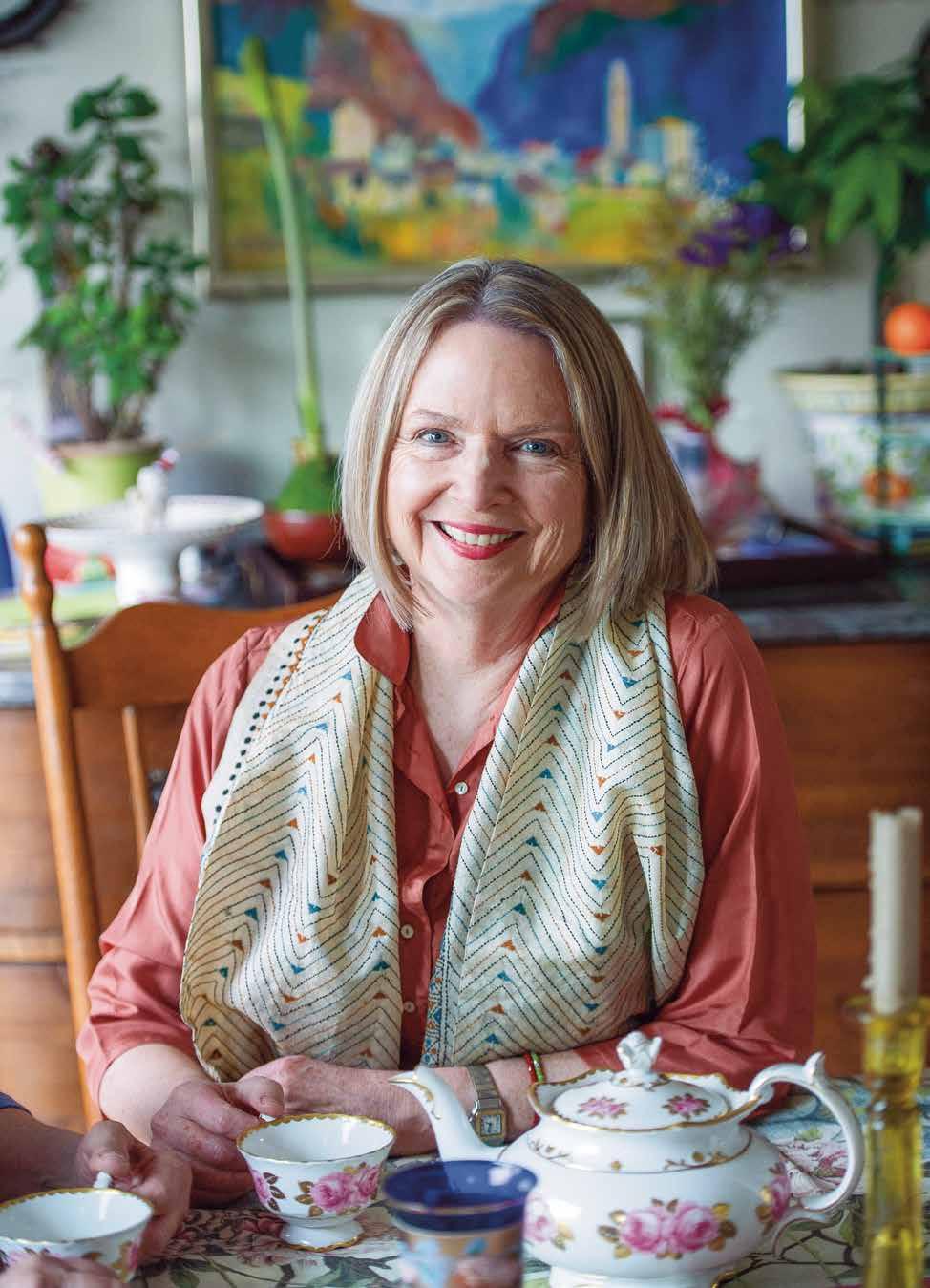
Frog Holler: A Happy, Hoppin’ Place • Floral Designer Susan McLeary • Eating for the Climate • Take a Mindful Hike • Stories from the Farm • Music in a Baby’s Growth • Pokeweed Hekate • Life Coach Susan Young • San Slomovits on Antisemitism • Caring for an Aging Parent: It’s Complex • Babywearing 101 • Science for Kids • Sadist Summer Camp • Handcrafting a Porcupine Sunglass Case • Interdimensional Healer Kelly Campbell • Yoga Column • Community Calendar • And More Rhythm: Good for What Ails You • The Power of Community Gardens Empowered Bumps and Boobs • Intervulnerability: Practicing Love May M Through august 2024 a - Issue 86 I the Crazy WIsdoM CoMMunIty Journal southeastern MIChIgan’s ConsCIous lIvIng MagazIne FREE Jody Tull –The Journey of a Long-Time Ann Arbor Yogi
Twenty-nine years of local businesses in the spotlight.
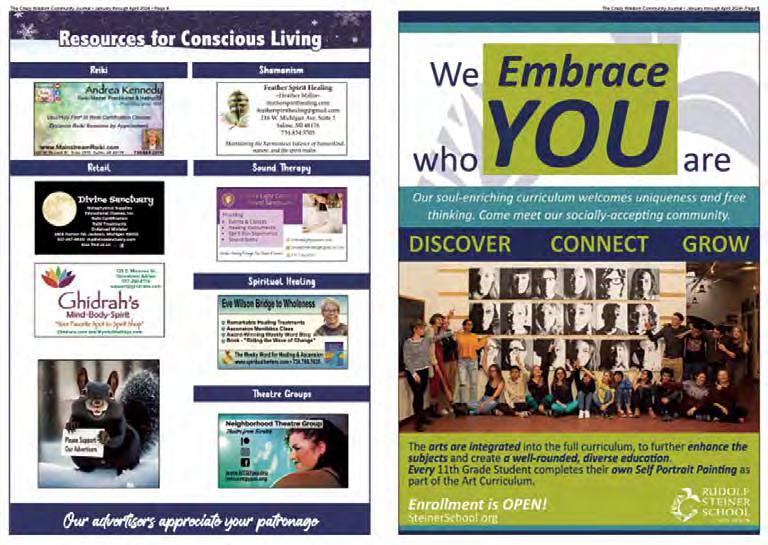
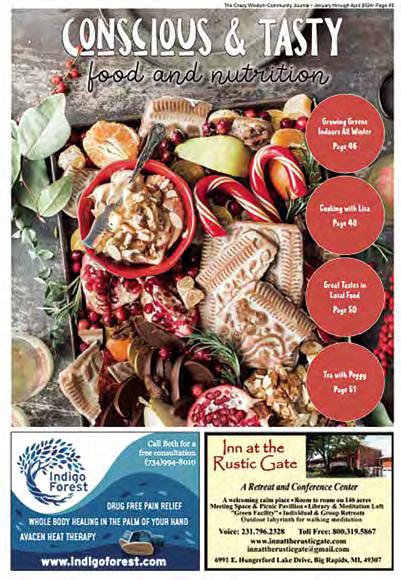
This year, for the first time, we have created advertising packages that will dramatically expand your reach in the Southeastern Michigan community. The Crazy Wisdom Community Journal, supports advertisers with a readership of over 25,000 and a distribution network of over 235 businesses in four different counties. The Crazy Wisdom Monthly, our online publication, is continuing to grow with a readership of 35,000+ per month! Your advertisement will appear in ALL of our media:

Plus, our online marketing is constantly expanding the publication’s viewership. These include:
•Weekly paid Facebook/Instagram posts promoting our articles, and with live links.
•Our Facebook trailers promoting our publications receive 26,000+ views each month.
• The Crazy Wisdom Community Journal
•The Crazy Wisdom Journal Online
•The Crazy Wisdom Community Journal, an Online Magazine
•And The Crazy Wisdom Monthly Online
•All Online Magazines include a link to your business.
Learn more at crazywisdomjournal.com/advertise







NORTHERN SKY AND BEYOND, LLC
Astrology with Alice
Charts • Readings • Star DNA
www.northernskyandbeyond.com
info@northernskyandbeyond.com


Rob Meyer-Kukan, LMT
Bodywork: sound therapy, massage, reiki, reflexology, color therapy, & natural health consultations




Natural Healing Center 2002 Hogback Rd. Suite 14
Ann Arbor, MI 48105
734-649-2891 (C)
denisebheld@gmail.com
www.a2re exology.com
exology
Breathwork

Jackie Miller
Certified Breathwork Facilitator
thisbreath.com
734-883-7130 / jackie@thisbreath.com
Ann Arbor & Ypsilanti, Michigan

The Crazy Wisdom Community Journal • May through August 2024 • Page 1
Acupuncture Astrology/Chart Services
7notesnaturalhealth. com 248-962-5475 contact@7notesnaturalhealth.com 3830 Packard Road Suite 120 Ann Arbor, Michigan 48108
734.892.8809 Birth
Bodywork/Bodymind Therapy
www.facebook.com/A2Re
Resources for Conscious Living










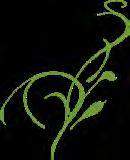




The Crazy Wisdom Community Journal • May through August 2024 • Page 2 CHÉRIE ANN McMULLEN Holistic Health Practitioner Nutritional Consultations Vitamins/Herbs/Homeopathy 734-355-5369 2223Cherieann@gmail.com Equine Therapy Holistic Health Expressive Arts Therapy Diamond Approach Resources for Conscious Living Diamond Approach Michigan A Journey from Ego to Being Lou Weir, Diamond Approach Teacher
diamondworkmichigan.org Intuitive Coaching Ruth Wilson Intuitive Coach Personal Training to Develop Your Inner Magic 248-990-1902 www.ruth-wilson.com Book a Consult: https://go.oncehub.com/Ruth-Wilson Life Coaching Grief Resources for Conscious Living ADS are a super affordable way to advertise in print and online! Contact Tana at tana@crazywisdom.net for more information. Dance Dance • Healing • Illumination • Unity • Love Nia • Gentle Nia • Dance for PD Assisted Living Classes • Wild Woman Work meagaindance.com • megansims600@gmail.com RAVENSONG COUNSELING Individual & Small Group Sessions for Ages 10+ www.ravensongcounseling.com (734) 604-7074 Equine Therapy at Hidden Creek Healing Farm Believe in your journey Kate Roos, MAAT, ATR, TCTSY-F Movement & Art Therapy www.kate-roos.com734-221-0202 A Trauma Informed Practice For Teens and Adults Catalyzing revolutionary healing through Trauma-Informed Homeopathy Intrinsic Coaching Holistic Health Education Kellie Mox, MPH, DCHM, CCH Kelliemox.com heal@kelliemox.com | 734 - 476 - 0349 Free,20-minuteexploratorysessionfornewclients
diamondworkmichigan@gmail.com

Resources for Conscious Living
Life Coaching
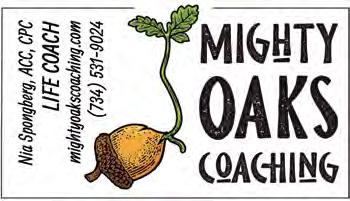
Mental Health

Mindful Coaching

Julie Woodward
Wellness Coaching
Mindfulness Hikes
Yoga Classes
julie-woodward.com

• julie@julie-woodward.com

Physical Therapy







Reflexology






The Crazy Wisdom Community Journal • May through August 2024 • Page 3
Psychotherapy/Trauma Therapy



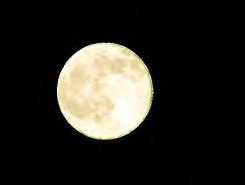

36 N. HURON ST. YPSILANTI MI 48197
734-905-7980 www.evenstarschalice.com








There was a magic about the sea. People were drawn to it. People wanted to love by it, swim in it, play in it, look at it. It was a living thing that was as unpredictable as a great stage actor: it could be calm and welcoming, opening its arms to embrace its audience one moment, but then could explode with its stormy tempers, flinging people around, wanting them out, attacking coastlines, breaking down islands.
—

The Crazy Wisdom Community Journal • May through August 2024 • Page 4 Our advertisers appreciate your patronage Retail Resources
Divine Sanctuary Metaphysical Supplies Educational Classes, inc. Reiki Certification Reiki Treatments Ordained Minister 1826 Horton Rd. Jackson, Michigan 49203
mydivinesanctuary.com Also find us on Spiritual
Theatre
Spirit and Nature Festivals
for Conscious Living
517-247-8400
Healing
Groups Theatre from Scratch from Neighborhood Theatre Group www.NTGYpsi.org info@ntgypsi.org Rolfing ROLFING ®️ Certified Advanced Rolfing® Erik Emanuel Fenz (734) 623 - 0028 erikfenz@gmailcom BODHIBODY.com
RELICS GALLERY ARTS SACRED SWAG
Cecelia Ahern everyday enchantments & inspiration DIVINE WARES VINTAGE
Reiki






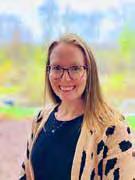


The Crazy Wisdom Community Journal • May through August 2024 • Page 5 HELPING BRING BALANCE TO YOUR FINANCIAL LIFE Sam Maness, CFP® Financial Advisor Sam.Paul.Maness@ raymondjames.com Jason Coleman, CIMA® Financial Advisor Jason.Coleman@ raymondjames.com Emily Rice Relationship Manager Emily.Rice@ raymondjames.com Joelle Emery Branch Associate Joelle.Emery@ raymondjames.com Justin Rice Investment Manager Justin.Rice@ raymondjames.com Independent Local Thoughtful Advice Securities offered through Raymond James Financial Services, Inc. member FINRA/SIPC. McLaren Wealth Strategies is not a registered broker/dealer and is independent of Raymond James Financial Services. Investment Advisory Services offered through Raymond James Financial Services Advisors, Inc. www.McLarenWealth.com For all of us, time marches on. You may have been managing your finances successfully for many years. You may still feel you can manage the funds but would like some oversight to help you out as things change. Perhaps you want someone who will listen, take good care of you, and not push you into the product of the day. Check with us to discuss how our services might help to reduce your stress at a very reasonable cost. 315 E Eisenhower Parkway Suite 301 Ann Arbor, MI 48108 Phone: 734-944-7556 Fax: 734-661-1314
In This Issue ~ the Crazy WIsdoM CoMMunIty Journal
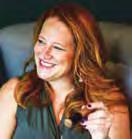
Kindred Conversations ~ Kelly Campbell, Interdimensional Healer by Hilary Nichols Page 17

We Don’t Talk About Bruno by Marie Duquette Page 18

The Wisdom of Depression by Kyle Nicolaides Page 22

Goddess of Borderland, Mistress of Crossroads: Pokeweed-Hekate by Dianna Rhyan Page 42

Holler Fest — A Happy, Hoppin’Place by Hilary Nichols Page 68

Cooking with Lisa by Lisa Viger-Gotte Page 76

The Symphony of Development — Exploring the Importance of Music in a Baby’s Growth by Emma Wymer Page 92

Goddess of Borderland, Mistress of Crossroads — Pokeweed-Hekate by Dianna Rhyan Page 22
Rhythm — Good for What Ails You by Susan Slack Page 38
Holler Fest — A Happy, Hoppin’Place by Hilary Nichols Page 42
Imagine Fitness and Yoga — Getting and Staying Fit with Support and Community by Sandor Slomovits Page 48
Jody Tull — The Journey of a Long-Time Ann Arbor Yogi by Grace Pernecky Page 50
Intervulnerability — Practicing Love at the University of Michigan Art Museum by Kirsten Mowrey Page 66
Caring for an Aging Parent — It’s Complex by Ellen M. Craine Page 70
Stalker — A Spiritual Film in the Eyes of an Atheist by Audrey Hall ..................................................................................... Page 104 Page 12
Personal Essays CWJ
The Magnolia Blooms Spoke by Samantha Beidoun Page 16
We Don’t Talk About Bruno by Marie Duquette Page 17
The Wisdom of Depression by Kyle Nicolaides Page 18
My Life Has Been Shaped by Antisemitism by Sandor Slomovits Page 20
Columns CWJ
Kindred Conversations ~ by Hilary Nichols
Susan McLeary, Floral Designer - Author - Educator Page 10
Kelly Campbell, Interdimensional Healer Page 12
Out of My Comfort Zone ~ Beyond Comfort: Marrakesh, Entrepreneurship, and Self-Discovery by Susan Young Page 14
Sustainable Health ~ Take a Mindful Hike by Julie Woodward................................................................................. Page 19
What’s New in the Community ~ by Lynda Gronlund Page 24
Leaps of Faith ~ by Laurel Decker Empowered Bumps and Boobs Page 34
All Creatures Great and Small ~ Stories from the Farm — Sheep: Our Sweet Wooly Babies by Karen Quinn Page 36
Our Yoga Column ~ Namaste, Katie by Katie Hoener ..................................................................................... Page 47

Motherhood as a ReVillaging Rite of Passage by Miriam Dowd-Eller Page 108
Spirit Seeds by Triana Jones
Handcrafting Column ~ Porcupine Sunglass Case by Jennifer Carson Page 64
Green Living ~ More Life, Less Stuff by Thea Lona Hassan Page 72
Astrologically Speaking ~ Taking it Personally—The Inner Planets: Mercury, Venus, & Mars by Catherine Carlson Page 106
Spirit Seeds by Triana Jones Page 108
Crazy WIsdoMJournal.CoM
The Crazy Wisdom Community Journal • May - August 2024 • Page 6
Features CWJ
on our
as
This issue will be posted
website
of May 1, 2024


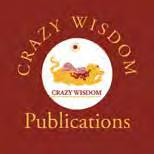

The Crazy Wisdom Community Journal • May - August 2024 • Page 7 On the Cover The Crazy Wisdom Kids Section Starts on Page 73 Children’s Book Picks..................................................................Page 73 Babywearing 101 — A Crash Course in Safety, Comfort, and Ease by Kaili Brooks Page 74 The Symphony of Development — Exploring the Importance of Music in a Baby’s Growth by Emma Wymer ........................................................................... Page 76 Sadist Summer Camp by Amy Lagler Page 78 Kids in the Community ~ Science for Kids by Christine MacIntyre Page 80 Kids Section CWJ The Crazy Wisdom Calendar Section Calendar Edited by Kaili Brooks Starts on Page 84 The Calendar Page 84 Our Calendar Editor’s Picks of Interesting Happenings in our Community Page 85 Background Info on the Teachers Page 100 A Shamanic View of Ancestors — The Power Within by Judy Ramsey ............................................................................. Page 89 Motherhood as a ReVillaging Rite of Passage by Miriam Dowd-Eller Page 92 The Calendar CWJ Advertiser Directory Page 8 Resources for Conscious Living Starts on Page 1 Advertisers CWJ Conscious and Tasty Eating and Nutrition CWJ Food Section ......................................................................... Starts on Page 55 Cooking with Lisa by Lisa Viger-Gotte Page 56 Tea with Peggy — Mindfulness and Tea by Peggy Alaniz Page 57 Spiedo With Love by Hilary Nichols Page 58 Cultivating Connection — The Power of Community Gardens By Lisa Viger-Gotte Page 60 Eating for the Climate By Crysta Coburn Page 62 Visit These Local Farmers Markets This Summer! Page 63 This issue is distributed starting in the last week of April. The deadline for Free Calendar submissions for the September through December 2024 Issue #87 is Monday, July 15, 2024 Contact calendarforms@ crazywisdom.net The deadline for reservations for Paid Advertising is Monday, July 29, 2024 Contact tana@crazywisdom.net The Crazy Wisdom Community Journal has been published three times a year since 1995. Copyright © Crazy Wisdom, Inc. — April 2024 No parts of this publication may be reproduced for any reason without the express written approval of the publisher. There is a token fee charged if you would like to use an article in this publication on your website, so make sure to contact us first. Articles from back issues are available on our website’s archive. Crazy Wisdom was founded in 1982. Since 1989, it has been owned by Crazy Wisdom, Inc., which consists of Bill Zirinsky and Ruth Schekter. Publisher/Editorial Director Bill Zirinsky Senior Design and Production Editor Carol Karr Design and Production Editor Jennifer Carson Managing Editor/Staff Coordinator Jennifer Carson Advertising Sales Manager Tana Dean Distribution Richard Knapp, Paul Stehle Editing Jennifer Carson, Michelle McLemore Calendar Editor Kaili Brooks Writers Peggy Alaniz, Kaili Brooks, Catherine Carlson, Catherine Carr, Crysta Coburn, Laurel Decker, Marie Duquette, Madonna Gauding, Lisa V. Gotte, Lynda Gronlund, Katie Hoener, Joshua Kay, Amy Lagler, Christine MacIntyre, Michelle McLemore, Kirsten Mowrey, Irena Barbara Nagler, Hilary Nichols, Grace Pernecky, Sandor Slomovits, Artwork Jennifer Carson, Karen Quinn-Markwart Photography Senior Photographer: Linda Lawson Susan Ayer, Mary Bortmas, Tom Closs, Kate Jackman, Hilary Nichols, Edda Pacifico, Joni Strickfaden, Rachael Waring Serving the Community Since 1982 info@crazywisdom.net crazywisdomjournal.com Listen to the interview AADL Talks To: Crazy Wisdom Crazy Wisdom Bookstore 114 S. Main St. Ann Arbor, MI 48104 See website for hours crazywisdom.net 734.665.2757
Jody Tull The Journey of a Long-Time Ann Arbor Yogi Book Reviews CWJ Book Review: Weedy Wisdom for the Curious Forager: Common Wild Plants to Nourish Your Body & Soul — by Rebecca Randall Gilbert Book Review by Christine MacIntyre Page 97 Book Review: Obsessive Intrusive Magical Thinking by Marianne Eloise Book Review by Christine MacIntyre Page 101
Cover Photo by Edda Pacifico


School


The Crazy Wisdom Journal provides an amazing platform for us to reach our community in a way that digital media and other technologies simply cannot. As a newly-opened Cannabis Microbusiness, we were very fortunate to have the platform like this to connect with health-conscious Ann Arborites who value local, natural products. —Eric Parkhurst, Winewood Organics








Leslie Science & Nature Center is honored to continuing being a part of this critical local publication. Personally, I love reading CWJ, both the digital and print publications. There is something special about the people featured within both journals. I feel more connected and appreciative of the individuals and business who care for and celebrate the world around us. The consistency of intimate personal stories, alongside deeper philosophical conversations that I really enjoy!
Thanks, Crazy Wisdom Journal, for continuing to seek out and feature all of the incredible people making our community special!
—Susan Westhoff, Executive Director Leslie Science and Nature Center and Ann Arbor Hands on Museum
The Crazy Wisdom Journal is such a blessing to the area's holistic community! It's the one place you can go to find out about places, events, products, and practitioners of alternative and metaphysical pursuits in the Ann Arbor area. I especially love their in-depth articles, which allow for a real experience of whoever is the focus. Even the ads are a great exploration of the community's offerings. Many people have told us they've seen our ads and articles about us in the CWJ. We are grateful to be a part of such an important publication!
The Crazy Wisdom Community Journal • May through August 2024 • Page 8 Krasnick Regenerative Medicine 31 Leslie Science & Nature Center and Ann Arbor Hands-On Museum 81 Life Empowerment Coaching/ Maria Sylvester 91 Living Wisdom Coaching/Ikaro Phoenix 5 Lydia Adams 3 McLaren Wealth 5 Me-again Dance Wellness 2 Melisa Schuster, LMSW 1 Michelle Camilleri 3 Michigan Collaborative for Mindfulness in Education 79 Mighty Oaks Coaching/Nia Spongberg, ACC,CPC 3 Monica Turenne / Four Paws Veterinary 9 Moving Stories/Stefanie Cohen 69 Natural Healing Center/Denise Held 1 Neighborhood Theatre Group 4 NITE - Naturopathic Institute Back Cover Northern Sky and Beyond/ Alice Davinich 1 Peaceful Dragon School 67 People’s Food Coop 55 Ravensong Counseling 2 Rob Meyer-Kukan, LMT / 7 Notes Natural Health 1 Ronora Lodge & Retreat Center 5 Roos Roast 59 Rowena Conahan 4 Rudolph Steiner Schools 65 Ruth Wilson 2 Shaman Tom 78 Sing Ann Arbor......................................................................................39 Spirit and Nature Festival, Song of the Morning 4 Stephen Rassi / Chrysalis Facilitation and Counseling 3 Susan McGraw / Divine Inspiration at Work 61 Suzy Wienckowski / Reiki 4 This Breath / Jackie Miller 1 Transitions LLC / Linda Bender..............................................................3 Triple Crane Monastery 51 Winewood Organics 107 Yoga Focus Collective 63 Yuliya’s Naturals 2 Amrita Farms 94 Ann Arbor District Library 11 Ann Arbor Holistic Resource Guide 31 Ann Arbor Rec & Ed Adult Fitness 69 Ann Arbor School of Massage 86 Beth’s Body Works 13 Castle Remedies 13 Chérie Ann McMullen 2 Chris Nordin Fine Art Gallery 27 Conscious Light Documentary 15 Crazy Wisdom Poetry Circle 99 Deep Spring Center...............................................................................27 dellAureo Wellness 13 Diamond Approach Michigan/ Lou Weir 2 Divine Sanctuary 4 Dr. Raymond Kong / Acupuncturist 1 Dynamic Points Acupuncture / Henry Buchtel 1 Ellen Crane Counseling 61 Emanuele Acupuncture Center 1 Enlightened Soul Center 61 Erik Fenz 4 Eve Avrin 3 Eve Wilson 4, 53 Evenstar’s Chalice 4 Fox Hollow Tales 75 Frog Holler Farm 55 Ginger Chase Massages 1 Great Lakes Herb Faire..........................................................................21 Grove Emotional Health 63 Healing Hands Physical Therapy 3 Humane Society of Huron Valley / Tiny Lions Inside Back Cover Indigo Forest 35 Interfaith Center for Spiritual Growth 13 Jessica’s Apothecary 39 Joyful Spirits Reiki 3 Judy Ramsey/ Heart to Heart Animal Communication 5 Julie Woodward 3 K. West Skin Body Spirit 105 Kate Roos, MAAT, ATR 2 Keeley Ward 2 Kellie Mox 2 Advertiser Directory Advertise in The Crazy Wisdom Community Journal and reach over 25,000 loyal readers in southeastern Michigan interested in a healthy, holistic, and conscious lifestyle! Advertising, for over 20 years, in The Crazy Wisdom Journal has been a resource that keeps my business, Peaceful Dragon School, connected with a community of those looking for self-care and wellness methods that will augment their more traditional health support.
—Wasentha Young, Peaceful Dragon School
Tai Chi and Qigong Enrich Your Health Reduce Stress and Improve Balance Peaceful Dragon School 1945 Pauline Blvd., Suite B Ann Arbor, MI 48103 Phone: 734-741-0695 info@peacefuldragonschool.com www.PeacefulDragonSchool.com Peaceful Dragon
Ongoing Classes Begin September 11 Ongoning classes, private, and off-site classes for adults and teens. Serving Ann Arbor Since 1990 Visit our website for the complete schedule of classes NEW CLASS! Tai Chi for Teens Par�cipants will playfully explore the basic body mechanic principles, and get their relaxa�on and focus "on" with the mindful movement of Tai Chi.
Expand Your Business Horizons! Join our family of satisfied advertisers ... It is a beautiful time to come PLAY Leslie Science & Nature Center Rentals, Summer Camp, Preschool, Birthdays, Critter House, Family Programming and more! Our trails, Raptor enclosures and Nature Playscape are always free & open sun up to sun down. Together, we provide Moments of Discovery for everyone in our community. discoverscienceandnature.org Ann Arbor Hands On Museum Open six days a week 10 am—5 pm Memberships available Museums for All $3 admission for (EBT/WIC card holders)
—Amy Garber, Enlightened Soul Center & Shop
Meet Some of Our Creative Team
We sincerely appreciate all the talent that gets put to work to bring you the best Crazy Wisdom Community Journal three times a year. Look for us to highlight some of our contributors in every issue in this space.
Triana Jones is the founder of Spirit Seed Center, a virtual space for learning. She is a single mother, a Wounded Healer, Eclectic Witch, and practicing Spiritualist. She received her first oracle deck from her grandfather sixteen years ago and has been reading cards professionally for the past seven years. In 2023, she was certified in Quantum Healing Hypnosis Therapy and Herbalism. Look for her new spiritual knowledge column, Spirit Seeds on page 106.
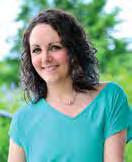

Katie Hoener has been writing for The Crazy Wisdom Community Journal as the yoga columnist since fall 2016. She is an E-RYT 200 and RYT 500, with her yoga certifications from Sun Moon in Ann Arbor. Additionally, Katie is a Master’s Level Social Worker and proudly works for Washtenaw County Community Mental Health. Katie is passionate that yoga is available and supportive to everyone in their journey to truth, recovery, and wholeness.
Sandor Slomovits is one of the twin brothers who comprise Gemini, the nationally acclaimed children’s music duo. Since 1973 Sandor, with his brother Laszlo, has toured the US and Canada and they have released over a dozen award-winning recordings and a concert video. Sandor also plays music with his daughter, Emily and is a freelance writer for a number of local and national papers and magazines.

Hilary Nichols has a Creative Writing degree and a 20-year photography business. After a decade producing and performing with the circus and backpacking across five continents, she is perfectly happy to hold her focus and raise her teen kid here, mostly. Hilary’s photos have graced many covers of The Crazy Wisdom Community Journal as well as beautified her column, Kindred Conversations. See her latest profile of interesting people in our community on page 10.

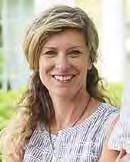
Christine MacIntyre is a Jackson Countybased writer, photographer, and otherwise creative spirit. She is an avid reader, nature enthusiast, and animal lover. Christine writes our book reviews and is our Kids in the Community Columnist. Check out her suggestions for local programs, books, and at home science fun for families on page 80.
Kaili Brooks is an Ypsilanti native and current student at the Eastern Michigan University German program, as well as the new editor of The Crazy Wisdom Community Journal calendar of events. She is a new mom to a one-year-old and passionate about intentional living, fiber arts, baby wearing, and holistic health.
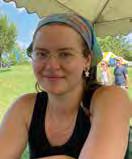

The Crazy Wisdom Community Journal • May through August 2023 • Page 9
Kindred Conversations with Hilary Nichols

Susan McLeary
FLORAL DESIGNER - AUTHOR - EDUCATOR
By Hilary Nichols
It was a passion flower that first stopped Susan McLeary in her tracks. The exotic flower ignited her passion and initiated her purpose toward becoming a florist, a designer, an artist, and an author. Yet, educator is the title Susan McLeary identifies with most these days.
McLeary orients around her calling to teach with rightful pride, having put a lot of thought into what it means. “As a teacher,” she mused. “You get an idea, usually it comes from something else you’ve seen. You think about it, you pick it apart, and make it your own. And then, I deliberately decided you share it with the world. I call it catch and release.” It is surprising to hear of such a non-traditional and generous business model, but McLeary is not a traditional businessperson—she is an innovator in her field.
Like many florists, McLeary came to the field nearly by accident. “I didn’t have any inclination to become a florist. I made jewelry for friends that were getting married, and one asked me to do her flowers.” She took to it like a natural, but when she announced the new direction, her friends were dubious. “It wasn’t thought to be an artful profession. There was no framework for being an interesting florist.” Taking it as a challenge, she began her investigation. “I tried to find people doing artistic or interesting flower arranging. I saw examples in Europe and Asia, but it wasn’t accessible.” She knew there was a niche to be filled here.

Like many florists, McLeary came to the field nearly by accident. “I didn’t have any inclination to become a florist. I made jewelry for friends that were getting married, and one asked me to do her flowers.” She took to it like a natural, but when she announced the new direction, her friends were dubious.
Susan McLeary started Passionflower in Ann Arbor in 2010 and expanded her offerings from centerpieces to large installations swiftly. Her work stood out right away. From a startup to a sought-after business, Passionflower was thriving.
“Her soulful, seasonally inspired creations have been described as exquisite living artwork,” is lauded on her webpage. “There was a time that I enjoyed the adrenaline of weddings, but it didn’t suit my personality. It was too intense,” she realized after eight arduous seasons. “I wanted to break out of this expected thing. I wanted to be part of elevating the industry.” Driven to innovate, she believed the role of a florist could be transformed. “I was working to flip the power dynamic, from doing what the clients’ requested, to becoming the artist.” There is an undeniable spark in her face when she talks about not only making art but making artists. “Florists are just coming into their own. They are just starting to see themselves as artists—and once you claim that, everything changes.”
“It all led pretty quickly from doing the thing to becoming a teacher of the thing,” she declared. McLeary began to teach exclusively in 2018. She shifted from Passionflower to her eponymous new business, Susan Mcleary, and began offering her on-line classes, virtual-studio presentations, and in person workshops around the world. It keeps her on her toes. “Every month I am thinking of projects that will give my membership group new ideas, artful techniques, and fresh processes to let them make new artistic stuff right away.” Having to share new stuff regularly might seem daunting for many, but McLeary trusts the process. She watches what is most inspiring in fashion, in


art, in cultural aesthetics, and in the flower world to craft and share new and interesting things all the time. “The more you share ideas, the more new ideas come to you.” And Susan McLeary is known for her new ideas.
It was in this period that McLeary introduced a line of succulent jewelry. “It was really a vibe,” she recognized. Her Instagram presence took off and the publishing house, Chronicle Books, took notice and offered her a book project. Her first book, The Art of Wearable Flowers, is a guidebook with instructions to make her floral wearables.
Her husband of 22 years, Chaad Thomas asked, “Shouldn’t you trademark your work, instead of spreading it across the industry?” But McLeary was quick to reaffirm her model. “That is not the spirit of an artist or the spirit of a teacher. The spirit of a teacher is to find something good, fine tune it, and release it. Copyrights put you in the mindset of scarcity.” McLeary has other mindsets to propagate.
“It feels way better to just be at peace with the fact that nothing is worth clenching [onto] so tight.” To McLeary it is both a spiritual practice and a practical one. She is as devoted to her craft as any great practitioner. “It’s like anything,” she said. “Like baking bread. With repetition it comes to you.” She is humble but not satisfied. It is not her temperament to rest on her laurels. She doesn’t simply do her job well, instead she finds ways to undo her job.
The Crazy Wisdom Community Journal • May through August 2024 • Page 10


“Any limitation becomes a creative path to go down,” she said. Michigan florists know limitations. The flower growing season here is only half the year. “What if I only have hyacinth? How many things can I do with it?” Turning it over, taking it apart, testing it in different ways, using different mechanics, and in different scenarios, she discovers new ways to approach her work. McLeary carries out these flower studies as a creative practice. It is a way to free up ideas and let wild concepts come to life.
Every artist has to combat some fears first to find their own expression. On her web page McLeary shares: “It took years to bring forth all the weird ideas I had in my head—to stop worrying about what people will think. The more courage you have to be yourself, the more people will respond to your work. Trying to appeal to everyone, your work becomes watered down. It loses its soul.”
Turning it over, taking it apart, testing it in different ways, using different mechanics, and in different scenarios, she discovers new ways to approach her work. McLeary carries out these flower studies as a creative practice. It is a way to free up ideas and let wild concepts come to life.
Flowers do touch our souls. They elevate any situation immeasurably. McLeary understands their effect. “I aim to give people pause, to make them curious, and allow them to experience the wonder of nature through the medium of flowers.” It’s a wonderful affirmation that there is beauty in this world. Flowers are so pure, they seem above reproach. “One would not think the floral industry is a dirty industry. But it is,” McLeary reminds us. Environmental concerns do mar the industry from the shipping impacts and soil concerns to the wasteful single-use products that florists typically amass at any given event. The product called floral foam is ubiquitous and as McLeary discovered, it is unnecessary. “My personality really loves identifying pain points of the industry and then chopping away at the solutions and offering my findings.”
Accent Decor, a major purveyor of wedding props, invited McLeary to collaborate on a number of products to relieve the need for single-use materials. The most notable is a six-foot-tall stand with up to six water vases attached for foam-free mechanics that is easy to break down, transport, and store. She’s working to give the industry tools to become more artful and more sustainable. Her students know that these are her central tenants. “Developing practical, relevant design applications is my focus. My mantra is compostable or reusable” all while being distinctly beautiful and unique, of course. The bar is high.
Her artistic eye elevates a common concept into something awe-inspiring that evokes the grandeur of an Italian courtyard, or the lush effects of a field of wildflowers.

This September, McLeary will introduce a workshop locally at Marilla Field and Flora with Dani Vignos of University Flower Shop. It offers a deep dive into the design principles we find common in every visual art: principals like proportions, scale, balance, rhythm, and visual flow. “And then we go into the rule of thirds and the golden ratio which is my favorite thing to talk about in the entire world.” Without realizing it, this is what we admire in her work. Her artistic eye elevates a common concept into something awe-inspiring that evokes the grandeur of an Italian courtyard, or the lush effects of a field of wildflowers. These arrangements are designed methodically and with care to move you in a way that is carefree.
As a teacher and a community member, McLeary does not gate keep. She wants to offer us all access to the act of making. Keep an eye out for her upcoming series of local Market Day Workshops. Flower fans and everyday appreciators can receive her kind-hearted instruction in crafting centerpieces and flower crowns while the local flower farms are in high season.
As Susan McLeary and I wrapped up our conversation, she put the finishing touches on an innovative bouquet that she had been crafting all the while. It is flower heads plucked and thread along strands of pretty copper wire wrapped into a handle. The flowers draped like a weeping willow in an elegant form while held in the hand. “Or,” she showed me. “You can wear it as a head piece.” She draped the light blossoms over her red hair like a living fascinator—a fleeting fashion that evoked the freshness of spring as it flattered her bright blue eyes. Elevated and effortless, it seemed thought and experience came together to spark her imagination that culminated in these new presentations. “I know a piece is worth developing when it is both emotive and meaningful. It must have meaning.” As the lavender petals rest just above her eyebrows, I acknowledged, this dynamic headpiece filled my heart with a playful light.
Susan Mcleary is the author of The Art of Wearable Flowers and Flowers for All: Modern Floral Arrangements for Beauty, Joy, and Mindfulness Every Day. You can find all her workshops and live presentations @susanmcleary.com.
The Crazy Wisdom Community Journal • May through August 2024 • Page 11

Kindred Conversations
 By Hilary Nichols
By Hilary Nichols
Everything you would expect, and yet so unexpected. My interdimensional healing appointment with Thirteen Rings was out of this world. When Kelly Campbell welcomed me into her charming studio, the space was as open and conducive as a therapist’s office, but it also swirled with the presence of something more.
Thirteen Rings is in downtown Chelsea in a second level office space. There are candles lit, crystals collected on the tables, and a sage bundle ready to smudge the space. With long vibrant red hair and wearing a lightning bolt sweater, Campell has an obvious kindness and a witchy spark. She is inviting and comfortable in that typical, down-to-earth Midwest way. Campbell might debate that description because her planetary placement is not so earthbound. Rather, in her own eloquent way, she makes it clear that her orientation in time and space is hard to describe in mere words. Her perspective accommodates all-time in present tense, and her access to information comes from places unseen. She is an open channel that is better described by quantum physics than common knowledge. Her knowledge is anything but common, but that’s what makes her so well suited to her craft.
I was introduced to Campell at a fire circle where she honored the four directions and the phase of the moon. When I found out she was an interdimensional healer my curiosity increased. Before finding out what that even meant, I made an appointment. From her website I read, “Together we will discover the root of physical ailments and conditions, transform your physical health, address and heal personal and generational trauma, break ancestral patterns, and transform core beliefs.” I was intrigued.
Campbell knew she was ‘tuned-in’ as early as eight years old, from the number of times adults asked her incredulously, “How did you know that?” Her response, “Because I know,” indicated much about her uncommon access. At a slumber party that year, she was playing with an old-fashioned phone. “When I picked it up, there was a voice on the other side. It said ‘Hello’ like it was expecting me.” This is how Campbell remembers first becoming aware of her otherworldly connection. “But my mom responded just as fast, telling me, “That isn’t possible, and it isn’t true.” That’s when Campbell got the message. The outside world made it clear her connection to the paranormal wasn’t acceptable, and so she shut it down.
Campbell knew she was ‘tuned-in’ as early as eight years old, from the number of times adults asked her incredulously, “How did you know that?” Her response, “Because I know,” indicated much about her uncommon access.
Twenty years later she was ready to acknowledge her interest and found a socially acceptable approach to do so. Campbell leaned into her love of astrology and began reading astrological charts professionally. But soon enough it became clear that her reports came from more than the alignment of the stars. She was feeling her client’s pains, and beyond that, she was able to deduce more than physical hindrance, but the emotional story that corresponded. As this became more of a focus of her sessions, she determined that she was working more as a medical intuitive. The work just presented itself. “This blew me away.” She reported about an experience with a client that was having discomfort in her pelvis. “I asked her what the sensation felt like. And she said it felt cold and dark. That corresponded with what I was tracking,” she said. “That’s when my Somatic Experiencing training came into play,” Campbell told me. Somatic Experiencing® Therapy, as described on the Embody Lab website, was developed by Dr. Peter A Levine. It is described as a naturalistic and neurobiological approach or a body–mind therapy, focused specifically on healing trauma by drawing clients’ awareness to their bodies.”
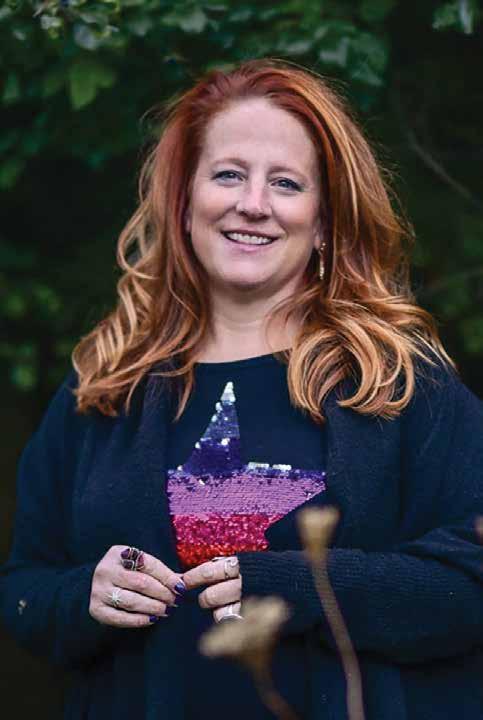
“It is cold and dark—great,” Campbell exclaimed. “So, I went to seek the void and found that what was missing was with her parents. Her parents had a piece of her that didn’t belong with them; it belonged with her. And so, my guides let me know we are going to move it across this timeline and give it back to her. And along with my guides and archangels, we recovered it.” There is so much to unpack in this recounting, “great” may be an understatement. I think mystifying is a better description. But trying to understand isn’t the goal. I can appreciate her work as I appreciate string theory, without any actual understanding. Instead, I just had to experience it myself.
Campbell made me comfortable with a cup of tea and a little conversation as I settled in for my appointment. And then she asked me why I was there. When I responded, “just curious” she took the lead, asking “Do you have any ailments?” I pointed to a small genetic condition that nagged, and that was all she needed as our access point. Right away she asked about my father. “Is he still with us?” Surprised to hear he had passed, she let me know, “He is so present here, I felt that you two had spoken on the phone today.” That gave me chills. It was with my father that I shared this condition. Of course I had to ask, “How could you know?” Campbell’s smile said it all. “I just know,” was the simple answer. But digging in, I was able to get more. “It is a combination of seeing, feeling, knowing, and internal messages spoken in phrases,” she told me. “If something is out of balance or deregulated, those are the messages that will come through.”
Along with my “well and wise ancestor,” as she referred to my deceased father, and our guide the Archangel Haniel(divine healer of families and relationships) Campbell shifted her focus to the unseen realms. With her eyes closed and hands active, she leaned back as she narrated the action vibrantly, like an animated drama. She told me how they had identified and cut-out old chords
The Crazy Wisdom Community Journal • May through August 2024 • Page 12
Kelly Campbell Interdimensional Healer
continued....
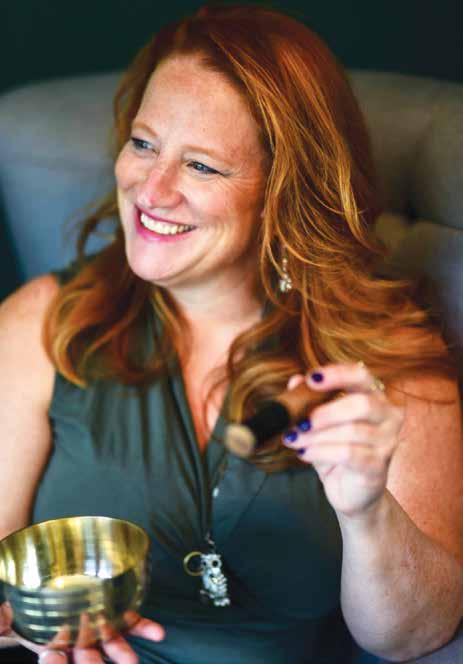
“I spend most of my time moving through different dimensions and timelines, healing lineage and generational trauma, and clearing the burdens, afflictions, and shame that we hold, individually and collectively.”
and aided me in releasing emotionally based traumas that had wound around my nervous system to exacerbate my physical discomforts.
As an interdimensional healer she channels information through Source and is shown what will be the most healing to that person at that time. “As I align, the guides just begin to show up,” she told me. On her website, she describes her process as working “with archangels and with ancestors through Source. In this way I am able to address ancestral trauma, lineage disruptions, energetic cording from people, places, things, and events—all of these conditions cause significant disruption in our physical and energetic bodies.”
It isn’t easy to describe but Campbell has become comfortable with the indescribable. “I spend most of my time moving through different dimensions and timelines, healing lineage and generational trauma, and clearing the burdens, afflictions, and shame that we hold, individually and collectively.”
At home at her altar is where she spends that time, in a daily practice to keep the conduit clear. She lights candles, picks a tarot card, honors her ancestors framed on the wall, and recognizes the phase of the moon and key planetary alignments that influence each day. Like becoming fluent in a foreign language, it takes devotion, and she is clearly devoted to sharing this gift far and wide.
For greater outreach, Campbell is conducting a series of group sessions to clear commonly held concerns. There will be group meetings for each course: Family, Health, and Money held over Zoom. This is a way to benefit from this work more comfortably from your own home and more deeply over four sessions.
“The North node indicates one’s dharma, life path, and evolution. It is where you are headed.” Campbell described to me from her star chart. “My north node is ruled by Uranus which reflects qualities of innovation. And Uranus has thirteen rings, so that is where the business name comes from.” With her interdimensional healing energy, and empowered by the planets, Kelly Campbell shares with her Thirteen Ring clients, “You will come out of this space a healthier, more powerful, more joyful, more present, and more authentic you.”
I am astonished to feel the effects—relieved of the ailment, lighter with a new clarity to call on, and grateful to have had the visit from my dear departed dad as well.
Learn more about Kelly Campbell at thirteenrings.com.










The Crazy Wisdom Community Journal • May through August 2024 • Page 13
2345 South Huron Pkwy, Ann Arbor • CastleRemedies com Your trusted source for 3rd party tested nutritional supplements, herbs, homeopathic remedies, flower essences and essential oils 10% Senior Discount on Tuesdays! Established 1984 Save $10 on our Intro to Homeopathy class with code CRAZYWISDOM discover whole self integration Life Coaching + Bodywork Lisa Patrell Discovery Calls are gratis 734-274-6737 dellAureowellness.com Sunday Celebration Services 10:45-12:15
Concerts, Movies and Drum Circles
Study Groups, A Course in Miracles, Science of Mind, Sufi Gathering & more
Service and many classes available via live stream 704 Airport Blvd., Suite 1 Ann Arbor, 48108
Monthly
Weekly
Sunday
Out Of My Comfort C Zone Z

The Crazy Wisdom Community Journal asked a number of leaders in southeastern Michigan’s conscious living community to reflect upon times in their lives that they’ve left their comfort zones to venture out in new ways. In the distant past or much more recently, we asked, what did you do, what inspired you, did it change you, inside or outside, big or little? Did you attend a new class, take an adventurous trip, go skydiving, stretch beyond a long entrenched boundary, start a new relationship, or end an old one, take a leap, retire, join the Peace Corps, go on a night trek in the wilderness, or just do something way out of the ordinary?
Beyond Comfort: Marrakesh, Entrepreneurship, and Self-Discovery
Susan Young is a certified Holistic Life Coach for midlife women. Passionate about the magic of the right brain, she blends coaching with creative processes to help clients tap into their intuition and get to the heart of what matters most, ensuring that their goals (and souls) are 100% aligned. She supports clients through one on one coaching, workshops, and retreats. You can reach her by emailing susan@ triplemooncoach.com, visit her online at triplemooncoach.com or fnd her on Instagram @triplemoon_coaching.
By Susan Young
In the heart of Marrakesh, seated at a long table laden with tangerines and wafting aromatic delights, my discomfort was palpable. Surrounded by a group of 12 artist participants, all connected by history and relationships, I, the lone traveler, introduced myself. “Hi, I’m Susan from Ann Arbor and am here alone.” To which the entire group immediately replied, “No, you’re not?!”
The day would have marked my 27th wedding anniversary had it not been six months after finalizing my divorce. I was a whirlwind of emotions, acknowledging the weight of this date, and reflecting on the seismic shifts in the last several years of my life. There was grief, yes, but also an unusual serenity, coupled with a tingling anticipation for the trip ahead. I would forge connections with remarkable creatives from around the world—breaking bread together, savoring farm-to-table delicacies lovingly crafted by a master chef. My soul would be nourished by the camaraderie, the awe-inspiring scenery, the sketches, paintings, lessons, and the rich tapestry of culture.

The day would have marked my 27th wedding anniversary had it not been six months after finalizing my divorce. I was a whirlwind of emotions, acknowledging the weight of this date, and reflecting on the seismic shifts in the last several years of my life.
While I couldn’t have imagined the life affirming experience that unfolded, I certainly wouldn’t have fathomed that the discomfort (and pain) of the events leading up to this point, were a mere precursor to what lay ahead.

My journey through discomfort began earnestly in 2015 when I decided to stop drinking and sought therapy for the first time at the age of 49. This seemingly small step set off seismic shifts, ultimately leading to the dissolution of my 26-year marriage in the summer of 2020, coinciding with the onset of a global pandemic, lock down, and an empty nest.
Within weeks, I transitioned from being a spouse and mother in our 25-year home to solitary living in a nondescript apartment by the mall. Meanwhile, the shutdown of manufacturing in Michigan led to a 30% layoff for the commercial interiors company where I worked as a workplace consultant. I was grateful to be among the 70%. While no furniture was being produced, pending projects were left unfinished, and remaining employees were left scrambling to manage the aftermath remotely. As was the case for most of us, I settled into a new normal. Before long, I left the apartment and bought a house.
During the pandemic’s lockdown, the rediscovery of long-abandoned art supplies from design school for art journaling became a creative outlet and
The Crazy Wisdom Community Journal • May through August 2024 • Page 14

frankly, a lifeline. As my practice evolved beyond journaling, I set up a studio space in my new home, tapped into the local artistic community, co-founded a local chapter of Urban Sketchers, and settled into a new post-growth normal. Yet, amidst this creative contentment, the realization that my job had become a source of dread prompted a soul-searching quest for meaningful work. The idea of becoming a life coach for women emerged, leading me to enroll in a holistic, ICF-certified coach training program which opened up new avenues of expansion and growth. The process became a healing journey connecting me with like-minded individuals globally. Recognizing the impossibility of juggling a demanding job, coach certification, and a start-up, I made a bold (some might say crazy) decision to resign and dedicate my efforts to my business and the next chapter in my life.

From my experiences, I’ve come to recognize three distinct types of discomfort and three ways in which it can manifest, each associated with different levels of vulnerability and unease.
Confronting something new and unfamiliar: slightly scary, yet promising personal growth. It encourages us to take a leap, despite the fear, as a path to growth.
A mismatch with core beliefs arises from attempting something not aligned with core beliefs or identity. Filtering the input through a gut check is essential to avoid unproductive discomfort. For instance, adopting marketing strategies at odds with one’s personality or integrity is destined to fail due to the lack of authenticity.
Massive Discomfort entails venturing beyond the outer edges of your discomfort zone, potentially leading to trauma. This type is easier to avoid, as the body naturally resists it. However, coercive situations can force individuals into this zone against their will.
The Loss of Something Familiar propels you into a new reality. Divorce, for example, whether initiated or received. Inaction can also cause the loss of something familiar, such as dropping out of college by failing to register for the next semester’s classes or experiencing natural life phases like grown children leaving home.
The Bravery of Taking Deliberate Action intentionally pushes yourself out of your comfort zone. This could include volunteering, signing up for challenging activities, saying yes to a party or date, or embarking on solo adventures.
The Generative Act of Creation encompasses the daunting action of creation, a broad category that includes writers, musicians, artists, chefs, event planners, and entrepreneurs, to name a few. Beyond a brave moment, or singular event, building something over time or working in a continual state of creation demands discipline, grit, and continual effort. In my experience, the vulnerability that’s required for creating anything and putting it out into the world is deep and raw because what is created becomes a reflection of your most authentic self-expression. The discomfort here is inherent in the cyclical process of growth and evolution, challenging the notion of comfort as a destination, and emphasizing discomfort as the price of growth.
From facing my past, to dining with soon-to-be dear friends in Marrakesh, to the challenges of entrepreneurship, embracing the uncomfortable has led me to a place of authenticity, resilience, fulfillment, and the unwavering belief that sometimes, the most uncomfortable paths lead to the most extraordinary destinations.
As my practice evolved beyond journaling, I set up a studio space in my new home, tapped into the local artistic community, co-founded a local chapter of Urban Sketchers, and settled into a new post-growth normal. A
The decision to resign from a 26-year career marked the inception of a new, advanced-level, discomfort-laden journey into entrepreneurship Although I understood, intellectually, the stark differences between employment and selfemployment, the experiential learning hit it home. Launching a service-based business is not an anonymous introvert-friendly endeavor. It means having to define publicly who I am, what I do, how I do it, and why. Authenticity and passion felt rewarding, but the vulnerability of being the face (and product) of my business posed a personal challenge. The gap between intellectual understanding and emotional confrontation became apparent as I faced procrastination and resistance. Worries about external judgments and the fear of disappointing others, past issues I believed to have long ago overcome, resurfaced.
As I processed often contradictory business and marketing advice from various sources, I became overwhelmed to the point of paralysis. Again, being forced to reckon with patterns I believed to be behind me, I realized the importance of filtering advice through my own intuition, a process I’ve honed and equally importantly, learned to trust. I developed a neutrality to incoming advice, regardless of how qualified and well-intended the source may be, so that I can make my own assessment on what feels right, what to apply, and what to set aside.
We carry so much wisdom in our intuition, or Sixth sense. Our gut sends our brain 90% more messages than the reverse. For many, practices like meditation, yoga, free writing, and creative processes allow us to get quiet enough to connect with our gut, and more importantly, listen to what it’s telling us.



The Crazy Wisdom Community Journal • May through August 2024 • Page 15
y
n Award-Winning Spir itual Documentar
“ What we would see if we were really serious about understanding consciousness.” —Jeffrey J. Kripal, PhD Scholar of Comparative Religion
—Ray
WATCH NOW www.consciouslightfilm.com
“Beautiful in its simplicity yet brilliantly profound.”
Lynch Three-Time Billboard Music Award Winner Musician/Composer/Producer

The MagnoliaSpokeBlooms
By Samantha Beidoun
I had three big dreams for my adult life: to be married, to have one more child planned within a marriage, and to live at a location that was within walking distance to most necessities. In the winter of 2020, I had a deep soulful conversation with my reflection. My boyfriend was obsessing over motorcycles and marriage seemed off-putting to him. I told myself that I needed to drop the idea of being a bride because honestly, we were fine. If marriage didn’t make sense to him, then I would drop the subject forever, and live in peace knowing that I had the best guy around for me and my children. Two weeks later I was wearing a sapphire ring with aquamarine and peridot accent stones (the kids’ birthstones) on my left hand, and by that summer we had a small wedding in our backyard. I was a wife!
If marriage didn’t make sense to him, then I would drop the subject forever, and live in peace knowing that I had the best guy around for me and my children. Two weeks later I was wearing a sapphire ring…

At this point I had dropped the idea of having any more children. A perk to having my other two in my early twenties was that we could be empty nesters as soon as our late 30s and that idea was starting to settle well. I set my 31st birthday as my cut off marker for having any more babies. However, the idea of growing a family became appealing to my husband, and I extended the cutoff age for myself, and we welcomed our first child together five months after my 31st birthday. Life dream number two achieved!
And then at some point, my husband and I weren’t in the starry-eyed, blissed state anymore. We were off from the high of our first year of marriage in which nine of those twelve months I was pregnant. The second-year excitement of the new baby, and my husband’s official adoption of my older kids had worn away, and we retreated back into our regular daily dysfunctions. We were in the depths of parenting and diapering and in the hard reality of a failed attempt to sell our house that I had wanted out of for years.
about silly things between pauses in my husband’s car talk, like how cool the element of copper is and how I just learned that if you stick a penny at the bottom of a vase of tulips they won’t droop. It was then that we were interrupted by a call to come look at a house that wasn’t technically on the market yet. It was a lead from a friend, and the homeowner was willing to have us come check out his place.
We were in the depths of parenting and diapering and in the hard reality of a failed attempt to sell our house that I had wanted out of for years.

I was apprehensive. We weren’t really looking anymore after the previous summer’s stress and heartbreak. I didn’t want to feel that defeat or get excited over another house just to lose it again. And the house was in a subdivision! My introverted self never thought that I would be okay living in a place where I could see everyone else’s space and maybe have to give a friendly wave to someone when outside getting the mail. But maybe looking at this house, with not enough space for my husband’s cars, but enough space for all three kids to live more comfortably, would be worth looking at.
One day we found ourselves with an unexpected opportunity–the kids weren’t home with us, and it was my husband’s day off work. We decided it would do us good to get out of the house and reconnect. We got to the house and right when we pulled up there was a beautiful magnolia tree in bloom.

We were driving back and forth from our home in Grass Lake to the kids’ schools and friends and extracurriculars in Dexter and jobs in Ann Arbor. We were just driving, and driving, and driving, and I craved to belong somewhere. I didn’t feel like I was a part of any community. We slept in one town, but our lives were being lived in another. We were learning how to parent a child together, the world was starting to become more stabilized after the pandemic, but we were just sort of stuck in the “figuring out of what normal was” in our collaboration of this legally bound team. With navigating how to balance time for us and our children, while still being our own selves, and not feeling settled about where home was, life seemed overwhelming.
One day we found ourselves with an unexpected opportunity–the kids weren’t home with us, and it was my husband’s day off work. We decided it would do us good to get out of the house and reconnect. We started at Matthaei Botanical Gardens. It was early May and not a lot was blooming outside, but we enjoyed the fresh air with the dry dirt beneath our feet surrounded bythe budding trees and glimpses of green poking up all around. And then at the end of our little trek, there was one tree that was fully in bloom and making its presence known. It was a magnolia tree, and I was totally entranced by its magenta pink hues that faded into the white tips of the petals.
“If we ever move, I want a magnolia tree in the yard,” I stated. We both had a glimmer of desire for trying to move again but didn’t talk too seriously about it since just a couple of days prior we semi-agreed on waiting a couple more years. With the not so favored memories of the difficulties that trying to sell a house and find a house brought, we decided to go to Misfit Coffee and connect over different topics. We sat in the front window with our beautiful lattes and shared conversation and the most perfectly frosted donut. I remember rambling

We got to the house and right when we pulled up there was a beautiful magnolia tree in bloom. Its brilliant soft magenta pink and white petals reached up toward the sky, greeting us with a friendly and firm open-petaled welcome. I swallowed down this sign from the universe that this was our house. I tried to tell myself this wasn’t a sign—it was just a coincidence. We walked around the house that was far more functional in its layout than our house was and at the backdoor was a small terrier who we were introduced to as Copper. We left and I couldn’t believe that a magnolia tree and a dog could have just restored all my hope for my future and sparked some excitement that I had perfected in burying deep. Was this supposed to be our house? Was I being called to living on less acreage and smiling at neighbors? My driving would be almost entirely eliminated if we lived there. The kids could walk or ride their bikes to school. It was within walking and biking distance to the downtown, to the grocery store, to our doctors, to restaurants, to a therapy office! There was a public playground right off the backyard and the friendliest group of neighbors. It even came with most of the main furniture for a very small extra price. It was all too good.
We decided to try this moving thing again, and by some miracle, our house sold, and we were in the process of taking over the ownership of the Dexter house within one week of our magnolia tree encounter. It’s been almost a year since, and my husband and I are still in awe at how unbelievably smooth the transition went.
Copper is a fruitful source and dogs named after it might be guiding you to luck. Acknowledge when the trees and blooms are calling out to you.
I don’t allow myself to get excited about much. My heart doesn’t handle disappointment and hurt well, so I guard it and don’t let the positive emotions flow through easily in case they get crushed; Yet, I can say that I am solidly excited realization that I made it; I managed to have all of my big dreams come true.

I don’t have the exact formula for how to make dreams come true, but I will say that a chat with your reflection might make an impact. Copper is a fruitful source and dogs named after it might be guiding you to luck. Acknowledge when the trees and blooms are calling out to you. Call them beautiful, and thank them for the air, and for sudden and wished for life changes. It’s easy to get sucked into what isn’t making sense and what hurts, but good things are always waiting to be unveiled in the least likely of times.
Samantha Beidoun is a stay at home mom of three, who loves to share meaning of small moments and nature’s whispers. She enjoys writing personal essays,


The Crazy Wisdom Community Journal • May through August 2024 • Page 16
We Don’t Talk About Bruno
 By Marie Duquette
By Marie Duquette
For twenty-five years, Mariska Hargitay has played Olivia Benson on Law & Order SVU--the Law & Order spin-off that focuses on crimes that include sexual assault. She wrote a personal essay for People Magazine (January 22, 2024) in which she tells the story of being date-raped in her thirties. It was the first time she shared this experience publicly. In explaining why she had finally come forward, she wrote, “…my hope was for people to be able to talk about sexual assault the same way they now talk about cancer. Tell someone you’ve survived cancer, and you’re celebrated. I want the same response for sexual assault survivors. I want no shame with the victim. The shame of the act belongs with the perpetrator: they’re the ones who committed the heinous, shameful act.” This is exactly what I think about mental illness. I want people to be able to talk about their mental health, when it is stable, and when it is wobbling, in the same matter-of-fact way that we talk to people who have cancer.
My first friend who had breast cancer died within two years of being diagnosed. This was in 1993. We had been pregnant together; our children were toddlers. When I think about her now, I remember how everyone, me included, kept their distance once she was diagnosed. We simply did not know how to engage in conversation with her about something so frightening and tragic.
When I think about her now, I remember how everyone, me included, kept their distance once she was diagnosed. We simply did not know how to engage in conversation with her about something so frightening and tragic.
Since then, we have learned how to talk about cancer with those who are living through it. It is now acceptable to ask: how many chemo treatments do you have left? Is this new medication helping your nausea? How is your fatigue today? We know that a person living with cancer is not to blame for having it. We also know that cancer does not discriminate—any body is an acceptable receptacle for it to wreak its havoc.
Mental illness, however, remains stigmatized in much the same way as being sexually assaulted. Both carry a sense of shame, often imposed by an unspoken judgment that implies the illness or injury could have been prevented if only the victim had done something differently. This makes it difficult to have honest conversations with survivors of sexual violence and those who live with mental illness. This inability to have open and compassionate conversations often leaves the one carrying the pain feeling even more isolated and unjustly ashamed.

As I write this now, I realize there may be no limit to conversations we ought to have openly and compassionately. Conversations that are silenced by awkwardness and fear of hearing things that make us uncomfortable and unwilling to acknowledge this discomfort.
As I write this now, I realize there may be no limit to conversations we ought to have openly and compassionately. Conversations that are silenced by awkwardness and fear of hearing things that make us uncomfortable and unwilling to acknowledge this discomfort.
I once knew a woman whose eighteen-year-old daughter developed schizophrenia. The daughter had broken her foot when she jumped off the roof of their three-story home. I went to sit with the family, thinking it might be helpful for them to talk, but we could not talk because we spent so much time taking turns making sure the daughter did not jump off the roof again. In her mania, she insisted that God was telling her to jump, that she was not worthy to live, that she had an illness that made her sin. I have rarely felt so ill-equipped to be helpful in my life. When I think about her now, I wonder if the voice telling her these things gets to all of us eventually—those who have been sexually assaulted, those who live with mental illness, those whose relationships do not follow the trajectory for happy endings.
I’ve thought about that sentiment, “I would not ask if I did not have the capacity to hold space for you.” Perhaps we don’t “have the capacity to hold space” for one another, and we know it.
Recently, I read an essay by a woman whose child died last year. She said that a friend had asked her how she was doing in her grief, adding this phrase to her inquiry, “Please know that I would not ask if I did not have the capacity to hold space for you, so you don’t have to pretend that you’re okay.”
Holding space refers to being fully present with someone, physically, mentally, and emotionally. It means sitting with someone in such a way that they feel supported so that they feel cared for, seen, not judged. It means showing up prepared to let this time be all about the other person.
I’ve thought about that sentiment, “I would not ask if I did not have the capacity to hold space for you.” Perhaps we don’t “have the capacity to hold space” for one another, and we know it. Perhaps we don’t know what to do if the injured person doesn’t act like they are okay. Perhaps we wrongly assume that if we bring up the illness, the loss, or the experience, it will remind them of it, as if it wasn’t already the primary thing they think about day and night.
And yet, could it be that by not having hard conversations, we are denying ourselves the chance to learn how to have them, and we are settling for silence and distance when we could experience connection and closeness?
Somehow, we need to read these silent spaces and discern more intentionally whether what is needed is simply our presence, or our words. And if it is our words, we need to choose words that acknowledge how messy and painful the truth is without trying to do so in a way that is clean and efficient. For example, to someone who lives with mental illness, we can choose to say, “Did you take your meds?” Or we can choose to say, “How does the grayness of winter affect you? I know for me it makes me want to sleep all the time.” The difference is that the first question presumes judgment and puts the onus for health on the one who is suffering, whereas the second question presumes shared experience and puts the onus for health on both of us for being willing to talk about how we really are.
And yet, could it be that by not having hard conversations, we are denying ourselves the chance to learn how to have them, and we are settling for silence and distance when we could experience connection and closeness?
There is no easy solution to this cultural problem of avoiding hard conversations, but there are steps we can take to begin the practice. One step is simply to realize that hard conversations are redemptive not just for the one who needs to talk, but for those who are listening. Holding space so that another can share the truth of their experience opens a door to connection, whose healing benefits we will never understand, unless we are willing to unlock it.
Marie Duquette is a writer, teacher, and pastor in the Evangelical Lutheran Church in America (ELCA). She is an advocate for racial justice, economic equity, and mental health. She is working on her first book, due out in February 2025.
The Crazy Wisdom Community Journal • May through August 2024 • Page 17
The Wisdom of Depression
By Kyle Nicolaides
If you would have told me eight years ago that my depression held wisdom and had something to teach me, I would have thought you were crazy. Like driving down Main Street on game day crazy. That's because I was smack in what I call my "Dead Decade." From age 18-28, I was depressed, and I mean depressed I was certain depression was the worst thing to ever happen to me because it had destroyed my life, sabotaged my promising professional career as the lead singer of a rock band, and left me in ruins. I also thought depression was a life sentence. I was convinced it would never let up and desperate for some kind of relief. This lead me to my first Ayahuasca ceremony where a miracle happened. Two nights of drinking the medicine cured ten years of depression and gave me a profound spiritual awakening via an encounter with the higher powers that be. I woke up the next day and realized that everything I knew about my depression was wrong. My relationship with mental health was forever changed. Depression wasn’t a terrorist. It was my greatest teacher and gift. If depression led me to a spiritual awakening and connection with the divine and all the bliss and joy that accompanied it, how could it ever be a bad thing?
I woke up the next day and realized that everything I knew about my depression was wrong. My relationship with mental health was forever changed.

Something I could only see after my healing was that depression was the prerequisite suffering for expansion and growth. Now I know, with all my being, there is wisdom, intelligence, grace, and power in depression, and I'm here to help you tap into it, too. Here are three ways you can tune into the wisdom of depression.
1. Change Your Relationship with Depression.
To tap into the wisdom of depression, we must change our relationship with it. Here’s a question I bet no one's ever asked you—what is the relationship you have with depression? Imagine your depression was a person standing in front of you. How do you treat them? How do you think they treat you? What do you have to say to them? Do you see them as a terrorist or a teacher? The answer is vital because your life path, thoughts, actions, and decisions depend on the answer.

To tap into the wisdom of depression, we must change our relationship with it.
If you hate someone or are terrified of them, you’re not going to listen to anything they have to say, even if they told you all the secrets of the universe or how to make a million dollars. You’re going to fully resist. If you fear your depression, you’re going to miss out on any potential wisdom it has to offer because you’re too busy ignoring it or running from it. In addition, if you hate, fear, or ignore your depression, it often creates resistance. Resistance leads to more resistance, which leads to more suffering. On the other hand, if you respect and trust someone, it’s a totally different story.
If you see depression as a teacher, something you choose to accept and embrace and treat it with respect, valor, and trust, you begin to open new paths of communication and understanding. It will speak to you and guide you to outcomes you never could have imagined. Work with it, instead of against it. This creates spaciousness for new outcomes and collaboration.
2. Practice Acceptance.
Depression can be frustrating. It can drain our energy and wreck our mood. It’s easy to be angry at it. It’s important that we feel those emotions and vent. Move the energy of those feelings, but most important, practice acceptance of them.
Accepting depression is the path to healing and the way to tune into its wisdom. Whatever feeling, emotion, or energy you’re living in right now, accept and welcome. Say you wake up one day and feel depressed, option one is resistance—your mind takes hold and panics. "I hate how I feel, I wish I wasn't like this." This reaction just stirs up more panic and obstruction. Now you're compounding resistance and dealing with the displays instead of the root emotion.
Accepting depression is the path to healing and the way to tune into its wisdom. Whatever feeling, emotion, or energy you’re living in right now, accept and welcome.

Option two is acceptance without judgement. "Oh, I'm feeling sad again, let me be present and curious with what I'm feeling." You tune into your body, notice the tones of the sadness, where it lives, and give yourself some space. You can
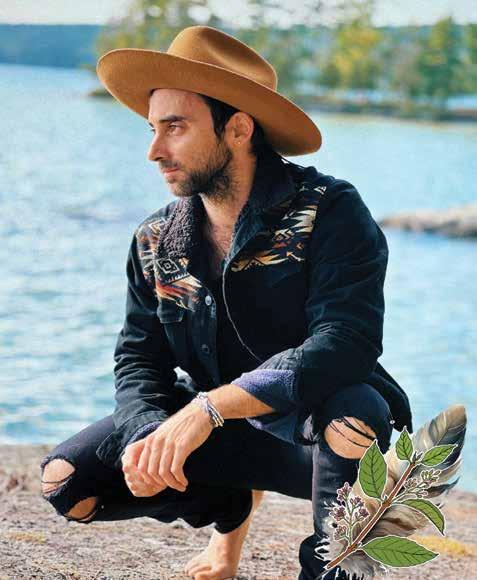
ask yourself questions like, "What do I need today? Depression, where are you leading me? What do you have to teach me today?” Or ask it to help you see what you’re not seeing.
Same scenario with two radically different approaches—two different paths of action. Once we clear up our relationship with depression and are in acceptance, we can move into trust.
3. Trust
Trust is the foundation to tap into the wisdom of depression. Trust your depression. Trust there is meaning and purpose behind it. Trust that depression is here for a reason, and it’s leading you somewhere. Trust it’s here to make you a more aware, better version of yourself. You are in partnership with your depression, walking a path with it. This is a decision you might have to make daily, or sometimes by the hour.
Carve out a bit of space for curiosity. What if depression is a good thing? What if it’s leading you to a better version of yourself? It's an assumption to label your depression as "bad," because you don't know where it's leading you. This is where the beauty is. Depression, anxiety, mental health—all these paths are a journey

Trust there is meaning and purpose behind it. Trust that depression is here for a reason, and it’s leading you somewhere.
The orientation I choose to have in life, and invite you to, is that there is a path and purpose for your life so beautiful and big that you could never have foreseen it or planned it alone. This plan is in motion now. Depression is part of that plan.
Change your relationship with depression and then act. Explore healing modalities with openness and curiosity. Practice deep listening to your body, spirit, and mind. What is your body/spirit/mind telling you right now? Through prayer, meditation, self-compassion, and yoga, you can tap deeply into yourself. You ask these questions and begin to listen for answers.
What could you change in your material life that will have the biggest impact on your mental health? What is your spirit craving? What are the things you can explore that might bring relief? What has depression been trying to tell you that you haven’t been willing to hear? What is missing from your life? Then, what can you do about it? What is your next small step to take?
It’s in these questions and answers that the wisdom of depression will speak and reveal itself to you. Be prepared for the journey, because odds are its leading you somewhere you never could have imagined.
Kyle Nicolaides is a healer, former lead singer of the rock band Beware of Darkness, and author of Thank God for Depression. He lives in Ann Arbor with his partner, Marcie, and pups Buddha and Estrella. Learn more about Nicolaides at kylenicolaides.com.
The Crazy Wisdom Community Journal • May through August 2024 • Page 18
Take a Mindful Hike
 By Julie Woodward
By Julie Woodward
Are you looking for easy ways to unwind and relax even the middle of your busy days? Do you find yourself feeling worried about yet another disheartening news cycle or overwhelmed with work or personal stress, and yet uncertain about how you will find the peace and calm you long for?
One of the easiest ways I know to restore myself to feeling centered is to go outside. Yes, that’s all. Just step outside! If I get myself outdoors, within 5-30 minutes I feel my tension shift into calm. Maybe this is true for you, too?
Especially during the pandemic, when gyms closed and fears ran high, so many people came to rely on the power of a walk outdoors to restore a sense of balance. More than ever, I value and prioritize the sense of connection with a larger life that I experience, and that we all may experience, when immersed in nature.
More than ever, I value and prioritize the sense of connection with a larger life that I experience, and that we all may experience, when immersed in nature.
Approaching a walk outdoors as a formal meditation practice can provide us with a path to deeper relaxation and peace. A specific meditation practice I enjoy is based on the Japanese art of shinrin-yoku, forest bathing or “taking in the forest atmosphere.” This meditation process involves taking attention to each of our senses in turn: noticing body sensation, what is perceived through the senses of vision, hearing, smell, taste, and touch. I co-lead monthly mindfulness hikes inspired by the forest bathing practice in local and county parks and preserves with a park naturalist; I have observed the transformative power of even a brief mindful walk. I invite you to try this simple six-step practice, described below, when you have 20 minutes to an hour available.
Prepare for your hike. Begin by going outdoors. If you can and you want to, go to a quiet, safe, natural location such as one of our local or county parks or preserves, with natural features—trees, a forest, plants, wildlife, a river, and some degree of quiet from city noise and traffic. Or take a walk on the sidewalk in your neighborhood, or near your work location. This practice may even be done while sitting comfortably outdoors. The idea is to set yourself up so that you may feel free to let your focus be absorbed in your senses, uninterrupted by the need to attend to traffic, crosswalks or your safety, or by a requirement to speak with other people. This is, as much as possible, a silent meditation, with no talking, and your attention focused inward on your experience and outward on what you perceive in nature.
The idea is to set yourself up so that you may feel free to let your focus be absorbed in your senses, uninterrupted by the need to attend to traffic, crosswalks or your safety, or by a requirement to speak with other people.
Feel your body sensation. Standing still, feel yourself standing; feel your feet on the ground. Look around you to orient to and take in your surroundings. Invite yourself to shift out of your busy automatic pilot mode (of doing, thinking, fixing) and to shift into being mode. You might envision your hands sweeping off the burdens you carry on your shoulders and setting them off to the side. When you feel ready, begin walking. Just walk and feel yourself walking. Feel the sensation in your feet, your legs, your hips. When you notice that you have started thinking, you are no longer feeling yourself walk, so, just come back, and feel yourself walk. That’s all. Allow your attention to be absorbed in the sensation in your body as you move. Invite a sense of curiosity to your experience. What do you feel beneath your feet? Do you notice the air on your skin? A rhythm to your movement? When you feel ready and have explored sensation, come to a standstill. Notice the quality of your inner experience, your sense of connection to your surroundings. What did you notice as you walked and felt yourself walking? Were you able to focus on body sensation? Did thoughts come up? If so, that is natural. The meditation practice is to notice when thoughts come up, and gently guide attention back to the meditation focus, such as body sensation, vision, hearing, smell, taste, or touch. How is this kind of walking different than walking for transportation in daily life? How might this awareness inform your daily life?
Sense of vision. Next, bring your awareness to your sense of vision. As you continue walking, allow your eyes to receive information from your surroundings; observe colors, qualities of light, patterns, movement. Invite yourself to observe without expectation, with a beginner’s eye and mind. See and know that you are seeing. When you are ready, pause to reflect. What did you notice with your sense of vision? How is this way of seeing different than your usual way of seeing? How might you bring this way of knowing back into your daily life?

Sense of hearing. Bring the focus of your attention to your sense of hearing. Allow yourself to open to receive the sounds that are present. Notice sounds arising, persisting, fading away. Notice sound pitch, pattern, location in background, or foreground. Observe whether you interpret the sounds to be pleasant, unpleasant, or neutral. Just walk and notice sound. When you are ready, pause and reflect on the experience of hearing. What did you notice with your sense of hearing? How is this way of hearing different than your usual way of hearing? How might this awareness inform you in your daily life?
Sense of smell and taste. Bring the focus of your attention to what you notice through your sense of smell. What scents do you detect? What does the scent evoke in you? Feel the natural rhythm of your breath. Feel yourself breathing in and breathing out. As you inhale, do you notice scent? Do you sense taste? When you are ready, pause and reflect. What did you notice with your sense of smell? How might this awareness inform you in your daily life?
Taking a mindful walk outdoors is more an un-doing than a doing. It can be a release from the demands and multitasking of daily life, providing you with rest—a moment to feel alive.
Sense of touch. Bring your attention to your sense of touch in your fingers and hands. Rub your palms together to stimulate the sensory receptors in your palms. Do you sense temperature, texture? Looking around you, do you notice something in nature you feel drawn to touch? A tree, a rock, the grass, or dirt? What do you notice through your sense of touch? Explore the sensory information available to you through your sense of touch. When you are ready, pause and reflect. What did you notice with your sense of touch? If you touched a tree or the ground, did you feel a sense of aliveness? How is this exploratory, observational sense of touch different than your daily, sometimes more goaloriented kind of touch? How might this awareness inform you in your daily life?
Reflection and Inquiry: As you come to the end of your meditation hike, letting go of focus on any one sense and notice the overall awareness of your inner experience. What is the quality of your awareness after this practice? What is your sense of connection with yourself? Your sense of connection with life around you after this practice? Remembering back to your state before the hike, what was your state of being then? What is the self-identity expressed in that state? Now, after the meditation, what is your sense of identity once you have relaxed? Know that with each hike you take, or practice you do, you cultivate, choose, and build the neural pathways that create the traits to embody this more relaxed, peaceful identity.
Taking a mindful walk outdoors is more an un-doing than a doing. It can be a release from the demands and multitasking of daily life, providing you with rest—a moment to feel alive. For this practice and for this moment, you have all you need, just being as you are.
Julie Woodward works as a wellness coach, yoga teacher, and mindfulness teacher specializing in embodied approaches to health and wellbeing. A cofounder of Mindful City Ann Arbor and Ann Arbor Center for Mindfulness, Woodward leads meditation sits, yoga classes, and co-leads monthly mindfulness hikes through Washtenaw County Parks and Recreation. For more information on the hikes and to register visit parksonline@washtenaw.org. Visit Woodward online at julie-woodward.com.
The Crazy Wisdom Community Journal • May through August 2024 • Page 19
Sustainable health
My Life Has Been Shaped by Antisemitism
 By Sandor Slomovits
By Sandor Slomovits
I don’t remember a time when I wasn’t aware of antisemitism (not surprising for one who comes from a family with a history like mine. More about that later.) What’s been startling to me lately is recognizing that, until a few years ago, I never thought of myself as a possible target of antisemitism. An interaction with my father twenty-five years ago accurately describes how I have felt for most of my life in America.
In August of 1998 the Bill Clinton and Monica Lewinsky story, like a very messy pot of soup that had been pushed from front burner to back, to front again— simmering the whole time—finally boiled over and spilled untidily on every front page and television screen. I happened to be visiting my parents at the time. My folks rarely talked politics—p perhaps a legacy of the times in their lives, both before and after WWII, when it was dangerous—even potentially lethal—to discuss government leaders or policies. But, watching the news one night, seeing the famous Clinton/Lewinsky public hug for the zillionth time, my father sighed and said, “If only she wasn’t Jewish.”
That thought had never entered—much less crossed—my mind. I was reminded, and not for the first time, how differently my father and I viewed the world. For him everything was colored by Jewish glasses, and by old, and in his case, well-founded fears. In his world, Jews always needed to be extra careful not to give people another reason to want to kill them. I, who came of age in the much more tolerant atmosphere of the United States in the 1960s despite being aware of my parents’ history and fears, felt far less burdened or affected by them.
In August of 1998 the Bill Clinton and Monica Lewinsky story, like a very messy pot of soup that had been pushed from front burner to back, to front again—simmering the whole time—finally boiled over and spilled untidily on every front page and television screen.
Until recently
Beginning in 2016, increasingly after the events in Charlottesville and Pittsburgh, and especially since the attacks on October 7, I have come to a different understanding. My life has been shaped by antisemitism.
Hyperbolic? Overly dramatic? No. My brother and I might not have even been born if a great many people, for a great many years, in a great many places, hadn’t hated Jews just for being Jews.
My brother and I were born five years after the Nazis murdered our mother’s fiancé and our father’s first wife and three young children. Hypothetically, if not for those tragedies, our parents would never have met, much less married, so different were their lives and circumstances before WWII.
But, extending my hypothetical thought experiment even further, had my parents met, married, and birthed my brother and me before WWII—and all of us had survived the Holocaust—our family would have included two of our grandparents, three aunts, three uncles, and at least two cousins, all of whom were alive at the beginning of 1944 and burned to ashes in Auschwitz by the middle of that year.
My life has been shaped by antisemitism. That does not make me unique. Antisemitism has shaped the life of nearly every Jew alive today. Many of us are descendants of Jews who survived or were murdered in the Holocaust. Almost every one of us is a descendant of generation upon generation of Jews who suffered discrimination, persecution and, all too often, murderous violence. Our ancestors were repeatedly forced to flee from one place to a safer one, often at the point of a sword or gun.
I, who came of age in the much more tolerant atmosphere of the United States in the 1960s despite being aware of my parents’ history and fears, felt far less burdened or affected by them.
My brother and I were seven years old in 1956, during the Hungarian Revolution. When the Soviet Union’s troops invaded Budapest, they shuttered all the synagogues, including the two in which our father served as cantor. After the Revolution was crushed, our father’s job and career remained in jeopardy. Additionally, Hungary’s long-standing system of quotas restricting the number of Jews in higher education was still in place. Our parents knew that their children’s futures would likely also be constrained. Along with Jews throughout Europe, they knew the history of antisemitic violence in Hungary, throughout Eastern Europe which continued even after WWII, and the Russian pogroms seventy years earlier. They made the wrenching decision to leave their homeland. However, they were unwilling to risk escaping across the Austrian Hungarian border— the path taken by about 200,000 Hungarians in the immediate aftermath of the Revolution— on foot with two seven-year-old boys. They chose what seemed a safer route, after a member of the Israeli consulate in Budapest (a man who attended services at my father’s synagogue) offered them a visa to Israel.
Two years later, our family moved again because, as our father correctly observed soon after we arrived in Israel, “They don’t need cantors here. They need farmers and builders.” That was a tough ask for a fifty-year old man who had, since the age of thirteen, only worked as a cantor. Life in rural Israel was no better a fit for our mother who, aside from six months in German concentration camps, had lived her entire life in Budapest. As soon as they were able to comply with US immigration laws, they moved our family to America.
Their timing was good. We arrived in the US in late 1959. Had we reached the US ten years earlier, (continuing my earlier hypothetical thought experiment) we’d still have faced pervasive American-style antisemitism. To be sure, it was not Nazi, or European-variety pogroms; instead, it was sporadic KKK violence and quotas that barred many Jews from country clubs, top colleges and univer-
The Crazy Wisdom Community Journal • May through August 2024 • Page 20

Sandor Slomovits is one of the twin brothers who comprise Gemini, the nationally acclaimed children’s music duo. Since 1973, Sandor, with his brother Laszlo, has toured the US and Canada and they have released over a dozen award-winning recordings and a concert video. Sandor also plays music with his daughter, Emily and is a freelance writer for a number of local and national papers and magazines.



Keynote Speakers Rosalee de la Forêt and Marc Williams
Join us for our 10th annual event! Enjoy 3 days full of herb classes, plant walks, delicious food, new friends, a unique marketplace and Saturday night entertainment.
Family Friendly!
The Crazy Wisdom Community Journal • May through August 2024 • Page 21
September 6th - 8th 2024 Chelsea, MI
www.GreatLakesHerbFaire.org
Bring the whole family - check out our Kids Tent! Families get 10% off registration & lodging

Goddess of Borderland, Mistress of Crossroads
Pokeweed-Hekate
By Dianna Rhyan
Having watched the moon set with the sun’s rising, the ancient lunar goddess Hekate is on my mind. And near the Huron river path this morning, a pokeweed plant reaches upward offering a message and posing a hieroglyphic sign as she raises her arms in slender scarlet sleeves. Fresh green pendants nestle beside fully ripe ink-purple fruit on her supple limbs where she drapes luxurious flowing tresses, trailing glossy clusters from slender stems. Wildly flowering, the goddess and plant step from forest edge as one to emerge into the waking world. Hekate dances within her chosen ally pokeweed, just as ancient Greeks thought nymphs ensouled their trees in mutual lifelong union.
In Nichols Arboretum in Ann Arbor, I stop and sit on the ground, to journal beside her—trusting that her epiphany will grow ever clearer as we breathe together in silence.

And near the Huron river path this morning, a pokeweed plant reaches upward offering a message and posing a hieroglyphic sign as she raises her arms in slender scarlet sleeves.
Triple-faced Hekate, and her soulmate the pokeweed plant, are sovereign in many realms, yet prefer to dwell in no-one’s-land where trails and paths convene and where crossroads intersect only to diverge and wander away. Enter almost any Midwestern place and look aside—away from the center to the margins, away from the ascendant and out toward the lost, to where shredded outcasts of mulch, mounds of dung, pulled-up fence posts, tumbledown bricks, or crumbling cinderblocks pierced with saplings lie sleeping, hunching their backs and taking their chances. Where brambles and poison ivy recline on rough bedding, curled around their secrets. There you will find her. Willowy in stature, she sees far down the turning traces of wild things in many directions at once to reveal, or conceal, what she perceives.
Flourishing among her companions, like a long-ago princess distinguished in a chorus of nymphs, pokeweed is dancing. Far across a burgeoning meadow, her rangy form is easy to pick out, thriving amid her lofty chorus as they wave and circle together on the riverbank.
Pokeweed’s plant chorus includes distinct personalities, each nymph bearing gifts in her hands: angelica, wild carrot, bergamot and mint, snakeroot, water hemlock, sow thistle, and motherwort. To savor each name is to invite each plant’s texture, fragrance, and shape to linger in the heart. Burgeoning amid the leggy troupe, some stalks are familiar from kitchen sill, pasture edge, or goneto-seed garden, and they range from piquant to caustic, from nutrient to touchme-not. This tangle of plant-folk, this be-wild-ering bouquet, edges us toward the wild where all true stories begin.
Like Hekate and all her retinue, pokeweed epiphanies require reverence and caution. Goddess and plant are beneficial, yet also dreadful, and they embrace contradictory ways: inviting or repellent, enticing or repulsive, protective, or deadly. As the ancient Greek philosopher Heraclitus intimated about reality itself, truth is paradoxical. Harmonies of nature and divine power dwell within the transforming, dynamic unity of opposites.
The Ancient Greek word pharmakon encompassed divine opposites signifying both medicine and poison; pokeweed declares the pharmaceutical, paradoxical truth that perilous toxins and beneficial remedies spiral upward from a single potent root. Pokeweed-Hekate transmutes toxins in the soil, grips terrain to prevent eroding earth from wasting away, and aerates underworld fungal webs for the healing of all. For all these reasons and more, I have no plan to touch or use her in any way; I celebrate without going too near and respect her person, as I do her creative wisdom. Cloaked in unknowns, she remains as mysterious as any triple-faced goddess, any queen of fertility and decomposition, any mistress of rising and falling vegetation.
Veiled in mystery, remote, fierce, and distant dwelling, when need arose Hekate made mythic epiphanies as the embodiment of compassion. She did so in the springtime of archaic Greek myth (as told in the Homeric Hymn to Demeter), when the god of death Hades leapt out of a chasm to abduct the seedling plant-goddess Persephone.
Persephone was born a sweet flower, a blossom-cheeked maiden, a soft petal, gentle sapling, tender branch. when she was gathering blossoms among her chosen nymph companions, Hades seized her and rapt her away from summer, down beneath the rich soil of searching roots, down to the dread dark of the underworld.
The Hekate who responded to Persephone’s plight was a paradoxical goddess of many faces and manifestations for Hekate was by far the most feral and enigmatic of Greek goddesses. Still today, lonesome and deserted crossroads are dear to her just as they are to wild pokeweed.
In Persephone’s enchanted myth, Hekate dwells in a cave underground, rooted in the living depths of Gaia, among the intertwined, questing roots of the blooms Persephone was touching. Down in the fertile soil, deep inside her cavern, Hekate hears the cries of Persephone more sensitively than any other creature in the cosmos.
Hekate alone responded, light-bearing goddess, cave-dwelling spirit of the delicate veil, she who has empathy for tender new growth.

Triple-faced Hekate, and her soulmate the pokeweed plant, are sovereign in many realms, yet prefer to dwell in no-one’s-land where trails and paths convene and where crossroads intersect only to diverge and wander away.
The Crazy Wisdom Community Journal • May through August 2024 • Page 22
Hekate’s cave, like a wise-woman’s enclosure or a sacred glade, is not a blank emptiness but a rich emptiness: a vibrantly hollow place for resonant perception. Underground, the tender young plants told her through their roots about the kidnap of the young goddess. Hekate swiftly shares their herbal insight and revelation, leading to Persephone’s seasonal return.
When will Hekate-Pokeweed speak wisdom? The myth suggests this: when no one else comprehends, or when no one else is willing to tell the truth.
Composed to honor the paired mother-daughter goddesses of fertile vegetation and budding new growth, this is a plant myth for pondering the plant-humandivine continuum. Inviting us, as we kiss the sacred soil of the Arb with our feet, to reflect on the natural rhythms that connect us with mystery and divinity. Many myths celebrate the understandings between goddesses and plants (and goddesses as plants) with humans coming into the mix to benefit from the resulting arrangements. When Demeter and Persephone—the goddesses of ripe harvest and sprouting germination—are finally reunited, their new cycle of life and death is as variegated as a stand of pokeweed, dappled by oak’s shadow and sun’s light, interwoven like a tapestry of sorrow and joy. As this myth tells us, from that time forward,
Hekate accompanied them, and blessed on earth is any human they graciously favor with love.

Pokeweed-Hekate transmutes toxins in the soil, grips terrain to prevent eroding earth from wasting away, and aerates underworld fungal webs for the healing of all.
Still, a word of prudence—which makes a fine seasoning for love—Hekate , a traditional protectress of witches, works against the god of death in this ancient story, and yet she appears as a force for death, and decomposer of the dead, in other myths. Likewise, pokeweed is wholesome for robins, bluebirds, possums, and raccoons, yet is a potentially lethal force for the unwise human creature who would seek casually to overlook her poisonous aspects and consume her, without careful attunement to time-honored traditional practices or Indigenous wisdom. In truth, and in keeping with divine opposites, the gracious goddess is dangerous.
Portraits of Hekate are sometimes frightening or hideous, but other ancient renderings are lovely. Is the pokeweed goddess frightening, hideous, or beautiful? “Weed” hearkens back to the olden word weod, a plant defined by being not-beautiful, not-useful, or not-valued. Such discourteous definitions— yet how wily and protective! As a supposed weod, the striking, colorful spirit of pokeweed in the borderland escapes notice due to being overlooked, and she is left undomesticated and running wild, under the effective disguise and cunning alias of weod. Witch does not define multilayered Hekate, any more than poison summarizes pokeweed, or weed captures the essence of any plant. As we honor slanting stalks, shaggy riverbanks, and tangled briars, let’s stay mindful that Pokeweed-Hekate’s freedoms rely on rejection, on being forgotten and overlooked.

Hekate’s cave, like a wise-woman’s enclosure or a sacred glade, is not a blank emptiness but a rich emptiness: a vibrantly hollow place for resonant perception.
With ease, if that is her wish, she vanishes, and emerges in another season, another year, in another unexpected place.
Deep of taproot, she is ever and always a protector of borderlands, and ever and always a savage corpse-eater—which is to say, she is a transmuter of matter and a creator of fertility. She is a gentle spirit of light who can show us how to be at home in darkness, when she is respected and beloved. When she is reverently evoked and courteously cherished, we are joined to her kind and to her kindness, as we are to all plants, by our mutual inbreathing and outbreathing of spirit. Yet make no mistake; she may not be tamed. Like all plants and plant goddesses, Pokeweed-Hekate offers relationship freely given or not at all.
I have seen her tall and stately, basking in a glorious sunset, gracefully settling onto a crimson throne of autumn hedge maple; I have witnessed her rising refreshed and vibrant from tattered waste bags of slick, manure-coated straw. In winter her stalk-skeletons stand as bleached bones against the shadowy evergreens. This morning she glows, vibrant and bejeweled. The Huron slides silently behind her leafy silhouette, calmly reflecting her dark-gleaming dusky curls and multilayered green gown. In this plant goddess resides the ravishingly beautiful and grotesque, the charm of blossom and fright of decay.
She gestures to show you the way: into the borderland: wild landscape of the heart, wilderness of dreams.
If we have a lifeblood question flowing, a pilgrimage to walk an arboretum trail beckons. Trace soft and silent footsteps on the soil. Listen for wisdom not your own; find out what the plant chorus is singing. Wait for the face of the goddess who will hint you your answer and prompt you to glance in a healing direction. Rest, journal, or dance beside pokeweed of gracious spirit. Perhaps her faithful attendant nettle, or holy maiden jewelweed will beckon. Come to where sprouting goddesses place slender root ankles, curve green wrists, nod tousled heads, and unexpectedly edge near sedately trimmed lawn. Sit quietly near the border. Nine days going on ten may be quick enough; a fallen-down wall is seat enough; a trickle of moon is light enough. Still, where trails meet in the leafy margins, one tender, green, gently swaying plant is guide enough. HekatePokeweed is flourishing there, as an empathic messenger, statuesque beauty, transformative force, spirit of wild borders, and Mistress of Crossroads. By her side, unforeseen answers, newfound questions, and mystical invitations, await.

Sit quietly near the border. Nine days going on ten may be quick enough; a fallen-down wall is seat enough; a trickle of moon is light enough. Still, where trails meet in the leafy margins, one tender, green, gently swaying plant is guide enough.
Dianna Rhyan, PhD, LPCC, is the author of Staff of Laurel, Staff of Ash: Sacred Landscapes in Ancient Nature Myth from Moon Books. Dianna Rhyan is a mythologist who studies nature goddesses, tree worship, and the spirituality of sacred landscapes. She has a PhD in Ancient Greek and Latin, taught college for thirty years, and worked on archaeological excavations in Greece and Cyprus. She lives in Wooster, OH with her husband and assorted foster dogs. Visit her online at staffoflaurel.com or email her at staffoflaurel@gmail.com.
Pokeweed-Hecate

She stands rooted at the edges and intersections of our lives, dwelling on the border between dream and waking, between the reality of myth and the imagination of map, between branching enchantment and deeply rooted instinct. If need be, she can wait long years of circling seasons, as a seed or root underground, sensing in all directions above and below, choosing her moment to rise. Where there has been destruction, where wasteland waits for rebirth, where there has been a storm, and sunlight has found its way through again, there she is.
Where wildness springs up alongside order, to balance and counter loss and undo plans, there she stands.
The Crazy Wisdom Community Journal • May through August 2024 • Page 23

What’ s New in the Community
By Lynda Gronlund
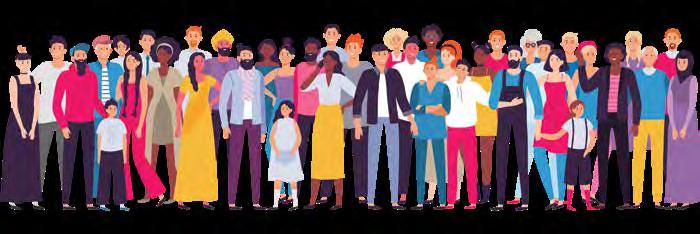
Khenpo

Ann Arbor’s Karuna Buddhist Center began meeting in November of 2022 in a room inside the Bethlehem United Church of Christ. In 2023, they were able to bring their teacher Khenpo Tshering Chophel from India to reside here in Michigan and serve as the center’s full-time teacher.
Read the article on page 30.

The Crazy Wisdom Community Journal • May through August 2024 • Page 24
This ongoing column features upcoming events within Ann Arbor/Washtenaw County and surrounding areas’ Body/Mind/Spirit communities, new (during the past year or two) practitioners and holistic businesses, new books written by local/regional authors, new classes, as well as new offerings by established practitioners and holistic businesses.
Tshering Chophel and Lama Nancy Burks of Ann Arbor’s Karuna Buddhist Center
Photo by Susan Ayer



Keepers of The Spirit Box Anne Taylor and Rick Nichols



The Infinite Light Center in Jackson became home to one of artist Andre Ferrella’s “Spirit Boxes” in late 2023.
Ferella creates spiritual and sacred experiential art, incorporating the use of technology to connect viewers to the divine. Anne Taylor and Rick Nichols, the husband-and-wife owners of the Infinite Light Center, became aware of the Spirit Box when they attended a conference in Sedona. They were moved by the experience and asked Ferrella if they could bring a Spirit Box to their center in Michigan. Ferrella required an interview process, as he is selective about who will become what he calls “Keepers” of the Spirit Box.
The installation itself consists of a pair of six feet high, 26 inches wide, 3.25 inches deep acrylic boxes which rotate from side to side as images are projected onto and into them, creating a holographic effect. Specially composed spiritual music accompanies the images. This is set up in a darkened room, and Taylor described it as akin to “open-eyed meditation.” She said the experience is very relaxing and can be very profound.
Taylor and Nichols want to share the Spirit Box with the community for free as much as they can, allowing people to experience it during their occasional holistic and spiritual fairs and most Sundays after their regular gatherings at Infinite Light. They will also offer it at the Center’s ribbon cutting and open house on Wednesday, May 1 from 4:00 p.m. to 6:00 p.m. Other appointments are available for a small cost. Up to seven people can experience the Spirit Box at one time, and the experience takes 15 or 25 minutes depending on the option chosen. Taylor said that some people report that the experience is different for them each time. She said that it creates a “calming, refreshing, and energizing respite.” She observed that some people cry, and some report experiencing physical healings.
The Infinite Light Center and Sound Sanctuary is located at 1805 East Ganson Street, Jackson, MI 49202. Their website is infinitelightjackson. com, and more information about the Spirit Box is available at andreferrella.com/the-spirit-box-experience. Anne Taylor can be reached at (517) 962-4725 or by email through the website’s contact form.
More New Offerings by Established Businesses and Practitioners listings on page 26.
Catherine Carr, long-time feature writer for The Crazy Wisdom Community Journal, published two books in the last year.
The first, released in 2023, is called World Soul: Healing Ourselves and the Earth Through Pagan Theology. It was released for the Parliament of the World’s Religions conference which was held in Chicago in mid-August. Carr described it as a “short primer on how Pagan religions differ from Christianity and Islam.” Coming from a Catholic background herself, Carr said that there are a lot of how-to books in the Pagan space, but not much from a standpoint of systematic theology and the implications for how practitioners live their lives and think about themselves. It is a short, dense book which covers all the basics of Pagan theology, and may be of interest not only to Pagans, but to those who are curious about their Pagan friends’ perspectives. Carr explained that it was partially inspired by a non-Pagan friend who asked her, “What can I read to understand your point of view?” The book has been popular in interfaith spaces, and Carr says it has been prompting conversation about how monotheistic and animistic religions relate to each other.
The second book, Breaking Your Bonds: Finding Freedom Through Adversity, was released in January of this year and is a companion to Carr’s monthly online “Breaking of Bonds” rituals and support groups which help people make forward movement in their lives around each New Moon. “It’s really about finding autonomy and freedom,” she said. There are sections about boundaries, consent, autonomy, and figuring out “what you feel like you’re supposed to be doing on a spiritual level.” There are instructions for the ritual she facilitates, as well as powerful meditations. The book and ritual, she explained, can be helpful for “people who are at a crossroads where they know something [in their life] needs to change, but it’s big and intimidating, and maybe they’re having some trouble envisioning being successful with it.” It is also for people who are “feeling stuck,” or like they won’t be able to reach their goals. “There’s almost always a way to reach your goals, but there are some things that we might be taught contrary to that,” said Carr.
Both books will be available in paperback in bookstores by summer. Breaking Your Bonds is available on Carr’s website as an ebook for free. The ritual is also free to attend and administered via Zoom to allow everyone to attend.
More New Books by Area Authors listings on page 27.
The Crazy Wisdom Community Journal • May through August 2024 • Page 25
Artist Andre Ferrella
More information is online at catherinecarr.org, and Catherine Carr can be reached via email at author@catherinecarr.org.

What’ s New in the Community

Continued from page 25
New Offerings by Established Businesses and Practitioners
Ann Arbor-based Rowena Conahan has been a massage therapist, energy worker, herbalist, educator, poet, and storyteller.
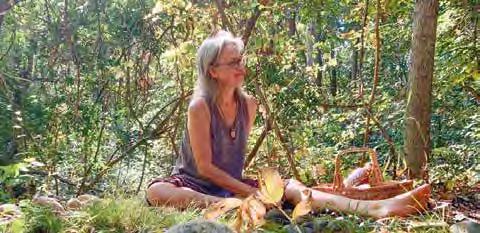
Her focus now is moving toward place healing through her new practice, NatureSpeak, launched in late 2023. She offers space clearing, which she described as “healing work for indoor spaces” and land healing described as “working with outdoor spaces.” She has done this work more informally for over two decades for herself, friends, neighbors, family, and a few clients. “I would love to see space clearing and land healing become common practices in the next few years,” she said, and this new practice is her commitment to “increasing awareness of our relationship to place and the role it plays in our health and wellbeing.”
Conahan said that even as a child she had an awareness of “almost a humanness to everything around us to nature.” She developed that awareness and honed her place healing abilities and experiences through her other work with energy and healing, with the help of teachers, and even with the help of the land itself as she learned to listen to it, she said. She lives in a cohousing community on the West side of Ann Arbor where she has done space clearing and land healing in the shared indoor and outdoor areas and in several neighbors’ homes as well as her own. Last spring, she worked with an old industrial site that was to become a park in Chelsea. It had been very polluted, she said, and while lots of physical restoration was being done, her role was energetic restoration.
Conahan prefers to have the people attached to the land or building involved in the healing process. “There is a relationship between ourselves [sic] and a place. People are the key players,” she said. The place healer can work alone, and the land or building will feel better, but “there’s a wonderful opportunity to get people involved in the process, waking their own intuition up, listening and feeling, discovering what’s going on in a place, and what’s needed.”
Asked what circumstances might prompt someone to seek out the help of a place healer, Conahan said that space clearing can help when someone moves into a new house and “it feels weird,” or they can’t settle in, or if for some reason someone can’t seem to get their living space cleaned up no matter how hard they try. Land healing, she said, can be helpful for someone who wants to fall in love with their outdoor space or wants to spend more time outside. “I am really in love with the understanding that the space around us is alive,” she said. “We tend not to think of it that way, and don’t notice it, but I feel it. There is beautiful energy available around us. Connecting with it, harmonizing with it, and engaging with it can really add a lot to a person’s life, and I’m excited to see more of that in the world.”
More information is available on Conahan’s website, naturespeak.life. She can be reached by email at naturespeaklife@gmail.com.
Jackie Miller moved her breathwork practice, This Breath, into a small space on Shelby Avenue in Ann Arbor in August of 2022, and she is now expanding her services.
Miller has offered advanced breathwork facilitation in the Ann Arbor/Ypsilanti area since 2014, when she moved back to Michigan (where she grew up) from Portland where she completed her breathwork practitioner training in 2009. She offers one-on-one breathwork sessions for “deep selfhealing and breakthroughs in growth and transformation.” These sessions, she said, “aim to work with our most difficult emotions,” and work on the physical, mental, and emotional levels. Some people use these sessions to address trauma, anxiety, depression, and other problems, and some come to seek breakthroughs and personal growth.
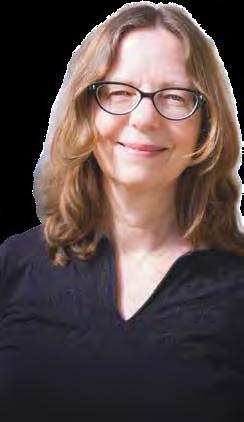
In addition to these one-on-one sessions, Miller started offering bimonthly group breathwork sessions for up to ten people on a free/ donation basis. The group sessions, she explained, are “gentler, guided with music, uplifting, and refreshing.” They allow participants to “sample the experience of conscious connected breathing and the heightened energy it activates,” and also to learn simple breathing techniques they can use at home for relaxation and stress management. These sessions are hosted at Huron Valley Aikikai on Federal Boulevard in Ann Arbor on the first and third Saturdays of each month from 6:00 p.m. to 7:30 p.m. Pre-registration is required and is available on Miller’s website. She also offers private group breathwork workshops or sessions in workplaces and other settings.
Miller is also developing a process of using breathwork in combination with non-psychoactive CBD oil which she said can, “contribute helpful somatic effects into a session,” assisting people in feeling embodied or grounded in their body. She will soon be offering one-on-one sessions with CBD oil which she said can be an alternative to psychedelic-assisted therapies and can be very supportive for self-healing work.
“Breath can be used for so many different things,” said Miller. She defines breathwork as “using the breath to activate a non-ordinary state of consciousness.” She explained that breathwork is not the same as meditation or mindfulness—breathwork is “meditative at times, but not meditation.”
She said that interest in breathwork during the pandemic exploded, and this has allowed her to work toward making This Breath a full-time practice. Breathwork, she said, can be very complimentary with psychotherapy in resolving trauma and dealing with depression, anxiety, and other mental health issues. It can help people who struggle to access their emotions and can help with things like developing a health relationship with one’s own anger, practicing good boundaries, improving communication, and quelling addictive patterns, overthinking, and dissociation. She said that she finds it gratifying to watch people evolve their self-understanding, gain vitality, and develop better relationships.
Miller recently became a Certified Professional Breathwork Practitioner through the Global Professional Breathwork Alliance which is the body for professionalism, ethics, and training standards in breathwork. In addition to breathwork, she now offers spiritual counseling on a donation basis drawing on her background in Buddhist practice and interfaith chaplaincy.
This Breath is located at 2311 Shelby Avenue, Suite 101, Ann Arbor, MI 48103. Jackie Miller can be reached via email at jackie@thisbreath.com or by phone at (734) 883.7130. Her website is thisbreath.com
The Crazy Wisdom Community Journal • May through August 2024 • Page 26
New Books by Area Authors
Ann Arbor author and book coach Ken Wachsberger published the second edition of his book: You’ve Got the Time: How to Write and Publish That Book in You in February.
The first edition, published just four years ago, was a hit, at times ranking number one on Amazon in 19 different categories. In March of 2022, a major change happened in the independent publishing industry: two large self-publishing platforms Smashwords and Draft2Digital merged. Wachsberger said that this merger made major parts of the book obsolete, and so he spent a year and a half updating everything and adding four new chapters.

Wachsberger has written and published nonfiction books on a variety of topics, including the Holocaust and Jewish resistance during World War II, the Vietnam Era, publishing, and more. His book Your Partner Has Breast Cancer: 21 Ways to Keep Sane as a Support Person on Your Journey from Victim to Survivor drew from his own experiences as his wife was navigating a breast cancer diagnosis. As an editor and book coach, he helps others to write about their difficult experiences to help others, and in the process, help them deal with their own trauma. He also works with people who are working to advance professionally by writing their own book, and people who want to leave a legacy. He was a teacher for many years before going into coaching and said that he has an ability to not only help people write better, but to write more, “drawing words out of them.”
Wachsberger speaks on these topics as well and is a member of the National Speakers Association. He has helped many fellow members write their own books. One thing that sets him apart from other book coaches, he said, is that he offers editing as a service. “You’re standing naked when you publish a book, once you publish it, it’s out of your hands. That’s why you need good editing,” he said. He sometimes receives referrals from other book coaches for editing services. He does offer a complimentary session for prospective clients interested in coaching, to see if he would be a good fit to help bring their writing to fruition.
You’ve Got the Time: How to Write and Publish That Book in You is available for purchase online at books2read.com/youvegotthetime. Ken Wachsberger’s website is kenthebookcoach.com. He can be reached by email at ken@kenthebookcoach. com or by phone at (734) 635.0577.
Local children’s author and artist
Jennifer Carson published her first self-illustrated picture book this spring: Fox Hollow Tales: Wojer and the Wizard of the Wood.
The first in a series of four planned books, it introduces the world of Fox Hollow, which Carson said was somewhat inspired by the Brambly Hedge picture book series by Jill Barklem and the Foxwood Tales series by Cynthia and Brian Paterson which she loved growing up.

As a child and teenager, Carson dreamed of becoming an artist, but was discouraged by her older brother who told her that she wasn’t good enough to make a living with art and advised her to go into computers. She didn’t go into computers, but for a long time she gave up on her dreams of illustration. Her internal desire to create never went away, though, and throughout the years she created animal and fantasy dolls, even selling her own sewing patterns. Twenty years ago, she started writing stories, eventually publishing several children’s books, but she never got into illustrating her stories until the pandemic gave her the unexpected free time to practice. So, she practiced, took some classes, received encouragement from others, and began selling her illustrations and paintings which, it turned out, people really liked. She had written the Fox Hollow Tales stories a decade ago, and she decided it was time to bring them out and illustrate them with her newfound skills and confidence.
This first book in the series tells a story about Wojer, a young badger, who outsmarts Lily Fox, the neighborhood bully who tries to scare him with stories about the woods where he goes to pick berries for his mother to make jam. Carson explained that this picture book has a lot more story than most modern






picture books which tend to only contain 500-600 words. It is aimed at children between four and eight years old. However, parents can read it to younger children and older children can work on their reading skills with it. She said that it has some great messages for kids, but “isn’t preachy.” The Fox Hollow world even has some of its own parables for children woven into the stories. The book is available online, at Crazy Wisdom Bookstore, and other local independent bookstores.
The second book in the series, Pearl and the Harvest Scare, will be released this fall. Carson will be promoting her books at a variety of local art and craft shows this summer; events will be listed on her website as details are finalized.
More information about Jennifer Carson and her books is online at thedragoncharmer.com/my-books. She can be reached by email at jencarson75@gmail.com.

The Crazy Wisdom Community Journal • May through August 2024• Page 27
on page 29 Join us on our path to living a life of Lovin g kindness with non harm to all beings. Experience the wisdom and compassion of Aaron, as channeled by our founder and guiding teacher, Barbara Brodsky.
Continued
Livestream via Zoom
Classes | Events with Spirit | Retreats | Workshops Weekly Silent Meditation
NEW! COURSES ON DEMAND DeepSpring.org | info@deepspring.org | 734.477.5848 Deep Spring Center is a 501(c)(3) non-profit. See website for details.
Live Retreat Oct. 14 - 18, 2024
2024 Programs
Crazy Wisdom’s Second Floor is Reopening
Opening in late May…
Refreshed, Renewed, and Ready for a New Life. We have a new Art Gallery Space, plus we’re bringing back Author Events, Drum Circles, Poetry Readings, Storytelling Nights, Music Nights, Witches’ Nights Out, and MORE.
Plus, we’re also bringing back Intuitive and Tarot Readings.
For more information, or to book an event, please contact Bill Zirinsky at: billz@crazywisdom.net





The Crazy Wisdom Community Journal • May through August 2024 • Page 28

What’ s New in the Community

Continued from page 27
Upcoming Events
JissoJi Zen, a Zen meditation group in the Suzuki/Katagiri lineage, meeting in the Center for Sacred Living in West Ann Arbor, will welcome its guiding teacher Koji Acquaviva Dreher for a weekend meditation retreat in July.
Dreher is currently based in St. Paul, Minnesota, where he teaches at the Clouds in Water Zen Center. He was ordained as a Buddhist priest in 2008 by Reverend Koshō McCall at Mahabodhi Temple in India and has since taught in New Orleans and Austin, as well as St. Paul and Ann Arbor. He has known JissoJi’s lead priest, Reverend Marta Dabis, for over twenty years,since they trained together in the San Francisco Zen Center. He visited Ann Arbor twice in 2023 to lead meditation retreats. JissoJi board member Greg Wilson said, “We believe Koji’s offerings enrich the cultural and spiritual tapestry of our Sangha and all of Ann Arbor. We invite seasoned practitioners and those new to Zen to explore their practice in the contemporary context he provides.”

therapy and performance and has a team of music therapists working with her through Harmony Garden. Rieli is a singer, sound healer, and holistic voice practitioner with an MA in vocal performance as well as sound healing and yoga certifications. She helps clients “use the power of their voices to resolve trauma and enjoy better results in every area of life.”
The two women met in 2022 when Lawrence took Rieli’s Singing for Your Wild Soul sound healing certification course. They discovered they have a strong synergy when working together, and this will be their first collaboration for the public.
Participants in the series will be led in an interactive experience that will include journaling, emotional freedom technique (EFT or “tapping”), gentle stretching, and nervous system healing techniques, followed by a restful sound healing with crystal singing bowls, Celtic harp, flutes, gongs, drums, and voice. Rieli and Lawrence said that while the series is meant to build upon itself, with compounding benefits as participants attend more than one session, people are welcome to attend and will benefit from any single session. The focus will be on calming the nervous system, which Rieli explained can be especially helpful for those experiencing stress, overwhelm, overwork, and anxiety. Health issues and pain can recede because healing is improved when the nervous system is calm. “Pain travels the same neural pathways as music,” said Rieli. She said that caregivers, teachers, therapists, parents of children and teens, and others who spend a lot of time caring for others experiencing heightened emotions and pain often feel stuck in fight, flight, or freeze mode, and that when they are able to better regulate their nervous system, they feel better able to hold space for those they are caring for or working with.
The (non-silent) retreat will take place on July 14 and will include guided meditations, teachings, and question and answer sessions. Wilson said they expect about twenty to thirty participants, in person and online. He emphasized that JissoJi is an accessible, fairly small sangha looking to grow in a sustainable way, that feels very accepting and inclusive. Dreher is focused on diversity, equity, inclusion, accessibility, and he identifies as queer and neurodivergent. Wilson said, “There is a lot of embracing of a relaxed stance on practice,” and that people should be encouraged to come as they are. “We’re not trying to fit you into a mold,” he said. Anyone with any interest is encouraged to sit in person or online at a JissoJi meditation session with no expectations, to stay or go as they feel led. “We’re not going to try to chase you down,” said Wilson, “but you are very welcome.”
More information about JissoJi and the July retreat is online at jissojizen.org. The Center for Sacred Living is located at 210 Little Lake Drive, Suite 7, Ann Arbor, MI 48103. Lead priest Marta Dabis can be reached by phone at (248) 2023102 or by email at jissojizen@gmail.com.

Music therapist
Jaime
Lawrence of Harmony Garden Music Therapy and sound healer
Kimberly Rieli of Singing for Your Soul have collaborated to bring a unique sound healing and self-care series to the Infinite Light Center in Jackson.
The series will take place on five different dates: April 7, June 2, August 4, September 8, and November 3, from 3:00 p.m. to 5:00 p.m.
Lawrence received her degree in music therapy from Michigan State University in 2006 and opened her practice the same year. She has an extensive background in both music
Both Lawrence and Rieli came to sound healing by searching for answers to their own challenges. Rieli said that when she graduated with her masters’ degree in vocal performance her “voice was worse than ever,” due to the anxiety of constantly putting her voice “under the microscope” while in school. She felt unable to perform and said that no one in the academic world knew how to help. She said that she started exploring different holistic concepts and became aware of sound healing, immediately feeling called to it. She now trains practitioners in sound healing, giving her first certification course in 2022 through which she met Lawrence, and is preparing to give her third certification course this year. Lawrence said that during the pandemic she started diving deep into why she felt dysregulated like so many of us, and how to help herself. Though she had been a board-certified music therapist for many years, she said the course “gave [her] tools to understand [her] own music better.” She came to new understandings of “how sound and energy work instead of just using music prescriptively in a therapy session.” She noted that “to get deeper as a therapist and clinician you have to go deeper yourself,” and said that she feels sound healing has changed her, opening her up to different therapy techniques and therapeutic avenues.
Tickets to the sound healing and self-care series are available on a sliding scale and can be purchased at hgmusictherapy.wufoo.com/forms/ zxf1bhu0nl9fe1/. More information about the event is available at facebook.com/ events/761367178998950. The Infinite Light Center and Sound Sanctuary is located at 1805 East Ganson Street, Jackson, MI 49202. Jaime Lawrence can be reached by email at jaime@hgmusictherapy.com, and Kimberly Rieli can be reached at info@singingforyoursoul.com.
Continued on page 30

“Let us dance in the sun, wearing wild flowers in our hair and let us huddle together as darkness takes over. We are at home amidst the birds and the trees, for we are children of nature.”
— Susan Polis Schutz
The Crazy Wisdom Community Journal • May through August 2024 • Page 29
Koji Acquaviva Dreher

What’ s New in the Community

Continued from page 29
New Classes

The Rudolph Steiner School of Ann Arbor will begin offering a new, fully outdoor kindergarten program for children ages four to six for the 2024-25 school year.
Angela Gladstone, the school’s Early Childhood Pedagogical Coordinator, said that these outdoor kindergarten programs have sprung up in more Steiner schools in the last decade, especially in New York where there are several programs upstate and even one in Central Park in New York City. The school’s existing kindergarten program already has the children spending several hours outside each day, allowing them to develop gross motor skills and a relationship with nature while getting lots of movement. The children build their observation skills watching birds, animals and insects, and plants throughout their growth cycle. Those foundational skills will serve them in science education and other areas later.
Gladstone explained that immersing the students in the outdoors through projects, work, and play engages their mind, bodies, and spirits in ways that help them grow into resilient, confident kids. Waldorf education, the basis of the Rudolph Steiner Schools, does not teach academics in early childhood, instead working on pre-reading, brain development, motor skills, and other age-appropriate goals. The outdoor kindergarten program will include activities like gardening, learning the names of birds, animals, and plants, making simple structures like a lean-to, creating houses for fairies and gnomes, and gathering around a fire on colder days.
With our Michigan weather, it will be important for the children to be appropriately clothed, said Gladstone, and they will not stay outdoors in dangerous weather such as when the windchill is too low. On those days they will stay inside the school. For most days, there is a small semi-indoor space for them that stays at about 50 degrees in cold weather, where the children can do arts and crafts, and eat their lunches and snacks (Gladstone noted that eating outdoors with bare hands in the winter can be unpleasant!) For the most part, however, the children will stay outside. “We want to be able to inspire love for, and a relationship with, nature,” she said, and immersing the students in the outdoors will encourage this.
The class will be capped at 18 students and will have three adults with the children. It will run for the usual school year months, from September through June. Some parents have already begun the enrollment process for their children, but there are openings left at the time of writing.
More information about the Rudolph Steiner School of Ann Arbor is on their website at steinerschool.org. The school is located at 2775 Newport Road, Ann Arbor, MI 48103 and can be reached by phone at (947)517.6078 or by email at info@steinerschool.org.
Barbara Brodsky, founder and guiding teacher of the Deep Spring Center for Meditation and Spiritual Inquiry, will host her first in-person retreat in five years on October 14th through the 18th at the Maryville Retreat Center in Holly, Michigan.
This will be a silent retreat and will include meditation and walking meditation practices, incorporating the peace and beauty of the outdoors, along with large group discussions guided by spirit with Brodsky and John Orr, another Deep Spring Center teacher. Deep Spring’s Communications Director Trish Maley expressed excitement about the in-person aspect of the retreat. “We are sensing a Zoom fatigue,” she said. “We are a worldwide sangha, and we want to meet
people where there are.” This means continuing to provide online opportunities for people to attend retreats and meetings for those that cannot attend in person, as well as coming together in person when possible. She said that there will likely be people traveling from all over the world and United States to attend the retreat in person.

Prior to the October retreat, Brodsky will host an online retreat on June 7th through 12th. This retreat will focus on “deepening our practice of vipassana, pure awareness, and the practice of opening our hearts,” said Maley. Everyone is welcome, including those new to Deep Spring and to meditation. Participants will receive daily recordings of the talks, as Brodsky understands that many people have commitments that may make them unable to catch them live and participate in the discussions. The retreat will include instruction periods, dharma talks, and sitting and walking meditation. There will be separate, specific instruction for participants at all levels.
In addition, Brodsky is working on a new series of online classes available on demand. This will be a new format for her teaching that will help “meet people where they are at in life and in their meditation practice,” said Maley. The first, which was launched April 1, is titled “Introduction to Vipassana—Mindfulness Meditation with Barbara Brodsky and Aaron.” Aaron is the discarnate spirit guide and teacher channeled by Brodsky who collaborates with her on many of her endeavors. The course offers almost three hours of teachings to help people develop and sustain a daily vipassana practice. It is taught using what they call “presence with concentration.” Three more courses are set to be completed and released between spring and summer.
Maley said that anyone wanting to “learn how to find the good in the everyday,” and show up expressing oneself in the world “with integrity and in alignment” would benefit from a Deep Spring retreat or course. She said that the Center’s teachers help answer the question, “How do you leave the mat, but keep the mat with you all day?”
More information is available online at deepspring.org. The Deep Spring Center staff can be reached by email at om@deepspring.org.
New Practitioners and Businesses

Ann Arbor’s Karuna Buddhist Center began meeting in November of 2022 in a room inside the Bethlehem United Church of Christ.
In 2023, they were able to bring their teacher Khenpo Tshering Chophel from India to reside here in Michigan and serve as the center’s full-time teacher. Lama Nancy Burks, an Ann Arbor native who was given the title of Lama after a traditional three-year, three-month meditation retreat in Delhi, New York, met Khenpo Chopel when he was nine years old and just beginning his monk’s training in India, in the early nineties. She was staying with his family, and they all became lifelong friends, keeping in touch throughout the years. Chopel completed ten years of training as a monk in the Karma Kagyu lineage, then went on to receive the equivalent to his secondary school diploma, Bachelor’s, and master’s degrees from the Central Institute of Higher Tibetan Studies (CIHTS) in Varanasi, India. CIHTS was founded by His Holiness the Dalai Lama and Jawaharlal Nehru, to teach the religion, culture, and language of Tibet
Continued on page 32
The Crazy Wisdom Community Journal • May through August 2024 • Page 30

• Prolotherapy
• Platelet Rich Plasma ( PRP)
• Bone Marrow concentrate ( cellular therapy )
• Prolozone
• IV Therapies including ◦Myers Cocktail ◦Glutathione ◦NAD+ ◦Ozone/UBI

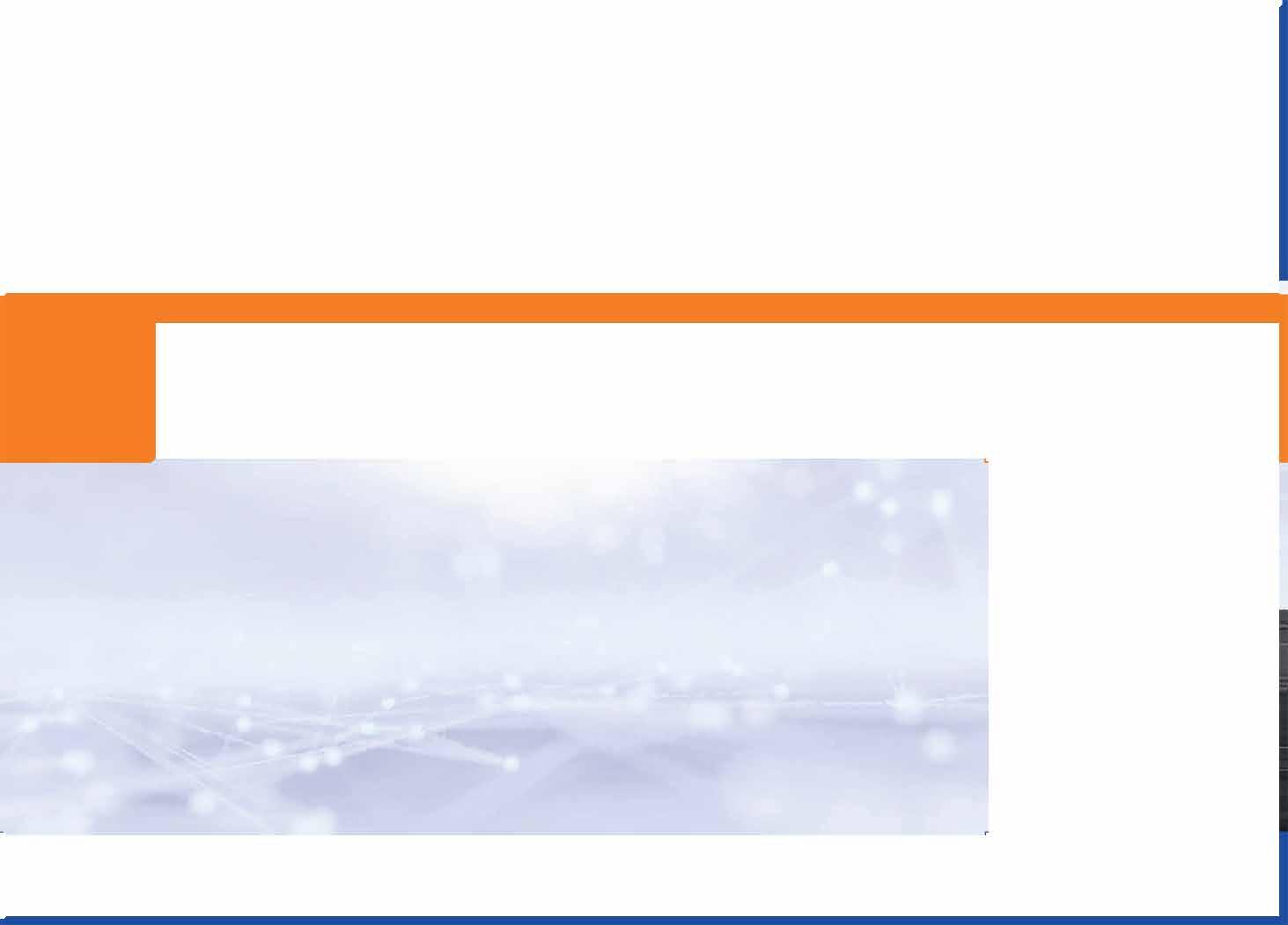

The Crazy Wisdom Community Journal • May through August 2024 • Page 31 CWyzar i ds o m ’s Gu i de toHolistic&Consciou
Resourcesforsouth east e r n M gihcina
your
for free in our online guide. Questions?
opportunities available!
iving
www.annarborholistic.com If you are a holistic practitioner or business owner, list
business
Email annarborholistic@crazywisdom.net Online advertising
Visit the improved, and updated Ann Arbor Holistic Resource Guide Since 1982, Crazy Wisdom has served as a regional resource for information in the areas of holistic health and integrative medicine, bodymind therapies, psychology and personal growth, Buddhism, spiritual development, and consciousness. Visit annarborholistic.com if you are searching for a practitioner or business in southeastern Michigan s L Robert Krasnick, M.D. specializes in:

What’ s New in the Community

Continued from page 30
to the children of the Tibetan Diaspora. In 2014 he was awarded the Khenpo (Abbot) Certificate by Goshir Gyaltsab Rinpoche, and in 2023 he completed his PhD in Buddhist studies at Visva-Bharati University in India. He has taught at the monks’ school in Rumtek, the Karma Kagyu Center in Hong Kong, and has taught Buddhist philosophy and practice online to students worldwide.
Chopel came to visit Burks in 2019 and taught with her at the Buddhist center she was a part of at the time. Shortly after he returned to Hong Kong, the Covid 19 pandemic hit, and he left the Hong Kong center to shelter with his parents. During this time, he reflected on what he would like to do moving forward. Burks said that positions in Asia had less teaching and more traditional ceremonies. Chopel had really connected with people here in Ann Arbor and was very interested in applying Buddhist wisdom to modern issues, which he would be more able to do in an American center—especially a center of his own to run as he felt inspired to. Burks began working on incorporating the Karuna center in 2021. She and Chopel worked with lawyers to gain nonprofit status and fulfill all of the requirements needed to allow Karuna to sponsor Chopel on a religious worker visa. The visa was granted in July of 2023, and Chopel arrived to stay in September. Burks serves as the President of the Center and assists with teaching. She said that as she is in her seventies, establishing Karuna was something she wanted to contribute as part of her legacy.
Currently, the Center holds two meetings each Saturday. The first is a sitting meditation led by Khenpo Chopel from 10:30 a.m. to 11:30 a.m. This is followed by a break for tea and informal discussion, followed by the second meeting, which varies in content. On one Saturday a month it consists of a traditional Tibetan service. Chopel also teaches a mindfulness course online through Zoom. All events are free and open to the public with donations accepted. The Center is working toward offering more programs having begun the process of growth through community outreach this year. If all goes well, Burks said, they may be seeking a larger meeting space by the end of 2024.
Burks said that she and Chopel “really welcome new people, and our goal is to work with people to figure out which spiritual path is most suitable to the person and their needs and goals.” Traditional paths, she said, may not be possible for everyone as they have commitments with jobs and families. But Burks and Chopel are available to talk with newcomers about how they can “figure out what they want to do spiritually”—even if they would not ultimately end up practicing with the Karuna Center. “There is only one reality but many different spiritual approaches,” said Burks, “and that’s something we want to honor.”
Karuna Buddhist Center is located inside Bethlehem United Church of Christ at 423 South 4th Avenue, Ann Arbor, MI 48104. Their website is karunabuddhistcenter.org, and Lama Nancy Burks can be reached via email at lamanancy@karunabuddhistcenter.org.
Newview Therapy LLC is a child, adolescent, and adult psychotherapy practice on Liberty Street in Ann Arbor that opened in the summer of 2021.
Melissa Danan Rilko, LMSW, Stacy Colias, LMSW, and Lauren Cunnane, LLMSW were friends, clinical social workers, and moms with children about the same age. Realizing the extent of the pandemic-related mental health crisis, they opened Newview wanting it to be more than a psychotherapy practice. Lead therapist Rilko envisioned it being a “first step in crisis,” providing resources and direction for people who might need “an area physician, dietician, or various other specialists.” She explained that people in crisis often don’t know where to go for help, and with many therapists fully booked and too busy to even call prospective clients back, it can be frustrating to try to find the needed services especially when trying to find a provider who accepts a particular insurance plan. Rilko gives her cell phone number to people in need and prides herself on helping people find and access services even if they don’t ultimately become a client at Newview. “I’m a social worker first,” she said. “We’re supposed to be resourceful.”
Specializing in treatment for eating disorders, anxiety, depression, OCD, and reintegration into social situations, Newview Therapy has become one of the go-to centers that University of Michigan Counseling and Psychological Services
(CAPS), area Emergency Departments, school districts, and the community look to when mental health interventions are needed. Between Rilko, Colias, and Cunnane, they work seven days a week and several evenings, in order to be as accessible as possible and to allow children and teens the ability to deal with mental health challenges and not miss more school. They offer a sliding fee scale and strive to serve people regardless of finances.
Newview takes a holistic approach to treating mental health issues. Rilko, who specializes in eating disorders, noted that she has seen a huge rise in new eating disorder diagnosis and exacerbation of existing eating issues since the beginning of the Covid 19 pandemic, perhaps due to feelings of isolation and loss of control, and more exposure to social media than ever before. She works to stay current on the cutting edge of new treatments and interventions to help her clients. She works with a consultant from Chicago who is familiar with all of the nationwide inpatient and other intensive programs for eating disorders to refer to for clients who need more than outpatient psychotherapy. “There is so much more for eating disorders than there used to be,” she said.
Lauren Cunnane, Melissa Danan Rilko, & Stacy Colias
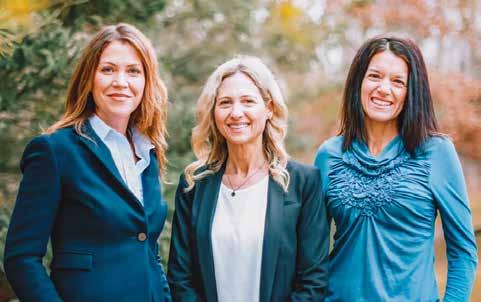
Newview offers telehealth sessions for those who need it, but Rilko said that in-person sessions “seem most effective.” To that end, their building, behind the Cherry Republic in downtown Ann Arbor, is in a walkable, and surprisingly, parkable space near a bus stop. Rilko emphasized, to anyone considering seeking therapy, “Don’t not call because you think you won’t get services. We can figure something out with all the resources in the area. We can help walk you through a very complicated system.” She encourages people who may not think their problems are “severe enough” to receive therapy to get help. “It doesn’t have to be long term. It doesn’t have to be a big problem,” she said.
Newview Therapy LLC is located on the second floor of the Fritz building, at 103 East Liberty Street, Ann Arbor, MI 48104. Their website is newviewannarbor.com, and they can be reached by email at info@newviewannarbor.com or by phone at (810) 516.8355.
Submit your listing for the September through December 2024 issue.
Please note that the “What’s New in the Community” column is part of the editorial (not paid-for-advertising) part of the CW Journal, and the editors may or may not include what you submit. Whether the editors include material or not will depend on space considerations, as well as other editorial issues, such as the need for high resolution jpgs and the overall mix of stories included in the “What’s New in the Community” column in a given issue.
If you would like to submit information to be considered for this column, please email communitynews@crazywisdom.net.
The firm deadline for submissions for the next issue (September thru December 2024) is June 30, 2024.
The Crazy Wisdom Community Journal • May through August 2024 • Page 32
Stay Connected Read the Crazy Wisdom Monthly
The Crazy Wisdom Biweekly morphed into The Crazy Wisdom Monthly in March and seeks to represent the voices of our community in a timely and entertaining manner. With NEW articles and personal essays, NEW event listings, and NEW author, artist, and musician interviews, it’s the best of Crazy Wisdom in a bite-sized read!

The
CRAZY WISDOMMonthly
Ellen Livingston , Director of Living Heart Health Ministry





The Crazy Wisdom Community Journal • May through August 2024 • Page 33
!
#133 RAZY WISDOM Monthly Folk Song Jam Along with Lori Fithian & Jean Chorazyczewski Visit our website to read the current and past issues of The Crazy Wisdom Monthly
Join our mailing list to receive The Crazy Wisdom Monthly in your inbox automatically the first of every month!
#134
LEAPS OF FAITH
TALES OF LOCAL BUSINESSES
By Laurel Decker
Photos by Edda Pacifico
This column is a look at a brave soul who has taken a leap of faith to open her own business—a woman following her dreams and thriving despite the odds.
Empowered Bumps and Boobs
Emily Stone (734) 812-0954 emily.stone.id@gmail.com empoweredbumpsandboobs.com
It’s okay. Go ahead and laugh at her company’s name. Emily Stone would be flattered. And to emphasize the play on meaning behind Empowered Bumps and Boobs, she would probably even hand you her favorite promotional product—a pen with a squishy breast at the top of it. I met with Stone to learn about her experience as a new entrepreneur during the Covid pandemic. But first, after a little laugh, I asked why she chose such a bold name for her business that provides coaching and support for moms who are new to motherhood and/or breastfeeding. Her answer? “It was about more than just marketplace boldness. Part of my brand identity is humor and not taking ourselves, or breastfeeding, too seriously. Most of the resources offered to new mothers is standardized and clinical, without much room for nuance or staying open to the curveballs that real life will throw at a breastfeeding mom.”
All joking aside, managing cultural biases was only one challenge Stone faced when she decided to start her unique business at a unique time in history. She shared with me how covid-19 affected her clientele who were among the most vulnerable groups during the pandemic. And Stone explained why she is passionate about supporting them in overcoming motherhood’s challenges.
Laurel Decker: Why did you create Empowered Bumps and Boobs, and what exactly does your company offer?
Emily Stone: Empowered Bumps and Boobs is like if my teaching experience, business degree, health coaching skills, and personal motherhood journey had a baby! From speaking with so many new moms and experienced moms, it became clear that there was a gaping hole where breastfeeding support should be. I heard over and over again, “I didn’t know what I was doing.” “It hurt.” “I didn’t make enough milk.” “My doctor told me to switch to formula.” “I was so exhausted, I needed someone else to be able to feed her.” “I had no support.” “I stopped before I wanted to.” “I felt guilty.” “I was sad.” “My supply dropped when I went back to work/took birth control/got sick.” “I had to choose my own mental health over continuing to breastfeed.” “When I went back to work, it was too hard to keep going, so we stopped.” Moms with teenagers STILL had big feelings about their birth and breastfeeding experience so many years later.
“Most of the resources offered to new mothers is standardized and clinical, without much room for nuance or staying open to the curveballs that real life will throw at a breastfeeding mom.” — Emily Stone
What I didn’t hear was, “I felt empowered to make informed choices and get the support I needed to reach my goal.” That has become the mission for EBB–to provide holistic education and support to pregnant and new moms to help them make empowered decisions around feeding their baby and caring for their own postpartum bodies. We do this with online courses, in-person courses, private coaching (virtual or in-person) and support groups (virtual or in-person). Our three pillars are courses, coaching, and community.
Laurel Decker: How did Covid affect your company’s development?
Emily Stone: During Covid I was speaking to friends who had “pandemic babies,” and the experience sounded awful. Hospital policies were changing daily. Laboring moms were having to choose between their partner or their doula being in the delivery room with them, and they were having to wear a mask while breathing through the most difficult work I know of. There were stories of brand-new babies being separated from a mom who tested positive for Covid. Those of us who know the criticality of skin-to-skin and early breastfeeding also know how beautifully the mom-baby dyad works to provide baby with mom’s
My first go at this was to create the podcast Spilling the Milk: Breastfeeding Chats to help moms connect by hearing others’ experiences and realizing they’re not alone in their challenges.

All joking aside, managing cultural biases was only one challenge Stone faced when she decided to start her unique business at a unique time in history.
The Crazy Wisdom Community Journal • May through August 2024 • Page 34
Emily Stone
antibodies. We were yelling at our computer screens, “No! That’s the absolute worst thing you can do!” New parents were so isolated in their homes, with no relief from parents, siblings, or friends who could provide support. This can already be an isolating time, especially for breastfeeding moms trying to figure things out, and social distancing practices exacerbated it. With all the things to worry about as a new parent, covid added more layers. I was working from home full-time and virtual schooling with three kids; it was stressful for me, but I was thankful to not be navigating pregnancy or postpartum during that time. I wanted to help those who were. My first go at this was to create the podcast Spilling the Milk: Breastfeeding Chats to help moms connect by hearing others’ experiences and realizing they’re not alone in their challenges.

Sometimes moms get lost in all the “stuff” and excitement around an adorable new baby. People want to hold the baby when really the mom may need extra nurturing.

Laurel Decker: How did your podcast develop during Covid?
Emily Stone: Before starting the podcast, I sent a survey asking moms what they wish they had known before trying to breastfeed and what advice they have for new moms. The response was overwhelming–so many women wanted to share their stories! They seemed grateful to have someone ask about their experience. They talked about “tongue tie,” nurses that were super helpful, nurses that were unhelpful, exclusively pumping, stopping for a medication—so many different aspects to breastfeeding I hadn’t even considered. It was clear they wanted their experience to help someone else. To me, this sounded like a podcast, with moms sharing their personal stories to benefit others. We often only hear the bad parts when it comes to breastfeeding, but in the podcast, there are many positive stories, and that helps paint the more realistic picture that breastfeeding is both challenging and joyful. Between what other moms teach me, and what I learned from having three boys of my own, I felt like it would be helpful to compile the information into a book. So, I’ve been focused on that lately.
Laurel Decker: Please tell us more about your book.
Emily Stone: Through my own journey as a mom of three boys, an important theme has been the impact of the nervous system and stress hormones on my body and being able to cultivate a state of calm in the midst of chaos. I learned how important this is to feeling like I’m thriving instead of just surviving—as a parent and a person. There are big implications for being able to find calm during labor, birth, and breastfeeding. It can really impact your experience for the better, and the skills you practice during this time will continue to be useful for the next 18 years and beyond. So, the book is called, Calm Your Tits: How to Soothe Your Nervous System for a Better Birth & Breastfeeding Experience. I hope to have it available for purchase by May 2024.
Laurel Decker: How do you stay passionate about what you do when you face the challenges of being an entrepreneur?



Emily Stone: One of my clients received our course and private coaching as a baby shower gift. She said it made her feel so seen to receive a gift that was meant just for her, her changing body, and transition into motherhood. Sometimes moms get lost in all the “stuff” and excitement around an adorable new baby. People want to hold the baby when really the mom may need extra nurturing.
To hear about tangible results of improving someone’s life and experience is amazing—like the message I received the other day from a recent client with a 5-week-old who wrote, “At your suggestion, I tried hand expressing and I’m getting sooo much more for my pump (when Dad gives baby a bottle). Thank you!” It validates that I’m doing the work I’m meant to be doing in the world.
Laurel Decker: Is there anything else you would like to share about Empowered Bumps and Boobs?
Stone believes that with support and information, new mothers can achieve what she considers “The best-case scenario—to feel empowered and to enjoy the experience of feeding their babies.”
Emily Stone: I love that being able to provide classes and coaching online to reach anyone anywhere in the world. A lot of that has to do with covid pushing us all to get more familiar with technology. But now that we are comfortable with being out and about again, my goal is to grow a team of coaches to be able to support a larger footprint for in-person visits.
To really expand our reach and how many moms we can help, I’m always looking for partnership opportunities with doulas, yoga instructors, massage therapists, physical therapists, chiropractors, midwives, etc. When we collaborate as professionals who care about moms and babies, we can offer a holistic support model that is better for everyone.
As we concluded our interview, it was clear that although Stone is lighthearted about her work, her commitment to it is no joke. She knows that there is a certain discomfort many people have with breastfeeding which comes from a lack of exposure to it in a normalized and positive way. And Stone believes that with support and information, new mothers can achieve what she considers “The best-case scenario—to feel empowered and to enjoy the experience of feeding their babies.” As a mom myself, I wholeheartedly agree that there is nothing more empowering than taking responsibility for our own journey while also knowing there are other moms like Stone nearby to guide and encourage us along the way.

The Crazy Wisdom Community Journal • May through August 2024 • Page 35 Call Beth for a free consultation (734)994-8010 DRUG FREE PAIN RELIEF WHOLE BODY HEALING IN THE PALM OF YOUR HAND AVACEN HEAT THERAPY www.indigoforest.com


Stories from the Farm— Sheep: Our Sweet Wooly Babies
By Karen Quinn
For as long as I can remember, February has always been synonymous with sheep. This comes from my lifetime on farms and from stories passed down by ancestors that I’ve never met, yet whose tales live on through the generations of Celtic folklore. One of my favorite folktales is of Cailleach, the divine winter hag of the Isles. Cailleach created the landscape using her basket of stones and her hammer. She would clash and fight for control of the seasons with Brìghde, the goddess of summer.
One way my ancestors knew Brìghde was ushering in the promise of warmer weather was to midwife the first lambs of the season.
One way my ancestors knew Brìghde was ushering in the promise of warmer weather was to midwife the first lambs of the season. With the birth of the lambs, fresh milk was also brought back to their tables, leading to a fresh supply of butter and cheese returned to their cellars. This event was so important to the people of the time that the midpoint between the winter solstice and the spring equinox was called Imbolc or Oímelc. Imbolc falls on February first or second depending on the celestial calendar. Imbolc translates to in- the-belly, referring to ewes pregnant with lambs (Oímelc translates to ewe’s milk). For many years now, I’ve had the pleasure of catching new lambs in early spring. Thankfully, with modernization of our food supply, we can wait a little longer to breed our sheep. So, instead of having lambs drop in the frigid gales of February, we can wait until mid to late March. I can honestly say that nothing really compares to those sweet little lamb faces yawning and shaking as they take their first breaths, the nail biting wait for them to find their mom’s teat for first feeding, their first steps, first naps (inevitably in a feed bowl), first zoomies, and first headbutts with siblings and cousins. All the while knowing, in the back of my mind, that this celebration of life was shared by our family’s ancestors from the “old country”—A thread held tightly through time, keeping our traditions alive.
Now, I’m not going to sugar coat it, or give you an Instagram lie about raising sheep being easy, because it’s not. Sometimes you get a home run, and the ewe is a doting, attentive mother who doesn’t need (or want) your help. The perfect
In the case of her triplets, we compared her to a short order cook at a diner during a Sunday morning church rush.


I can honestly say that nothing really compares to those sweet little lamb faces yawning and shaking as they take their first breaths…
example of this is my favorite ewe, Willa. She had twins her first pregnancy and triplets her second pregnancy. The moment those lambs hit the ground, she was cleaning them, encouraging them to stand, and making sure each one ate the same amount as the others. In the case of her triplets, we compared her to a short order cook at a diner during a Sunday morning church rush. The speed at which she had those new lambs cleaned and fed was darn near whiplash worthy. There are other times when the ewe is new to the process and needs a little intervention in order for the lamb to thrive. There have been times I’ve had to help ewes clear out blocked nostrils and open breathing passages. We’ve guided lambs to make sure they latch on in order to get that all important first shot of colostrum to help build their immune systems and get the much-needed fat into their bellies. This is especially true for ewes with multiple lambs.
Unfortunately, there are times when it’s even harder than that. Complications happen, and sometimes they can cause mothers to reject their lambs. Then the farmer ends up having to bottle feed, and in some instances that means having a lamb in your house to make around the clock feedings easier on the farmer. While this sounds fun to the kid inside all of us, I can assure you that the novelty runs out comically quick.
My most memorable “livestock in my home” experience was Zinnia, a Merino ewe lamb whose mother had rejected her. When we found her, she was almost frozen and required medical attention. Once she thawed and was stable enough to move, we brought her to our home and rehabilitated her for nearly two weeks. She loved to sleep in front of the registers and play with the dogs. Thankfully, she took to the bottle well and despite being a bottle baby, she wasn’t stunted in her growth. This was due to the fact that we were also milking our goats at this time, and she was able to receive fat-rich goat’s milk instead of powder formula. Thank goodness for small graces.
In the end, when the winter storms have passed, Brìghde has brought all our lambs into the world, and spring begins to blend into summer, it is always worth it. To see the lambs grow from helpless little babes into strong, confident stinkers who headbutt your knees from behind, steal your gloves from your back pocket, and get their heads stuck in water buckets, always makes my heart swell with pride. As the years pass and they age and mellow out, you get to know them all the better and find yourself seeking out a patch of shade in the pasture beside them on a hot summer day to just “chat about life” and reminisce of the days gone by when they were young and pooping in your living room.
Karen Quinn is a writer, homesteader, and crafter who lives on a rural urban farm in Livonia, Michigan with her husband, son, and a menagerie of animals. Her favorite things are gardening, reading, and drinking tea.
The Crazy Wisdom Community Journal • May through August 2024 • Page 36
Have you visited us recently? If not, come and experience the magic that is Crazy Wisdom! Fresh look, and lots of new items, plus old favorites.


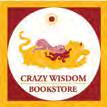

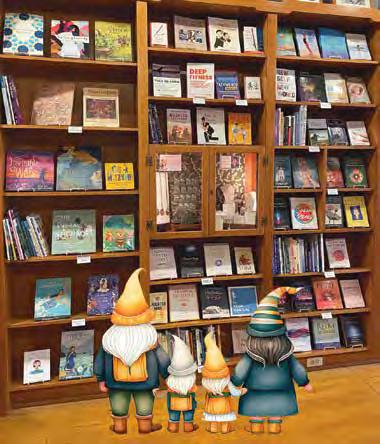

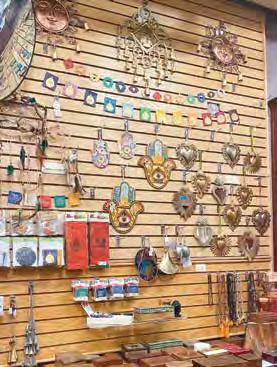


The Crazy Wisdom Community Journal • May through August 2024 • Page 37
114 S. Main Street Ann Arbor crazywisdom.net 734.665.2757
Crazy Wisdom Bookstore
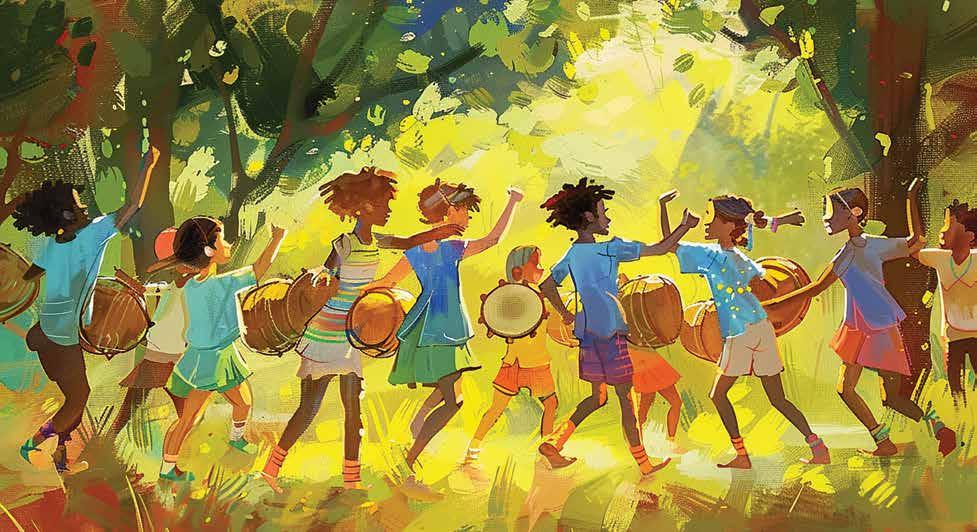
Rhythm: Good for What Ails You
By Susan Slack
What is free and available to everyone with no unwanted side effects? What may be good for helping with a long list of social and health issues? Have a look into rhythm.
Can you recall a moment with a group of people having the time of your life? What memory pops up first? Is it a sports event when you were all cheering, or dancing at a wedding, or maybe in a club when your favorite tune played? Did your experience include some kind of rhythm, or let’s name it “pulse,” that was pulling you all together? Most likely you weren’t even aware something else might be happening You just thought you were having fun. If you think you don’t have rhythm, spoiler alert, you do!

Have you ever tried to dance to Mozart? His melodies, and so many other composers, are intriguing and delightful, but have no booty! When melodic European music cross-pollinated with West African rhythms, American music was born.
“The rising and the setting of the sun, the waxing and the waning of the moon, the regular change of the tides in the sea, and the seasons as they come and go, all show rhythm. It is rhythm that makes the birds fly, it is rhythm that makes the creatures of the earth walk,” said Inayat Khan, Sufi musician and teacher in The Mysticism of Sound (1909). The closer we live to nature, the more we are in tune with this moving wholeness. If you’ve ever had the good fortune to be a part of an indigenous gathering and enjoy/receive their music, you can feel their relationship to the stars and rivers in the rhythm of their songs.
If you can’t relate to this, look at the music most of us hear these days, whether it’s your favorite pop, rock, country, jazz, or hip-hop tune, you are benefiting from indigenous people, mostly from West Africa. Have you ever tried to dance to Mozart? His melodies, and so many other composers, are intriguing and delightful, but have no booty! When melodic European music cross-pollinated with West African rhythms, American music was born. These days what primarily remains in our pop music is that pulse, still present, but mostly made by robots

What follows is several features of professionals in our area who are teaching classes, holding workshops, and hosting other engaging opportunities related to rhythm.
Biza Sompa was born in Brazzaville, the Republic of Congo, and has traveled extensively teaching Congolese dance and rhythms. He currently offers courses through the University of Michigan Dance Department. “Students find freedom in this class. When you are dancing to these rhythms, you are not thinking about your problems. Just five or 10 minutes and you are happy.”
Sompa is also Director of the Bichini Bio Congo Dance Theater Company of Ann Arbor which is slowly regrouping after Covid. “It’s an all-ages group with live drumming, performing traditional Congolese dances.” There aren’t classes for drumming in the Congo. There is no need. Growing up where drumming and dancing happen on street corners and in backyards, the rhythms are deeply ingrained and are played by young and old alike. Sompa elaborated:
“You can hear the drum rhythms in our language. We have rhythms for just having fun and for every gathering, like weddings and funerals. For instance, after a year of mourning, people gather again to pay respect and mark the end of grieving. The special rhythm tells you it is time to say goodbye. It is very healing.
Here in the United States, we go to adult living centers and hospitals. People start dancing even while they are sitting in their chairs. They’re moving their arms, nodding their heads, they are all clapping together. They are very happy. Doing rhythmical activities together like this is very healing. Especially when you have a good drummer who gives from his heart. He loves the music, and that love will transmit to the audience.
For U of M enrolled students interested in participating, contact Biza Sompa, UM Dance Admissions at (734) 763-5460.For those interested who are not students, contact Sompa for private learning by calling or texting (734) 6045483 or email jbbiza@gmail.com.
To learn more about the Bichini Bio Congo Dance Theater Company of Ann Arbor, their classes, and presentations, contact Serita at (734) 829-7930 or visit them on at facebook.com/A2Congo/.
There aren’t classes for drumming in the Congo. There is no need. Growing up where drumming and dancing happen on street corners and in backyards, the rhythms are deeply ingrained and are played by young and old alike.
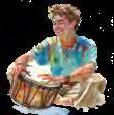
Each of North America’s 600 indigenous communities has their own language, rituals, and songs. If we dare to lump American Indian music into one statement, it would be that traditional music employs drumming, often with only one drum, playing the heartbeat rhythm for social and ceremonial events. This rhythm brings the people together into one mind. How did they know this? Something really big is going on here! We’ll get into the clinical research in just a bit.
The Crazy Wisdom Community Journal • May through August 2024 • Page 38

Ed Sarath is a Professor in the Department of Music and Jazz, and founder and co-director of Creativity in Consciousness Studies at the University of Michigan. He said, “Rhythm is inextricably bound to movement, which then connects with emotional engagement, and in turn mind-body integration. This directly enhances physical well-being and soul connection. So, it can be thought of as a kind of continuum that results in an organic fusion of the different dimensions. We are all in sync in that way, and we might not even know it. Now that’s rhythm! Anything that integrates mind, body, emotion, and spirituality is going to be beneficial.” Sarath had the following to add:
In many cultures, music is inseparable from dance, ritual, and spiritual transformation and all of life. In some cultures, particularly in Africa, there is no word for music as a separate, sound-based activity. So, because rhythm in one form or another is intrinsic to most if not all musical cultures, the link with ceremony and celebration is natural. Unfortunately, many have missed the great importance of African American rhythmic traditions in our culture and across the globe.
Whenever you have people making music together, especially if it’s rhythmic, you have the mind-body-emotional-spiritual connection within the individual, but then also you have the connection between individuals, and that is the most powerful way humans can communicate. It’s a collective meditation, collective rhythm. Rhythm is a matrix of benefits.

If we dare to lump American Indian music into one statement, it would be that traditional music employs drumming, often with only one drum, playing the heartbeat rhythm for social and ceremonial events.
Everyone is inherently musical. Whether they play an instrument or not. Everyone has the capacity to make music in different ways. We have the pulse which we equate with heartbeat. There’s the rhythm of the seasons and cosmic cycles. Central to my work is how improvisation and rhythm (as well as music without groove) achieve collective transcendence (and thus bonding) in action. My advice is to find opportunities of making music together where you enter into a field of consciousness, [and] to make that part of your regular experience.
Professor Ed Sarath has an upcoming course, “Creativity Consciousness in the Future.” You can contact Sarath at (734) 272-1063 or email him at sarahara@ umich.edu.

Lori Fithian has been leading rhythmic events since 1998. From family sing-alongs to cymbals in her high school marching band, she moved on to African and world percussion. In Ann Arbor, as in many cities, there is usually a stream of teachers and a grapevine for workshop information. Fithian caught a lot of know-how from this stream and shares her skills with anyone desiring to dive into that world of one mind.


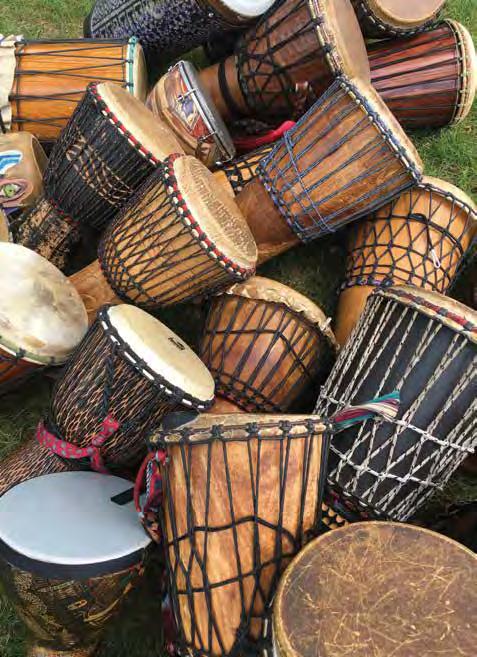
The Crazy Wisdom Community Journal • May through August 2024• Page 39
Rhythm...continued

“Drummunity” is Fithian’s very accessible program for all ages. At any given gig, she shows up with a minivan full of instruments and then a wonderful thing happens—a feeling of happiness overcomes. Participants become an ensemble, playing together like they are longtime close friends. Why is that?
“It’s a mystery,” Fithian answered. “Is it a steady heartbeat? You can walk better if you have a steady beat. It makes people feel good, like in a marching band. It’s energizing. Percussion helps people get in the groove together. As far as I know all cultures have had rhythm. We have Layne Redmond’s book, When the Drummers Were Women, A Spiritual History of Rhythm (1997) with photos, but we don’t know what they sounded like . Yet, I have seen people come to tears the first time they come to a drum circle. Why? Because it feels good. They always wanted to be part of a group.”
Fithian’s drum circles are disarmingly welcoming. She has a vast repertoire of games and practices that she calls upon at any given moment. She creates an open environment that gives you permission to have fun and let go of selfimposed blocks. A grandma who brings an interested child to the circle is gently offered a shaker. Grandma’s rigid, folded body loosens, and she smiles. Another young woman says she’s just there to watch. Fithian smiles charmingly and the woman finds herself strumming a ukulele and beaming.
Lori Fithian hosts open Drummunity sessions on the third Saturday of each month at Interfaith Center for Spiritual Growth. She travels all over the Great Lakes region, working in schools, libraries, camps, retreats, and other locations. You can join Fithian’s mailing list by emailing her at Lorifithian@mac.com. Learn more online at drummunity.com.
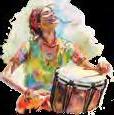
In many cultures, music is inseparable from dance, ritual, and spiritual transformation and all of life. In some cultures, particularly in Africa, there is no word for music as a separate, sound-based activity.
Layne Redmond was a pioneer in reclaiming women’s frame drumming. Her study into the history of percussion was published in her pivotal book, When the Drummers Were Women, A Spiritual History of Rhythm (1997). “One of the most powerful aspects of drumming—and the reason people have done it since the beginning of being human—is that it changes people’s consciousness. Through rhythmic repetition of ritual sounds, the body, the brain, and the nervous system are energized and transformed. When a group of people play a rhythm for an extended period of time, their brain waves become entrained to the rhythm, and they have a shared brain wave state. The longer the drumming goes on, the more powerful the entrainment becomes. It’s really the oldest holy communion.”
Entrainment? Even our computer spellcheck does not know this word. From the National Institute for Health website: “The earliest known reference to the modelocking, or entrainment, of two maintained oscillators is Christiaan Huygens’ description of two pendulum clocks “falling into synchrony” when hung on the same wall (1695). “Entrainment is an important characteristic of interactions between brain rhythms and refers to the coupling of two independent oscillatory systems in such a way that their periods of oscillation become related by virtue of phase alignment” (Cummins 2009).
Pop Quiz: What phase of the moon are we in right now? You can look it up online or, WOW! You can look up in the sky. Do you know everyone’s brain chemistry changes with each quarter phase of the moon? Douglas Rushkoff wrote on edge.org that, “New research suggests that our dominant neurotransmitters change with each of the four weeks of a lunar cycle. . . The first week of a new moon brings a surge of acetylcholine—we should be full of pep. The next brings serotonin—might be good for work. Then comes dopamine, where people tend to be more social and relaxed. Finally, in the last moon phase, norepinephrine takes the lead and may make people more analytic.” Many of us are experiencing the same rotating moods together!
Karin Nanos of Ann Arbor has spent her career as a Teacher of the Speech and Language-Impaired and an Early Childhood Developmental Specialist with an Education degree. She has taught in numerous educational settings working with children of all ages with complex communication needs. She said;
My most effective strategy has been using rhythm to improve communication skills. With the drum in the middle as a visual anchor point, my students are able to achieve the same rhythm, or turn-taking rhythms and movements, with minimal prompting and greater ease more often. For social skills, it’s a big win too, providing a sense of belonging and a sense of shared attention. Rhythm targets the very nature of communication which is interacting with others.
I remember a high school student who paid attention only to his hands and was more comfortable physically isolating himself away from others When I entered his classroom, he typically didn’t look up to acknowledge my presence. One day, as I carried the drum closer, he got up from his comfortable spot and pulled a chair to his location which I interpreted as, “Sit here. I want you here.” This was the first time he initiated communication with me followed by imitating simple rhythms. It was a remarkable connection.
When I worked with infants and toddlers ages one to three, identified as having language acquisition delay, I used a drum four feet in diameter. Children sat around it engaged with their parents and learning their friends’ names. With a very predictable song, they could share in the activity with coordinated rhythm involving everyone. The youngest of students exercised the nuance of stopping and starting vocalizations as referenced in an article published by Cambridge University. While your bodies are moving, so is the voice. When you have a predictable rhythm and you overlay a simple repetitive song with it, you are entraining breathing, the initiation of sound, the sustaining of sound, and the ending of sound which can be done in unison. It feels effortless to children. Rather than asking them to communicate or make those sounds, it just happens naturally when you engage with rhythm. Plus, this is all accomplished within an activity of fun and laughter.
To learn more about Karin Nanos you can reach out to her at kcnanos@gmail. com. If you are interested in reading the study she mentioned, you can find it at cam.ac.uk/research/news/why-reading-nursery-rhymes-and-singing-to-babiesmay-help-them-to-learn-language.
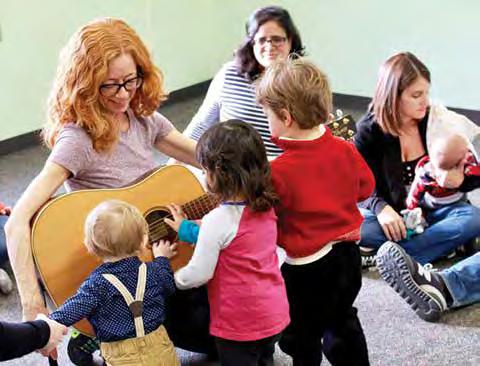
Everyone’s exhilarated, and smiling, and laughing. There’s something magical about moving together in rhythm.
 —Robin Robinson
—Robin Robinson
Robin Robinson has been the owner/director of Robinsongs for Kids since 2008 and has been teaching for 24 years. She leads a variety of programs for babies up to age eight working with material from “Music Together” as a Certification One instructor. It is a researched-based national program offering early childhood music to support social and emotional well-being.
Robinson had several thoughts on the issue of rhythm:
Parent involvement is key in this work. There are chants, instrument play, singing and small/large movement for the mixed age classes and a drumming class for the older kids. Even if the kids don’t participate in the class, when they see their adult playing along, modeling, and laughing, they are learning. I often reassure parents that each child learns differently, and we honor each learning style. Many times, parents report that when the kids get home, they know all the songs and the movements.
In the Rhythm Kids classes, each semester we learn patterns that are based on music from a different part of the world. First, we speak the patterns and move with them. Then we come up with creative substitutions and eventually drum the patterns. Everyone’s exhilarated, and smiling, and laughing. There’s something magical about moving together in rhythm. Children should be absolutely free. We don’t expect them to do it ‘right’ or even participate.
The Crazy Wisdom Community Journal • May through August 2024 • Page 40
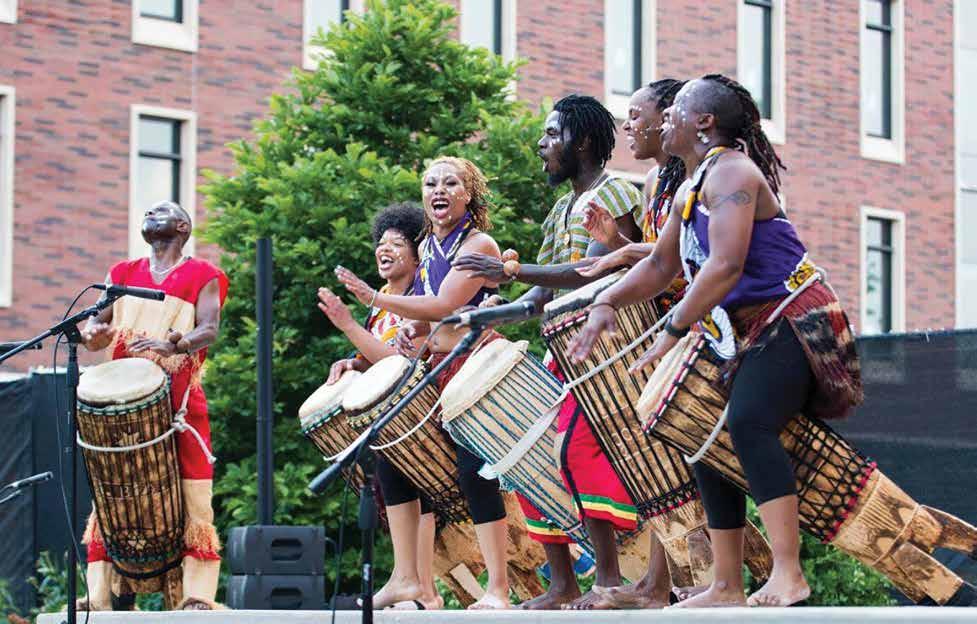
We honor learning styles, so we know some just watch. It’s a rare adult who doesn’t have rhythmic competency. Parent participation is key.
Rhythm teaches empathy and self-regulation. If things get a little out of hand, the main thing we do in class is to bring down the volume. That’s a great parenting tool.
Learn more about Robin Robinson at robinsongsforkids.com.
Clinical Studies on the Health Benefits of Drumming
There have been many studies done in the last twenty years that demonstrate the benefits of using rhythm in populations with Autism, dementia, traumatic brain injuries, and Parkinson’s disease, as well as those suffering with anxiety and depression. Michael Winkleman PhD of Arizona State University notes in his article Percussion and Distance Learning in Children with Autism, “drumming synchronizes the frontal and lower areas of the brain, integrating nonverbal information from lower brain structures into the frontal cortex, producing feelings of insight, understanding, integration, certainty, conviction, and truth, which surpass ordinary understandings and tend to persist long after the experience, often providing foundational insights for religious and cultural traditions.” (Winkleman 2000)
Studies show improvement in children with neuro divergent conditions, by expanding their attention span, providing a forward momentum in reading and speech. Drumming in a group may improve social skills and interaction.
Drumming has also shown to boost immunity, improve inflammation in the body, improve cognitive functioning and blood circulation. “A 2014 study published in The Journal of Cardiovascular Medicine found that drumming helped improve blood circulation. It’s believed that the rhythmic movement of the hands and feet helps stimulate the flow of blood through the veins and arteries.”
Maybe rhythm is about mysticism—recognizing yourself in the big picture. Your body is already in rhythm when you walk, chew, breathe, beat your heart, think in your brain, sleep, and wake. Drumming is a microcosm of the turning of the whole cosmos and a way to remember your place in it. As stated in A Joseph Campbell Companion: Reflections on the Art of Living (1991), “The goal of life is to make your heartbeat match the beat of the universe, to match your nature with Nature.”
Susan Slack is an author, musician, and certified leader for the Dances of Universal Peace. Learn more about her at https://slacksusan.wixsite.com/ susan-j-slack. To learn more about Dances of Universal Peace visit them at Ann Arbor Dances of Universal Peace 2024.

Further Online Reading on Rhythmic Benefits:
Benefits of Rhythm for those with Autism:
https://static1.squarespace.com/ static/574191f24c2f8522317db6b1/t/577bee216a4963d30fb2 e6a8/1467739682715/FULL+PercussionAndDistanceLearningAuti sm.pdf
Benefits for those with anxiety, depression, stress:
https://www.ncbi.nlm.nih.gov/pmc/articles/PMC4790847/
https://www.ncbi.nlm.nih.gov/pmc/articles/PMC6041820/
https://journals.plos.org/plosone/article?id=10.1371/journal. pone.0151136
Benefits for those with Dementia:
https://www.ncbi.nlm.nih.gov/pmc/articles/PMC7343932/
https://www.researchgate.net/publication/266744908_Improved_ Executive_Function_and_Callosal_White_Matter_Microstructure_after_ Rhythm_Exercise_in_Huntington’s_Disease
Benefits for those with Parkinson’s Disease:
https://www.ncbi.nlm.nih.gov/pmc/articles/PMC4914050
General health benefits for all:
https://www.sciencedirect.com/scie.ce/article/abs/pii/ S0197455614000537
https://pubmed.ncbi.nlm.nih.gov/17261984/
https://pubmed.ncbi.nlm.nih.gov/24983262/
https://www.donovanhealth.com/blog?tag=group+drumming
The Crazy Wisdom Community Journal • May through August 2024 • Page 41
Bichini Bio Congo Dance Theater Company of Ann Arbor.
 Article
Article
and
Holler Fest:
Photos by Hilary Nichols
Ann Arbor does summer well. This town comes alive with outdoor music from June to September, but each summer the local musicians and music lovers know that to wind-up the summer, Holler Fest is the place to be.
Holler Fest is a musical heart’s happy place. This three-day music festival is the favorite feel-good gathering of the season. It is held on the fourth weekend in August annually at Frog Holler Farm. Nearly 80 acts, and an audience that adores them, flock to this farmland turned festival grounds for this annual tradition. Established bands and new combinations of talented friends take to the five stages that are spread across the hills and hollows, in the woods, and tucked into a well-worn, but much-loved cabin. The cabin is very acoustic for smaller, more intimate sets. Squeezed in, knee to knee, fans sway and swoon for their favorite bands in this romantic little room. “People love to play in the cabin. It is so intimate. The sound of the stone walls is so special,” Cathy King, the matriarch of the King Family, owners of Frog Holler Farm, shared with me. “The musicians want to come back every year. Joe Riley was at the very first gathering. He was so friendly and warm. He has played every fest but one since.”

[Ann Arbor] comes alive with outdoor music from June to September, but each summer the local musicians and music lovers know that to wind-up the summer, Holler Fest is the place to be.
Together with her sons Edwin, Kenny, and Billy King, and daughter-in-law Emily Foley, Cathy hosts the festival while running their small-scale organic farm. “We work together on the farm and on the festival. It is fluid; we all pitch in and just do what needs to be done since we all live on the property.” This has been an all-hands-on deck operation since the festival started in 2007.
“Inspired by music festivals up north, Billy and Kenny King planned a big party at Frog Holler Farm to celebrate the King family’s 35 years on the land, …” is how the event is introduced on their website. Their neighbor Tom Hines came through to help put up their first stage, and he and his family have been contributing in countless ways ever since. Hines mows the grounds all summer, recently clearing a new area to expand camping into their “Enchanted Peninsula” area as the festival has grown.
Now upward of 100 volunteers pitch-in over the event weekend. Thirty or so more volunteers are dedicated to the production throughout the year. “We certainly could not do it without them,” Cathy says of her volunteer crew. “This festival has taken on a life of its own with all the good energy of our team.” The impact of the team is felt. Their kitchen manager Angie Martin introduced the “free store” which is a well-loved aspect of the event. Ceramicist Doug

The Crazy Wisdom Community Journal • May through August 2024 • Page 42
Loren Kranz of the Loren Kranz Band.

A Happy, Hoppin’Place
Worthington first brought his Doug’s Mugs to sell and soon became the vending manager. Tom Huber came initially in 2008 as a fan with his family in tow, and soon enough, they all became indispensable volunteers. “Tom is a real builder. He led a team of volunteers to build our kitchen,” said Cathy. Tom’s family all come the week before, camp, and bring food for the volunteers. His wife Edith leads the clean-up team with their buckets and brooms. “We call them the bucket and broom brigade.” The two families mix their talents musically, too. Tom Huber with his daughter Donya and younger son Kaden collaborated with Billy King in their band, Eyes Unclouded.
Cathy’s late husband Ken King, “always thought of himself as a musician.” He would host barn parties and dances on the property.
Set in the Irish Hills, the property is so hilly and wooded they were initially told it was unsuitable for farming. That didn’t stop Ken and Cathy, along with their partners, from purchasing the piece of property in 1972 as a place to grow vegetables for their restaurant Indian Summer, on State Street in Ann Arbor. Soon after however, the partners began to devote themselves to their disparate undertakings. The Kings focused on Frog Holler Organic Farm, becoming the first organic growers at the Ann Arbor Farmers Market. While their partner, Rick Peshkin, went on to create what is now Ann Arbor’s premiere produce whole-


Robert Jones from Music that Matters
saler, Frog Holler Produce, and also The Produce Station. The King family still operates the small-scale Frog Holler Organic vegetable farm on a two-acre patch on the property. “We had to start from scratch on this beautiful but abandoned piece of land,” Cathy King told me. They sell their produce at the Ann Arbor Farmers’ Market each week. “Our farm sales support the festival. It makes no sense at all, but we never make any sense,” she declared. Financially the festival might not make a lot of sense, but that has never been the purpose of this wonderful affair. Cathy explained, “The farm is beautiful. It makes no sense not to share it.” And share it they have. Last year there were nearly 2000 in attendance, with the musicians, volunteers, day visitors, and weekend campers tucked into all corners of the land.
Just 35 minutes from Ann Arbor in Brooklyn Michigan, the festival is simple to attend as a day visitor, but last summer I set up my tent on the hill for the weekend, with a perch to really witness how the festival flows. Townies and bandmates were deep in conversation in the green room that was filled with good cheer, a couple of couches and always coffee, tea, and snacks. The stage manager, Barry Lonik,
The Crazy Wisdom Community Journal • May through August 2024 • Page 43
Amy Lynn


Last year there were nearly 2000 in attendance, with the musicians, volunteers, day visitors, and weekend campers tucked into all corners of the land.



The Crazy Wisdom Community Journal • May through August 2024 • Page 44
Colin Larking of the Loren Kranz Band.
Paul Militello of Rhythmfamily Drum Song
Frog Holler guests getting their groove on.
Photos by Hilary Nichols




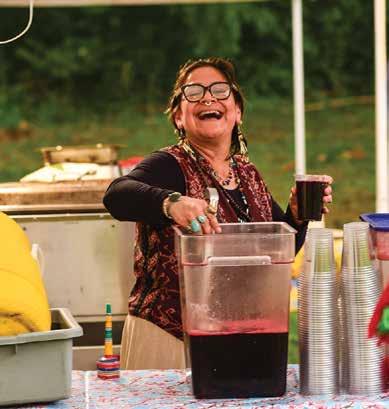

The Crazy Wisdom Community Journal • May through August 2024 • Page 45
Christopher Neal works in the lighting booth.
The band Gemini with Sandor Slomovits, Jennifer Burd, Emily Slomovits, and Laszlo Slomovits.
Two girls enjoying the Kid Zone.
Jeff Branch of J. Michael and the Heavy Burden.
Sylvia Noolasco of Rivers of Pilar’s Tamales.
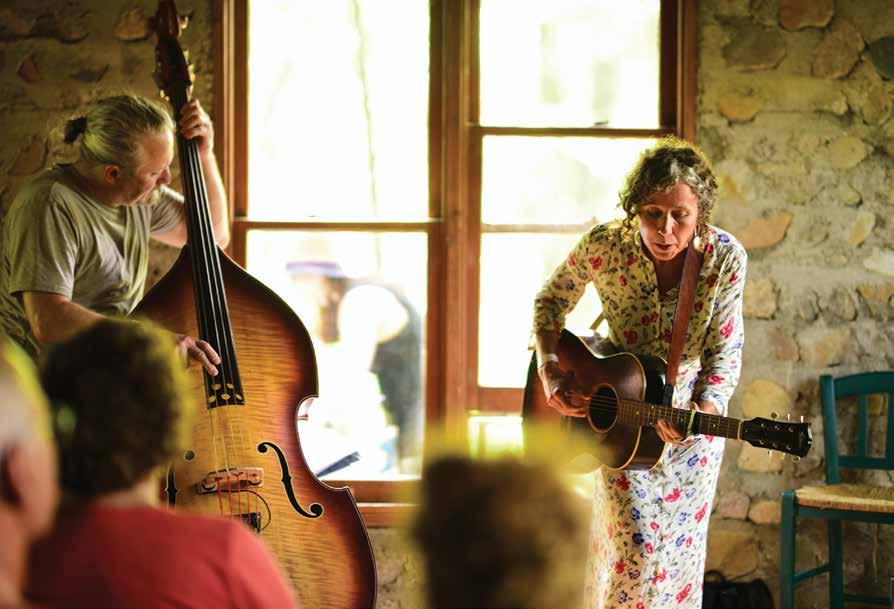

Squeezed in, knee to knee, fans sway and swoon for their favorite bands in this romantic little room.
brought the next act up and the announcer, John Bommarito, kept the crowd hyped while the sound system and lighting was carefully cajoled to play over the large lawn. The level of professionalism was uncanny for this small family festival. It was clear that everyone wanted to lend a hand.
On stage, headlining acts were interspersed with old timers strumming their fiddles and harmonizing to the classics. The audience sat in their own camp chairs in the natural amphitheater singing along and hooting and hollering at all the heart and happiness that was amplified throughout the day. Parents frolicked across the lawn, chasing toddlers and dancing amongst the grandparents and teenagers, while old friends stopped for hugs and continued toward their next show. Everyone there was clearly connected through the love of music, and the Ann Arbor small-town tribe. This was a chance to come together to play, d participate, and celebrate the simple joys of life around the campfire: music, friends, family, and cooperation. The setting was simply idyllic. “Everyone really responds to the family feeling and the vibe. We do get people telling us that they feel at home… it’s a community feeling,” King affirmed.
Each afternoon we witnessed neighbor Tom Hines deliver a large log in the claws of his excavator. His grandson Sullivan assisted as they situated it to standing in the middle of the fire ring. The four-foot-high tree stump stayed lit in this Swedish Torch tradition throughout the night, billowing its fragrant smoke and sparks across the grounds. We gathered close for warmth and for drumming with Sundance DiDomenico and Paul Militello, before moving on as another show beckoned us back to another stage. Last year I was wowed by Donya Kiana’s hauntingly elegant act and Anne Erlewine’s emotionally true singersongwriter show in the rustic farmhouse. Cassie Catania’s late night aerial show on the hill was awe inspiring, and the crowd-pleasing big band, Jive Colossus spilled beyond the second stage and kept the crowd on their feet dancing and bouncing along to their world funk sounds.
However, it was Billy King belting out his heartfelt tunes from his own back yard that really brought me to tears. Along with his band—Prime Time and The Headliners, he delivered kindhearted vocals, made more impactful at full volume. The crowd pressed forward and pumped their fists in the air, shouting along in unison. As I took it all in, it became undeniably clear, this is real—as real as it gets.
Don’t miss the Holler Fest this summer August 23-25th. Learn more at hollerfest.com.

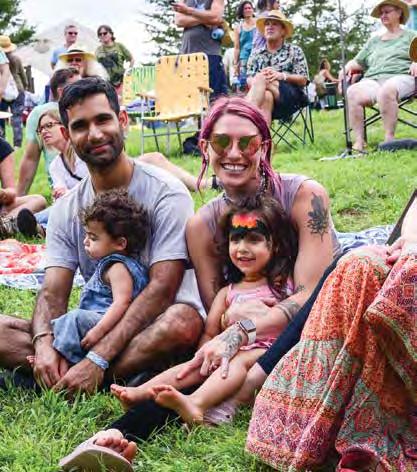
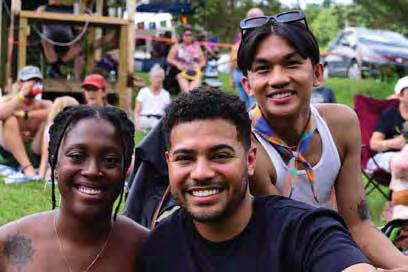
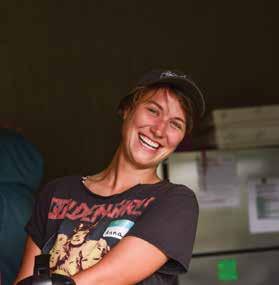
The Crazy Wisdom Community Journal • May through August 2024 • Page 46
Ozzie Andrews on bass and Anne Erlewine on guitar.
Chanda Rollins, Lonn Hartman and Shane Nicolas
Anna Snoeyink
Rajat, Azalea, Zinnia, and Jillian Diwan of Jamhands Body Work and Yoga
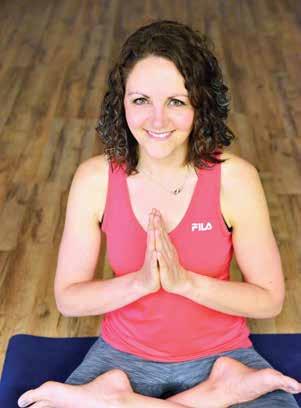
Dear Katie,
Namaste, Katie...
Whether you're a seasoned yogi or getting ready to roll out your mat for the first time, here you'll find a variety of useful tips from local yoga instructor, Katie Hoener.
Katie Hoener is a RYT 500, receiving her 200 and 500 hour trainings. She is also a Licensed Master Social Worker and a partner at Verapose Yoga in Dexter (veraposeyoga.com). Please send your own yoga questions to katie@ veraposeyoga.com.
I have made movement my intention for 2024, and so far, so good! With adding some new and fun activities to my routine my hips have been feeling it. I have been consistently moving through the Warrior Poses. Is there something reclined that I can add to my days?
Carli, Ann Arbor
Namaste Carli,
What a phenomenal intention for this year! My intention for this year is Restore, which has required a lot of attention, and of course, intention. Both of our intentions can take so many shapes and forms, and it looks like for your question we can combine them! A beautiful restorative posture that helps the hips in so many ways is our Ananda Balasana, or Happy Baby.
To come into Happy Baby, we start on our back. Gently draw the knees in toward the chest. For most of us, a few breaths here allow us to see how the hips and low back are feeling and decide how far we may want to take the posture. From here, we bring the hand to the knees and let the knees drift away from the midline of the body. There are many days when I hang out here, knees toward the outer edges of the body. Wherever we end up, we may want to sway a bit from side to side, or move the legs back and forth, rolling the femurs in the sockets. If it feels good, we can allow the lower legs to push up toward the sky. The hands may find the hamstring side of the leg, perhaps right behind the knees. They may hold onto the calves, the ankles, the feet, and some of us may even want to find the toes.
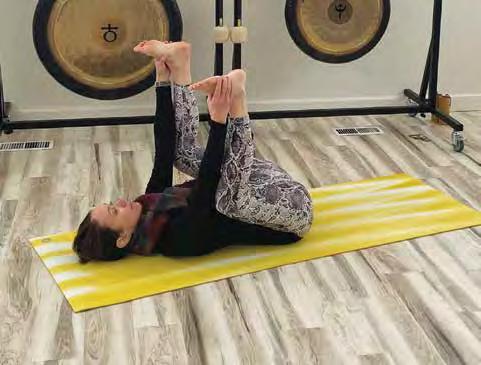
A beautiful restorative posture that helps the hips in so many ways is Ananda Balasana or Happy Baby.
Wherever we end up, make certain that we are not straining the shoulders or grasping with the hands. Every hold with the body should be supportive rather than straining. As stated above, we may want to rock from side to side in this space, and if we have the lower legs extended here, we may wish to play with extending one leg and then the other. Add as much of your intention of movement as suits the day and feels comforting and supportive to the body. Breathe into the space for ten or so breaths, allowing your body to settle into the pose. When coming out of Ananda Balasana, find your way back into a place with your knees in toward the torso. See if there are noticeable differences in how the body feels. Maybe allow yourself to come into the posture one more time or to wait until tomorrow, whatever feels better!
Namaste Katie,
After a long streak of missing meditation day, I am struggling to sit down and stay quiet. Any tips for getting back into a practice?
Janet, Manchester
Namaste Janet,
Following a lengthy time of steady practice, a lapse like this can feel like a set-back. I encourage you to think about this break as part of the practice. Over the years there have been many questions about how to start, and how to maintain a meditation practice; the answers all come back to the same core idea of “practice.” How do we get into the practice of setting aside the time for ourselves to have, and to dedicate ourselves, to the practice of quieting the mind? Our yoga sutras call this “tapas” which not only translates to a consistency of practice but also to a “burning drive.” It’s the desire to return to the quiet, to ourselves, time and time again.
One way that we can offer ourselves a way to come back to our meditation practice is with something tangible. For some of us, it is a candle to gaze at or maybe a picture of something or someone that we hold in high regard. Other times that tangible thing is ourselves—through the use of a mudra. Dhyana Mudra is the Mudra of meditation and allows us to bring ourselves back to the feeling of connection between the hands and the space between the hands.
Following a lengthy time of steady practice, a lapse like this can feel like a set-back. I encourage you to think about this break as part of the practice.

To come into Dhyana Mudra, rest your left hand in the lap with the right hand resting on the left hand with the thumbs coming together to lightly touch. Spend a few breaths noticing the contact the hands are making. Does it feel restful? Is there any tension that we can let go of here? What other sensations can we notice? Are the hands cool or warm? Is one a different temperature than the other? How does it feel to rest the hands into the body? What is the pressure between the thumbs like?
If this starts to move you back into a space of stillness, stick with this. You may find that one of the above questions is all you need, and you cycle back to it when the mind wanders. I like to return to the pressure between my thumbs, seeing when it is hard to distinguish between the right and left thumb. If you’ve been there in a meditation, you will understand this; if not, you will get there in some way when the time is right.
Another way to play around with Dhyana Mudra is to move past the physical presentation of the energy lock and breathe into the space between the hands. If this feels too advanced, please go back to the points of focus that feel good to you! If focus on that energetic space that you are holding in this mudra pleases you, guide your awareness and breath to all that you contain. This hollow space represents the idea that the less we try to control the mind the easier of a time it has of finding rest. See if your awareness will find peace in this place.
No matter what focus you find, try holding that for one minute then increasing to two minutes. Build your practice back up in a way that feels empowering rather than feeling like you need to match your previous levels. All practice is beneficial to the mind and beyond!
The Crazy Wisdom Community Journal • May through August 2024 • Page 47
YOGA COLUMN

Getting and Staying Fit with Support and Community
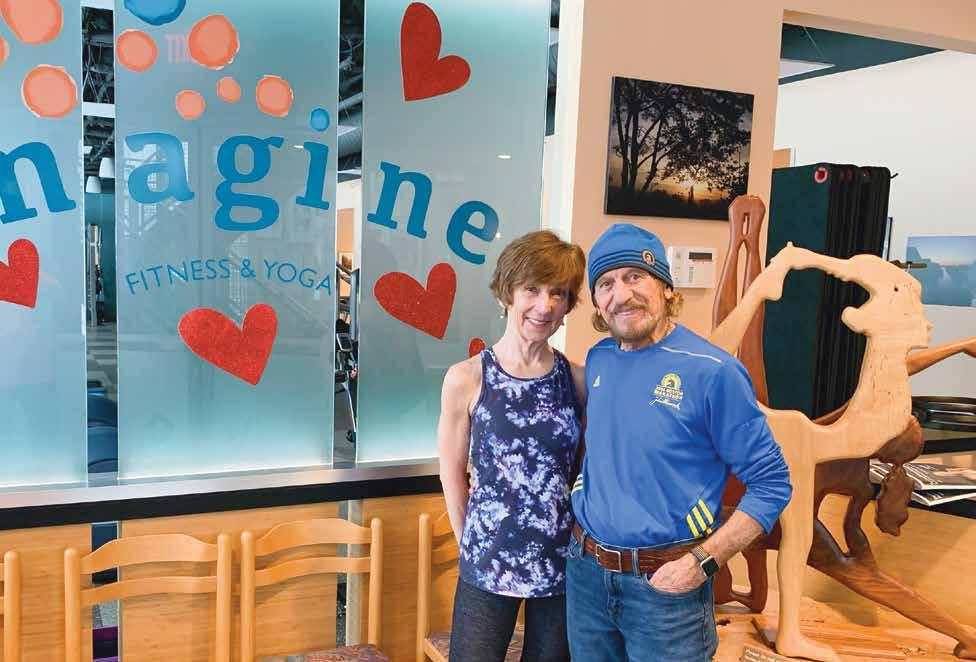 By Sandor Slomovits
By Sandor Slomovits
It was a fall day in 2014. Dr. John Farah, at the midpoint of a ten-mile training run, tapped the wall of the State Theater before heading back to his home on the west side of Ann Arbor—a little tradition he originated with his running buddies—when a thought came to him: Imagine would be the perfect name for the fitness, yoga gym, and studio he and his wife had been planning to open. “It’s a word I’ve always loved,” he wrote in his recently published memoir, also titled Imagine. “It represents so many of the principles that have guided my life…inspiration, flexibility. The power of thinking in new and challenging ways.”
It is not surprising that Dr. Farah got the idea for the name of the fitness and yoga center while on a long run. After all, he has been an athlete and a fitness enthusiast for most of his life. He has run competitive distance races, including more than 100 marathons for decades—19 of them in the famed Boston Marathon. (For several years and last summer at age 79, he ran the Crim which is a 10-mile race in Flint.) He’s also been a sailor, a skier, snowshoer, and bicyclist, and has been leading fitness classes at Imagine Fitness and Yoga ever since it opened in the summer of 2015, less than a year after he got the idea.
It is not surprising that Dr. Farah got the idea for the name of the fitness and yoga center while on a long run. After all, he has been an athlete and a fitness enthusiast for most of his life.
“I've always been kind of a people person,” he said. “And I was always disappointed with gyms and fitness studios where people come and go. They'll walk in, work out, and leave. But do you ever meet anybody there? Does anybody ever talk to you? So, I was thinking it'd be nice if there was a place where you get to know people and they get to know you. Working out is fun, but the social aspect of it would be a part of it as well.”
John’s wife, Jackie, felt the same way. “I’ve always wanted to be active, not doing really formal exercise, but outdoor things. I was always doing something. Typical gyms and fitness centers always made me feel isolated. To me, if I was going to feel isolated, I might as well do my own thing where I want.”
“When Jackie and I created Imagine, we had a vision of what it would look and feel like,” said John. “We wanted it to be different. We wanted it to be unique. Fitness, yoga, and health have been a part of our lives for years. We love how yoga and exercise makes us feel, how it energizes our bodies, our minds, and our lives. We truly believe exercise is something that is best when it’s shared in a supportive environment.”
John recently retired after a more than forty-year career as both a highly respected dentist and as the founder and publisher of an influential magazine for dentists, The Dental Advisor. Both John and Jackie refer to Imagine as their “retirement gig.” “Some people buy a house in Florida,” Jackie said. “Some people buy a yacht. This is our yacht. We're going to sail out there healthy!”
John added, “People spend a million dollars on a yacht, and they use it twice a year. Here, at least I use it almost every day.”
The Crazy Wisdom Community Journal • May through August 2024 • Page 48
Dr. John Farah and his wife Jackie
Imagine occupies the ground floor of the building on Ann Arbor’s west side that houses Dr. Farah’s former dental offices. It is also on the same property as the former offices of The Dental Advisor. “When we decided to do this, [start Imagine] it was across the street from my full-time job at The Dental Advisor,” said Jackie. “I was coming back and forth, overseeing things here. That's how it started evolving.” When a tenant left, John said, ‘We'll just turn it into a yoga center, and we'll make it a one-stop shop.’ A lot of places just do one thing and so you're going there for this, and there for that. We have Yoga, Pilates, fitness classes, biking, we have Tai Chi. It's a little bit of everything. We also put in a massage room, so you can have just one membership and find everything you want.”
“We wanted it to be different. We wanted it to be unique. Fitness, yoga, and health have been a part of our lives for years. We love how yoga and exercise makes us feel, how it energizes our bodies, our minds, and our lives. We truly believe exercise is something that is best when it’s shared in a supportive environment.”
—-Dr. John Farah
The studio where most of the yoga, Pilates, Tai-Chi, and other classes are held, features a comfortable, heated floor with a beautiful view of woods through large windows. There is a deck out back surrounded by trees. In nice weather, they do the yoga and fitness classes there. The gym room features a variety of weight machines, free weights, bikes, BOSU balls, Pilates rings, blocks, and more. The walls are lined with framed posters of some of the marathons in which Dr. Farah competed and pictures that he took in his travels. There is a small, separate room for personal training work, which includes a Pilates Reformer machine that’s available for clients to use with guided instruction. The lounge has comfortable chairs and couches. Coffee and a variety of teas and snacks are always available.
Imagine weathered the pandemic, though—like most other businesses—not easily, especially at first. Jackie’s long experience with computer technology was the saving grace in setting up virtual classes. “I think Imagine would not have survived without Jackie, quite frankly,” said John. “But,” Jackie added, “what I found was that people were back to being anonymous. It got to the point when we were doing virtual classes that people would say, ‘Can you start class fifteen minutes early so we can talk to each other?’ That was a testament to the community feeling that we had created.” Once the pandemic eased, John and Jackie saw that, “People were anxious to get back into the personal, cozy space we offered. It's still the case. While many studios and instructors remain
The studio where most of the yoga, Pilates, Tai-Chi, and other classes are held, features a comfortable, heated floor with a beautiful view of woods through large windows.
virtual, our community is just that, a community where people enjoy being with one another.”
Many of the people who come to Imagine come for the classes. “They like the guidance. They like the chitchat. They like the community feel of seeing the same people” Jackie said. “Especially in the wintertime. They'll come and take one class after another. Then they'll be in the lounge having coffee and snacks. If you're retired, and you're at home, and it's another gray Michigan day, you come here, you meet up with friends, you get some exercise in, have a coffee.... It's a nice feeling that we can offer that to people, and it's healthy for them.”
The daytime classes are primarily retired people, some at-home moms, and people that are working from home who come for a break in their day. “In the evenings, we get more of the after-work professionals,” Jackie said.
“We're not training athletes,” said John. “We're not training sports enthusiasts. We're not bodybuilders.” Jackie agrees. “We're working with people that are trying to maintain their health and do what they can to strengthen functional movement through life.”
In his first book on running, Let’s Pick it Up a Bit, John wrote, "Injury, pain, the natural wear and tear on your body, even the aging process itself, are not things that can just be ignored or even fought through—they must be dealt with, embraced in a smart, measured way that neither admits defeat nor takes victory for granted. Acceptance, hard work, persistence. Those are the true keys to longevity.” They’re a part of Imagine’s guiding philosophy to this day.
Jackie said, “What's heartwarming is when someone comes back and says, ‘I stumbled and started to fall, but I caught myself. It made me realize if I wasn't coming to Imagine, I might not have been able to recover.’ Or they’ll say, ‘I notice a difference because I can do this.’ My favorite is when they go to a gym with their kids while visiting them out of town, and then they tell us, ‘My kids are so surprised at how much I can do!’ That's very fulfilling.”
John and Jackie, as well as their instructors, are always on the lookout for new things they can bring to Imagine. “We are able to offer special clinics to our community from other health care professionals, including nutritional consults and people with posture expertise,” said Jackie. “We're very fortunate to have some incredible instructors.”
“Jackie and I, we wanted some place where people knew each other” said John. “I think we've succeeded in creating that kind of community feeling here.”
Learn more about Imagine Fitness and Yoga online at ImagineFitnessandYoga. com. Imagine Fitness and Yoga can be contacted at (734) 622-8119. It is located at 3100 West Liberty Road, Ann Arbor, MI 48103.

The Crazy Wisdom Community Journal • May through August 2024 • Page 49
Photo by Sam Teresky
Jody Tull—
The Journey of a Long-Time Ann Arbor Yogi
 By Grace Pernecky • Photos by Edda Pacifico
By Grace Pernecky • Photos by Edda Pacifico
Jody Tull was trained in the Sivananda Vedanta Yoga tradition after receiving her master’s degree in Piano Performance and Music Education from Columbia University. For the past three decades, she has brought her unique approach to teaching to the Ann Arbor area, combining her music background with yoga, meditation, and healing in distinct, interpersonal ways. For years now, Tull has taught the Finding Your Voice workshop that she developed through her years of expertise in yoga and professional music background. She teaches this workshop along with yoga classes in a variety of locations throughout the U.S., Europe, India, and the Bahamas. She leads an annual yoga meditation and hiking retreat in Soglio, Switzerland. Tull is also the founder and director of Be In Awe Yoga Center, where she sets an example of what a yoga community and relational practice can look like.
Though Tull was a flight attendant at the time and had become accustomed to the gradual rise and fall of a plane through the sky, for whatever reason, she really felt ill this time around
Once Upon a Time, 40,000 Feet Above the Ground…
Jody Tull did not feel well.
The airplane was already well on its way to its destination. Though Tull was a flight attendant at the time and had become accustomed to the gradual rise and fall of a plane through the sky, for whatever reason, she really felt ill this time around.
A woman sitting next to her noticed. “You look like you don’t feel so good.”
Tull looked up. “Yeah, I feel really horrible.”
The woman leaned in and spoke the words that would forever alter the trajectory of Tull’s life. “Would you be up for an experiment?”
“At this point, I’m in my early twenties,” Tull said, relaying the beginning of her yogic journey to me as we sat at a table at Avalon Cafe and Kitchen in Ann Arbor thirty years later. “I thought, what do I have to lose? ‘Sure, I can be up for an experiment.”
And so, many years ago in a plane, 40,000 feet above the ground, the woman guided Tull through a couple of basic yoga breaths and stretches. “I felt 200% better,” Tull recalled, still obviously in awe at the transformation.
Young Tull asked the woman how she could learn more. “Try Richard Hittleman’s 28 Days to Yoga,” she said. And so, when Tull got off the plane, she made a beeline for the nearest bookstore.
“For the next 28 days, I gradually felt taller, more alive, full of curiosity, and full of wonder. Why is this happening to me? Why is this so good? And easy?” Present-day Tull reminisced, wondering at the paradoxical immensity and simplicity of her experience.
Tull was a musician living in New York at the time. She was composing music and taking voice lessons at Columbia University where she was pursuing a degree in music education. On the 28th day of her yoga journey with Richard Hittleman, she was walking past a series of brownstones, wondering what was next, when she spotted a “jolly-looking picture, next to this very vibrant-looking bald head. It read ‘Sivananda Yoga Center.’”
Another hidden thread, another part of the universe was opening up to her without effort. She knew that this was what was next.
“I had butterflies,” she told me. “It was edgy for me to go in there. There wasn’t a buzz about yoga at that point. This was in the 90s. I was raised to be familiar with evangelical Christianity. And so, I had these nightmarish worries of what might happen to me if I entered that building. It felt very daring.”
Despite her fears, Tull walked through the doors and immediately signed up for a four-day Yoga Intensive course, and then discovered another hidden thread: the swami leading the Sivananda Yoga Center asked Tull if she would be willing to exchange voice lessons for yoga classes. Tull happily agreed, and the journey toward her life practice continued unfolding in ways more beautiful and unexpected than she could’ve ever imagined.
Out of the Closet
As Tull continued telling me story after story, weaving together thread after thread of the quilt that made her who she is today, I began to piece together the sort of person that Tull is and why she has become such a respected person in Ann Arbor’s conscious living and yoga communities. What makes her unique is that back in the early 90s, she was fully embodying many of the practices that today are now mostly accepted--or at least tolerated. But back when her passion for yoga and meditation began, many folks still tied them to specific religious and spiritual traditions and didn’t think it was an acceptable form of practice because of that.
On the 28th day of her yoga journey with Richard Hittleman, she was walking past a series of brownstones, wondering what was next, when she spotted a “jolly-looking picture, next to this very vibrant-looking bald head. It read ‘Sivananda Yoga Center.’”
“When I was 15 years old, my mother, although coming from an evangelical background, signed [my sister and I] up for transcendental meditation classes,” Tull reminisced. “To see my mother doing something so outside-the-box was inspiring! I was really easy going and I really trusted her, [so I did it].” Tull gathered what she learned in the meditation and mindfulness practices and still continues today.
“I was so disciplined,” Tull responded when I asked her what made her latch onto meditation at such an early age. “I was at Bowling Green State University
The Crazy Wisdom Community Journal • May through August 2024 • Page 50

for my first degree and was living with three other roommates. We had two walk-in closets, and in one of them, I would meditate 20 minutes before breakfast and 20 minutes before dinner.” She laughed, remembering how her roommates had made her a little sign for the closet door stating, “Do not disturb; Jody is meditating!” Tull firmly believes that meditation is essential to her being able to connect deeply with the flow of her life. “When I stop meditating, [life just] dries up.” She could see this very early on, and continued her meditation practice alongside her yoga practice, when that tradition found its way into her life on that fateful airplane.
After Tull moved back to Ann Arbor in the early 90s, she started to become more integrated into the community. She met Haju Sunim, the founder of the Ann Arbor Zen Buddhist Temple. They became lifelong friends, and soon, Tull started substitute-teaching Haju’s yoga class.
Alongside this, she initiated a weekly yoga class at First Congregational Church where she had already been the director of children’s music.
“In retrospect, you can kind of look back and see something really divine that has nothing to do with anything other than attuning. It’s [all] just a tuning process. Just like you tune your violin. You [end up tuning] into something that is the source of life, the source of radiance.” — Jody Tull
She recalled the story of one young woman, who called her years after the class had ended to thank Tull for changing her life. “I was seriously depressed,” she told Tull. “And I was actually enroute to go back to my student apartment to take my life. I was walking home, and a flyer fell right in my path, [advertising your yoga class at the church], and it just so happened that this yoga class started in five minutes. So, instead of going back to my apartment, I came to the church and took your class.” Tull said that after this woman graduated from U of M, she qualified as a Sivananda Vedanta yoga teacher and then completed a PhD in education administration. She moved to D.C. because she had dreams of working as a policymaker and “wanted to work on an initiative to include yoga in the national public school curriculum.”
Another thread of life, another ripple sent out into the world.
Push Back and Push Forward

Tull herself had previously proposed an initiative to integrate yoga into the elementary school curriculum in Ann Arbor Public Schools. There was serious concern in the districts about children not performing well on MEAP tests, reflecting badly on the quality of education being provided in the district. The scores didn’t look good. The community was looking for answers. Triple

Donations gratefully accepted Retreat and workshop space available. Call 248.931.5914 for details.
Visit our website often to learn about all of our upcoming events, yoga and meditation classes, programs, retreats, and MORE! TripleCraneRetreat.org
Triple Crane Retreat Center is committed to serving a wide, diverse, and supportive community of spiritual seekers and practitioners from our surrounding communities in Southeast Michigan. It is our goal to cultivate a tranquil environment for personal and group retreats, as well a residential and local commuter classes and programs where spiritual seekers with a desire for authentic spiritual growth can relax, unwind and submerge themselves in spiritual practice.
Residential Retreat and Workshop Space
Available for Group and Personal Retreats
TCRC also serves as a retreat place for other like-minded individuals, sincere spiritual seeker and organizations offering workshops and retreats for practitioners of their own. Contact us for more information on available residential retreat space.
Work-Exchange and Volunteers Program
Triple Crane is growing it’s work exchange program. We are looking for committed and talented individuals to help co-create a thriving practice community. Visit our work-exchange and volunteer programs website page.
The Crazy Wisdom Community Journal • May through August 2024 • Page 51
is
Crane Monastery
now TripleCraneRetreat.org | 7665 Werkner Road, Chelsea MI 48118 Office@TripleCraneRetreat.org | 248.931.5914
Jody Tull, Long-Time Ann Arbor Yogi

Enter Jody Tull.
The superintendent agreed to pilot a yoga program at Angell Elementary School, and Tull gladly took up the challenge. “It was phenomenally successful,” she said. Soon, the press took an interest in the program, and within a few months, the Ann Arbor News had put out an article entitled Youngsters use Yoga for Relaxation. The article made the front page.

“The mistake was that we called it yoga. There were so many letters to the editor saying, ‘If she can teach her religion in the school system, then we want to teach our religion in the school system.’”
Tull’s response was characteristic of her approach to yoga and meditation; “Having an evangelical background myself, I did understand, having also faced my own fear, and what I loved most about the experience was that rather than condemning other traditions, I became increasingly curious about and in awe of them.”
Tull placed great emphasis on the community of students that has been cultivated through her studio in the past couple of decades. To highlight this point, she recalled a sign she’d seen at a local thrift store that said something to the effect of, “Surround yourself with people who believe in the beauty of your dreams.”
Despite her response, the superintendent of schools informed her that, unfortunately, they would have to discontinue the program due to the severity of pushback from the parents they had received. “I’m sorry, Jody. We know that this works; we know from the teachers, we know from the principal, we know from the students, but we need to shift the attention elsewhere.”
Though the integration of yoga into the public school system proved a barrier too significant to overcome in the 90s, Tull forged ahead with other projects in the meantime. Through a series of coincidences and creative, outside-of-the-box thinking, Tull collaborated with the children’s poet Jack Prelutsky to write music to go along with some of his books. Perhaps even more telling about Tull’s approach to life and teaching is the way that this collaboration came about.
Another lesson she has learned over the years is that, although discipline and effort are important, of greater significance is to get so inside the music of life and that you let it sing through you.
“I was teaching at the College of DuPage in Chicago… and one of my [piano] students approached me saying that she thought her daughter was really talented, but that she [just] wouldn’t practice. Would I work with her?” Tull recalled. “[For her first lesson], I asked her daughter to bring in five of her favorite things from her bedroom. She brought in a stuffed animal, an old blanket, and a book of Jack Prelutsky’s poems. And so, I started taking the poetry and [using it to]
The Crazy Wisdom Community Journal • May through August 2024 • Page 52
guide her through how a melody happens, how a baseline happens, and how you can create different colors with the chords.”
It was during these exercises that Tull fell in love with Prelutsky’s poetry. Soon, she had recorded some of the music she had created (“on my little tape recorder,” Tull recalled fondly), and sent the music to Prelutsky’s publisher (“they loved it!”). Eventually, some of her songs made their way to ears inside the Ann Arbor Symphony Orchestra (AASO), and Tull was approached to see how she would feel about AASO performing some of those songs at a children’s concert.
In an eloquent statement reflecting on the ripples that have brought about such incredible adventures and experiences in her life, and the hidden threads that were pulled to connect her with those she needed to be connected with, Tull said the following:
“In retrospect, you can kind of look back and see something really divine that has nothing to do with anything other than attuning. It’s [all] just a tuning process. Just like you tune your violin. You [end up tuning] into something that is the source of life, the source of radiance.”
Finding Her Voice
Tull had been a student and teacher of yoga for about a decade before she opened Be In Awe Yoga studio in Ann Arbor in the early 2000s. She became especially interested in the healing power of chanting and sound therapy. Combining her experience of yoga with her music education background, she created a workshop called Finding Your Voice, which is still being offered today.
Tull remembered being put off by chanting when she first started training as a yogi in the Sivananda tradition. When she took some of those first classes back at the Sivananda Yoga Center in New York, she recalled that she always left the room whenever the chanting session began. “Given my background [in evangelical Christianity], I was super uncomfortable. There were all these words that took me forever to remember that represented deities I didn’t understand. I felt very conflicted.” It ended up being a source of great irony for her, as later, she discovered that chanting would become the centerpiece of her own practice. “Why did that feel so scary? Why did that feel so alien somehow?” She asked her younger self. She realized later that “in letting all that go, you come back home… to the truth of vibration and sound.”
Another lesson she has learned over the years is that, although discipline and effort are important, of greater significance is to get so inside the music of life and that you let it sing through you. Again, in this respect, she combines her yoga practice with her music background. “As a pianist, you spend half of your life practicing scales and arpeggios. [There’s] so much time [spent] in the practice room. [But] the goal is [actually] to forget all the scales and arpeggios. The goal is to get so inside of the music that the music is really just part of your

bloodstream, that it sings through you. It almost plays you rather than you playing it. And I think that with finding your voice, the whole essence is sort of a listening practice where you get out of the way. You just listen in, and you show up.”
Finally, Tull placed great emphasis on the community of students that has been cultivated through her studio in the past couple of decades. To highlight this point, she recalled a sign she’d seen at a local thrift store that said something to the effect of, “Surround yourself with people who believe in the beauty of your dreams.” She said that she’s never wanted Be In Awe to be a “yoga factory.” “I wanted it to be just like my life--as it’s meant to be.” And so instead of providing a great breadth and quantity of a variety of yoga classes and retreats, she’s really focused on building community within her studio. Many of her students have been practicing with her since the beginning. “We’ve been on so many adventures together,” Tull said, clearly proud of how far her students have come, still excited about past adventures they’d taken together, and yet also, incessantly focused on the present.
So, when I asked her “what’s next?” Tull simply looked at me, unblinkingly, and with a smile of genuine glee, said, “I don’t know.”


The Crazy Wisdom Community Journal • May through August 2024 • Page 53








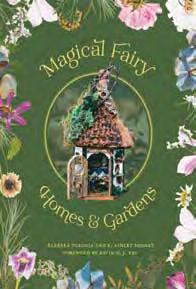
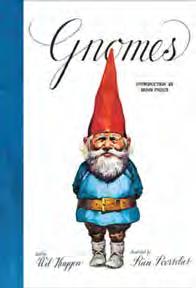
The Crazy Wisdom Community Journal • May through August 2024 • Page 54 ShopCrazyWisdom.com Browse the millions of book titles available and thousands of items from gift, game, and sidelines vendors Books, tarot, games, toys, blank journals, ebooks, audio books & more




The Crazy Wisdom Community Journal • May through August 2024 • Page 55 Must present coupon at the time of purchase. No other discounts apply. Gift cards, case purchases, Co - op cash card, beer or wine cannot be used with purchase. Limit one offer per customer, one coupon per transaction. OFFER EXPIRES 6/30/2024 COUPON IS GOOD FOR IN-STORE VISIT ONLY WITH YOUR NEXT PURCHASE OF $25 OR MORE NATURAL FOODS MARKET & DELI NATURAL FOODS MARKET & DELI So Many Delicious Deals! 216 N. Fourth Ave, Ann Arbor • 734-994-9174 Conscious & Tasty food and nutrition Spiedo with Love Page 58 Tea With Peggy Page 57 Cooking with Lisa Page 56 Cultivating Connection: The Power of Community Gardens Page 60 Eating for the Climate Page 62

Cooking with Lisa
By Lisa Viger-Gotte
All About Asparagus
Asparagus, the slender green superstar of the vegetable world, is a tasty and nutritious delight. Plant asparagus crowns in sunny, well-drained soil during early spring or late fall, and watch them grow into perennial garden treasures. Patience is key as you’ll need to wait a couple of years before harvesting to allow the roots to establish. Once ready, pick tender 6 to 8-inch spears. Loaded with vitamins and fiber, asparagus is a versatile addition to your culinary adventures, whether grilled, steamed, or in a creamy soup. Enjoy its vibrant flavor and health benefits! Find it easily in the spring and early summer at your local farm market or grocery store.

Creamy Asparagus Soup Recipe
Indulge in the creamy goodness of homemade asparagus soup. This comforting bowl of pureed asparagus, onions, and garlic is the perfect way to savor the flavors of spring. Top with plant-based parmesan and chives for an extra touch of deliciousness. Enjoy your homemade creamy asparagus soup. It’s a delightful way to savor the fresh flavors of spring!
Ingredients:
• 1 lb fresh asparagus spears, trimmed and chopped
• 1 small onion, chopped
• 2 cloves garlic, minced
• 2 tablespoons olive oil
• 4 cups vegetable broth
• 1 cup almond milk
• Salt and pepper to taste
• Optional garnish: grated plant-based Parmesan cheese, chopped chives, or a drizzle of olive oil
Instructions:
In a large pot, heat the olive oil over medium heat. Add the chopped onion and minced garlic. Sauté until the onions become translucent, about 3-5 minutes.
Add the chopped asparagus spears to the pot and cook for another 5 minutes, stirring occasionally.
Pour in the vegetable broth and bring the mixture to a boil. Reduce the heat to low, cover the pot, and let it simmer for about 15-20 minutes or until the asparagus is tender.
Using an immersion blender or a regular blender (in batches), puree the soup until smooth and creamy.
Return the blended soup to the pot and stir in the almond milk. Heat the soup over low heat, but do not let it boil. Season with salt and pepper to taste.
Serve hot, garnished with grated plant-based Parmesan cheese, chopped chives, or a drizzle of olive oil if desired.
What are New Potatoes?
New potatoes are young, freshly harvested potatoes that are typically small in size and have thin, delicate skins. They are known for their tenderness, sweet flavor, and creamy texture. New potatoes are harvested before they have a chance to fully mature, usually in the spring or early summer, which is why they are called “new.”
These roasted new potatoes make a delightful side dish or a satisfying snack.
Easy Peasy Plant-Based Parmesan
1 cup unsalted cashews
½ cup nutritional yeast
1 tablespoon salt
1 teaspoon onion powder
½ teaspoon garlic powder
Carefully pulse all ingredients in a food processor or bullet blender until they become a coarse powder. Use this delicious blend in soups, on pizzas, popcorn, cooked vegetables, potatoes, or anywhere else you want a touch of cheesy flavor.
The Crazy Wisdom Community Journal • May through August 2024 • Page 56

Enjoy their crispy exterior and tender interior with your favorite dipping sauce or alongside other dishes.
Rosemary Garlic Roasted New Potatoes
Enjoy the savory, spring goodness of rosemary garlic roasted new potatoes. A crispy, flavorful vegan side dish that pairs perfectly with any meal. Simple and delicious!
Ingredients:
• 1 pound ne w potatoes, washed and halved
• 2 tablespoons olive oil
• 1 tablespoon easy peasy plant-based parmesan (optional, see bonus recipe to make your own!)
• 2 cloves garlic, finely minced
• 1 teaspoon dried rosemar y (or 2 teaspoons fresh rosemary, chopped)
• Salt and black pepper to taste
• Fresh parsley, chopped, for garnish (optional)
Instructions:
Preheat your oven to 425°F (220°C).
In a large mixing bowl, combine the halved new potatoes, olive oil, parmesan, minced garlic, and dried rosemary. Toss to coat the potatoes evenly with the oil and seasonings.
Season the potatoes with salt and black pepper to taste and toss again.
Spread the seasoned potatoes in a single layer on a baking sheet lined with parchment paper or a silicone baking mat.
Roast the potatoes in the preheated oven for about 25-30 minutes, or until they are golden brown and crispy on the outside. You can stir them once or twice during roasting for more even cooking.
Remove the roasted new potatoes from the oven and, if desired, garnish with
Tea with Peggy

Summer Hibiscus Tea
By P.A. Alaniz
There is nothing better than reading an enjoyable book while sitting outside soaking up the sun. I delight in sitting on the back patio overlooking the lake, listening to the boats go by, and hearing kids laugh as they tube across the water. It is also a fun time to drink a glass of iced tea which can help keep you hydrated in the warm weather. A refreshing glass of iced tart hibiscus and lemon usually hits the spot. The remarkable thing about drinking hibiscus is that it helps contract some of the damage caused by the sun. The health benefits of hibiscus tea are amazing for your skin should you be drinking it or using it in a homemade facial mask. It’s no secret that too much time in the sun can damage your skin. Yet, the hibiscus plant helps reduce the breakdown of collagen as well as maintain the natural elastin of the skin. Some even refer to it as “nature’s Botox.” Besides aiding your skin to glow and stay firm, hibiscus tea also has other health benefits. Things attributed to the consumption of hibiscus tea include lower blood pressure, lower LDL cholesterol levels, soothed sore throats, and it reduces certain types of bacteria as well as certain types of cancer cells. The hibiscus flower contains Magnesium, Calcium, and Vitamins A and C. It is also caffeine free. Hibiscus can be considered a super tea; however, if you are allergic to mallow, don’t drink it. You should also avoid hibiscus tea if you’re pregnant because it can cause premature labor.
While Hibiscus is a tropical plant, it does grow in the northern climate of Michigan. It blooms in late summer. Hibiscus tea can be made from the petals of the big tropical flowers, either fresh or dried. It can also include the calyx of the flowers which are the green petals at the base of the flower. Its taste is unique and tart. Hibiscus is good at enhancing fruit flavors--especially citrus and berries. After a long scorching summer of sitting in the sun, you can make your own homemade tea from the fresh blossoms (provided your garden is organic and no pesticides have been used).
Since hibiscus tea contains antioxidants for your skin, and your body can absorb them either by drinking it or through a homemade skin cream, I decided to include a recipe for both. After all, even with protection, the rays of the sun can still do damage. Plus, hibiscus is just like summer in a glass.
Hibiscus Skin Cream
• 2 teaspoons of hibiscus powder
• 2 teaspoons of rice flour
• 1 tablespoon of plain Greek yogurt
• 1 tablespoon of honey
Combine in a small bowl and place on skin for up to 15 minutes. Then wash it off completely, and moisturize as normal.
While you wait for your mask to work, you can sip on a refreshing drink.
Hibiscus Limoncello
• 2 tablespoons of hibiscus tea per one cup of hot water
Let the hibiscus steep for five to seven minutes, then strain.
Pour the hibiscus tea once it has cooled and is no longer steaming into an ice tray. Freeze for two hours or until it is solid.
Pour one to two shots of Limoncello into a glass. Then, add three ice cubes of the frozen Hibiscus tea. Sip and enjoy. For a fizzier version add a cup of club soda.
P.A. Alaniz is a tea enthusiast and an Adjunct Writing instructor at Jackson College. She received an MFA from Naropa University in Boulder, Colorado. She has been published by Chicken Soup for the Soul and writes regularly for on her blog “TeaTravel and Spirits.”
The Crazy Wisdom Community Journal • May through August 2024 • Page 57
Spiedo With Love
 By Hilary Nichols
By Hilary Nichols
Spiedo: noun. A type of sharp-pointed metal spear or spit on which meat is roasted
Brad Greenhill bought a vertical rotisserie on a whim. As the owner of the James Beard nominated “Best New Restaurant” Detroit’s Takoi, Greenhill wanted to experiment with spit roasting meats. He had the notion that once a new location became available, he might branch out. Last October, along with his team, executive chef Michael Goldberg and General Manager Matthew Ferreira, Greenhil did just that. They opened Spiedo in a well-loved location in Ann Arbor. The 1300 square foot space was once Jerusalem Garden and then Chela’s. If you’ve driven past Liberty on 5th Street, you surely have noticed the brightly painted exterior. Spiedo catches your eye. Greenhill was already a fan of the space, too.
During his student days at the University of Michigan he was a regular diner at Jerusalem Garden. In 2015 he had a pop-up in the spot, introducing Ann Arbor to his creative culinary expression with his Thai inspired menu. “The spot was on my radar,” recalled Greenhill. With a busy walking district and a vibrant population, they knew Ann Arbor was the right place to introduce their unique concept. “We had wanted to create an elevated, fast, casual dining experience and felt like Ann Arbor was a great town for that with U of M and its plenty of foot-traffic,” he said. Plus, the kitchen came equipped with a griddle that paired ideally with their rotisserie for quality, locally sourced meats carved hot from the spit served on freshly griddled flatbread.

During his student days at the University of Michigan he was a regular diner at Jerusalem Garden. In 2015 he had a pop-up in the spot, introducing Ann Arbor to his creative culinary expression with his Thai inspired menu.
The unifying element is that simple. “The bread,” Greenhill responded quickly when asked. Simple to grab-and-go, or to eat in, but what Spiedo has crafted from this pairing is anything but simple. The marinated meats, roll broiled are not necessarily served in a middle eastern tradition. No tradition is more their style. Their menu reflects this, with international influences that seem impossibly disparate but are married like magic in the hands of these talented chefs. Greenhill brings his Italian, BBQ, and Thai notes, next to
Goldberg’s refined flavor pallet. “Michael worked with me at Magnet, a restaurant we had in Detroit. His passion was hummus and falafel, and he loves his Hawaij, a Yemen style spice blend.” Now he reaches for fish sauce, makes kimchi, and crafts the menu along with Greenhill “guided by just having fun and doing foods we like.” Greenhill continued, “I am always going to push the dynamic flavors like umami, sour, and sweet. That crosses over well into creating dynamic food.”
Dynamic is the word I was looking for to describe this fare. I first came to Spiedo on a lark, compelled by the bright exterior paint job, but I returned nearly every week for the flavors. The menu consists of four to six sandwiches, vegetable sides, and a few dips, which change and evolve seasonally. In my opinion each of these menu items is required eating before the season is over.
Everything on the menu is seasonal. The beets, carrots, and potatoes are all handpicked locally from their own family farm in Detroit. Greenhill’s partner Noel grows the produce at HiO farms. From their website I read, “HiO Farm began in 2019 on an acre of cultivated land in Core City, Detroit and functions as an ongoing conversation between farmer and chef. Each season is planned with Takoi and Spiedo in mind, creating a closed loop, sustainable food system from seed to plate. This symbiotic relationship allows for product at its peak; it’s not unusual for a harvest to be done the day the kitchen needs it.” This isn’t even something that Greenhill brags about, but it is this attention to quality that becomes evident on the plate. “Additionally, we rely on Ann Arbor’s Ceely farms for beets and Tantre farms for carrots,” Greenhill said. Our local land dictates the menu.

The Crazy Wisdom Community Journal • May through August 2024 • Page 58
On my first visit I ordered the ‘charred carrots’ side and a ‘Zoug Knight’ sandwich to split with my guest. The carrots are a thing of beauty, served over a generous smear of tahini ranch with an array of bright green herbs and crushed pistachio nuts sprinkled on top. The combination of flavors danced on my tongue, in a surprise of tang and heat, smoke and nuttiness that made me shake my head in awe. The chicken sandwich is not short on flavor from house made Zoug sauce, and the tart of their own sour pickle spears. Their half sours are so bright, I wanted to bring home a jar. How can a pickle be so compelling? Each element is carefully crafted and combined to wake up every taste bud and comfort your palate at the same time.
No tradition is more their style. Their menu reflects this, with international influences that seem impossibly disparate but are married like magic in the hands of these talented chefs.

Though the dining experience is casual, you order your meals at the register and take a seat, the food is what makes the experience. “You are paying a bit more here, but you’re paying for elevated food. You’re getting a fine dining level of quality but in a casual setting,” affirmed Chef Brad Greenhill. This chef-run restaurant serves fare that is scratch cooking with the highest quality ingredients which is reflected in the price. Nominally. I hadn’t noticed. The price point allows them to provide equitable pay to hold on to their loyal staff.
“Our first two hires still run the room,” Matt Ferreira said with pride. As the General Manager, Ferreira is in charge of the guest portion of the experience. “Part of my day is to support the staff to reflect the creativity coming from the kitchen.” The staff, all Ann Arbor locals, seem to understand the assignment. “They know how the city works and how the restaurant and nightlife is valued here—which is nice.”
Open from 11:00 a.m. to 9:00 p.m. Tuesday through Saturday, the new addition to Ann Arbor dining life isn’t shy to stand out. Spiedo’s exterior is painted light pink, seafoam green, and dark pink. The color block theme expands inside with more international inspiration. Influences from Mexico, Morocco, and the U.S. Southwest mingle invitingly. The walls alternate bright blue, seafoam green, pink, and orange, with bold patterned throw pillows along the bench seating. “It is a tough building to work with,” with a small downstairs and a long thin upstairs for dining spaces. “We wanted to create continuity through lights and color,” described Greenhill. Ferreira laughed. “We called it Spiedo Miami Vice.” Bright and pastel colors add a sunny cheer that Greenhill remembered from a trip to Oaxaca. The patio will be open in the spring.
I ask them what their favorite menu item is, and Greenhill and Ferreira agree with a laugh, “the frozen treat.” This chocolate tahini combination is a perfect little shake. It was hard for them to decide, but they also each recommended a favorite main dish. I go with their newest addition, the Juicy Sean, named for their fish guy. The fresh flatbread is lined with Moroccan marinated and grilled Walleye chunks. It’s paired with pickled onions, avocado, and shredded napa cabbage for a crunch. Described on a quick web search as the ‘Thai sauce to improve everything,’ a generous drizzle of phrik nam pla sauce brings it all together. There are plenty of questions on the menu that the gracious wait staff are happy to answer, but rest assured, you can’t go wrong. Any sandwich is also available as a gluten free rice bowl. Spiedo has a great selection of creative craft cocktails, beer, and cider that pair well with their fare. The combinations are endless and exciting. It is clear here, that they offer their attention to more than flavor: there is love crafted into these recipes, and it comes through in every bite.

Visit Spiedo at 307 South Fifth Street in Ann Arbor. For questions, email yes@spiedoa2.com or visit their website at spiedoa2.com. Online orders are accepted from their webpage through “Toast.”

The Crazy Wisdom Community Journal • May through August 2024• Page 59

Cultivating Connection: The Power of Community Gardens
By Lisa Viger-Gotte
A community garden is like a little shared oasis, a special spot where folks from all walks of life come together to grow delicious veggies, fragrant herbs, and beautiful flowers. It becomes a green sanctuary, where members roll up their sleeves, dig in the dirt, and let nature work its magic. Often organic, community gardens help promote soil health and community connection as much as they do delicious, locally grown food.
Community gardens play a vital role in environmental sustainability by promoting green spaces, biodiversity, and sustainable gardening practices such as composting and water conservation. By utilizing underutilized land and vacant lots, these gardens transform urban landscapes into vibrant, productive spaces, enhancing the overall quality of life in the community.

Community gardens play a vital role in environmental sustainability by promoting green spaces, biodiversity, and sustainable gardening practices such as composting and water conservation.
Belonging to a community garden offers a multitude of benefits that span social, economic, environmental, and personal realms. Community gardens serve as hubs for social interaction and connection, offering opportunities for neighbors to bond, share knowledge, and support one another. Through shared tasks and collaborative efforts, community gardens cultivate a sense of belonging and collective ownership, strengthening the fabric of the neighborhood. Sandie Schulze, who belongs to Chelsea Community Garden, as do I, said she’s made friendships at the garden and that “It’s easy to get to know the persons who have plots around yours.” She’s looking forward to more opportunities to share produce with the surrounding community.
Participating in gardening activities has been linked to improved mental health, stress reduction, and increased physical activity, contributing to overall wellbeing. These shared spaces go beyond gardening; they also foster community resilience, environmental stewardship, and personal empowerment, enriching individual lives and their communities. Steven Wright, also from the Chelsea Community Garden, said, “I have developed good friendships over the years within the group. At my residence, there isn’t enough sunlight, and this provides a wonderful space to grow vegetables. It gives me a reason to walk somewhere nearly every day and get other forms of exercise.”
By transforming vacant lots and underutilized spaces into productive green areas, Project Grow contributes to local food security, environmental stewardship, and community resilience.

Belonging to a community garden entails certain responsibilities to ensure the success and sustainability of the shared space. Members are typically expected to maintain their individual plots by regularly planting, watering,
weeding, and harvesting crops. It’s crucial to adhere to the agreed-upon guidelines and rules set by the community garden, respecting the rights and space of fellow members. Active participation in communal tasks such as maintenance, composting, and organizing events or workshops may also be expected. Additionally, members should contribute to the financial sustainability of the garden through membership fees or volunteer hours. Effective communication and cooperation among members are essential for resolving conflicts, making decisions collectively, and fostering a harmonious and inclusive garden environment. Overall, being part of a community garden requires a commitment to collaboration, shared stewardship, and respect for the community and the natural environment.
Connect with your neighbors and get your grow on. Find a community garden close to you with the list below.
Ypsilanti
Project Grow Community Gardens is a nonprofit organization dedicated to providing accessible gardening spaces and promoting urban agriculture. Established in 1972, Project Grow manages over 20 community garden sites across Ann Arbor, offering plots to individuals, families, and groups interested in gardening. These gardens range in size and location catering to diverse gardening preferences and needs.
Project Grow emphasizes organic gardening practices, environmental sustainability, and community engagement. They provide educational resources, workshops, and support to help gardeners succeed in their endeavors. Additionally, the nonprofit facilitates community-building activities such as garden workdays, potlucks, and skill-sharing events, fostering connections among gardeners and neighbors.
By transforming vacant lots and underutilized spaces into productive green areas, Project Grow contributes to local food security, environmental stewardship, and community resilience. The organization’s commitment to inclusivity, education, and sustainable gardening practices makes it a valuable asset to the Ann Arbor community. For more information, visit projectgrowgardens.org.
Frog Island Park Community Garden is a cherished and charming green oasis within the city. Located in the historic Frog Island Park in Ypsilanti, this community garden offers residents the opportunity to grow their own fruits, vegetables, and flowers in individual plots. With its picturesque setting along the Huron River, the Frog Island Park Community Garden provides a tranquil space for gardening enthusiasts to connect with nature and each other.
Normal Park Community Garden is a beloved local resource nestled within Normal Park. This garden provides members with individual plots to grow a variety of produce and flowers in Ypsilanti. Through collaborative efforts, educational workshops, and social gatherings, the Normal Park Community Garden fosters a sense of belonging and environmental stewardship among its members. For more information, visit normalpark.org/activities
Parkridge Community Garden is situated in the Parkridge Park area in Ypsilanti. This hidden gem of a garden offers individual plots for members to grow fresh produce while promoting sustainability and social interaction within the neighborhood. Find them on Facebook.
The Crazy Wisdom Community Journal • May through August 2024 • Page 60
Ann Arbor
Pittsfield Township Community Garden in Ann Arbor provides members with individual plots—some with accessible surfaces, ensuring inclusion and convenience for all members, including those with mobility challenges. Through shared resources, educational opportunities, and collaborative efforts, the Pittsfield Township Community Garden strengthens community bonds and promotes sustainable living practices. For more information, visit pittsfield-mi.gov/1635/Community-Garden.
Chelsea & Dexter
Chelsea Community Garden is a vibrant hub for gardening enthusiasts and community members alike. Located in the heart of Chelsea, this garden provides residents with the opportunity to cultivate their own plots, share gardening knowledge, and engage in community-building activities. There are shared beds of blueberries and asparagus tended to and enjoyed by all. With its focus on sustainable practices and social interaction, the Chelsea Community Garden serves as a welcoming space where individuals come together to grow food, friendships, and a sense of belonging. For more information, visit chelseacommunitygarden.org.
The City of Dexter Community Garden is a thriving community space where residents come together to garden, learn, and connect. Established to promote urban agriculture and community engagement, this garden provides individual plots for members to cultivate their own produce. Through shared workdays, educational workshops, and social events, the garden fosters a sense of belonging and collaboration among its members, enriching the local community with fresh food and a vibrant green space. For more information, visitdextermi.gov/community/community_garden.php.
Participating in gardening activities has been linked to improved mental health, stress reduction, and increased physical activity, contributing to overall well-being.



Divine Inspiration At Work with Susan McGraw
Let Divine Inspiration be the guide for Your Next Chapter and make smooth transitions in your personal life, career, or business.


Business Strategist
Psychic Readings
Career & Business Strategy Sessions
Live Virtual Workshops via Zoom


Get more information and book a phone session: DivineInspirationAtWork.com
"I can say beyond a doubt that my reading with Susan has helped propel me in my soul’s direction and vocation! She is incredibly accurate and left me feeling more inspired and excited than I could possibly express!” Hallie S., Salt Lake City, Utah


The Crazy Wisdom Community Journal • May through August 2024• Page 61
Susan McGraw Psychic Medium Career &
Eating for the Climate
 By Crysta Coburn
By Crysta Coburn
The organic farming movement began in the 1940s. People looked around at the rapid evolution of farming equipment and techniques and became concerned by increased soil erosion, a decrease in the quality of food, and a diminishing variety of the crops being grown. All of these and more are issues that followed us into the 21st century and continue to be hot topics today. So many people now follow an organic food diet that it is common to see these products side by side with their “conventional” counterparts on grocery shelves. Most consumers would agree that organically grown food is a boon for the environment.
But how truly environmentally friendly is any product that is shipped across a continent by vehicles powered by fossil fuels? Both the process of obtaining fossil fuels and their emissions are major contributors to water and air pollution. To add to this, many of the organic and all natural (whatever that means) brands are not independent, but owned by major corporations such as Pepsi, CocaCola, Post, Kellogg, and Kraft Heinz, none of which are bastions of ecological sustainability.

What does a person who wants to do right by the environment do in a world determined to commercialize every good intention?
What does a person who wants to do right by the environment do in a world determined to commercialize every good intention? Which foods are the best to buy for our own health as well as the planet’s? It might feel impossible, but there are some guiding principles that may offer genuine assistance in meeting these multiple standards.
Climate conscious eating means making decisions about the food you buy and consume based on its sustainability and carbon footprint. This includes foods that are processed as little as possible and few animal products. Even in industrial agriculture, plants generally require fewer resources to raise than animals. They are also not grown in overcrowded pens and sheds, and unlike animals, plants don’t mind staying in one place all their lives (though they might need to spread their leaves a little). Nor do they pollute groundwater with their feces and urine, which is as serious a concern to human health as the runoff from chemical fertilizers.
This is not to say that animals cannot be raised humanely using sustainable practices, and it is true that some plants are thirstier than others or are being grown in inappropriate landscapes. (Looking at you, almonds!) Choosing sustainably raised meat, dairy, and eggs over factory farm-raised would be an example of climate conscious eating. The closer to home your food was raised the better as well. Being driven 20 miles uses up a lot less gasoline than 2,000. This is the relative distance from Michigan to the West Coast where a lot of produce is grown. Fruits and vegetables also lose nutrition while they sit and wait to be eaten; therefore, the closer you are to the source, the less time it is sitting aroundand the more nutrients you will consume.
Packaging is another thing to keep an eye out for when making climate conscious decisions. Unpackaged fruits and vegetables, for instance, are preferable to those wrapped in plastic. Making use of reusable bags, especially ones made from biodegradable materials like cloth, is another step. For those
concerned about produce rattling around on its own rather than wrapped in its own produce bag, reusable produce bags are also available for purchase.
It might be tempting to buy all of these supplies online, but remember, online purchases are likely to have hefty carbon footprints. The number of items made in China and shipped across the Pacific to the United States is unimaginably huge, and the impact on the environment when buying from foreign countries, is not slight.
This is not to say that animals cannot be raised humanely using sustainable practices, and it is true that some plants are thirstier than others or are being grown in inappropriate landscapes. (Looking at you, almonds!)

A better option would be to get to know your local farmers markets, whether weekly or one with a permanent location such as Argus Farm Stop in Ann Arbor and Agricole Farm Stop in Chelsea. Signing up with a local farm offering a CSA (Community Supported Agriculture) program is another terrific option. If these are not options near you, pay attention to where the food in grocery stores like Meijer and Kroger come from. Question whether or not a particular food is actually in season. Strawberries in winter probably traveled to Michigan from California. Most avocados come to the U.S. from Mexico. Consider this when planning your menu.
But you needn’t go entirely without the foods you love. Take coffee, which is a tropical plant. Michigan is located far from the tropics. However, there are several Michigan-based roasteries that partner with sustainable growers who fairly compensate their workers.
There is no getting around the fact that we live in a global society and daily enjoy things that came to us from far away. But if we try, we can support a more sustainable chain of production.
Some key points of climate conscious eating are:
• Follow a majority plant-based diet.
• Consume minimally processed foods and beverages.
• Choose products with as little pac kaging as possible.
• Source as locally as you are able.
• Eat foods that are in season.
• Suppor t sustainable farming practices.
And not everything has to be organic. An apple grown with more conventional techniques in your own county isn’t necessarily worse for the environment than one that was grown organically and rode on a truck for 2,000 miles. There is no perfect answer, but there are choices we can make every day to lessen our individual impact as well as support those who are trying to change an unsustainable system. If we don’t, the planet is going to continue to warm, and the challenges that our food system already faces, such as drought, flooding, and soil erosion, will continue to worsen.
The Crazy Wisdom Community Journal • May through August 2024 • Page 62
Visit These Local Farmers Markets This Summer!
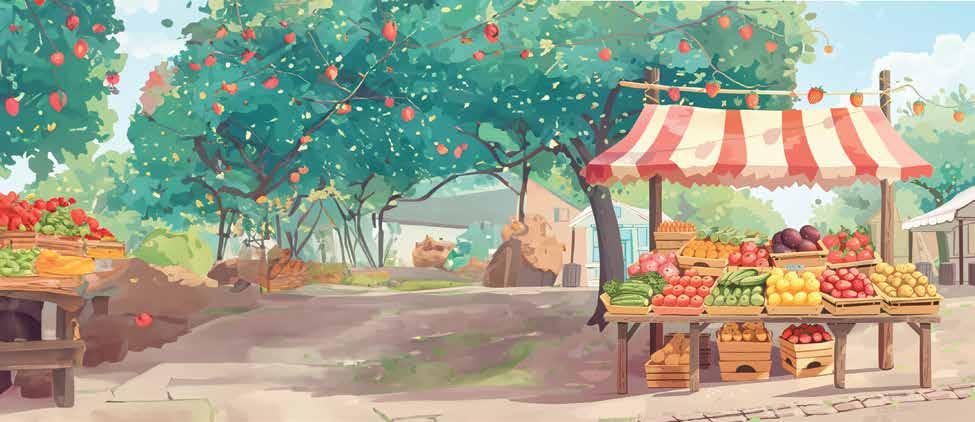
Local Farmers Markets:
• Ann Arbor F armers Market (Kerrytown)
• Belleville Farmers Market
• Canton F armers Market
• Chelsea F armers Market
• De xter Farmers Market and Winter Farmers Market
Or Join a CSA near Ann Arbor:
• Baseline F arm (Meat)
• Blue Spring F arm
• Countr y Valley Farm
• Goetz Greenhouse and Farm
• Good Neighbor F arm






GROVE EMOTIONAL HEALTH COLLABORATIVE

GROVE IS ACCEPTING NEW CLIENTS (CHILDREN, ADULTS, COUPLES + FAMILIES)
IMMEDIATE OPENINGS FOR IN-PERSON + VIRTUAL THERAPY, MEDICATION MANAGEMENT, MINDFULNESS, MEDITATION AND YOGA

To book, contact referrals@groveemotionalhealth.com, call (734) 224-3822 or visit www.groveemotionalhealth.com




We are committed to providing you with a supportive environment, expert instruction, and a wide range of classes and workshops.

The Crazy Wisdom Community Journal • May through August 2024 • Page 63
Eastover Professional Center • 1527 Eastover Place, Suite 5, Ann Arbor, MI 48104 email: yogafocusannarbor@gmail.com • Website: yogafocuscollective.com Facebook | Instagram Classes | Workshops | Prenatal
Handcrafting
Porcupine Sunglass Case
By Jennifer Carson


Materials needed:
• Scrap of cotton for case, 8” x 8”
• Scrap of cotton for lining, 8” x 8”
• Iron fusible fleece 8” x 8”
• Small piece of Heat and Bond
• 3” of round elastic
• Scrap of felt—for nose
• Small button
• Scraps of two shades of brown (or whatever color you choose) for your porcupine
• Blac k sewing thread, and thread to match case fabric
• White embroidery floss
• Basic se wing supplies and an iron
I don’t know about you, but I am constantly misplacing my sunglasses in my bag. I eventually find them, and inevitably the lenses are scratched. I’m determined not to let this happen this summer, so I made a cute little glasses case to help protect them. I made this case on my machine, but you could hand sew it as well.
Instructions:
All seam allowances are ¼”.
1. Trace the pieces of the porcupine pattern onto the paper side of your Heat and Bond. You’ll want to trace two ears and two front paws and one face, body, and belly.
Cut out two cases from your case fabric and two from your lining fabric. Each piece should be 8” long by 3.75” wide.
Cut out one flap piece from your case fabric and one from your lining fabric.

Cut your round elastic at 3” long. Tie an overhand knot in the end. Baste your elastic to the top of flap lining on the right side of your fabric.

Match one end of your case lining to the straight edge of your lining flap. Stitch.

Match the other case lining piece to the case lining piece you just sewed. Sew from a ¼” at the top to the bottom corner, leave a space in the middle of the short end that is unsewn (to turn your case later). Sew the other side in the same manner. Turn right side out, press with your iron, and set aside.
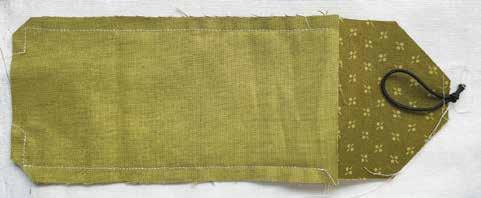
The Crazy Wisdom Community Journal • May through August 2024 • Page 64
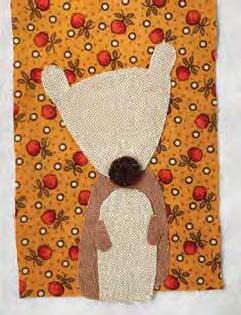
Use your black thread to give him some eyes (using a French knot) and eyebrows. I also gave his nose some extra interest by sewing a few lines across it with the black thread. With three strands of white embroidery floss, give him some markings on his chest and the middle of his face just using a straight stitch in differing lengths.
On the back case piece, match and sew the flap piece. Stitch the case together as you sewed the lining together.
With right sides together, push the lining into the case. Match the flap pieces and around the top edge of the case. Pin and sew the top edge and around the flap.
Take one of your case pieces and arrange your porcupine pieces—be sure to peel the backing paper off before placing on the fabric. With a warm iron, fuse your pieces to the case. Cut two fleece pieces the same size as your case and fuse the fleece to the wrong side of both case pieces.
Now the fun part! Sew straight stitches out from the porcupine’s body to the outer edge of your case. Don’t be too precious about this— just give him lots of spikes! When you’re happy with all his needles, stitch around his head and body a couple times—give the outlining some personality by again not being too picky about where your lines are


Turn case right side out through the opening in the lining. Push the corners out well. Press.

Whipstitch or ladder stitch your turning opening closed. Insert lining back into your case and press your case really well.
Sew your button onto the front of your case and enjoy!!


Jennifer Carson is a local author and artist who enjoys creating whimsical art for home and family. You can see her over 70 sewing and crafting patterns, her books for kids, and watercolor illustrations on her websites, the dragoncharmer.com or furandfeatherfriends.com. Follow her on Instagram @magickalJennCarson_ art.
Flap
cut 1 from Case fabric
cut one from Lining fabric
Body cut 1 Belly cut 1

Full size pattern pieces. Just trace and get started creating!
Face cut 1
The Crazy Wisdom Community Journal • May through August 2024 • Page 65
Ears cut 2
2
Paws cut


Intervulnerability: Practicing Love at the University of Michigan Art Museum
By Kirsten Mowrey
“Transform yourself to transform the world.”—Grace Lee Boggs, Detroit activist
Humidity weighted the autumn air as I walked across the University of Michigan Ann Arbor campus. Vermilion ivy coated the walls of the buildings while orange trees stood like flames amid the evergreen shrubs lining the sidewalk. In the distance, I heard chants of a protest on State Street as I sauntered through the prismatic glass entrance of the art museum.
Immediately to my left was an information desk whose minder greeted each guest to the museum and directed them accordingly. A comfortable array of lounges and chairs invited me and my friends to pause and chat. We proceeded to our left; tall windows on our right illuminated the hallway. We stopped in a three-story atrium: balconies on three sides with a long black wall filled with text and a photo on our right. The balcony walls were painted with the same words in two languages. The words hit my body like a wave.
Gidayaa Anishinaabewakiin. You are on Anishinaabe land.

I breathe in.
Native American images are woven throughout the United States’ story of itself. Growing up, I played “Cowboys and Indians” with friends, watched the 1970’s infomercial of a Native man crying as he gazed upon a polluted landscape, and celebrated Thanksgiving and its accompanying story of gift giving each year. But slowly, over time, the unexamined edifice of American “Manifest Destiny” began to erode in my mind as I read our history and traveled, observing the difference between the story told and historical fact.
In 2019, I visited the National Museum of the American Indian in Washington DC. In a spacious upstairs exhibit hall, I viewed the “Americans” exhibit filled with images and items with images of Native people: cans, motel signs, posters, movies, food, seals, coins, clothing, statues, and multiple other items— many were familiar backdrops in my everyday life. I craned my neck to look high toward the ceiling while the exhibit pointed out the pervasiveness of Native images and yet unintentionally, the ignorance of Native people and their lifeways. (There is an online version of this on the Smithsonian website: https://americanindian.si.edu/americans). My takeaway was that, though I am surrounded with images and ideas of Native peoples, I have little experience of them as people; it’s mostly a hazy indistinct amalgam. I know more of other lands and cultures than these people geographically closer. Rarely have I seen them portrayed as embodied present-day human peoples with complex histories.
To become conscious of Indigenous people as peoples and disperse the cultural fog requires bringing consciousness to these hazy, fuzzy memories and ideas. In Becoming Kin, Patty Krawec writes,
“We hold knowledge in ways that we can articulate and explain to others and also in ways that are less tangible….we just know….we don’t have a language for what we’re trying to explain or it doesn’t even occur to us that it needs explaining….The trick is to get those assumptions from where they rest inside you or inside our broader society out to a place where you can articulate them. To move those unspoken things from implicit to explicit so they can be challenged or reconsidered” (17-18).

But slowly, over time, the unexamined edifice of American “Manifest Destiny” began to erode in my mind as I read our history and traveled, observing the difference between the story told and historical fact.
To make the unconscious conscious—that that is the work of anyone who chooses a spiritual path. It is why we practice meditation, yoga, prayer, contemplation, or any of the myriad of spiritual practices developed throughout human history. We bring our attention to ourselves, our habits, blind spots, assumptions, actions and reactions, patterns, and shadows to learn more about how we are moving in the world so that we can move in the way we want to—to align mind, body, and spirit. To look at my assumptions about Native peoples, who they are—including the variety of cultures that get lumped under the term Native—is to begin to bring awareness and light to the murky learnings and remembrances of my youth, to mature in my view of the world, and then to reexamine them in the fresh light of day.
Future Caches, the University of Michigan Museum of Art installation by Andrea Carlson, is the lens through which I will let other’s stories move me from selfabsorption. It takes up the entire atrium of the new wing of the museum. On the left wall are two visual pieces surrounded by a thick zig-zagging black and white border, distorting my vision, and reminding me of when the television screen is blurred; I have to focus intently. A graveyard in the foreground of the leftmost image leads to bucolic lake and sky in the background with the words “Give me knowledge/ so I may/ have kindness/ for all.” On the right image is a beach strewn with discarded towels and swimwear that extends back into another forested lakeside under a cloud studded sky. Another wall has framed paper creations and poems over some items from the University’s Archeological collection. Each display has a QR code that allows you to hear the exhibit in Anishinaabemowin, a collaboration with Ojibwe.net, a non-profit preserving the language. The poems are typeset, lovingly framed editions of heart slicing pain.
The Crazy Wisdom Community Journal • May through August 2024 • Page 66
Beauty in image and word, juxtaposed with stories of pain--particularly the dominant display of the long eastern wall, going up all the way to the building’s highest level, painted black with text in English and Anishinaabemowin. On it, Carlson tells an abbreviated story of the Burt Lake Band of Ottawa and Chippewa, their meetings with settlers, their dispossession of their land, and the fire that damaged their community. The facts are that October 15, 1900, local militia illegally seized their land and burned their homes. The Burt Lake Burn-out, as it is known, is one of Michigan’s forced relocations. With the loss of their land, the Burt Lake Band lost their federal recognition, their sovereign status, and access to funding and services. I am small standing next to the narrative wall, my neck stretched as I look into the distance at the first words of their story. Facts only ever tell one part of the story—historical events made to sound simple, cut and dried; living the facts is messier. On the wall nearby, an art piece expresses this: it shows a colorful triangle rising to touch a descending starry triangle. The bottom depicts an Assomption Sash, used in Native regalia, while the starry sky is that of October 15, 1900; the past overhanging the present.
To look at my assumptions about Native peoples, who they are—including the variety of cultures that get lumped under the term Native—is to begin to bring awareness and light to the murky learnings and remembrances of my youth, to mature in my view of the world, and then to reexamine them in the fresh light of day.

Nearby, a map shows Burt Lake Band’s ancestral lands are now part of the University of Michigan Biological Station. The University of Michigan itself was made possible from an Indigenous land grant, part of the 1817 Treaty of Foot of the Rapids/Fort Meigs, with the request that Anishinaabeg children be educated alongside settler’s children. That 1817 “land grant” was actually “land speculation and government pressure [that] pushed indigenous peoples to treat or sell, lest they be smothered by incoming settlers or driven out following violent battle with militiamen and military officers” (Dawn of Detroit, 235).
I think back to the museum exhibit in Washington: the prolific use of Native images allows and encourages me in a false narrative: white people came here and now the land is ours. Sure, there was strife, but that was the past, not the present; it’s all over now, that’s why we have these images, they are memory.
Peaceful Dragon School

Tai Chi, Medita�on, and Energy Work



The Crazy Wisdom Community Journal • May through August 2024• Page 67
Pauline Blvd., Suite B
Arbor, MI
parking - 1 flight of stairs
Enrich Your Health Reduce Stress and Improve Balance LOCATION / CONTACT 1945
Ann
48103 Easy
Phone: 734-741-0695 info@peacefuldragonschool.com
private and off-site classes Visit website for schedule of classes and workshops www.PeacefulDragonSchool.com Master Wasentha Young
May 6 - Aug 8 Ongoing,
Classes in Tai Chi and Qigong
Spring/Summer Ongoing
Since 1990 University of Michigan Museum of Art

Except exhibits like Carlson’s show that those events aren’t past—they are the present and creating the future. Denial of the Burt Lake Burn-out and lack of federal recognition in the present means perpetuating the beliefs of 1900; it means living in a worldview of white supremacy and entitlement that sets one group’s needs above others, it means a daily habit of not looking at our history, my history. The founding of this nation, the creation of these United States, was done through a series of wars, an attempted systemic genocide of the people living here when Europeans arrived. Susan Raffo calls this our “original wound” in her book Liberated to the Bone. Here is my first step in moving from Whyte’s prison of denial: listening to how white settler’s actions on this continent, and specifically here in Michigan, affected the Native people living here which was not only the Anishinaabeg. According to Native Lands website, the area around Ann Arbor and Ypsilanti hosted several groups: the Bodwéwadmi (Potawatomi), the Meškwahki-aša-hina (Fox), the Myaamia, the Wyandot, and the Peoria peoples.

I am small standing next to the narrative wall, my neck stretched as I look into the distance at the first words of their story. Facts only ever tell one part of the story— historical events made to sound simple, cut and dried; living the facts is messier.
How does one speak of so great a loss—the physical place where hundreds of generations of your ancestors birthed, created homes, raised families, celebrated, and died? A loss that is still ongoing, where you drive by each day? Carlson’s visuals attempt this: though two pieces take up an entire wall, they are predominantly a visual “white noise” of black and white, leading to a much smaller aperture with the landscape. It’s the space around, the silences that communicate grief, loss, and heartache.
I stand before the images, allowing them to sink in, letting that pain touch me, feel my heart clench with pain in my chest. What I discover is an answering ache inside myself. My own ancestors left their homelands, where all the cycles of birth, families, and death had happened, where they were indigenous, and
Intervulnerability continued...
their grief and loss of leaving that landscape is embedded in my lineage. That grief is a wound “raw and bleeding, never able to heal” (Raffo), that spirals out to encompass all of us, adding layers of social, emotional, political, and collective complexity, until we cannot see the original wounding. An immense, multigenerational wound, one too big for anyone to hold alone.
I struggle still to touch that wound, to hold the complex awareness that while the Native people were harmed, the white settlers were also seeking refuge. Raffo writes “Europeans brought their wounds from across the ocean and planted them here. Those wounds included a sense of disconnection from land and the idea of ownership…these wounds had evolved in Western Europe for thousands of years….even those who came seeking heaven on earth brought their wounds” (34-35). Resmaa Menakem calls this “blowing trauma,” when those who are wounded and traumatized take actions that wound and traumatize others. The more I listen, the more I hear the harm of our national story, and the more I recognize that at the root, this story—our story, my story is a tangle of trauma and reactivity, pain fled rather than healed, numbness rather than a rich sensory liveliness of being.
How do I, becoming aware of this history, act to no longer deny or perpetuate it? How do I turn toward my grief of my ancestor’s terrible actions that I benefit from and work with it? And, as a descendant of settlers, where do I belong? These questions are my guides, and the answers are multiple, varying, and circumstantial. Some days, it means to listen and learn, as when I visit the installation. Other days, it means tender work of being vulnerable sharing this process of discovery with other white people. Psychologist Francis Weller writes of becoming the welcome we are seeking: welcoming grief, sadness, regret, and any other emotions our culture labels as “difficult.” I breathe in and out, touching my reactivity, my triggers, being with my own fear, pain, and uncertainty, giving it space and time. Once I calm myself and can be present with my feelings, I know this: these Great Lakes, this land beneath my feet, is home to me. It is where I am at peace—not “the absence of challenge,” writes bell hooks, “but in our own capacity to be with hardship without judgement, prejudice, and resistance. We discover that we have the energy and the faith to heal ourselves through an openheartedness.” She names this openheartedness “love.” Love as action, as under my will, not something that I fall into, but how I choose to face the world. Once I turn toward the world with love, I find myself capable of accepting that this land is full of “troubled relationships needing an ethical response,” to quote author Tiya Miles. What does an ethical response to these historical relationships, and my benefit from them, look like?

The Crazy Wisdom Community Journal • May through August 2024 • Page 68
One guide is Rebecca Clarren. In The Cost of Free Land of her Jewish ancestors who fled to the Dakotas from Europe and farmed land there that had been taken from Lakota peoples. Her journey begins with this wisdom from Yurok and California Judge Abby Abinanti: “Study the culture and traditions of your own people to learn how to respond to a harm… Every culture has experience with being wrong, with finding a way forward. We’re all human and we all make mistakes” (8). While she untangles the knot of family history, white supremacy, treaty violations, and land seizure, she also pursues hevruta, a traditional Jewish form of paired study. “Every other week,” she writes, “my rabbi and I would meet to read ancient Jewish texts that proscribe how to atone and reconcile after a harm has been committed, even, and especially, one that a person didn’t cause directly but did benefit from. We would find, in every layer of Jewish writing—that, before you can fix anything, you must tell the truth, not just to God, but out loud to the entire community” (8). Clarren and her rabbi then created a course to do exactly that for her synagogue. People’s responses varied, as they will, yet again, a beginning was made.
Patty Krawec says it even more simply: “return to yourself and pick up your bundle.” To accept responsibility for my own bundle: my family, my self, all the ways I consciously or unconsciously contribute to harm, my grief, regret, and shame.
For those of us not of the Jewish faith, restorative justice offers a path of practice, starting with listening to the harm you have caused another. Visiting Andrea Carlson’s installation and spending time writing, engaging, and dreaming with it is my practice with that step, being present with this particular part of this large, wounding story. As bell hooks says: “Addressing woundedness is not about blaming others; however, it does allow individuals who have been, and are hurt, to insist on accountability and responsibility both from themselves and from those who were the agents of their suffering as well as those who bore witness. Constructive confrontation aids our healing” hooks writes in love -232-233. Practicing accountability and responsibility means learning whose land you live on (you can do that here: https://native-land.ca/ offer community events, I name whose land I live on. This is a tiny step, and yet, it is a gesture with meaning. It is a recognition of the nation’s founding wound, that this land was not magically given to white settlers but taken through war and death. I find this step particularly important within the New Age and white healing communities. Acknowledging land theft speaks to history, not romanticism or nostalgia. Clarren and her family, in unwinding their theft of land, contribute to the Indian Land Tenure Foundation (iltf.org), a non-profit with the goal of recovery and control of Indigenous lands to their original peoples. The Clarrens are not alone: many churches, institutions, and organizations back up their land acknowledgments with a financial contribution to the original stewards of the land or an organization like ILTF.

From the first step of listening, the next step is to let the harmed know that we have heard them, and that we will change our behavior to not repeat that harm. We move beyond denial and resistance and toward our grief: for our losses, our errors, our reactivity, and the harm we caused. Abinanti says, “Now is the time for people to come forward and take responsibility for their one tiny thread of this much larger story, which is how everybody in this country has benefited from the murder and theft of Indians.” Patty Krawec says it even more simply: “return to yourself and pick up your bundle.” To accept responsibility for my own bundle: my family, my self, all the ways I consciously or unconsciously contribute to harm, my grief, regret, and shame. All the times I act from my compassion, from connection, from love and my heart, is to be responsible for my own bundle. To act from love, to welcome all that is present in this historical time: It is all spiritual folk aspire to in our practice, to bring our best selves forward in the present moment.

In relationship, we discover we are not separate—I am not separate from these communities, but involved in a wide, wounded, historically difficult relationship that will take lifetimes beyond my own to untangle.
David Whyte writes in Consolations, “Denial comes to a natural end through the force of attention and intentionality to the horizon of understanding.” We can only stop the cycle when we turn inward and pay attention to ourselves, to what we are doing, disentangling our unconscious patterns. Our work with race, with our national history, is no different. As former Supreme Court justice William J. Brennan said, “We must meet the challenge rather than wish it were not before us.”
This is the final essay in a three-part experiment in being present with the experience of Arab-American, African-Americans, and Native Americans. What I discovered is grief—deep grief, and my ability to come into relationship with all of these groups through my own experiences and feelings of grief. In
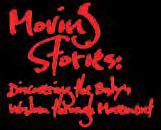
Adult Fitness and Yoga Programs
We embrace all levels of fitness, body shapes, ages, experience and background. We’re all about friendly, accessible yoga and fitness classes so everyone feels comfortable exactly as they are.
Build strength, restore flexibility and de-stress body and mind with in-person, online, or hybrid classes via livestream.
aarecedonline.com
734.994.2300
Stefanie Cohen
Registered Somatic Therapist
Private sessions and group accessing your body's wisdom to create meaning and healing
stefaniemovingstories@gmail.com
www.somastories.net




relationship, we discover we are not separate—I am not separate from these communities, but involved in a wide, wounded, historically difficult relationship that will take lifetimes beyond my own to untangle. But I can begin here, with the grief we hold in common. Psychologist Miriam Greenspan calls this our “intervulnerability:”
“We are vulnerable to one another. What happens halfway around the globe, is suddenly right here, in our living rooms, in our office rooms, in our streets and in the innermost chambers of our hearts. Now is the time to break through the bounds and confines of old forms of thinking, acting, and feeling…our only protection is in our interconnectedness. Grief is not just “my” grief; it is the grief of every witness to horror in the world.”
In any relationship I have, listening is a requirement—to understand and develop intimacy with the person before me, to make my heart spacious to others’ experiences, and to experience more of the world and be present with them. It is only the beginning.
Gidayaa Anishinaabewakiin. You are on Anishinaabe land.

Andrea Carlson’s Future Cache will be at the University of Michigan Museum of Art through June 2024. Kirsten Mowrey is a massage therapist, somatic educator, ritualist, and writer who can be found at kirstenmowrey.com.

The Crazy Wisdom Community Journal • May through August 2024 • Page 69
Caring for an Aging Parent: It’s Complex
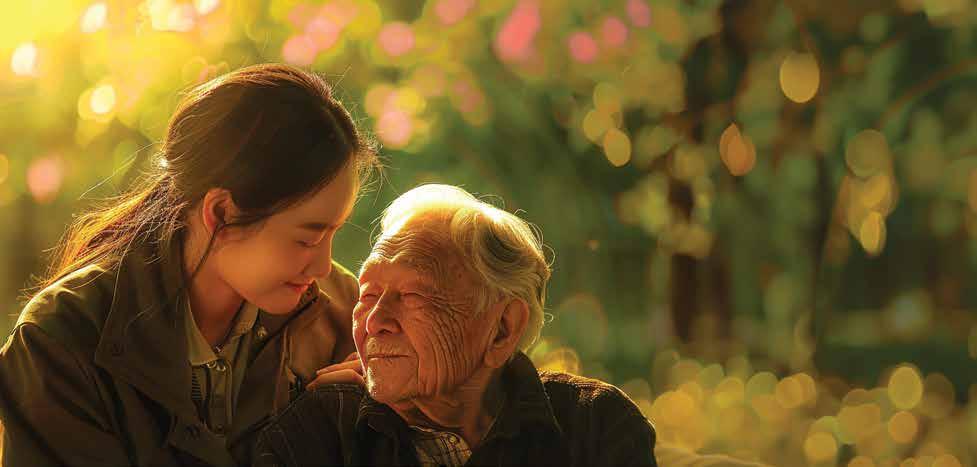 By Ellen M. Craine
By Ellen M. Craine
According to the National Institute on Aging, millions of Americans find themselves in the position of being a family caregiver of an older adult. Not enough education and discussion on this topic is present within families or within society. This is a life transition we will all face, both because of our aging family members needing our assistance, and due to our own aging and needing assistance from family members.
A lot of family caregivers are part of the “sandwich generation,” tasked with caring for their own children or grandchildren, and an ageing parent simultaneously. This life transition can trigger grief reactions for the caregiver and the aging parent.

A lot of family caregivers are part of the “sandwich generation,” tasked with caring for their own children or grandchildren, and an ageing parent simultaneously. This life transition can trigger grief reactions for the caregiver and the aging parent.
A family caregiver can come from within the family of origin, extended family, domestic partners, friends, or other individuals who support an older adult. Family caregiving can include a large variety of tasks with the goal of providing support and services that enhance or maintain an older adult’s quality of life.
These tasks include:
• Emotional, social, and spiritual suppor t
• Assistance with decision making related to health care, financial matters, and lifespan planning
• Assistance with physical tasks such as bathing, dressing, or walking
• Suppor t in navigating and negotiating health and social service systems, such as dealing with health and long-term care insurance
• Arranging and overseeing paid helpers in the home, communicating with health care professionals, or advocating for quality care and services
• Assistance with practical matters such as housekeeping, processing paperwork, or going to medical appointments and other appointments
• Financial suppor t including direct financial assistance and help with billpaying
• Shared housing Caregiving may occur on an intermittent or on-going basis. It may be part or full-time. It may include support from a distance, in the older adult’s home, or another setting. Family caregiving, in this article, is primarily referred to as that done on a voluntary basis and not to professional or contractual services that are provided for a fee to the public.
THE “SANDWICH GENERATION”
Many caregivers of older adults are part of the “sandwich generation.”
According to the article, “The Sandwich Generation Is Financially Taking Care of Their Parents, Kids, and Themselves” found on forbes.com, many Americans are sandwiched between caring for children, grandchildren, and caring for aging parents. They reference a Pew Research Center survey that talks about adults with a parent aged 65 or older who are also raising a minor or providing for an adult child. Middle-aged adults, who are between the age of 40 and 50 make up the majority of this sandwich generation. The research goes on to say that 19% are millennials younger than 40, at least 10% are older than 60. With this responsibility, come many stressors, including emotional and financial.
The article states that, “On average, 48% of adults are providing some form of financial support to their grown children, while 27% are their primary support. Additionally, 25% are financially supporting their parents as well. Some adults living in this sandwiched generation face financial problems regularly having to support three generations at once.
In addition to the financial support, the article states that, “fully half of adults age 60 or older with a living parent say the parent needs help with day-to-day living.” Many adults say that in addition to the assistance with day-to-day living, they are also providing emotional support for their parent(s).
Suzanne is in her 50s and currently a stay-at-home mom who occasionally takes on part-time jobs to help support her family finances. She gave up working fulltime due to her young child’s medical issues. Her husband has been gainfully employed. Suzanne gave up her part-time work when she found herself sharing the care of aging parents with her siblings. She shared what a gift it was to her to be able to care for her parents through their death. She also shared that it was difficult at the same time because she was also caring for her young adult child who has allergies and asthma that were severe at times. Suzanne and her family moved into her parents’ home to care for her 92-year-old mother due to the emotional and financial strain caused by the 45-minute drive between the two homes and the inability of her siblings to provide quality care. In the end, her mother wanted her to be there with her.
Cynthia is a married woman in her 60s. She is a writer and journalist sharing the care of her 94-year-old mother with dementia. Cynthia has work deadlines that often need adjusting because of the challenges of being sandwiched between her mother and her children. Her mother is currently in an assisted living facility in another state, placed there by one of her sisters (without the consent of the other siblings). Cynthia states that she finds this very stressful. She and her husband share three adult children who have expectations of her availability. Recently, she has helped two of her adult children move and has been a support person for one of her children who needed surgery. Cynthia also shared that she is experiencing stress related to alleged financial abuse by one of her siblings toward their mother.
Navigating the new caregiver role brings various losses, including time constraints leading to burnout, physical and emotional strains, and witnessing a parent’s decline.

The Crazy Wisdom Community Journal • May through August 2024 • Page 70
In the realm of caregiving for aging parents, amid the day-to-day challenges, profound losses and grief reactions accompany this life transition. Adult children, transitioning into the role of caregiver, represents a loss of our parents’ caregiving roles. Equipping ourselves with effective caregiving tools is essential. Some of these tools can come from drawing from our learned experiences and observations of how our parents cared for us and their own family elders. Other tools to consider include connecting with nature, connecting with community and asking for support from other family members and friends, journaling, connecting with your definition of Spirit/Divine/God, and reaching out to a therapist who is trained to support you on this journey.
Navigating the new caregiver role brings various losses, including time constraints leading to burnout, physical and emotional strains, and witnessing a parent’s decline. Emotional grief reactions such as denial, anger, bargaining, depression, and acceptance may arise, triggering corresponding behavioral responses. Behavioral responses for the caregiver may include anger outbursts, irritability, increased difficulty getting adequate sleep, forgetfulness, and neglecting one’s self-care and the care of the aging family member to name a few. The order of the emotional reactions varies based on individual experiences and coping skills. This lifelong journey persists even after a parent’s passing, emphasizing the importance of understanding and addressing personal grieving capacities through therapy.
In Cynthia’s case, her sibling’s unilateral decision to move their mother to a nursing home without consultation evoked feelings of loss related to physical roots, legacy, family heirlooms, inheritance, access to her mother, and strained sibling relations. Suzanne is dealing with the trauma of her sibling’s behavior toward their mother and the loss of a relationship with this sibling. All of these losses for Cynthia and Suzanne are mixed in with the loss of their parent.

It’s important to remember that aging parents also grapple with losses, ranging from independence to financial stability, cognitive functioning, and emotional well-being
It’s important to remember that aging parents also grapple with losses, ranging from independence to financial stability, cognitive functioning, and emotional well-being. These losses prompt grief reactions and behavioral changes such as temper tantrums and financial recklessness. Understanding—and not taking these behaviors personally—is crucial, recognizing that the aging parent communicates their frustration and loss in the only way they know how.
As decisions are made for older adults, they experience a sense of loss and grief. Inclusive decision-making processes empower older adults, reduce depression and anxiety episodes, and uphold their right to self-determination, provided they are mentally capable. Conversations among all caregiving stakeholders before they are needed are essential. Encouraging aging parents and ourselves to document wishes including wills, trusts, and medical and financial powers of attorney is crucial. Discussing housing preferences and acquiring access details early on can be empowering for everyone involved, preventing crisis-induced decision-making.
ELDER ABUSE
It is important, as we talk about caring for an aging family member, and the importance of having self-care tools, that we touch on the topic of elder abuse. According to the National Council on Aging (NCOA), “Elder abuse is a silent problem that robs seniors of their dignity, security, and–in some cases–costs them their lives.” It is important to note that “up to five million older Americans are abused every year, and the annual loss by victims of financial abuse is estimated to be at least $36.5 billion.” The website for the NOA states that “in almost 60% of elder abuse and neglect incidents, the perpetrator is a family member,” and that “two-thirds of perpetrators are adult children or spouses.”
Cynthia reports that one of her siblings committed alleged abuse of the mother’s funds and property, along with abandonment of their mother. Suzanne also identified difficulty with one of her siblings over the care of their mother. She alleges that the sibling’s treatment of their mother was abusive, neglectful, and exploitive.
According to the michigan.gov website, “elder and vulnerable adult abuse, neglect, and exploitation are behaviors committed against an elder or vulnerable adult who is unable to protect himself or herself due to a mental or physical impairment or due to advanced age.” The website goes on to define abuse as “harm or threatened harm to an adult’s health or welfare caused by another person.” Neglect is defined as “the inability or failure to provide adequate food, shelter, clothing, and medical care.” And, exploitation is defined as “the misuse of an adult’s funds, property or personal dignity (e.g., humiliation, objectification, degradation, dehumanization) by another person.”
Now Hiring: Ad Sales Associate
Crazy Wisdom Community Journal is looking for an Ad Sales Associate, to start in the spring of 2024. This is a great job for someone who is looking for very part-time work from home (and around town), loves Crazy Wisdom and the Crazy Wisdom Journal, and is happily interwoven into the Ann Arbor area. This could be perfect for someone who naturally makes friends and has relationships and connections from daily living here: shopping, playdates with kids or pets, taking dance or yoga classes, attending events, going out to eat, belonging to various singing, religious, reading, or athletic groups in the area—just being an active part of the community!
The job averages 6 hours per week (with an ebb and flow during our 4-month publishing cycle). Help to maintain our print/digital advertising base and build it up. Experience in sales, especially Ad Sales, would be a great plus, though the right attitude is even more important.
$25 per hour base pay, plus solid commission fees above a certain level of ad revenue. Room to grow the base pay (and the commissions).
This job will start in March and will include being oriented and trained by our Ad Sales Manager, Tana Dean, and by our publisher, Bill Zirinsky. This would be a fun and satisfying job for someone who believes in what we do and would like to join our team.
Please send cover note, and resume to: billz@crazywisdom.net.

If you witness any of the above, or suspect abuse, neglect, or exploitation of an adult family member, here are some resources:
• Adult Protective Services at (855) 444-3911 day or night
• Michigan Department of Health and Human Services at (517) 373-9196
• Michigan Long Term Care Ombudsman if your aging parent is in a residential care facility at (866) 485-9393
• Attor ney General Health Care Fraud Hotline for nursing home abuse at (800) 242-2873
Caregiving is complex. It is important that caregivers take care of themselves since caregiving is likely to be a long-term commitment.

Caregiving is complex. It is important that caregivers take care of themselves since caregiving is likely to be a long-term commitment. What that looks like for you, will be different than what it looks like for another family caregiver. Keep in mind, also, what works today, may not work tomorrow. It is important to have a whole toolbox full of self-care tools to utilize. In addition to the tools mentioned above for self-care, an additional tool to consider is getting respite care so that you can get a break. That respite care can come in the form of having someone come in to care for the aging family member or having the aging family member go to an agency setting for a day program or for an overnight stay for a few days. Depending on your finances, another tool may be to hire a caregiver that comes into the home. A social worker trained to work with families in addressing caregiving issues can be extremely helpful to guide you in navigating these options as can an attorney who specializes in these matters. Do not be afraid to reach out for help.
Ellen Craine JD, LMSW- Clinical and Macro, ACSW, INHC is in private practice as a licensed clinical and macro social worker in the state of Michigan. You can learn more about Craine and how she can support you and your family at crainecounseling.com or by email at ellen@crainecounseling.com.
The Crazy Wisdom Community Journal • May through August 2024 • Page 71 LOSSES and GRIEF REACTIONS
More Life, Less Stuff
 By Thea Lona Hassan
By Thea Lona Hassan
There were seventeen sets of nail clippers. Books were on the shelves, books in boxes under the bed, and even more books in the attic. I found at least two dozen pairs of eyeglasses each with a sunglass inset. A microscope. Three weed whackers, four typewriters, and the boxes from every appliance he owned. At least 15 winter coats—why so many coats?
Like many of us, my late grandfather had accumulated a lot of stuff in his industrious 93 years on Earth. In my months-long, ongoing effort to clean out his house, I have carefully sorted everything out—composting the food rotting in the fridge, donating the unexpired soup cans from the cabinets, and recycling the paper, plastic, and electronics. The medical supplies were picked up by a local nonprofit. I gifted stuff to anyone willing to take it and anything left was dropped off at the local second-hand store.
Donald Hasson, the author's grandfather, participating in the 82nd Airborne Division training for the United States Army.

Like many of us, my late grandfather had accumulated a lot of stuff in his industrious 93 years on Earth. In my months-long, ongoing effort to clean out his house, I have carefully sorted everything out—composting the food rotting in the fridge, donating the unexpired soup cans from the cabinets, and recycling the paper, plastic, and electronics.
Sadly, I’ve also filled up a dumpster’s worth of trash destined for the landfill. Tchotchkes and bric-a-brac, plastic dishes and serving spoons, polyester clothing, and smoke-stained curtains were all thrown out. And while doing so, I reflected at length on why many of us have so much stuff in the first place.
All this stuff comes at great cost to our environment and our communities, and its impact often goes unseen. In the United States, more than 40% of our climate impact comes from “consumption emissions”— generated through the lifecycle of our stuff and our food. Nearly all of this stuff is made by a globalized production system that is undermining our life support system, polluting air and water, and converting whole communities into sacrifice zones.
We may just see the new cellphone or car we want, but we often fail to consider that the item, like every product, was made from a natural resource—which had to be extracted, refined, and transported. Every step in the process places additional burdens on indigenous people and communities of color. For example, a recent study found that air pollution from the consumption of goods and services has been found to be largely created by white people but disproportionately inhaled by Black and Hispanic minorities. Further, for decades, studies have found landfills and toxic waste treatment facilities are far more likely to be located in Black and Hispanic communities than in white neighborhoods. Every product we discard adds further burdens to communities near landfills and incinerators.
We may just see the new cellphone or car we want, but we often fail to consider that the item, like every product, was made from a natural resource—which had to be extracted, refined, and transported.
The Ecology Center’s suggestion: Use less stuff. Less stuff equals more life, more time for what we love, and an opportunity to decrease our carbon footprint. This message is central to a campaign we are launching next year in partnership with the City of Ann Arbor.

The idea that less stuff equals a happier, healthier life is by no means new. Jesus told his followers, “If you want to be perfect, go, sell your possessions, and give to the poor.” Trauma therapists suggest clutter represents unresolved emotional distress. Marie Kondo’s The Life-Changing Magic of Cleaning Up instructs only owning what brings joy. Swedish Death Cleaning recommends getting rid of all excess to reduce personal stress and the future stress of relatives who must clean up after you when you die. The Buddhists and the Taoists teach happiness is achieved through non-attachment to material goods.
We all know we’re happier with less stuff. It’s far too easy, however, to be overwhelmed by the pressure of consumption. Everywhere we turn, someone is trying to sell us something, with the promise of wholeness achieved through a purchase. Buying new stuff gives our brains a delicious but short-lived dopamine rush. But together, we can hop off the hedonic treadmill.
Here are the Ecology Center’s suggestions to get started consuming less stuff:
• Whenever possible, buy used.
• Avoid single-use plastic by carrying your own bags, cutlery, cups, and water bottles.
• Borrow books from the library.
• Borrow or rent tools–some communities have a tool library.
• Repair items when possible. Visit a repair cafe or watch a YouTube video
• When you throw things out, be sure to sort out anything that can be composted, recycled, or donated to reduce the amount of stuff headed for the landfill.
• Chec k to see if your local recycling facility accepts hard-to-recycle items like mattresses or tires.
• When you do shop, shop locally and buy ethically. If you are able, buy organic.
• If you are buying a gift, focus on relationships and experiences. Or plants.
• Find ways to share within your family and neighborhood.
• Donate what you can. Many communities have a “Buy Nothing” group on F acebook allowing people to donate items in their neighborhood.
But it’s not just up to individuals to practice zero waste—we need businesses, organizations, and governments to get on board. Strong local, state, federal, and global policies are needed to reduce stuff and its impacts. Policies like bag bans, prohibitions on single-use water bottles, and requiring governments to use reusable food service wares for workplaces, events, and conferences help reduce the amount of stuff to be dealt with. Education is vital to ensuring everyone has the resources to participate in waste reduction. Community-based recyclers, composters, and other service providers are essential in a circular economy.
I kept little of what I found at my grandfather’s house—just a few pictures and a couple of books. My favorite gift from him was a fudge popsicle, which he had offered to me on every visit since I was a little girl. We’d eat them together on the back deck, his Shangri-La, which overlooked a small river, always teeming with birds. His stuff is nearly forgotten—that experience I’ll remember forever.
Since clearing out his house, I’ve started to clean out my own house of unused items and unneeded duplicates. And I’ve started to be ruthlessly judicious about what I bring home, lest any poor relative of mine gets tasked with the burden of a cleanout.
Since clearing out his house, I’ve started to clean out my own house of unused items and unneeded duplicates. And I’ve started to be ruthlessly judicious about what I bring home, lest any poor relative of mine gets tasked with the burden of a cleanout. Why did she own three vacuums, they’ll wonder, as they pull at their hair in frustration. Robin Guenther, an environmental health advocate who designed sustainable, nontoxic healthcare facilities, said, “There are only two choices: we either believe we create the future through every decision we make, or we believe the future is determined and our job is simply to keep on the path. We should be dedicated to the first choice.”
I’m deciding to use less and embrace living, decluttering for easier living, and looking for opportunities to share a fudge pop while watching the birds.
Thea Lona Hassan is the Former Communications Manager at the Ecology Center
The Crazy Wisdom Community Journal • May through August 2024 • Page 72
GREEN LIVING
The Crazy Wisdom Kids Section

Our Book Picks for Kids and Tweens
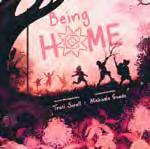
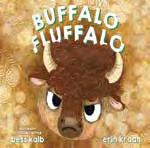
Being Home
By Traci Sorell, Illustrations by Michaela Goade
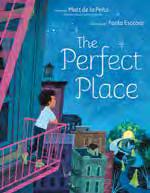


A heartwarming picture book about a Native American family and the joy of moving back to their ancestral land. Today is a day of excitement—it’s time to move! As a young Cherokee girl says goodbye to the swing, the house, and the city she’s called home her whole life, she readies herself for the upcoming road trip. While her mother drives, the girl draws the changing landscape outside her window. She looks forward to the end of the journey, where she’ll eat the feast her family has prepared, play in the creek with her cousins, and settle into the new rhythm of home. With warm, expressive artwork and spare, lyrical prose, the story of a young girl’s move toward rather than away from home unfolds.
Buffalo
Fluffalo
By Bess Kalb, Illustrated by Erin Kraan
Buffalo Fluffalo arrives on the scene puffed up with self-importance. Stomping around and raising billows of dust, Buffalo Fluffalo proclaims his superiority to the other creatures—the ram, the prairie dog, and the crow—who just want to be his friend. So, Buffalo Fluffalo, who has had enuffalo, heads off to grumble to himself. Suddenly, a rain shower pours down from the clouds and—what’s this? All of his fluffalo is a soggy mess! There Fluffalo stands, a drenched pip-squeak without his disguise. The other animals, who could see through Fluffalo’s bravado from the start, circle around to comfort him. As prairie dog says with a smile in his eyes, you’re great how you are, no matter your size.
The Perfect Place
By Matt de la Peña, illustrated by Paola Escobar
Lucas goes to the perfect school in the perfect neighborhood. But life at home is not so perfect. His dad’s old work truck stalls in front of the school. The electricity is out when he gets home, and he doesn’t even have time to show his mom his report (on which he received a perfect score) before she rushes off to her night job. That night, Lucas dreams of a strange light, which he follows down the fire escape, into the alleyway, clear out of his neighborhood, all the way to the place where the perfect people live. Everything there is more beautiful than he could have imagined. But is it possible things aren’t as perfect as they seem? This lyrical, richly illustrated picture book highlights the beauty to be found in even the humblest of homes and in a family that may not be materially rich but is rich in love.
The Secret Language of Birds
By Lynne Kelly
Nina is used to feeling like the odd one out, both at school and in her large family. But while trying to fit in at summer camp, she discovers something even more peculiar: two majestic birds have built a nest in the marsh behind an abandoned infirmary. They appear to be whooping cranes, but that’s impossible—Nina is an amateur bird watcher, and all her resources tell her that those rare birds haven’t nested in Texas for over a hundred years. When Nina reports the sighting to wildlife officials, more questions arise. Experts track all the endangered birds, but they can’t identify the female bird that Nina found. Who is she, and where did she come from? With the help of some fellow campers, Nina sets out to discover who the mystery bird really is. As she gets closer to the truth, will she find a flock of her own?
The Atlas of Us
By Kristin Dwyer
Atlas has lost her way. In a last-ditch effort to pull her life together, she’s working on a community service program rehabbing trails in the Western Sierras. The only plus is that the days are so exhausting that Atlas might just be tired enough to forget that this was one of her dad’s favorite places in the world. Before cancer stole him from her life, that is. Using real names is forbidden on the trail. So, Atlas becomes Maps, and with her team—Books, Sugar, Junior, and King—she heads into the wilderness. As she sheds the lies she’s built up as walls to protect herself, she realizes that four strangers might know her better than anyone has before. And with the end of the trail racing to meet them, Maps is left counting down the days until she returns to her old life—without her new family, and without King, who’s become more than just a friend.
You may purchase these books at shopcrazywisdom.com
The Crazy Wisdom Community Journal • May through August 2024 • Page 73
Babywearing 101: A Crash Course in Safety, Comfort, and Ease
 By Kaili Brooks
By Kaili Brooks
The world is constantly being blessed with the arrival of new little ones, and statistically speaking, you have or will become the parent, grandparent, aunt, or uncle of a brand-new baby. Emerging into a world full of new sights, sounds, and sensations, many babies feel overwhelmed by the number of stimuli they are exposed to and never want to leave their caretaker’s side. Congratulations. This is a perfectly normal baby! Human beings are classified as carry mammals, much like monkeys, and we are designed to have our babies close to us at all times—hence the velcro baby situation many caretakers find themselves in. Unlike monkeys however, our babies do not emerge from the womb with the necessary skills to effortlessly hang onto us, leading many to be confused as to what to do with a baby that never wants to be put down.
The experience of babywearing dates back thousands of years and is practiced by indigenous groups all around the world. As America trends away from the detachment parenting of the 20th century, many people may start to be drawn toward wearing their baby for the close bonding and comfort it provides for the baby, in tandem with the convenience and ease of movement provided for the caretaker. Babywearing makes nursing, walks, cooking, cleaning, naps, and so much more, achievable by freeing up one’s hands and eliminating the obstacle of entertaining a baby. Getting started can be a bit difficult, so let’s begin with a basic overview of your different kinds of carriers.
Emerging into a world full of new sights, sounds, and sensations, many babies feel overwhelmed by the number of stimuli they are exposed to and never want to leave their caretaker’s side.

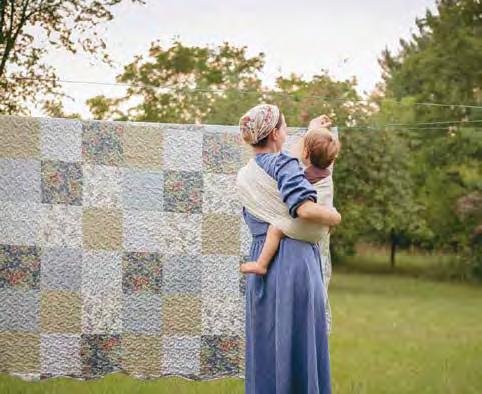
As America trends away from the detachment parenting of the 20th century, many people may start to be drawn toward wearing their baby for the close bonding and comfort it provides for the baby, in tandem with the convenience and ease of movement provided for the caretaker.
Stretchy wrap
• Pros: The stretchy wrap is most commonly and easily used in the newborn stage—before they are too heavy to weigh down the fabric. The wrap is generally composed of cotton and/or spandex to allow for you to keep baby wrapped inward to you like a big hug. They are excellent for skin-toskin.
• Cons: The length of the fabric is cumbersome for many, and the wraps are generally only useful for a short time (around a maximum of 15 lbs.).
Woven wrap
• Pros: This wrap is the O.G babywearing tool! The fabric is often used in the same way as a stretchy wrap, but is significantly more rigid, allowing you to use it for far longer. It is also the only way to carry baby on your back from birth, as the fabric allows for the proper positioning in ways other carriers cannot.
• Cons: The lear ning curve can be significant, and similarly to the stretchy wrap, the amount of fabric can be frustrating when first starting out, especially if you are on the more petite side. If you wish to begin here, a babywearing class may be to your benefit.
Ring sling
• Pros: This carrier allows baby to sit on your hip with the support of a sling over one shoulder. Considered by many to be the best carrier for hands-free use.
• Cons: This carrier is either loved or hated by new parents. It can be quite confusing to adjust and not suitable for all baby or wearer anatomy.
The Crazy Wisdom Community Journal • May through August 2024 • Page 74
Structured carrier
• Pros: A structured carrier is favored by the masses for how easy it is to master. Many allow you to slip it on, pop baby in, and you’re on your way. Hundreds of brands and models exist and allow you to wear baby front, back, and sideways.
• Cons: Because of their popularity, many buy the carriers without being versed in proper safe carrying methods. Many brands are also nonergonomic in their design and unsafe to use.
Now that we’ve covered the basics of your babywearing device, the next step is to ensure that you are wearing your babe safely. Because of the recent boom in babywearing, many dive in headfirst without the proper knowledge of safe positioning, which can lead to adverse effects such as concussions, suffocation, and hip dysplasia. These are unlikely to occur, but with the proper skillset and prior knowledge these risks can be avoided entirely. In the pictures accompanying this article, the babies can be seen in a sort of kangaroo position on the wearer. This is the basic position that can be utilized in all carriers. Begin there and remember this helpful acronym:
T.I.C.K.S
Tight: Ensure that baby is snug to you. Slack and loose fabrics can prohibit proper positioning, causing baby to slump in the carrier, hindering breathing, and weighing on the wearer’s back.
In view at all times: Make sure you can always see baby’s face when looking down. If the baby is covered by fabric or faced into your chest, they may not have space to breathe. If shielding baby from the sun is a concern, there are some wrapping methods that allow for this without covering the head unsafely.
Close enough to kiss: As a rule of thumb, baby’s head should be high enough on your chest to kiss without significant straining.
Keep chin off the chest: To allow space for breathing, ensure baby’s head is not forced downward into their chest. A two-finger gap between chin and chest is adequate.
Supported back: The carrier/wrap should be tight enough to support baby’s back, but not so tight that they are crushed against you. An easy way to do this is to check that the “seat” of the carrier is the lowest point of the carry. Baby’s weight should be supported by their butt and legs, not their back or other parts of the body.
M-sit: When their body is properly supported, their legs should follow an “M” shape, with their butt as the middle of the M.
C-curve: Baby’s back should follow a natural C-curve—not too rounded, not too flat.

The importance of in-person community assistance is a valuable resource that cannot be understated in the age of the internet.
Now that basic positioning has been established, it is necessary to address common mistakes that a first-time baby wearer may make. World-facing.
Though a popular way to carry babies is to face them outward away from you, this position is not optimal for multiple reasons. The C-curve and M-sit are not possible, and baby can get easily overwhelmed and overstimulated without the ability to face inward to the wearer for comfort. Your baby will be able to easily look around while being worn facing inward, so there is no reason for this carry to be used.

Baby is in the wrong carrier.


All carriers come with weight or height limits. After these limits are reached, baby should be transitioned to a different carrier, which should make the carry more comfortable for both of you. The best carry for your big baby is the back carry in a woven wrap or structured carrier.
Your baby is too low.
Baby should sit as high as humanly possible on your chest. When tying your wrap, tie it far tighter than you think you need, as the fabric will stretch out. When wearing a structured carrier, the waist band should be positioned directly under the breastbone to achieve a high enough carry. If your baby appears pinned to the chest and not in a C-curve, try moving the waist band or seat higher and adjusting shoulder straps. This is safer for baby and far more comfortable for you.
Your baby’s seat is too small.
Many carriers, though advertised as such, are not ergonomic for your baby. If the seat does not extend wide enough to achieve the M-position, it should be adjusted or avoided if adjustment is not possible. A sign this is happening to you is if your baby is exhibiting the “crotch dangle,” where all their weight is held by their groin rather than distributed through their legs.
You are uncomfortable.
Your comfort as the wearer is important as well. As a rule of thumb, if it feels wrong, it is wrong. Back pain, hip pain, and cramps are all common symptoms of improper positioning and may be mitigated by adjusting a tie, strap, or shifting a big baby to your back. Finding a carrier that allows for the straps to cross in an X on your back (as opposed to the H strap most carriers employ) may help with back strain.
Many carriers, though advertised as such, are not ergonomic for your baby.
You have now completed your basic course in babywearing. Go forth confidently with your baby comfortably on your chest, back, or hip! If at any point you feel you need more advice, a second opinion on your fit or carrier, or just need a community of fellow baby wearers, there are resources for you. Locally, the Ann Arbor Area Babywearer’s Facebook group can provide any support you need. The Little Seedling shop in the Westgate shopping center has many carriers for you to try on before you buy. If you frequent Reddit, the r/Babywearing subreddit allows you to post pictures of your carry and have it evaluated by the community often within minutes. Many local doula networks also offer babywearing classes for both before and after birth to get prepared for baby and receive advice on your carries after baby is here. The importance of inperson community assistance is a valuable resource that cannot be understated in the age of the internet. Feeling overwhelmed with the sheer amount of information provided is perfectly normal—especially if you have just undergone the transformation of childbirth. Above everything else, remember to take things slow, give yourself grace, and practice. You will be wearing with ease in no time!
Kaili Brooks is an Ypsilanti native and current student in the Eastern Michigan University German program, as well as the new editor of The Crazy Wisdom Community Journal calendar of events. She is a new mom to a one-year-old and passionate about intentional living, fiber arts, baby wearing, and holistic health.
The Crazy Wisdom Community Journal • May through August 2024 • Page 75
be afraid! Conquer fears and neighborhood bullies with Wojer.
Hollow
& the Wizard of the Wood Available at Crazy Wisdom and anywhere books are sold! For children age 4 and up V i sit theauthor online
Don’t
Fox
Tales: Wojer

The Symphony of Development: Exploring the Importance of Music in a Baby’s Growth
By Emma Wymer
In the delicate journey of a baby’s life, music weaves a melody that resonates far beyond the nursery walls. The impact of music on a baby’s development encompasses cognitive, emotional, social, and physical domains. Incorporating music into a baby’s early experiences is not just a source of joy but a powerful catalyst for holistic development.
Incorporating music into a baby’s early experiences is not just a source of joy but a powerful catalyst for holistic development.
A Harmonious Prelude: Early Exposure to Sound
The journey of musical development begins in the womb where the rhythmic lull of a mother’s heartbeat sets the stage for a baby’s auditory experiences. Studies suggest that babies can hear sounds as early as 20 weeks gestation prompting caregivers to consider the impact of the auditory environment on the developing infant.
Beyond the womb, exposing infants to a variety of musical stimuli becomes a foundation for language development. The rhythm, melody, and cadence of music create a rich auditory landscape supporting a baby’s ability to distinguish between different sounds–a skill crucial for language acquisition. As caregivers sing lullabies, engage in musical play, or simply play soft melodies, they are laying the groundwork for the intricate dance between sound and language that will unfold in the coming months and years.
Beyond the womb, exposing infants to a variety of musical stimuli becomes a foundation for language development.
Cognitive Crescendo: Music as Neural Stimulation
The neurological benefits of musical exposure in early childhood are nothing short of remarkable. Music engages multiple areas of the brain fostering the growth of neural connections and enhancing cognitive abilities. Research indicates that musical experiences contribute to the development of the auditory cortex, which is responsible for processing sound, and the prefrontal cortex, associated with executive functions such as planning and problemsolving.
Moreover, exposure to music with patterns and repetitions aids in the development of memory and pattern recognition–fundamental cognitive skills that play a crucial role in various aspects of learning. The intricate interplay of musical elements primes the brain for the complexities of language, mathematics, and spatial reasoning providing a cognitive foundation that extends well into adulthood.

Emotional Resonance: A Melodic Path to Well-being
Emotions have a profound impact on learning, and music serves as a powerful conduit for emotional expression and regulation. Lullabies, with their gentle melodies and soothing tones, create a comforting cocoon for babies fostering a sense of security and well-being. Caregivers intuitively use music to communicate and connect with their infants establishing an emotional bond that transcends words.
As babies grow, the emotional landscape of music expands offering a diverse palette of feelings to explore. Happy, upbeat tunes can elicit smiles, laughter, and a sense of joy contributing to a positive emotional environment. Conversely, slower tempos and softer melodies provide a calming influence helping babies navigate the ups and downs of their emotional world.
Dance of Development: Motor Skills and Musical Movement
The rhythmic nature of music invites movement, and babies instinctively respond to the beat. Even before they can walk, infants sway, bounce, and move their limbs in response to musical stimuli. This spontaneous movement isn’t just an adorable display; it’s a fundamental building block for the development of motor skills.
As babies engage in these rhythmic movements, they enhance their coordination, balance, and spatial awareness. Musical play that involves simple instruments or interactive movements contributes to the refinement of both gross and fine motor skills. The dance of development set to the backdrop of music becomes a dynamic and engaging process that supports physical growth and coordination.
Social Symphony: Building Bonds Through Music
Music is a social experience, and introducing babies to musical activities creates opportunities for interaction and connection. Caregivers often find themselves naturally singing to their babies by clapping hands or engaging in musical games. These shared experiences strengthen the bond between parents, siblings, and the baby fostering a sense of security and trust.
Moreover, group musical activities, such as parent-child music classes or singing with siblings, expose babies to the dynamics of group interaction. These experiences lay the groundwork for social skills development teaching babies about turn-taking, cooperation, and shared enjoyment. The social symphony of music enhances the richness of a baby’s relational world promoting a sense of belonging and connection.
Melodic Diversity: A Gateway to Cultural Exploration
Music serves as a universal language that transcends borders and cultures. Introducing babies to a diverse array of musical genres and styles becomes a celebration of human expression and cultural diversity. From classical compositions to world music rhythms, each musical encounter offers a unique window into the rich tapestry of global cultures.
Early exposure to musical diversity fosters an appreciation for different rhythms, instruments, and tonalities. This not only broadens a baby’s auditory palette but also lays the foundation for a lifelong appreciation of music in all its forms. The melodic journey becomes a cultural exploration, nurturing open-mindedness and curiosity about the world beyond one’s immediate surroundings.
These experiences lay the groundwork for social skills development teaching babies about turntaking, cooperation, and shared enjoyment.
Practical Tips for Incorporating Music into a Baby’s Life
Understanding the importance of music in a baby’s development is just the beginning. Here are some practical tips for caregivers and parents looking to integrate music into their baby’s daily routine:integrate music into their baby’s daily routine:
The Crazy Wisdom Community Journal • May through August 2024 • Page 76

1. Create a Musical Environment:
• Play soft music during feeding or bedtime to create a calming atmosphere.
• Use music as a bac kground for playtime and interactive activities.
2. Sing and Dance Together:
• Sing lullabies or simple songs to your baby regularly.
• Engage in gentle dancing or swaying to the rhythm of the music.
3. Explore Different Instruments:
• Introduce simple instruments, such as shakers or rattles, for tactile and auditory stimulation.
• Allow your baby to experiment with making sounds using safe, babyfriendly instruments.
4. Attend Music Classes:
• Consider joining parent-child music classes in your community.
• These classes often provide structured musical activities and social interaction opportunities.
5. Incorporate Music into Daily Routines:
• Use musical cues for transitions such as signaling bedtime with a specific lullaby.
• Make up simple songs about daily activities to add a musical element to routines.
6. Be Mindful of Preferences:
• Pay attention to your baby’s reactions to different types of music.
• Adjust the musical choices based on your baby’s preferences and comfort.
7. Encourage Creative Expression:
• Provide opportunities for your baby to explore musical instruments and make its own sounds.
• Create a musical corner with safe, age-appropriate instruments for independent exploration.
As we reflect on the symphony of a baby’s development, it becomes clear that music is not merely a pleasant addition to their world; it is an essential and transformative force. From the earliest moments in the womb to the dynamic interactions of daily life, music influences a baby’s cognitive, emotional, social, and physical growth. Caregivers, parents, and educators play a crucial role in curating a musical environment that nurtures the full spectrum of a baby’s
In the rhythm of a lullaby, the beat of a shared dance, and the harmony of musical play, we find the keys to unlocking the vast potential within every child.
In the rhythm of a lullaby, the beat of a shared dance, and the harmony of musical play, we find the keys to unlocking the vast potential within every child. So, let the music play on guiding the development that shapes the beautiful
Emma Wymer is a board-certified music therapist with over six years of dedicated experience tending to the needs of newborns, children, parents, and individuals navigating the journey of childbirth within medical settings. Her expertise extends to specialized training in delivering secure music therapy services for premature infants undergoing care in the neonatal intensive care unit (NICU-MT), perinatal mental health (PMH-C), and facilitating music therapy during childbirth (MTACB). To learn more about Wymer visit her online at birthplacemusictherapy.com or email her at emma@birthplacemusictherapy.com. Wymer lives in Milan.

Crazy Wisdom Kids
An ongoing section of The Crazy Wisdom Community Journal
Articles, calendar listings, advertisements, music and book reviews, and other features that focus on raising conscious and spirited kids.

If you like our CW Kids section, and would like to contribute to it, contact jennifer@crazywisdom.net.
We welcome story ideas, illustrations, feature writing, and photographs.
The Crazy Wisdom Community Journal • May through August 2024 • Page 77
Sadist Summer Camp
 By Amy Lagler
By Amy Lagler
It’s that time of year again: all the papers are full of ads for summer camps you can send your kids to. There’s Spanish Immersion Camp, Rock and Robot Camp, Filmmaker’s Camp, even something called Brain Monkeys Camp. We didn’t have camps like that when I was a kid. Ours weren’t nearly as specific or smart. We just had plain old summer camp
Oh sure, our camps had names and, because we live in Michigan, they were apparently all legally required to have Native American names. Like Camp PaWa-Pi or Camp Algonquin, which was technically the name of the summer camp I went to. The name is somewhat inaccurate though, so from here on out it will be referred to as Sadist Summer Camp.
The camp was run by a well-known organization, but in the interest of protecting their reputation I will only reveal their initials: Y.M.C.A. It was in the little town of Hastings, far from our home but close to our cottage on Leach Lake. Yes, you read that correctly. No one ever wanted to come visit thinking I was inviting them to a “leech” lake. At the time, I didn’t get why we went to camp by the cottage, but now I understand that it meant my mom could spend a week at the lake without us kids. That was surely heaven even if it meant
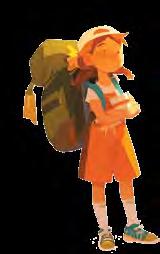
There’s Spanish Immersion Camp, Rock and Robot Camp, Filmmaker’s Camp, even something called Brain Monkeys Camp. We didn’t have camps like that when I was a kid. Ours weren’t nearly as specific or smart. We just had plain old summer camp.
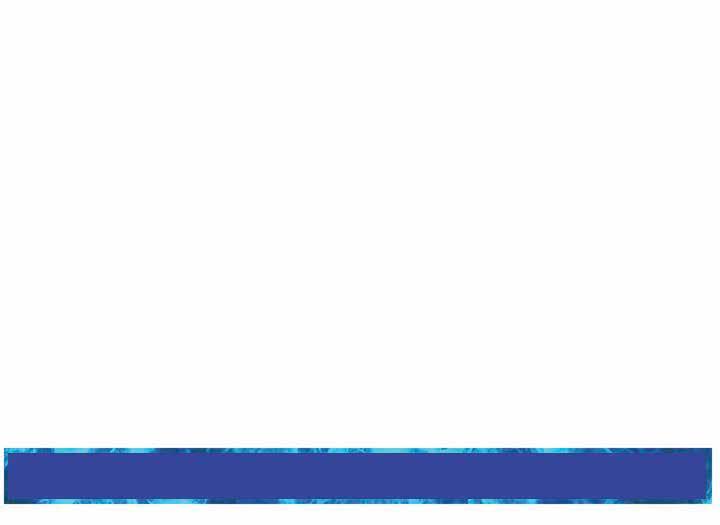
I am sure she didn’t mean to send us to Sadist Summer Camp. It looked good on paper. Nothing but swimming, archery, canoeing, lanyard making, healthy meals, fun campfires, and a safe environment where weirdos wouldn’t mess with us while we were sleeping. The brochure said nothing about “Charlie” or the buried bodies, not to mention the Mad Plunger, or the dead fish ceremony. In the end, however, these things tended to overshadow the pictures in the glossy brochure.

The camp was run by a well-known organization, but in the interest of protecting their reputation I will only reveal their initials: Y.M.C.A.

Take the healthy meals, for instance. They were completely destroyed by “Charlie”—a small super frightening piece of wood that the camp counselors would secretly place behind a camper’s chair during dinner. Whatever unlucky kid found Charlie behind his back had to get up and do an impromptu performance in front of the whole camp. You could showcase any talent you had. It could be anything, but it had to be something. This was a huge problem for me as I had already discovered that I didn’t have any talent. I wouldn’t learn to burp loudly until middle school, and to this day, that is really all I’ve got to give in terms of public performances.
And so, I spent every dinner in utter fear, barely gulping down chunks of food while twisted around like a corkscrew in my chair all to make sure Charlie would not suddenly appear behind me. I don’t think it is a coincidence that it was the following year that they started pulling me out of the “check for scoliosis” line for further examination. It’s hard to eat a healthy meal when you’re terrified and twisted.
Even canoeing at Sadist Summer Camp was an exercise in horror as we always paddled to a small island where we would spend the afternoon traipsing through the woods searching for the dead bodies that the counselors told us were buried there. If anyone stepped on anything squishy you were all expected to run over and jump up and down on the “body.” I’ve never seen such gleeful jumping in all my life. And I would be lying if I said I didn’t do my fair share of corpse stomping. It was my first exposure to what happens when you let a bunch of kids loose on an island. When I read Lord of the Flies years later, it took me awhile to figure out it was an allegory. I thought it was just something that happened.
Going to bed at Sadist Camp produced another set of terrors—actually, one huge terror, in the form of the Mad Plunger who purportedly patrolled the bathroom at night ready to plunge any child who dared have to pee after dark. We all knew he was real because every night, after we had crawled into our bunks, he would come around and repeatedly plunge his plunger on the outside walls of the cabin. Needless to say, this action produced screaming all around and forged our resolve that we would never, ever, leave the safe confines of our cabin at night.
And then we discovered it wasn’t safe in the cabin either. The Mad Plunger, as it turns out, knew perfectly well how to open our cabin door after we had all fallen asleep. And so, we would awaken, our bladders ready to pop, and find ourselves
The Crazy Wisdom Community Journal • May through August 2024 • Page 78
734.945.0914 • tom@shamantom.com • shamantom.com

covered in seaweed—in our hair, on our faces, all over our sleeping bags. As we panicked and pulled it off, the realization settled in. The Mad Plunger had been watching us and touching us while we slept. And he did it, over and over again, night after night. As you can imagine, we tried our best to stay awake, but we were so exhausted from the nightly campfires that we never made it for long.
Usually when you think of campfires you think of s’mores and camp songs, and while I don’t remember s’mores, I do remember the camp songs. How can you forget songs like “Plant a Watermelon?” Everyone sang this one, right?
“Just plant a watermelon on the top of my grave and let the juice (make slurping sound here) slurp through.
Just plant a watermelon on the top of my grave, that’s all I ask of you.
Preacher likes the chicken, and the chickens might fine but nothing could be finer than a watermelon rind, so
Just plant a watermelon on the top of my grave and let the juice (make slurping sound here) slurp through.
Just plant a watermelon on the top of my grave, that’s all I ask of you.”

This was a huge problem for me as I had already discovered that I didn’t have any talent. I wouldn’t learn to burp loudly until middle school, and to this day, that is really all I’ve got to give in terms of public performances.
Obviously, this is wrong on a host of levels. First, why were we singing about graves? Why was the camp so obsessed with graves? Second, preachers, chicken, and watermelon rinds? Seriously? You would think a camp named Algonquin would save its racism for Native Americans and there was plenty of that too, including the most feared “Indian Initiation Ceremony.”
During this “ceremony,” first time campers were blindfolded and “initiated” into the tribe by having a dead fish rubbed on their face. It took place at the last campfire and, as that night approached, I grew increasingly hysterical.
By the time the initiation rolled around, I had worked myself into a sweaty lather and was shaking and sobbing uncontrollably. This might have been entertaining to the counselors and other campers, but it was painfully embarrassing to my older sister Carrie who was also at camp. I suspect we were having very different experiences as Carrie was an older camper and was not being subjected to the nighttime fondling of the Mad Plunger. She was also talented, one of those campers who loved finding “Charlie” behind her chair (she could, and I imagine still can, belt out a song from Oklahoma at the drop of a hat.) She had also already been through the “initiation ceremony” and so knew I was making a complete ass out of myself for nothing—and humiliating her in the process. She sidled up to me and grabbed my arm so hard I think she might have fractured my humerus. Then she put her mouth right next to my ear and whispered in her hot, wet, angry big sister breath, “Shut up. Just shut up right now. It’s NOT a fish, it’s a carton of milk. SHUT UP!”
It took a while for that to sink in (and even longer for my arm to stop hurting), but I did slowly calm down, and by the time they blindfolded me to rub a wet, slippery carton of milk on my face and welcome me to the tribe, I was only shaking a little bit.
By the time the initiation rolled around, I had worked myself into a sweaty lather and was shaking and sobbing uncontrollably.

In the end, like many kids, I came home from summer camp a changed girl. I hadn’t become a fluent Spanish speaker, a filmmaker, or a kid who could build robots, but I had transformed into a skinny, sleep-deprived girl, who harbored guilt for having jumped on corpses, and was nursing both a latent bladder infection and a mild case of scoliosis.
Thanks Sadist Summer Camp.
Amy Lagler lives in Ann Arbor, where she sees a chiropractor for her spine and locks her bedroom door every night. She still has no discernible talent but is finally teaching herself Spanish. She can be reached at habitualtimewaster@ gmail.com.

Writers Wanted
Great way to be visible in the community, and connected.
We are always looking for good articles about the holistic scene… reportage, personal journaling and essays, profiles, interviews, journalistic explorations,and other feature writing.
Modest but respectable pay. If you might be interested, please send a letter of interest and links or PDF samples of previously published writing to jennifer@crazywisdom.net.
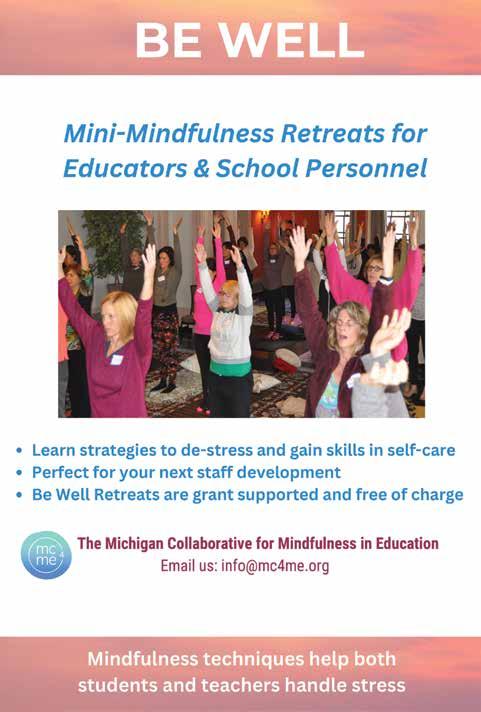
The Crazy Wisdom Community Journal • May through August 2024• Page 79
Kids in the Community
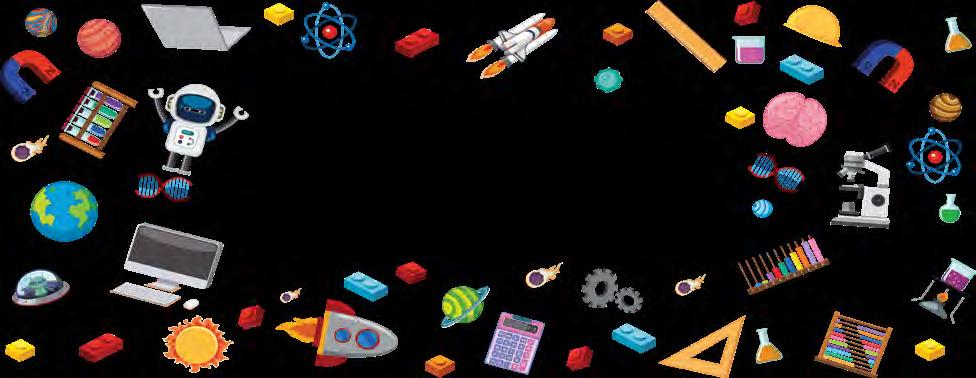 By Christine MacIntyre
By Christine MacIntyre
Science for Kids
Imagine a world where your children are captivated by bubbling potions, erupting volcanoes, and soaring rockets. In this magical realm, adventure awaits. From makeshift kitchen laboratories and hands-on classes to information-packed books, parents can ignite the spark or fuel the burning passion for science with various engaging and immersive activities—some at home, some in person. Unlocking the magic of science begins with nurturing your child’s natural curiosity. Observe what they're interested in and use it to pave the way for exciting career paths in the future. Encourage them to explore the world around them, from the captivating chemical reactions in the kitchen to the physics behind building structures and the behaviors of animals.
Unlocking the magic of science begins with nurturing your child’s natural curiosity. Observe what they're interested in and use it to pave the way for exciting career paths in the future.

Discovering science can be exciting and easy. You can support your children's interest in science by connecting it to their passions. For example, if they love baseball, you can teach them the physics of how baseballs move through space and the impact of gravity. Or, if they're into video games, you can explore the electrical signals and coding that powers their favorite games.
Encourage your children to ask countless questions and craft their theories about the mysteries of nature and the marvels of science. Engage in conversations about captivating scientific topics, let them see your enthusiasm for science, and explore a spectrum of scientific fields together. It's a journey of discovery that you can take together!

Science is not just confined to textbooks and labs. It’s everywhere, all the time! By helping your children recognize science’s profound influence in the world, you can instill a deep appreciation that enriches their journey of discovery.
Science is not just confined to textbooks and labs. It's everywhere, all the time! By helping your children recognize science's profound influence in the world, you can instill a deep appreciation that enriches their journey of discovery. Let curiosity be your compass, whether stargazing, dissecting a frog, or whipping up a batch of slime.
Dive in, explore fearlessly, and embrace the exhilarating journey of discovery that science offers. Who knows what amazing revelations await just beyond the horizon?
Immersive Science Experiences & Camps in the Ann Arbor Area
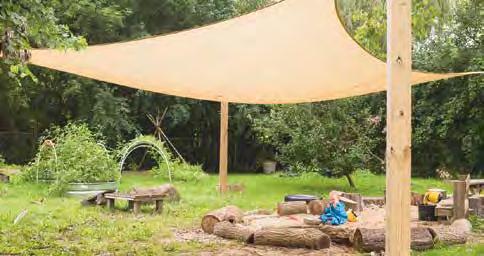

Apple Scouts — Apple Playschools
Apple Playschools' Apple Scouts program is an immersive outdoor camp for children of all ages that embraces the international movement to "rewild" childhood.
"We do this by providing campers opportunities to explore and learn through their interactions with nature. We are outside, rain or shine, hiking, exploring, and letting our campers’ observations and curiosities guide our discussions, activities, and excursions," said Pentyi Delforge, Apple Scouts Camp Director.
From hiking and tracking to mapping and building, campers engage in childinitiated activities that foster a deep appreciation for the local preserves, woods, and trails. Amidst the beauty of nature, they establish meaningful connections with plants and animals, developing a sense of stewardship for the environment.
Amidst the beauty of nature, they establish meaningful connections with plants and animals, developing a sense of stewardship for the environment.

Delforge said they allow campers to engage in risky play by teaching them how to do it in a safe and respectful environment. They are a self-acclaimed "muddy and messy camp." "I often think of Ms. Frizzle's educational philosophy [the teacher character in the Magic Schoolbus books] when it comes to our camp, ‘Take chances, make mistakes, get messy!’” quoted Delforge.
Apple Scouts offers an unforgettable experience where children can grow alongside the natural world, guided by trusted mentors, and surrounded by the wonders of the great outdoors. It is the perfect place where curiosity thrives, and tomorrow's environmental stewards are born.
Sessions are open to youth who have completed Young 5's/Kindergarten through 5th grade. Campers will be assigned to a mixed-age group during their session. Learn more at appleplayschools.org or call (734) 215-5277. Apple Play Schools is located at 900 South Seventh Street in Ann Arbor.
The Future Innovators Academy

This new and growing, small, Ann Arbor-based business is passionate about providing quality S.T.E.M. education. Their goal is to make S.T.E.M. approachable and enjoyable for all kids. The Future Innovators Academy summer camps are packed with exciting activities designed to spark creativity and innovation.
From robotics to A.I., they offer a platform where kids can engage in real-world robotics, electronics, and coding through exploration, creation, and learning.

The Future Innovators Academy founder Andi Sperry says their philosophy centers on "hands-on, project-based learning." From robotics to A.I., they offer a platform where kids can engage in real-world robotics, electronics, and coding through exploration, creation, and learning. "We believe that by providing a nur-
The Crazy Wisdom Community Journal • May through August 2024 • Page 80
turing environment that combines education with real-world applications, we can inspire the next generation of scientists, engineers, and innovators," said Sperry.
According to Sperry, their programs are led by experienced engineers and computer science enthusiasts. Camps are structured, yet flexible, with a blend of four structured learning workshops complemented by periods of unstructured creative innovation. Campers receive electronic kits which are integral to their learning journey. From CAD design to circuit building, block coding to C++ text coding, and 3D printing, these programs provide inclusive and extensive learning backed by safety basics and a solid understanding of fundamental skills.
Two separate weekly camps cater to grades 3-5 and 6-8. In addition to camps, The Future Innovators Academy hosts exciting kids' night out with themes like Lego, Roblox, and Minecraft. They also offer a kids' coding club with drop-in sessions featuring unique projects that challenge creativity.
Learn more through their website thefutureinnovatorsacademy.com/leadcollection, or give them a call at (207) 671-6284. The Future Innovators Academy is located at 3909 Research Park Drive, Suite 400, Ann Arbor. Michigan Science Center

The Michigan Science Center features live stage shows, an IMAX® Dome, a 4D theater, a Planetarium, an 8,700 square foot special exhibit hall, and 220+ interactive exhibits. MiSci offers plenty of immersive and engaging science-based exploration for kids and adults alike. Each exhibit, program, and science show meets the objective of helping children embrace S.T.E.M. Each explores various S.T.E.M. topics and promotes literacy and understanding of the natural world and the built environment.
The latest exhibition, "Above & Beyond," promises to take explorers on an out-of-this-world adventure. It offers a thrilling opportunity to race friends at the speed of sound, take a breathtaking 360-degree view of Earth from orbit, and embark on a fascinating journey to Mars. The exhibit showcases flying cars, supersonic planes, space elevators, and mega-rockets. It promises to take thrill seekers and inquisitive minds faster, farther, and higher for a once-in-a-lifetime experience. The exhibition runs through September.

Permanent experiences include the interactive Design Zone, a planetarium, and an official NASA Space Place. Mi-Sci also has a science store that offers various items curated to all aspects of S.T.E.A.M., with an emphasis on sourcing from small or sustainability-focused vendors. It's a perfect one-stop-shop for science kits, toys, puzzles, and more.
Mi-Sci's Spark! Camps “allow kids to explore interactive exhibits, engage in immersive theater experiences, and investigate science phenomena through hands-on activities and experiments,” according to their website. Camps target three different age levels with age-appropriate lesson plans. For example, older camp groups have more advanced materials with a heavier focus on technology and week-long projects.
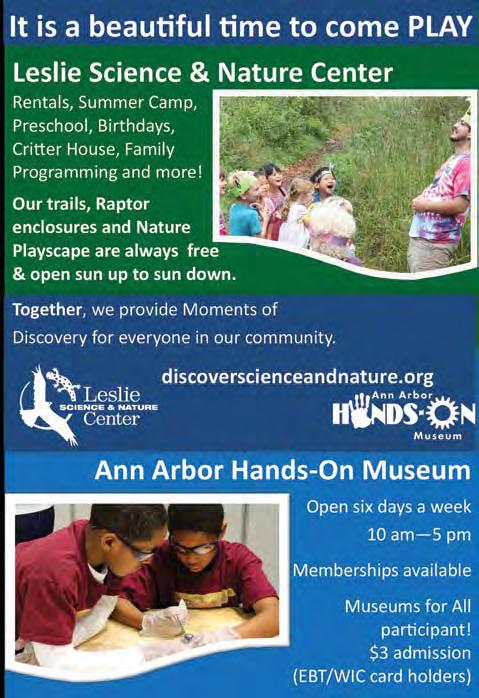
For the youngest scientists, ages two through five, the Young Explorers Program provides opportunities to explore age appropriate S.T.E.M. topics based on themes. These classes incorporate elements such as literacy, social-emotional learning, play, pattern recognition, and improving motor skills. The included activities and crafts are designed to be completed with the assistance of the caregiver.
Families can tune in for distance learning at-home options every Wednesday at 2:30 p.m. as Mi-Sci educators present live science experiments from their Distance Learning studio for free. During the live broadcast, they show some of their biggest and most exciting large-scale science demos. Programs are broadcast live on the Mi-Sci Facebook page and YouTube channel; no registration is required
Find more information on the website at mi-sci.org/ or call (313) 577-8400. You can find the free presentations online at facebook.com/MI.Science.Center or their Youtube page at youtube.com/user/MichiganSciCenter. The Michigan Science Center is located at 5020 John R. Street in Detroit.
Leslie Science & Nature Center

Charlie Reischl, the Leslie Science & Nature Center and Ann Arbor Hands-On Museum Development Manager, said their mission "is to create moments of discovery that inspire curiosity, exploration, and respect for STEAM and the natural world." They're always looking for ways to evolve and expand as a hands-on, nature- and science-focused space that is free to everyone.
The Nature Playscape is being expanded to include a brand-new water play attraction set to debut in spring 2024. This new addition aims to provide families with even more opportunities for free play, encouraging children and parents to explore and "test and expand their comfort with play in the natural landscape."

Charlie Reischl, the Leslie Science & Nature Center and Ann Arbor Hands-On Museum Development Manager, said their mission “is to create moments of discovery that inspire curiosity, exploration, and respect for STEAM and the natural world.”
The Crazy Wisdom Community Journal • May through August 2024 • Page 81

Science for Kids
Families can visit the Critter House every Sunday during their open hours. Opportunities to get up close and personal with fascinating and unusual animals await inside. Outside, the Raptor Loop provides up-close encounters with nonreleasable wild birds. Check out their feathers, beaks, and powerful feet and talons.
Additionally, families can explore the forest's diverse plant and animal life through the Black Pond Woods. The trail is open to visitors from sunrise until sundown and spans a full mile in a spacious loop that takes about twenty minutes at a quick walking pace. However, those who prefer to explore leisurely can take their time and become immersed in the natural world. Kids will love looking for nests, tracks, holes, and other signs that animals have been nearby.
Leslie Science & Nature Center also hosts Unity in Learning summer camp programs for Pre-K through Fifth grade students. The center sprawls over 50 acres of oak-hickory forest, and hosts vernal ponds, prairies, and open fields, which provide an excellent opportunity for campers to explore nature. The center is also home to various live animals, including invertebrates, mammals, reptiles, amphibians, and birds of prey, allowing campers to have up-close encounters with these animals.
Discover more on their website at discoverscienceandnature.org, or learn more by calling (734) 997-1553. The Leslie Science & Nature Center is located at 1831 Traver Road in Ann Arbor.
Ann Arbor Hands-On Museum

The purpose of the Ann Arbor Hands-On Museum is to provide an opportunity for people of all ages to discover and enjoy the wonders of science, math, and technology in an interactive environment that promotes science literacy through experimentation, exploration, and education. This museum boasts immersive exhibits, events, and other fun-infused experiences that anyone will love.
The all-new STEAM Park gallery was designed to inspire the next generation of scientists, engineers, and artists. In STEAM Park, you'll find interactive mechanical exhibits with names that could come from a Jules Verne story, including Window Maze, Airfoil, Propeller Chair, and a first-in-the-world digital Roulette Curve There is even a floor-to-ceiling, multi-interactive 17th-century clock for those who see mere cogs in the machine as priceless learning opportunities.
The All About You gallery, according to the Ann Arbor Hands-On Museum website, allows kids to explore their body by examining bones in their hands, identifying objects by touch, and to see how they would look in a different stage of their lives. They also have a unique opportunity to explore a real ambulance in this gallery.
The Legacy gallery is another exhibit where visitors can experiment with simple machines and learn how traffic lights and the internet work. They can also enclose themselves inside a giant soap bubble, explore H.A.M. radio and Morse code, and more.
Lastly, visitors can check out the mesmerizing Ferrofluid Magnetoscope created by local artist Michael Flynn.

According to their website, the Ann Arbor Hands-On Museum will host Unity in Learning summer camp for K-8 graders. During this camp, campers will enjoy 250+ interactive exhibits, exploring topics such as physics, geology, math, music, and more in ScienceWorks Lab and outdoor spaces.
More information about the Ann Arbor Hands-On Museum can be found at discoverscienceandnature.org, or call (734) 995-5439. The museum is located at 220 East Ann Street in Ann Arbor.
Books Perfect for Science Loving Kids!
Picture-Perfect Science Lessons: Using Children's Books to Guide Inquiry, 3-6
Picture-Perfect Science Lessons integrates the charm of children's picture books with science curriculum standards. This acclaimed resource offers meticulously crafted lessons, including student materials and evaluations, utilizing top-tier fiction and nonfiction picture books to guide hands-on science inquiry. The book is written by classroom veterans and appeals to reluctant scientists and struggling readers who will quickly find themselves absorbed in scientific discovery.

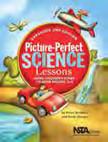
Who Knew? The Big Book of Science Questions That Will Make You Think Again
Who Knew? The Big Book of Science Questions appeals to older kids and adults. It's a comprehensive guide comprising 12 chapters that explore diverse scientific subjects, including astronomy, zoology, the human body, computing and technology, futuristic perspectives, and beyond.
The Fascinating Science Book for Kids: 500 Amazing Facts! (Fascinating Facts)
This engaging book is packed with 500 captivating science facts, guaranteeing hours of educational entertainment for kids aged nine to twelve. With vibrant full-color illustrations enhancing each page, kids will delve into a world of intriguing information covering prehistoric creatures, ocean depths, weather phenomena, minerals, human anatomy, the cosmos—and even the wonders in their backyard.


Nature's Best Hope (Young Readers' Edition): How You Can Save the World in Your Own Yard
In this adaptation of the bestselling Nature's Best Hope for young readers, Tallamy presents a compelling vision for grassroots conservation accessible to all ages. Nature's Best Hope (Young Readers' Edition) inspires kids to take action against climate change using their yards. Tallamy simplifies complex ideas with relatable examples and black-and-white photos. He urges direct involvement, such as planting oak trees or asters, empowering children to realize their impact on the environment. This empowering book instills the belief that kids are indeed nature's best hope in fostering a sense of agency in shaping our collective future.
Unseen Jungle: The Microbes That Secretly Control Our World (Your Hidden Life)

Dive into the intriguing world of microbes with this book, packed with quirky facts, amusing illustrations, humor, and expert interviews. Young scientists (or those just seeking a grossout thrill) will uncover microbes' vital role in our health, the eerie relationship between houseflies and fungi, and how termites are environmental heroes. With added features like sidebars, limericks, and a tutorial on drawing E. coli, this captivating read offers an entertaining journey into the surprising drama of the microbe realm.

Survivor Kid: A Practical Guide to Wilderness Survival
Survivor Kid is a comprehensive guide for young adventurers authored by a seasoned search and rescue professional and outdoor enthusiast. Packed with essential survival skills, from building shelters and starting fires to signaling for help and finding sustenance in the wild, this book equips readers with practical knowledge to navigate and thrive in challenging environments. It's a must-have for any budding explorer with ten engaging projects including shelter construction, fire-starting techniques, navigation challenges, and wildlife observation exercises.
The Crazy Wisdom Community Journal • May through August 2024 • Page 82
There's No Such Thing as Bad Weather: A Scandinavian Mom's Secrets for Raising Healthy, Resilient, and Confident Kids (from Friluftsliv to Hygge)
This one is for the parents. There's No Such Thing as Bad Weather is a delightful parenting guide advocating for outdoor adventures with children. Essential for new parents, it inspires families to embrace the physical and mental well-being benefits of nature fostering a love for outdoor exploration and bonding.


My Awesome Field Guide to Bugs: Find and Identify Your Crawling and Flying Bugs (My Awesome Field Guide for Kids) Field guides are a must-have for any age scientist. From identification assistance and standard location information to basic facts, field guides offer a readily accessible guide for curious minds to refer to when needed. Some field guides also provide a space to write notes and observations. Rocks and minerals, birds, insects, mammals, flowers, trees, seashells, freshwater fish, and even animal poop are easier to find, identify, and catalog with the help of field guides.
Science-Based Fun at Home

Kids can engage in science-based fun at home with toys that inspire curiosity and experimentation. The options are endless from building kits like LEGO's Technic sets, where they can learn about mechanics and engineering principles, to chemistry sets allowing them to concoct their potions and witness chemical reactions firsthand.
Additionally, toys like magnifying glasses, telescopes, and microscopes enable them to explore the wonders of the natural world up close, fostering a deeper appreciation for science. Children have fun and develop essential scientific skills and knowledge by incorporating these toys into playtime.

While there are plenty of fabulous science-based toys, there are also cheaper, straightforward ways to make makeshift kits that will inspire science-infused free play.
Last year, I purchased a 12-in-1 S.T.E.M. solar robot kit for my 10-year-old son for Christmas. Since then, he’s spent hours building and rebuilding! There was a learning curve initially, but we enjoyed problem-solving and putting our heads together to rework the parts. Once completed, hours more fun awaits as you witness how the sun powers the robot.
I remember playing with buildable marble run toys in elementary school technology class. They were so fun. Some are even glow-in-the-dark, adding more excitement.
My daughter loved to put together her own terrarium, and I found that they're a great way to bring nature indoors and teach your kids about plant life. There are plenty of terrarium kits on the market and you can find information online about how to succeed in putting one together yourself.
My family is a huge fan of Legos; however, their small size and complexity can be challenging for younger kids. Magna-tiles are a great alternative. Instead of interlocking pieces, these magnetic shapes feature smooth surfaces and rounded edges and adhere together with magnets. My kids loved these.
A couple of summers ago, my son became very interested in rocks. As his collection grew and curiosity bloomed, we purchased him a rock tumbler. My husband and I both had one as kids, and we both remembered how satisfying it was to pull the tumbled rocks out of the barrel. This was a great investment as it provided hours of fun, but it also led to conversations about different types of rocks and minerals and their origins.
While there are plenty of fabulous science-based toys, there are also cheaper, straightforward ways to make makeshift kits that will inspire science-infused
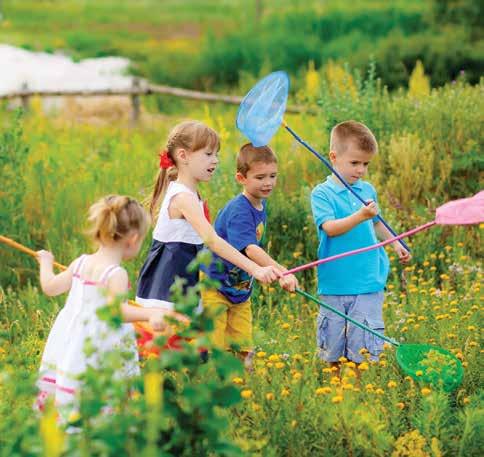
free play. For example, magnifying glasses, bug nets, or even a small shovel can prompt kids to get up close and personal with nature. A pair of binoculars will inspire them to look up and around at their surroundings. Let your kid experiment inside with cups, oil, water, and food coloring, or print off a nature hunt checklist and let them see how many items they can find.
Other ideas include:
• Creating a butterfly habitat.
• Dissecting a flower.
• Making a leaf book.
• Planting vegetable or flower seeds.
• Keeping a moon diary.
• Making a solar calendar.
• Exploring units of measurement.
• Organizing seeds and nuts by type.
• Making fun mosaics with seeds, nuts, flower petals, rocks, or seashells.
The possibilities are endless. Nature offers many supplies, providing kids with opportunities to identify items and their origins, identify colors and shapes, count, sort, compare, contrast, and watch how things change over time.
Part of what makes something "science" is recognizing opportunities to talk to your child about the world around them. Talk to them about the trees while you're hiking or about different types of weather during the different seasons. Even talking about everyday things, such as how their body digests food or best practices to avoid germs, are meaningful conversations rooted in science.
Additional Fun Resources
PBS Kids is a great online resource for fun and learning. Several downloadable apps are available, such as Play and Learn Science, which offers engaging games covering core topics in Earth, Physical, and Life Sciences, or Wild Kratts World Adventure, which offers multi-level games that encourage exploration of habitats around the world.
Classic T.V. shows such as The Magic School Bus, Bill Nye the Science Guy, and Reading Rainbow are full of fun science-based learning. These were my favorites growing up because I learned practical science lessons. Additionally, my kids informed me their school still utilizes these shows to facilitate learning.
The website, scholarsed.com/how-to-get-kids-interested-science/ is a great resource for parents looking for ways to ignite a love of science in their child.
National Geographic has some great resources for kids as well. Their website for kids, https://kids.nationalgeographic.com/sciencecontains science experiments, videos, articles, and more.
There is a plethora of kid-friendly science magazines, such as National Geographic Kids, Ranger Rick, and Cricket For digital options, science podcasts such as Tumble Science and Brains On! are geared toward kids and fun to listen to together.
No matter what path you choose to introduce your kids to science, whether through hands-on experiments, engaging books, exciting field trips, or captivating documentaries, the journey is bound to spark curiosity and wonder in their minds. Encourage them to ask questions, explore the world, and never stop seeking answers. You're laying the foundation for a lifetime of discovery and learning by nurturing their natural curiosity. Dive in, experiment, and embrace the adventure of scientific exploration together!
The Crazy Wisdom Community Journal • May through August 2024 • Page 83
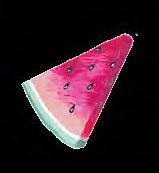
The Crazy Wisdom Calendar
a free guide to local classes, workshops, and events
May through August 2024
Calendar edited by Kaili Brooks
Animals and Pets
Critter House Open Hours with the Leslie Science & Nature Center • Sunday, May 5, 12, 19, & 26
• Noon to 3:00 p.m.
• Observe frogs, turtles, snakes, and more as they hop, crawl, and slither in their habitats! Our Critter House is home to many species native to the region. It’s a great way to get up close and personal with some fascinating animals, all while developing an appreciation for the incredible diversity of the natural world. FREE; suggested donation of $5/person. For more information contact Serena at (734) 205-9567, email sdobson@lesliesnc.org, or visit discoverscienceandnature.org.
Critters Up Close with the Ann Arbor Hands-On Museum
• Saturday, May 25 • Noon to 3:00 p.m. • This monthly series features live animals visiting from our Leslie Science & Nature Center site. On the last Saturday of each month, stop by the Ann Arbor Hands-On Museum from 12-3 p.m. to meet different animals up-close and enjoy a hands-on activity. Themes and animals change every month! FREE with paid Museum admission. For more information contact Serena at (734) 205-9567, email sdobson@lesliesnc.org, or visit discoverscienceandnature.org.
Aromatherapy and Essential Oils
Reiki, Essential Oils, and AromaTouch Experience with Paula A. Burke • Thursday May 2, 9, & 16, June 6, 13, 20, & 27, July 11, 18, & 25, & August 1, 8, 15, 22, & 29. • 1:30 to 4:00 p.m.
• Our wellness sessions are designed to give you an intimate and personalized experience. The session starts with a wellness scan, followed by crafting a custom essential oil blend and finishes with a mini-Reiki session and an AromaTouch Hand technique. These 30-minute sessions are $33. For more information contact Paula at (517) 9369064 or email diffusingpeace@yahoo.com.
Art and Craft
Unicorn Artists Play and Art Gathering by the Water with Ann Harmon • Saturday June 1, Thursday, June 6, & Friday, June 21 • 10:00 a.m. to Noon
• A Unicorn Artist is someone who adds love, light, and sparkles to everything they create. Please join me for a fun and meaningful day at the lake creating Portals of Art. No experience needed. You will leave with a beautiful piece of sacred art, a selenite crystal, and hopefully a joyful memory creating with other women. $45.00, all supplies and a selenite crystal included. For more information contact Ann at (810) 599-3302, or email blessingnrg@gmail.com.
We Roar: 40 Artists, 20 UK Prisons & 20 US Prisons with Faye Claridge, Prison Creative Arts Project (US), & Novus (UK) • Thursday, July 18 to Saturday, July 20 • 10:00 a.m. to 9:00 p.m.
• We Roar is an international collaborative exhibition set to tour prisons in 2024. Forty people in 20 UK and US prisons have been sent a poem and two paintings as inspiration and

are being supported by a team of mentors to produce creative responses for the collaborative exhibition. FREE. For more information contact the Prison Creative Arts Program at (734) 647-6771, email pcapinfo@umich.edu, or visit fayeclaridge.co.uk/weroar.
Book Discussion Groups
Jewel Heart Readers with Jewel Heart Instructors • Monday, May 13, June 24, June 10, July 8 • 7 to 8:30 a.m. • Enjoy lively discussions on monthly Buddhist-related book selections with our community. All are welcome. FREE, donations welcome. For more information contact Jewel Heart at (734) 9943387, email programs@jewelheart.org, or visit jewelheart.org.
Breathwork
Guided Group Breathwork with Jackie Miller • Sunday, May 5 & 19, June 2 & 16, July 7 & 21, & August 4 &18 • 6 to 7:30 p.m. • First and third Sundays. A group session of gentle, connected breathing and breath holds with music, guided by Jackie Miller, certified breathwork facilitator. Experience the power of activated breath energy and learn a variety of supportive breathing techniques. FREE, donations welcome. Registration required. For more information visit thisbreath.com.
Buddhism
Meditation and Discussion with Lama Nancy Burks, Drolma Buchanan, and Yeshe Soergel • Wednesdays • 7 to 8:00 p.m.• All are invited for a group meditation practice and Dharma discussion. Topics vary weekly but include Buddhist philosophy, history of Buddhism in Tibet, and meditation techniques. Questions welcome! FREE. For more information email contact@annarborktc.org or visit annarborktc.org.
Nagarjuna’s Precious Garland of Advice to a King with Demo Rinpoche • Thursdays from May 2 through July 11 • 7 to 8:00 p.m. • In his Precious Garland, Nagarjuna offers sound advice on how to gain happiness in this life, individually, and as a society. He then expands the scope to include happiness in future lives and attaining enlightenment through practical ethics, great compassion, and the wisdom of kindness and emptiness. $70 Jewel Heart members / $95 Jewel Heart non-members. Pay what you can - No one turned away. For more information contact Jewel Heart at (734) 994-3387, email programs@jewelheart.org, or visit jewelheart.org
Jewel Heart Sunday Talks: Ancient Wisdom, Modern Times with Demo Rinpoche • Weekly on Sundays from May 5 through August 25 • 11:00 a.m. to 1:15 p.m. • Join Demo Rinpoche for weekly Sunday morning public talks on a variety of topics that are suitable for newcomers and long-timers alike, followed by a facilitated group discussion based on the morning talk. On the first Sunday of the month, Rinpoche presents the Jataka Tales, stories from the Buddha’s previous lives. No discussion on May 26 and July 28. FREE. Donations welcome. For more information contact Jewel Heart at (734) 994-3387, email programs@jewelheart.org, or visit jewelheart.org.

If you are interested in obtaining some biographical information about the teachers, lecturers, and workshop leaders whose classes, talks, and events are listed in this calendar, please look in the section that follows the calendar, which is called “Teachers, Lecturers, Workshop Leaders, and The Centers” and which starts on page 96.

The Crazy Wisdom Community Journal • May through August 2024 • Page 84

Our Calendar Editor’s Picks of Interesting Happenings in Our Community
Through the Other End of the Telescope with G. Arthur Weidman • May 11, June 8, July 13, & August 10 • 6 to 7:30 p.m. • A Discussion of Metaphysical matters, emotional intelligence, consciousness as part of the quantum field, and intentional creating.
• See Spiritual Development
Herbal Medicine Series with Mary Light • Saturday, May 18 to October 19 • 9:30 a.m. to 2:30 p.m. • Students will learn to create, make, store, apply, and use a variety of herbal medicines upon completion.
• See Herbal Medicine
Wellness, Holistic & Metaphysical Fair with Unity of Bay City • Saturday, May 18 • 10:00 a.m. to 5:00 p.m. • This full-day event featuring wellness services, astrological, numerology, and tarot card readings, body workers, aura photography, free educational sessions, speakers, shopping, food trucks, music, and more!
• See Fairs and Festivals
Learning Tour at Strawbale Studio with Deanne Bednar
• Sunday, May 19, Monday, June 22, & Saturday, August 17
• 10:00 a.m. to Noon
• Tour the Strawbale Studio & other enchanting natural buildings with thatched & living roofs, Strawbale walls, earth plasters and sculptures!
• See Sustainable Living Skills
Unicorn Artists Play and Art Gathering by the Water with Ann Harmon
• Saturday June 1, Thursday, June 6, & Friday, June 21 • 10:00 a.m. to Noon
• A Unicorn Artist is someone who adds love, light, and sparkles to everything they create.
• See Art and Craft
Harmony for Your Soul with Kimberly Harrison Rieli & Jaime Lawrence • June 2 & August 8 • 3 to 5:00 p.m. • An afternoon of self-care and nourishment for your body, mind, and soul.
• See Music, Sound, and Voice
5th Annual Write 4 Insight: Irish Hills Writer’s Retreat with Michelle McLemore • Saturday June 18 & Sunday, June 19 • Saturday from 10:00 a.m. to 6:30 p.m. & Sunday 10:00 a.m. to 4:00 p.m. • Writing craft discussion, drafting on your current projects, and self-care time for nurturing or mentoring.
• See Writing and Poetry
Meditation Concert of Sacred Songs and Healing Chants in candlelight with Norma Gentile • Friday, June 21 • 8:00 to 9:30 p.m.
• Sacred Songs and medieval Healing Chants sung in full candlelight.
• See Music, Sound, and Voice
Solstice Celebration: Labyrinth Walk with Live Music with Rob Meyer-Kukan • Saturday, June 22 • 1:00 p.m. • Join Veriditas Certified Labyrinth Facilitator, Rob Meyer-Kukan for a labyrinth walk to celebrate the Solstice.
• See Meditation

The Crazy Wisdom Community Journal • May through August 2024 • Page 85
Artwork by Jennifer Carson

The Crazy Wisdom Calendar
a free guide to local classes, workshops, and events
May
through August 2024
Buddhism continued...
Practical Buddhism with Gelek Rimpoche • Tuesdays from May 7 to August 24 • 7 to 8:30 p.m. • “Practical Buddhism” offers video recordings of earlier teachings by Gelek Rimpoche as an opportunity for some to revisit and as an introduction for others. A panel discussion with Jewel Heart Instructors follows each session. Discussions are not recorded. Sessions will review Gelek Rimpoche’s 2012 Sunday talks and into early 2013. No event on July 23. Online only. FREE. Donations welcome. For more information contact Jewel Heart at (734) 994-3387, email programs@jewelheart.org, or visit jewelheart.org.
Farewell to Samsara: A Vesak Day Talk with Demo Rinpoche • Thursday, May 23 from 7 to 8:00 p.m. • In Tibetan Buddhism, Vesak Day honors the birth, enlightenment, and death of Shakyamuni Buddha. This Vesak Day talk provides us with an opportunity to celebrate the life of Buddha and to expand our knowledge about Buddha’s journey to enlightenment. FREE. Donations welcome. For more information contact Jewel Heart at (734) 994-3387, email programs@ jewelheart.org, or visit jewelheart.org.
Spring Seminar: Meditation on the Four Gates of Dharma with Demo Rinpoche • Tuesday, May 25, Wednesday, May 26, & Thursday May 27
• Tuesday & Wednesday 8:30 a.m. to 6:30 p.m., Thursday 8:30 a.m. to 5:00 p.m. • Everyone should get some amount of relief in their daily life from stress and tension after meditating on the Four Noble Truths. Without the right meditation, just knowledge is not that effective to get sufficient results. This seminar aims to find profound meditation based on knowledge and to cultivate our insights about life with dharma friends. Online and on-site. Cost to be

determined. Pay what you can - No one is turned away. For more information contact Jewel Heart at (734) 994-3387, email programs@jewelheart.org, or visit jewelheart.org.
Attaining Lasting Satisfaction with Jewel Heart Instructors
• Weekly on Mondays from June 3 to September 16 • 7 to 8:30 p.m. • This course, based on public talks by Gelek Rimpoche, presents the qualities of a genuine spiritual path, and how they can bring us closer to our pure nature and help us attain lasting satisfaction in this lifetime. FREE. Donations welcome. For more information contact Jewel Heart at (734) 994-3387, email programs@ jewelheart.org, or visit jewelheart.org.
Reliable Knowledge in a World of Mere Conversation with Guy Newland
• Saturday, June 29 • 10:00 a.m. to 12:30 p.m. & 2 to 5:00 p.m. • Je Tsongkhapa argues that we can and must have reliable knowledge—of virtue and non-virtue, for example—to progress on the path to perfect awakening. Other Buddhist scholars have argued that emptiness makes reliable knowledge impossible. This program investigates reliable knowledge and provides insight into emptiness. Onsite and online. Cost to be determined. Pay what you canNo one turned away. For more information contact Jewel Heart at (734) 9943387, email programs@jewelheart.org, or visit jewelheart.org.
Realizing the Profound View with the Venerable Thubten Chodron • Saturday, August 17 • 1 to 2:30 p.m. & 3:30 to 5:00 p.m. • Venerable Thubten Chodron explores important questions about who and what we are, how we exist, how to avoid falling into mindsets of absolutism and nihilism, and the topic of interdependence. Cost to be determined. Pay what you can - no one turned away. Online only, stream later at your convenience. For more information contact Jewel Heart at (734) 994-3387, email programs@jewelheart.org, or visit jewelheart.org.
Ceremonies, Celebrations, and Rituals
Our Lonely Hearts: Belonging & Kinship with Kirsten Mowrey • Saturday, May 4 • 9:00 a.m. to 5:00 p.m. • Loneliness is such a part of our daily lives, yet there is a whole living world awaiting our return. Join us as we grieve our loneliness and learn practices to reseed our belonging in the world. Using Andean mystical work combined with Francis Weller’s Jungian soul work, we will nourish our own gifts to bring them forth for our community. $100. For more information contact Kirsten at greatlakesrituals@gmail.com.
Sunday Celebration with Interfaith Center for Spiritual Growth • Sundays from May 5 to Aug 25 • 10:45 a.m. to Noon • Sunday spiritual celebration. In-person and on Zoom. FREE, but donations gratefully accepted. For more information visit interfaithspirit.org.
Gratitude for All That Is: A Community Gratitude Ritual with Kirsten Mowrey • Saturday, August 3 • 10:00 a.m. to 4:00 p.m. • Our grief and gratitude are intimately connected. We come together in this community ritual to give thanks for all we have received this year, to honor our losses and create a tangible gift to give back to our nurturing Earth. Based upon Francis Weller’s village work, this ritual is designed for all ages, from children to elders. $110. For more information contact Kirsten at greatlakesrituals@gmail.com.
Channeling
Evenings with Aaron with Barbara Brodsky and Aaron • Saturday, May 1 & 29 • 7 to 9:00 p.m. • Evenings with Aaron meets once a month. All are welcome. Aaron has met with us regularly since 1989. In this gathering, Aaron often will address a present world issue and how we can best support the resolution of this issue from a place of loving awareness. Suggested donation: $10-$30. For more information contact the Deep Spring Center at (734) 4775848, email om@deepspring.org, or visit deepspring.org
Remembering Wholeness: Darshan with The Mother with Barbara Brodsky and the Mother • Sunday, June 2 • 2 to 5:00 p.m. • The Mother, channeled by Barbara Brodsky offers group and personal messages helping to gently release and reveal places where people are a little bit stuck. They reveal themselves
The Crazy Wisdom Community Journal • May through August 2024 • Page 86
when held deeply with love. Donation: $10-$30. For more information contact the Deep Spring Center at (734) 477-5848, email om@deepspring.org, or visit deepspring.org.
Children and Young Adults
Fireside Fun with the Leslie Science & Nature Center
• Friday, May 31 & June 28 • 5:30 to 9:00 p.m.
• We’ll provide a blazing outdoor campfire and roasting utensils—you provide the rest! Bring your family, friends, camp chairs, outdoor games, and anything else you need to create the perfect Michigan memory. Outdoor fires are held rain or shine (except for thunder and lightning), so come dressed for the weather. FREE. For more information contact Serena at (734) 205-9567, email sdobson@lesliesnc.org, or visit discoverscienceandnature.org.
JUMP-IN 2024 Intensive Therapy Camp with Jacquelin Kilburn • Monday, July 22 through Friday, August 2 • Weekdays 9:00 a.m. to Noon • Therapy camp benefits children with sensory processing difficulties, learning problems, apraxia, in-coordination, low muscle tone, auditory processing dysfunction, and other neurological delays or disorders. We use the three hour “Frequency, Intensity, Duration Model” which has been proven highly effective at making large gains in in motor skills, language, social skills, and sensory processing a small amount of time. We can accommodate eight campers. Our program stands above programs, as we have an intense focus on improving foundation skills as opposed to a more cognitive or play model. Campers must be four years old to begin and may be covered with health insurance. For more information call JUMP-IN at (810) 231-9042 or email info@jumpinot.com.
A Course in Miracles
A Course in Miracles Study Group with Courtney Fitzpatrick • Ongoing Mondays • 11:30 a.m. to 12:15 p.m. • A Course in Miracles is a universal, metaphysical, self-study program of spiritual psychology. We meet weekly to share, learn about and discuss ACIM. Anyone from any spiritual or religious background is welcome. $15/meeting or $30/month. For more information contact Courtney at (734) 808-4007, email courtney@veraposeyoga.com, or visit veraposeyoga.com.
A Course in Miracles Study Group via Zoom with Interfaith Center for Spiritual Growth • Mondays, May 6 through Aug 26 OR Thursdays from May 2 through August 29 • Mondays from 6:45 to 8:00 p.m. OR Thursdays from 7:30 to 8:30 p.m. • Course in Miracles Study Group. FREE, but donations gratefully accepted. For more information visit interfaithspirit.org.
Death and Dying
Death Cafe via Zoom with Interfaith Center for Spiritual Growth • May 7, June 4, July 2, & Aug 6 • 6:30 p.m. to 8:00 p.m. • Discussion of Death and Dying. FREE, but donations gratefully accepted. For more information visit interfaithspirit.org.
Ann Arbor Death Café with Rachel Briggs & Diana Cramer • Saturday, May 18, June 15, July 20, & August 17 • 10:30 a.m. to Noon • Join us for conversation about death and dying. A “death positive” event, not a grief support group, with deep listening. No agenda, no presentation. FREE, open to all adults. Specify Death Café when sending emails. For more information email TheDyingYear@gmail.com or visit DeathCafe.com.
End-of-life Doula Training with Merilynne Rush • Friday, June 19, 26, & Saturday July 10, 17, 24, & 31 • 4 to 7:30 p.m. • Are you called to help others during dying and death? Learn from a hospice nurse and experienced end-of-life doulas from diverse backgrounds. 100-page study guide includes resources and info on how to set up a business. No prior experience necessary. We emphasize cultural humility, understanding our biases, and reducing health disparities. Held on Zoom. $725; scholarships and payment plans are available. For more information email Merilynne at thedyingyear@gmail.com.

Drumming
Drummunity Jams with Lori Fithian • 3rd Saturdays, May 18, June 15, July 20, & August 17• 7 to 8:30 p.m. • Join us for a family-friendly music and drum jam - an evening of rhythm games, vocal improv, movement and more, all with a focus on FUN! Drums will be available, feel free to bring your own instruments! All ages are welcome. For more information contact Lori at (734) 426-7818 or email folksongjamalong@gmail.com.
Energy and Healing
Healing Through the Akashic Records with Shellie Powers • Times & Dates Vary • Embark on a journey of spiritual practice, embracing unconditional selflove, transforming resentment into acceptance, and breaking free from limiting patterns. Activate your inner ascension matrix to overcome challenges and bask in the radiance of your soul, using the time-tested Pathway Prayer Process© Four three-hour sessions. $500. For more information contact Shellie at (734) 926-8423 or visit powers365.com.
Energy Work - Wild Goose Form with Master Wasentha Young • Tuesdays AND/OR Thursdays from May 6 to August 8 • Tuesday from 6 to 7:00 p.m. AND/OR Thursday from 10 to 11:00 a.m. • The Wild Goose Form, a series of interconnecting movements is a reverent dance that embodies the multidimensional aspect of Energy. It includes imagery, stretching, acupoint contact, and connections with universe, nature, and earth. Classes are inperson. Register by 4/20 for a $10 discount. Use code: ss2024. For more information contact the Peaceful Dragon School at 734-741-0695, email info@ peacefuldragonschool.com, or visit .peacefuldragonschool.com.
Heightening Your Vibration: Alchemy with Karen Greenberg • Sunday, June 6 & 9 • 8:45 a.m. to 12:45 p.m. • Learn a myriad of tools and techniques to change your vibration from a lower to a higher vibration, and to sustain it— including, but not limited to, sacred letters, powerful Archetypes, sacred oils, affirmations, visualizations, meditations, prayers that you compose, gratitude, breathing, drumming, clearing, movement, music, Holy Geometry, spiritual practices, toning Names of G-D, Archangels, and Angels. $180 total. For more information contact Karen at (734) 417-9511, email krngrnbg@gmail.com, or visitclair-ascencion.com.
The beautiful spring came; and when Nature resumes her loveliness, the human soul is apt to revive also.

—Harriet Ann Jacobs
Healing & Ascension Monthlies Classes with Rev. Eve Wilson • Thursday, August 15 • 7:30 to 9:30 p.m. • Raise your vibration into unity with your own Higher Self to heal body, mind, soul, and ascend. Learn to live in new world of unconditional love. Release judgment and fear. Help your soul group and the world heal and ascend. Discover your true purpose. Teleconference Call / Recorded / Supported by skilled world healing ascension workers. $300 for a series of six (continues into January). For more information contact Eve at (734) 780-7635, email evew@spiritualhealers.com, or visit spiritualhealers.com.
Festivals and Fairs
Enlightened Soul Holistic 2-Day Psychic Fair with the Enlightened Soul Center & Shop • The Weekends of May 18 &19, June 1 & 2, June 15 & 16, July 6 & 7, July 20 & 21, August 3 & 4, & August 17 & 18 • Saturdays from Noon to 6:00 p.m. & Sundays from Noon to 5:00 p.m. • Join us for two days of high vibrations at the Enlightened Soul Center & Shop at our twicemonthly ESC Holistic Psychic Fairs. What a great way to explore a variety of of readings, energy healing, & metaphysical shopping at one time, under one roof! Admission: $5 Saturday & $3 Sunday. FREE gift, FREE snacks, FREE parking. For more information contact Amy at (734) 358-0218.
Wellness, Holistic & Metaphysical Fair with Unity of Bay City • Saturday, May 18 • 10:00 a.m. to 5:00 p.m. • This full-day event will include opportunities for wellness services, astrological, numerology, and tarot card readings, body workers, aura photography, free educational sessions, speakers, shopping, snacks, food trucks, a raffle, music, and more! FREE to enter. Tickets available for practitioner sessions and readings: $10 for 10 minutes. For more information contact Tammy at (989) 686-0265, email unityhearthub@gmail.com, or visit unityofbaycity.com.
The Crazy Wisdom Community Journal • May through August 2024 • Page 87
The Crazy Wisdom Calendar May through August 2024
Film
Free Film & Discussion with Jewel Heart instructors • Friday, May 10, June 14, July 12, & August 9 from 7 to 9:15 p.m. • Bring your friends and enjoy a free film and discussion about the film. Concessions are also available. Films to be shown are as follows. May 10: “The Notebook.” 2013. The unbreakable bond between two people, rendered extraordinary by the strength, power, and beauty of true love. June 14: “Past Lives.” 2023. Childhood friends confront love, destiny, and the choices that make up a life. July 12: “Eternal Sunshine of the Spotless Mind.” 2004. A comical and poignant look at breakups, breakdowns, and breakthroughs. August 9: “Tibet: A Buddhist Trilogy.” 2006. A three-part feature recombined into one that looks at the Tibetan people as they live now. FREE, concessions available. For more information contact Jewel Heart at (734) 994-3387, email programs@jewelheart.org, or visitjewelheart.org.
Gardening and Ecosystems
New Moon Night Hike with Leslie Science & Nature Center • Friday, May 10 • 7:30 to 9:00 p.m.• Enjoy a hike under the stars to celebrate the alignment of the moon and the sun. We’ll do science experiments to understand how different animals’ eyes see in the dark and visit some of LSNC’s nocturnal animals. After the hike, we’ll hear stories and poems inspired by the moon and enjoy a campfire. $5/person (pre-registration required). For more information contact Serena at (734) 205-9567, email sdobson@lesliesnc.org, or visit discoverscienceandnature.org.
Healing
Laughter Yoga Playshop with Debra Metler • Saturdays from May 4 through August 24 • 11 to 11:45 a.m. • Laughter Yoga is a unique exercise and yogalike breathing program with multiple health benefits. In addition to being a lot of fun, Laughter Yoga reduces stress, strengthens the immune system, improves lung function, reduces chronic pain, and much more. No sense of humor is needed. We will laugh for no reason! Your brain won’t know the difference. $15. For more information contact Debra at (248) 819-2131, email debmetler@ gmail.com, or visit guffaw.square.site.
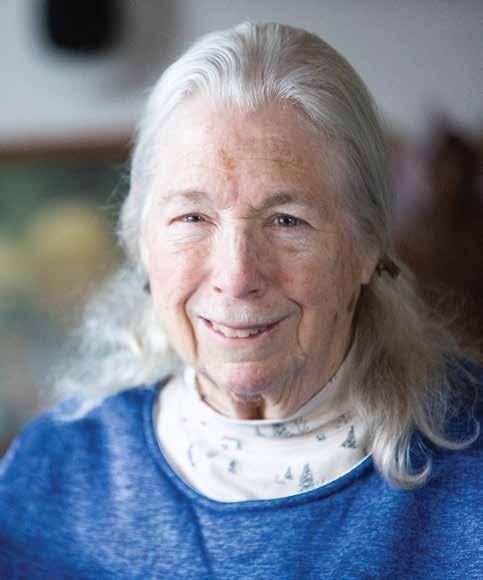
Herbal Medicine

Herbal Medicine Series with Mary Light • Third Saturdays, May 18 to October 19 • 9:30 a.m. to 2:30 p.m. • An herbal medicine series spanning six months. Students will learn to create, make, store, apply, and use a variety of herbal medicines upon completion. Students will directly learn which body systems/ physiology and conditions the herbal formulations should be used for or applied to. Held in a studio class format inside a pleasant apothecary and consulting space, located at 3684 West Liberty Road, Ann Arbor MI, 48103. Herbal Medicine series and classes are independently taught and are not part of state licensure program $800. For more information contact Mary Light at (734) 769-7794, email nshaassociates@gmail.com, or visit naturopathicschoolofannarbor.net.
Intuitive and Psychic Development
Focused Mind Meditation: Teleconference with John Friedlander • Sunday, May 5, June 2, July 7, & August 4 • 9:00 a.m. to Noon • Development of sustained focused meditation makes it easy to develop a whole new magnitude of psychic skill and healing ability, as well as a whole new level of mental clarity and spiritual openness. $15. For more information contact Violeta at (734) 4761513 or visit psychicpsychology.org.
Psychic Psychology Women’s Group: Teleconference with John Friedlander and Gloria Hemsher • Tuesday, May 7, June 4, July 2, & August 6 • 7 to 8:00 p.m. • For Women Only. Meditations concentrating on women’s issues relative to biological energies as well as that of the aura. See website for teleconference number and billing information. $10. For more information contact Violeta at (734) 476-1513 or visit psychicpsychology.org.
Intro to Quantum Energy Flow & Intuition with Michelle McLemore • Saturday, June 8 • 12:30 to 2:30 p.m. • Learn energy system anatomies; practice seeing, feeling, and moving energy; explore a moving meditation and nurture your intuitive abilities; discuss dreams, visions, and encounters. Preregister to ensure materials are available. $75. For more information contact Michelle at (517) 270-0986, email energy@michellemlemore.com, or visit michellemclemore.com.
Barbara Brodsky is a dharma teacher who leads meditation retreats and spiritual inquiry workshops worldwide and is also a trance medium. In Ann Arbor, Barbara is the founding and guiding teacher of Deep Spring Center, since 1989. Totally deaf since 1972, living with silence has greatly influenced her life and teaching,
Barbara is the channel for the spirit, Aaron, and, with him, offers personal spiritual direction sessions and group workshops. Their work together is based on dharma and non-duality teachings and intended to support the deepening of wisdom and compassion. See her calendar listing in the Channeling section on page 86.
Learn more at deepspring.org.
The Crazy Wisdom Community Journal • May through August 2024 • Page 88

A Shamanic View of Ancestors: The Power Within
 By Judy Ramsey
By Judy Ramsey
In shamanism, ancestors are a source of great personal power and support that one may call upon to enrich one’s growth, to gain wisdom, and to manifest one’s highest good.
Who are the ancestors?
Depending on one’s culture, they can be as specific as immediate family members or refer broadly to what shamanic practitioners call All Our Relations, including those with whom we have a heart connection, beloved animals, or everyone and everything who was alive at a particular moment in time. In shamanism, everything has a spirit with whom one may interact. It’s about the connection one has to those in the web of life who are willing to help us.
Christina Pratt, in her Encyclopedia of Shamanism, defines ancestor spirits as spirits of deceased family members who are not only dead, but who have successfully completed their transition into the spirit world where they now belong. These are the well ancestors, who are in their power and want to help from their wholeness. These are the spirits a practitioner calls upon for support and guidance. Ghosts are ancestors who haven’t yet achieved wholeness and can’t support anyone.
In shamanism, everything has a spirit with whom one may interact. It’s about the connection one has to those in the web of life who are willing to help us.

Critical to working with ancestors is the development of a close relationship with them through honoring and acknowledgement. Many cultures honor their dead. Long ago, vigils were conducted in the home before burial, and the deceased continued to be honored through generations. Days of the Dead in Spanish and Latino traditions have an ofrenda, or altar, set up all year long. In Celtic traditions, people fasted and prayed that ancestors would come to the wake; they’d make amulets with the deceased’s hair for an ongoing connection with the person. In Bali, every home is a temple with ancestral altars to keep them close to the family. In Africa, the sangona, or village wise one, retrieves wisdom from the ancestors and channels their advice to villagers.
Modern cultures of the western world have lost this connection with the ancestors. Over time, churches gradually separated people from their homehonoring of the deceased by setting up communal graveyards and rituals that replaced traditional celebrations. According to Dr. David Kowalevski, a shamanic practitioner who works with death and dying, the honoring of ancestors was replaced with honoring of saints. Religious authorities promoted the present and future life, rather than the past. Dr. Kowalevski also points to what he calls the “industry of dying” that further promotes disconnection—funeral homes, laws requiring coffin and burial specifics, sales of coffins, plots, and memorabilia for both human and pet deaths.
Why do ancestors matter?
It is the responsibility of ancestors to hold the memories and wisdom gained from the past all the way back to when humans first began to inhabit the Earth. It is the responsibility of the living to heal the past, to learn from ancestors’ mistakes, and to create change for the descendants.
Ancestors are a source of personal power for a shamanic practitioner. They often present themselves to apprentice shamans, especially if the ancestor was a shaman, wise woman, or medicine man, themselves, and they become teachers and strong allies. A practitioner draws on the collective wisdom of humankind and translates this information from the past into appropriate rituals, healings, and ceremonies for the present situation.
Because our ancestors have the same energetic signature as we do, they can help with family problems and dynamics such as addiction, depression, conflict, or dysfunction. They can help to heal relationships with those who have died. They can also repair the DNA by restoring the original matrix of the person in shamanic ceremony. Ancestors make good helping spirits because they have spiritual experience derived from the crises they themselves experienced in their lifetime. They are the wisdom keepers of the line and the keepers of truth. They help us to face our moments of truth.
How do we connect with our ancestors?
From a shamanic point of view, our ancestors care deeply for us, because we are part of a spiritual family. They are always watching us and are always present, especially if we had a close relationship with them when they were alive. Explore your feelings about connecting with your ancestors. Does it feel comfortable or awkward? Is there anything within your psyche that resists connection?
In Dr. Kowalevski’s experience, the ancestors must be called. They will give us what we need, not necessarily what we want, like any other ally. When I asked, my own spirit allies gave me the following tips to pass along.
1) It is best to connect with ancestors through ritual and ceremony. Finding the well ancestors, connecting in a meaningful way, and then maintaining that connection are the key points. Come from a place of gratitude and awareness.
2) Connect through an altar dedicated to the ancestors. Approach the ancestors with a desire to build community with them.
3) It is important to honor one’s origins, all of which either came from or caused upheaval and dissolution of some kind. Honor the cycles of life and the energy it took to come to the present moment.

One does not have to be a shamanic practitioner to honor one’s heritage.
The shamanic view of ancestral energy is ancient and traditional across many world cultures. One does not have to be a shamanic practitioner to honor one’s heritage. Look at family history to see what means of honoring ancestors is most appropriate. A simple photo collection is a good, basic beginning. Look at the photos and notice the physical similarities through the line. Talk with family members about the gifts that ancestors contributed and acknowledge those strengths within yourself. Learn the names of distant relations.
Judy Liu Ramsey is truly blessed by her relationship with her, Scottish and Chinese ancestors. She has been a shamanic practitioner for more than 12 years and is approved by Sandra Ingerman as an instructor for shamanic practice. She offers healing to both people and animals. If you’d like to learn more about how to access the depth of ancestral gifts through ritual, ceremony, and shamanic journeying, Ramsey will be teaching her class, Ancestors: The Power Within on May 4-5, 2024. See the calendar listings on page 95 under the header “Shamanism.”
The Crazy Wisdom Community Journal • May through August 2024 • Page 89

The Crazy Wisdom Calendar May through August 2024
Intuitive and Psychic Development continued...
Summer Intensive: Webinar/Teleconference with John Friedlander • MidJuly, dates TBA • Thursday and Friday 7 to 9:00 p.m., Saturday 10:00 a.m. to Noon & Sunday 2 to 4:00 p.m. • New material introduced with continued development of advanced and core techniques seeking a natural sense of skill in practical everyday life. Prerequisite: Level 1 Psychic Development Class, CD set, or permission of instructor. $275. For more information contact Violeta at (734) 476-1513 or visit psychicpsychology.org.
Kabbalah
Brand New Beginning Kabbalah: Kabbalah Miracles with Karen Greenberg • Sunday, May 19, June 23, July 21, & August 18 OR Monday, May 20, June 24, July 22, & August 19 • Sunday 10:00 a.m. to 2:00 p.m. OR Monday 7:15 to 9:15 p.m. • This life-changing journey is an ordered approach to develop/balance all important areas of life. Rather than utilizing energy resisting (exercise, meditation, sleep, eating, drinking healthily), we utilize that liberated energy for creating. We develop 10 G-D like traits and become co-creative, proactive manifesters of our dreams and goals, open to miracles, fulfilling our purpose/destiny. Monthly duo rate $180/person; Monthly private rate $150/ hour (based on time utilized) For more information contact Karen at (734) 4179511, email krngrnbg@gmail.com, or visit clair-ascencion.com.

It is not in the stars to hold our destiny but in ourselves.
– William Shakespeare
Love and Relationships
Kabbalah for Couples with Karen Greenberg • Sunday, May 19, June 23, July 21, & August 18 • 3 to 5:00 p.m.
• K4C is for good relationships that both parties are willing to work on to make their relationship even better, physically, emotionally, mentally, financially, spiritually, and energetically. This two-hour session monthly is not couples therapy, but it can help you get your relationship to the place you always wanted it to be but did not know how. $274. For more information contact Karen at (734) 417-9511, email krngrnbg@gmail.com, or visit clair-ascencion.com.
Meditation
Sunday Morning Meditation Sitting with Various Teachers
• 10 to 11:30 a.m.
• Ongoing Sundays
• Non-guided silent meditation. FREE. For more information contact Kenneth at (734) 678-0264 or visit stillmountainmeditation.org.
Weekly Silent Meditation Practice with Celeste Zygmont • Ongoing Sundays and Tuesdays
• Sunday: 11:00 a.m. to Noon AND/OR Tuesday: 9:00 to 9:30 a.m.
• We will have a brief period of chanting, then mute ourselves, and then begin silent vipassana meditation. After the hour is finished a bell will ring and meditators can go on with their day. There will be time to stay and chat or discuss questions if someone so chooses. Donation-based. For more information contact the Deep Spring Center at (734) 477-5848, email om@ deepspring.org, or visit deepspring.org.
White Tara Guided Healing Meditation with Jewel Heart Instructors • Sundays from May 5 to August 25 • 9:30 to 10:35 a.m. • Tara is the mother goddess of Tibetan Buddhism, known for her quick and compassionate activity. White Tara is particularly associated with healing and long life. These guided meditations use visualization techniques to overcome physical, mental, and emotional suffering. FREE, donations welcome. No event on July 28. Online and in-person. For more information contact Jewel Heart at (734) 994-3387, email programs@jewelheart.org, or visit jewelheart.org.
World Labyrinth Day Labyrinth Walk with Rob Meyer-Kukan • Saturday, May 4 • 1:00 p.m. • Join Veriditas Certified Advanced Labyrinth Facilitator, Rob Meyer-Kukan for a labyrinth walk on World Labyrinth Day! For more information contact Rob at (248) 962-5475, email rob@robmeyerkukan.com, or visit 7notesnaturalhealth.com.
Day of Mindfulness with Esther Kennedy • Saturday, May 4, June 1, & August 3 • 10:00 a.m. to 2:30 p.m. • Join our mindfulness community as we deepen our understanding of and commitment to daily meditation practice. Reflecting upon relationships with honesty and courage, we amplify our capacity to be love within our family, neighborhood, city, and world. $35.00/session, includes lunch. Registration required. For more information contact the Weber Center at (517) 266-4000, or email webercenter@adriandominicans.org, or visit webercenter.org.
Healing and Compassion Meditations with Hartmut Sagolla • Mondays, May 6 through August 26 • Noon to 1:00 p.m. • Hartmut Sagolla leads a 30–40-minute guided meditation on a Buddhist theme followed by discussion. Meditations are centered around healing oneself and others and developing compassion. They include concentrated meditation, visualization, and contemplative meditation. Online only. FREE, donations welcome. For more information contact Jewel Heart at (734) 994-3387, email programs@ jewelheart.org, or visit jewelheart.org.
Analytical Meditation: Focusing on Compassion and Wisdom (Meditation Technology Series) with Jim Dawson and Kathy Larit • May 8, 15, 22, & 29 • 7 to 8:30 p.m. • Widely practiced in the Tibetan Buddhist tradition, analytical meditation uses cognitive methods to overcome destructive emotions, such as anger and attachment, to generate helpful states of mind such as compassion and wisdom. Online and in-person. FREE, donations welcome. For more information contact Jewel Heart at (734) 994-3387, email programs@ jewelheart.org, or visit jewelheart.org.
Mastering Meditation with Dr. Kapila Castoldi • Saturday, May 18, 25, & June 1 • 3 to 4:30 p.m. • Introductory meditation series. Topics include concentration, relaxation, and breathing techniques; exploring meditation on the heart center; the awakening of inner awareness; the role of music and mantras. FREE. For more information contact Kapila (734) 994-7114, email castoldi@ oakland.edu, or visit meditationannarbor.com.
Solstice Celebration: Labyrinth Walk with Live Music with Rob Meyer-Kukan • Saturday, June 22 • 1:00 p.m. • Join Veriditas Certified Labyrinth Facilitator, Rob Meyer-Kukan for a labyrinth walk to celebrate the Solstice. Donationbased. For more information contact Rob at (248) 962-5475, email rob@ robmeyerkukan.com, or visit 7notesnaturalhealth.com.
Balancing Sound Bath with Rob-Meyer Kukan • Friday, June 7 • 7 to 8:00 p.m. • Join Rob Meyer-Kukan for this sound bath meditation. In this time of sound bath, Rob will play singing bowls, gongs, and more with the intention of washing you with the sounds that bring calming vibrations to reduce stress and ease tension. For more information contact Rob at (248) 962-5475, email rob@ robmeyerkukan.com, or visit 7notesnaturalhealth.com.
Level 3: Advanced Sound & Vibrational Therapies Course with Meditate School of Mindfulness and Sound
• From Saturday, June 22 to Wednesday, June 26
• 10:00 a.m.
• Over the 7-Days of this course, you will be taken into
The Crazy Wisdom Community Journal • May through August 2024 • Page 90
deeper studies on the science and theory. We will connect the Power of Yoga Nidra, somatics, and frequency, and discover how, in an integrative way, we can deepen our practice and share the therapies of the practice with our clients. $1,395. For more information contact Rob at (248) 962-5475, email rob@ robmeyerkukan.com, or visit 7notesnaturalhealth.com.
Myriad of Meditations with Karen Greenberg • Sunday, June 30, July 7, 14, 28, August 4,11, & 25 • 10:00 a.m. to 12:30 p.m. • Meditation is an essential component to spiritual evolution. Dissolve resistance to and discover a myriad of meditations which resonate for you: with fire, water, air, earth, with the Four Worlds, different breathing, Holy Geometry, sacred letters, powerful Archetypes, Biblical figures, spiritual beings, higher self, qualities of G-D, movement, music, toning, colors, scents, gemstones, and trees. $25. For more information contact Karen at (734) 417-9511, email krngrnbg@gmail.com, or visit clair-ascencion.com.
Labyrinth Tour with Rob Meyer-Kukan • Saturday, August 17 • 10:00 a.m. to 3:00 p.m. • A labyrinth is a tool to quiet the mind and open the heart. In the Ann Arbor area there are a dozen or so public labyrinths within 25 miles. Each style, setting, and material of labyrinth has its own feel and unique experience. Sliding scale donation $5-$30. For more information contact Rob at (248) 9625475, email rob@robmeyerkukan.com, or visit 7notesnaturalhealth.com.
Daylong Meditation Retreat with Carol Blotter • Saturday, July 13 • 9:00 a.m. to 4:00 p.m. • Meditation practice of sitting and walking, plus a short talk. Find peace and calm in a quiet wooded space. Appropriate for all levels of meditators. Suggested Donation $30-$60—o r what you can afford. Located at the Michigan Friends Center, 7748 Clark Lake Road, Chelsea, MI 48118. For more information contact Carol at manager@mfcenter.org.
Music, Sound, and Voice
Folk Song Jam Along with Jean Chorazyczewski and Lori Fithian • Wednesday, May 1, Tuesday, June 4, Wednesday, July 3, and Tuesday, August 6 • 6 to 7:30 p.m. • Come sing and play - join us for a summer of singing! No rehearsals, no concerts - just playing music for the FUN of it! We’ll put lyrics and chords up on a screen, you sing and/or play along! All kinds of songs!! All instruments, ages, and levels are welcome. We alternate days and locations, at Westgate and Malletts Creek library branches. FREE. For more information contact Lori at (734) 4267818 or email folksongjamalong@gmail.com.
Sound Bath with Rob Meyer-Kukaun • Friday, May 3 • 7 to 8:30 p.m. • Join Rob Meyer-Kukan for this sound bath meditation where we will explore the theme of journeys. Labyrinth, walking, and traveling imagery will be combined with the sound of singing bowls, gongs, and more to wash you with sounds that bring calming vibrations to reduce stress and ease tension. $40. For more information contact Rob at (248) 962-5475, email rob@robmeyerkukan.com, or visit 7notesnaturalhealth.com.
Didgeridoo Sound Bath Workshop with Harper & Midwest Kind
• Saturday, May 4 • 4 to 5:30 p.m.
• Peter D. Harper and Bobbi Llewellyn-Harper present a workshop about the ancient Australian Aboriginal wind instrument called the “Didgeridoo” (Yidaki / Mako). They will discuss the many types of didgeridoos available, how they are made, played and their use in Indigenous ceremonies and healing followed by a sound bath presentation. $50. For more information contact Angi at (734) 808-4007, email veraposemedia@gmail.com, or visit veraposeyoga.com.
Cafe 704 Live Music with Interfaith Center for Spiritual Growth • Saturday, May 11, June 8, July 13, & August 10 • 7 to 9:00 p.m. • Cafe 704 is a smoke and alcohol-free venue with live music. $10 per person live or on Zoom. For more information visit Interfaithspirit.org.
Harmony for Your Soul with Kimberly Harrison Rieli & Jaime Lawrence • Sunday, June 2 OR Thursday, August 8
• 3 to 5:00 p.m.
• An afternoon of self-care and nourishment for your body, mind, and soul. Participants will be led in an interactive experience of journaling, emotional freedom technique, gentle stretching, and nervous system healing, followed by a deeply restful sound healing journey. You’ll drift away serenaded by crystal singing bowls, Celtic harp, flutes, gongs, drums, and Kimberly and Jaime’s ethereal voices. Don’t miss this opportunity to immerse yourself in a truly transformative afternoon of selfcare and healing. More dates continue into November. $55 (with sliding scale options of $44 or $33). Located at the Infinite Light Center (formerly Jackson Spiritual Center), at 1805 East Ganson Street, Jackson, MI 49202. For more information contact Jaime at (517) 416-1088, email jaime@hgmusictherapy. com, or visit hgmusictherapy.com OR Kimberly at (310) 502-9367, email info@ singingforyoursoul.com, or visit singingforyoursoul.com.
Sacred Gong Bath with Coach Bill Sullivan • Friday, June 21 • 7:00 p.m. • Join Coach Bill Sullivan of Meditate School of Mindfulness and Sound for this transformational session using more that 12 sacred gongs. $40. For more information contact Rob at (248) 962-5475, email rob@robmeyerkukan.com, or visit7notesnaturalhealth.com.
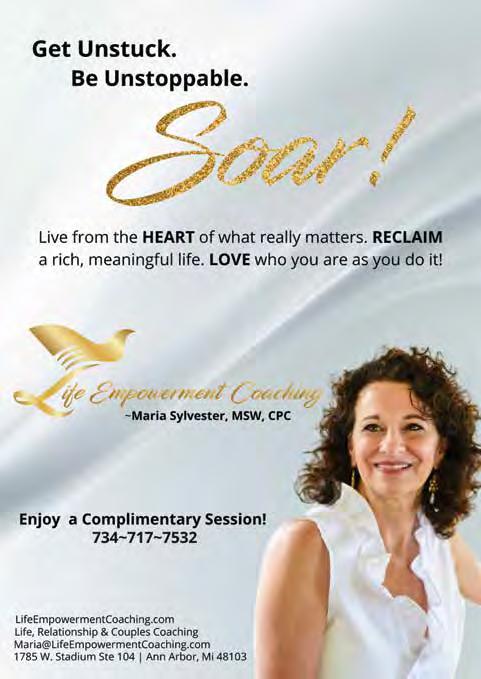


ICrazy Wisdom's E-Blast Service is a great way to showcase yourself, your business and your services! This service i s a cost effective method of reaching a targeted audience without the need for investment in costly hardware and mail related so ftware!
Send out a listing of your upcoming classes, workshops, and events. This is a great way to reach the more than 8000+ people who are currently subscribed to receive our E-Blasts.
Affordable pricing starting at $99.00 for any one email! For all requirements and to pay visit www.crazywisdom.net
Click on "Crazy Wisdom's Email Service" in the left-side menu.
E-Blast Service ads must be mail-ready (see website) and emailed to Carol. Questions? Contact Carol at carol@crazywisdom.net
The Crazy Wisdom Community Journal • May through August 2024 • Page 91
Motherhood as a ReVillaging Rite of Passage
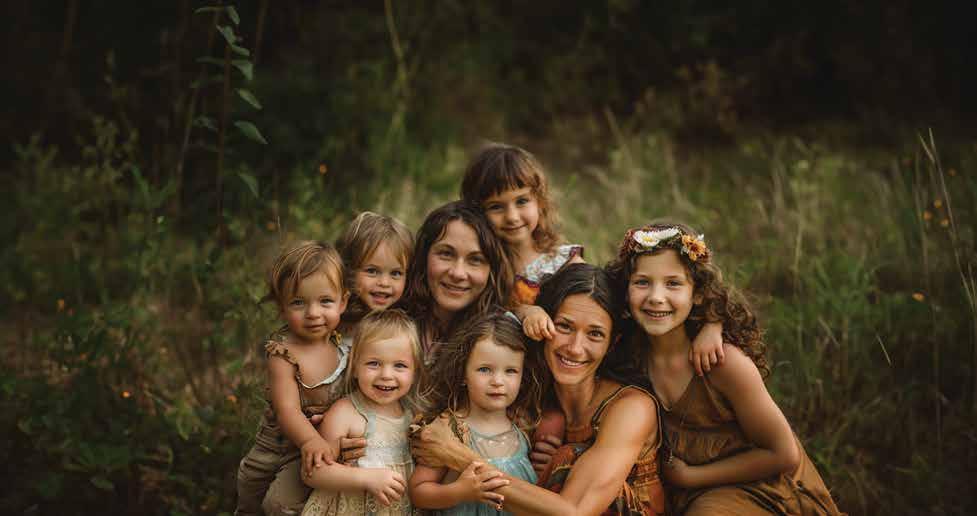 By Miriam Dowd-Eller
By Miriam Dowd-Eller
Almost four years into my personal journey into motherhood, I have learned that some of my challenges are wildly common. Near-constant sensory and logistical overwhelm, deconstructing of (well-intended) pre-baby idealism, hard-to-communicate grief and resentments, and the occasional dose of blinding hot rage or anxiety. My journey has also been, however, a powerful invitation to a rite of passage through and beyond what author Beth Berry calls “Motherwhelm.”

Almost four years into my personal journey into motherhood, I have learned that some of my challenges are wildly common.
Berry explains, “The fact that motherhood overwhelms us is not a sign of weakness but an indicator of importance. […] Motherwhelm isn’t a problem, it’s a rite of passage. Once we recognize it as such and honor these intense times (and intense seasons of our lives) for the potential they have to help us get clear on what we want and what no longer serves us, we can use that intensity to our advantage.”
As someone who gave birth six weeks into the Covid-19 lockdown (plus having some background in community-building, training as a postpartum doula, and acute awareness of industrialization and individualism), my personal rite of passage has kept leading me to this mantra found on berkana.org: “Whatever the issue, community is the answer.”
Caring for your child must extend to include caring for yourself in a pretty radical way—breaking down the barriers of internalized hyper-individualism and building your community. Because we [co-facilitator and owner of Earthwell, Emily Adama] wanted to support this process for ourselves and the mothers in our community, we developed retreats for mothers to attend as a one-time experience, but also to dig a little deeper into a ReVillaging mindset. “What can I shift inside myself to invite more/better community into my life?” It also supported collective brainstorming strategies yielding ideas such as, “How about a dinner co-op? a babysitting co-op? a women’s group?... Or maybe I just need to accept more help when people offer it.” Through our seasonal day-long retreats, we offer mamas a chance not only to nourish themselves in what might look like a typical “self-care day” and network... but also a chance to look at a Revillaging mindset as well as some practical strategies.
REVILLAGING STEP 1:
Acknowledge just how deeply most of us have lost our village.
We have all heard the saying “it takes a village to raise a child,” but motherhood inside of a modern, western society is often a daily slap in the face of just how much we’ve lost. The joyful independence and freedom that was the signature of my pre-baby years, is in stark contrast to the feeling of loneliness and anxiety I’ve felt at times trying to re-weave a healthy, involved, and vibrant network for myself and my family. Yet, knowing something theoretically doesn’t mean it manifests before your eyes just because you want it to.
Hidden within holistic child-rearing advice can lie harmful unintended consequences for the perfectionists among us. Because most of us live in a culture that has lost an intact village (a trust-worthy walkable network of friends and relatives), applying idealistic standards of motherhood to ourselves (however deeply beautiful the vision) can be a recipe for toxic perfectionism and self-abandonment. Beth Berry explains it like this:
Though self-abandonment is something most people struggle with in some way or another, motherhood is a breeding ground for this insidiously self-destructive behavior. From the time children are born, their needs are intense, relentless, and literally screamed in our faces. Luckily for them (and the human race) we are biologically wired to respond to their needs, even when it means setting aside our own. […]
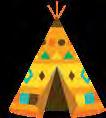
Caring for your child must extend to include caring for yourself in a pretty radical way— breaking down the barriers of internalized hyper-individualism and building your community.
In the United States especially, our social policies for supporting families pale in comparison to our first world counterparts. “In a study [by Baylor University] of about 200,000 children in 20 developed nations, the United States ranked lowest in overall policies aimed at helping parents support children.” More recently than the vague notion of a pre-industrial “village” is the social support that religious groups (such as churches and synagogues) used to provide for many families. It is no secret there has been a massive decline of active participation in religious life in the last few decades, but the need for shared care, connection, and values has not. Many families are consciously, or unconsciously, searching for those needs to be met elsewhere. Our culture has been swiftly driving far away from that of a sustainable, earthhonoring society long before we were born. So, if we cannot (personally) reverse hundreds of years of cultural change to re-create the perfect villagelike experience for our children…what can we do?
The Crazy Wisdom Community Journal • May through August 2024 • Page 92
Acknowledging these massive shifts in societal structure in the last century puts “Revillaging” in a greater context. We need to understand that to come to terms with our losses is not a one-and-done step. The goal is to continually pay attention to “the loss of a village” as one possible reason for overwhelm and resentment. It isn’t to be used, certainly, as just one more reason to avoid taking personal responsibility for your happiness, but in fact, to make an appropriate evaluation of your struggles in the context of modern parenting and to seek solutions that start from this understanding.
REVILLAGING STEP 2:

Our culture has been swiftly driving far away from that of a sustainable, earth-honoring society long before we were born. So, if we cannot (personally) reverse hundreds of years of cultural change to re-create the perfect village-like experience for our children…what can we do?
Pro-actively identify and work with your MotherWhelm and Resentments.
I invite you to consider that failing to meet some of your child’s physical, mental, spiritual, social, and emotional needs is not because of personal failure. Strategically letting go of bits of idealism under unideal circumstances can be deeply healing for a nuclear family household trying to live as healthy and holistically as possible. Letting go of being “the one-woman village” for our children allows us to see the context by which our children have unmet needs and the context by which we have unmet needs. Both sets of needs— children’s and parents’—are equally worthy of being acknowledged, grieved over, and tended to.
REVILLAGING STEP 3:
Get support & build courageous connections.
As Mothers, ReVillaging takes seeking new and different connections for physical and emotional support (for you and your kids) that may take many different forms.
Seeking connection with other mothers with shared values (affinity groups) can be vital. You can have what Dan Siegal calls your four basic needs met: to feel safe, seen, soothed, and supported. Instead of relying 100% on your partner or family for meeting these needs, spreading out your emotional care network can go a long way in feeling whole.
In our seasonal retreats, we use journal prompts, sensitive group facilitation, embodied co-regulation practices, easy-to-learn group songs, mindfulness meditation, nature-connection, gentle yoga, and deep relaxation techniques to proactively use the challenges of motherhood as fuel for digging into transforming your life from the inside out. Putting aside the notion that having needs makes you “needy,” we actively help mothers identify and claim basic needs (such as sleep, alone time, or cultivating an identity outside motherhood) as worthy of being met.
Commonly unmet needs mothers face that we support during EarthWell’s ReVillaging retreats:
• To be witnessed and validated by people in similar life experiences.
• To feel belonging and connection to a group of women.
• Extended time alone.
• To have meals cooked for us.
• Uninterrupted conversations.
• Soothing sensor y environment.
• Deep relaxation (to counteract the hyper-vigilance of keeping small humans alive).
• To voice their grief and challenges, just as much as their joys.
• To place infant/child mental health alongside maternal mental health and to look for lifestyle strategies and solutions that overlap. If singing out loud with a group of mothers (of all ages/stages) who are creatively dismantling internalized hyper-individualism while dreaming up solutions that center re-connection sounds like a great way to spend a day, join us at EarthWell!
Miriam Dowd-Eller is a yoga/movement teacher and massage therapist with a focus on the mothering years. She co-facilitates seasonal retreats at EarthWell Retreat Center in Manchester. She can be contacted at miriam.earthwell@ gmail.com.
Music, Sound, and Voice continued...
Meditation Concert of Sacred Songs and Healing Chants in Candlelight with Norma Gentile • Friday, June 21 • 8 to 9:30 p.m. • Sacred Songs and medieval Healing Chants sung in full candlelight. Norma creates a colorful harmonic tapestry with singing bowls and audience toning, upon which she sings chants composed nearly a thousand years ago by the seer and saint, Hildegard of Bingen. Suggested Donation: $20-$25. For more information visit healingchants.com.
Summer Solstice SING! - a special Folk Song Jam Along with Jean Chorazyczewski and Lori Fithian • Saturday, June 22 • 7 to 9:00 p.m. • Join us for a musical celebration of summer solstice! We’ll have a special set of songs picked out - bring your voices and/or instruments and jam along! We’ll meet at the Interfaith Center for this one. All are welcome! FREE, donations to the center are welcome. For more information contact Lori at (734) 426-7818 or email folksongjamalong@gmail.com.
Sound & Vibrational Therapies Double Certification Course with Bill Sullivan
• Monday, July 6 to Thursday, July 9 OR Saturday, August 10 to Tuesday, August 13 • 10:00 a.m. to 6:00 p.m. • This interactive training is centered around the teaching of Sound Healing & Vibrational Therapies. Our intention for this amazing interactive training is to not only share the theory, science, and practices of sound healing, but to give you “hands-on” experience. $1,590. For more information contact Rob at (248) 962-5475, email rob@robmeyerkukan. com, or visit 7notesnaturalhealth.com.
Sound Bath & Gallery Reading with Rob Meyer-Kukan
• Friday, July 12 • 7 to 8:30 p.m.
• Join Sound Therapist, Rob Meyer-Kukan and Psychic/Medium, Rev. Dr. Ryan Mehmandoost-Gauthier for this time of sound bath meditation including a gallery reading. $50. For more information contact Rob at (248) 962-5475, email rob@robmeyerkukan.com, or visit 7notesnaturalhealth.com.
Sound Bath with Rob Meyer-Kukan
• Friday, August 2
• 7 to 8:30 p.m.
• Join Rob Meyer-Kukan for this sound bath meditation where he will use singing bowls, gongs, and more to create a gentle soundscape perfect for deep relaxation and peace. $40. For more information contact Rob at (248) 9625475, email rob@robmeyerkukan.com, or visit 7notesnaturalhealth.com.
Down Home Dharma House Concert with Steve Wyse • Friday, August 2
• 7 to 9:00 p.m.
• A program of original songs and personal stories from singer/songwriter Steve Wyse which combines Americana-style music with subjects surrounding Buddhism, Native American, Metaphysical, Spiritist, and Unity Church teachings and philosophies. Suggestion donation $10. For more information contact Delyth at (734) 657-5384, email delyth.balmer@ interfaithspirit.org, or visit interfaithspirit.org.
Sound Bath Meditation with Rob Meyer-Kukan • Sunday, August 25 • 7:00 to 8:15 p.m.
• Join Rob Meyer-Kukan for this sound bath meditation in the Gallery at the PARC in downtown Plymouth, Michigan. In this time of sound bath, Rob will play metal and crystal singing bowls, with drums, chimes, and more washing you with sounds intended to bring calming vibrations to reduce stress and ease tension. $40. For more information contact Rob at (248) 9625475, email rob@robmeyerkukan.com, or visit 7notesnaturalhealth.com.
Parenting
Kabbalah for Parents & Children with Karen Greenberg • Sunday, May 19, June 23, July 21, & August 18 • 1 to 3:00 p.m. • Utilizing movement, multisensory input, color, and experiential learning, we build self-esteem of spiritually evolved children (not reinforce feelings of being damaged, defective, disordered, dysfunctional). Journeying through the Tree of Life, we aid in organizational skills, navigating low-vibrational emotions, relationships, setting healthy boundaries. We encourage children in discovering and fostering their authentic selves’ genius and purpose. Future dates TBA. $50. For more information contact Karen at (734) 417-9511, email krngrnbg@gmail.com, or visit clairascencion.com.

The Crazy Wisdom Community Journal • May through August 2024 • Page 93 On May 1, 2024, The Crazy Wisdom Community Journal will be availble on our website: crazywisdomjournal.com.
The Crazy Wisdom Calendar
Personal Growth
Stop Sabotaging Your Self-Care Course with Christy DeBurton • Self-Paced • In this compact, powerful self-paced course you’ll get at the root causes of your self-sabotaging habits. Learn effective tools to set healthy boundaries without the guilt. Banish burn-out, overwhelm, and resentment. Be inspired to eat healthy, sleep well + live better in your body. $19. For more information contact Christy at info@christydeburton.com or visit yogaroomannarbor.com.
Healthy Boundaries with Karen Greenberg • Sunday, May 5 • 10:00 a.m. to Noon • Learn how to define healthy boundaries for and with yourself, and how to set and enforce them (without caving in), and how to respect others’ boundaries in all kinds of personal and professional relationships and situations. Role play is a chief learning tool in the work. $77. For more information contact Karen at (734) 417-9511, email krngrnbg@gmail.com, or visit clair-ascencion. com.
Reiki
Shoden Level I Reiki Certification with Courtney Fitzpatrick • Saturday, June 8 & Sunday, June 9 • Saturday 1 to 6:00 p.m. & Sunday, 9:00 a.m. to 4:00 p.m.
• We will learn traditional Japanese meditation techniques, the history of Reiki and gain a clear understanding of energy work. We will also learn to practice on ourselves and share Reiki with others. Early Bird Special $240 until May 15 or $275 (includes manual). For more information contact Courtney at (734) 8084007, email courtney@veraposeyoga.com, or visit veraposeyoga.com.


Usui/Holy Fire Reiki Certification with Paula A. Burke • Saturday, July 13 & 20 • 10:00 a.m. to 2:00 p.m. • Come join the journey of delving into the reiki world and receive the positive benefits to your life for years to come. Become a certified Usui/Holy Fire 3 Reiki Practitioner, enroll today in our next set of classes. Join Usui/Holy Fire 3 Master Paula Burke in this simple, natural, and safe method of spiritual healing and self-improvement. Reiki I will take place on July 13, Reiki II on July 20. $133 each. For more information contact Paula at (517) 936-9064 or email diffusingpeace@yahoo.com.
Usui System of Reiki Healing, First Degree with Suzy Wienckowski • Saturday, July 13 & Sunday, July 14 • Saturday 10:00 a.m. to 5:00 p.m., & Sunday 10:00 a.m. to 1:00 p.m. • Reiki is a gentle, hands-on healing practice that promotes balance and harmony of the Body/Mind/Spirit. Reiki is easily learned by all and after initiation by a Reiki Master healing energy flows effortlessly through your hands. Class includes the history of Reiki, treatment form for yourself and others, and individual initiations. $200. For more information contact Suzy at (734) 476-7958 or email suzyreiki@aol.com.
Happiness held is the seed; Happiness shared is the flower.
—John Harrigan

Okuden Reiki Level II Certification with Courtney Fitzpatrick • Friday through Sunday, August 23, 24 & 25 • Friday 5:30 to 8:30 p.m., Saturday and Sunday 1to 6:00 p.m. • At the Okuden Level II, we learn how to send Reiki remotely, we learn three different symbols which change the landscape of your connection and experience with Reiki, and we even learn how to Reiki situations etc. - for the highest and best to occur. $625 or early bird $560 until Aug. 3. For more information contact Courtney at (734) 808-4007, email courtney@ veraposeyoga.com, or visit veraposeyoga.com.
Retreats
Personal + Mini Wellness Retreats with Christy DeBurton • Ongoing • When you don’t have the time or budget for a full weekend retreat but just need a little ‘me-time,’ treat yourself to a Mini Retreat or a Personal Retreat to relax and renew. Visit website for pricing options. For more information contact Christy at info@christydeburton.com or visit yogaroomannarbor.com.
Living Our True Nature as Love: Vipassana, Pure Awareness and Practices of the Heart with Barbara Brodsky, Aaron, and John Orr • Sunday, June 2 to Wednesday, June 12 • Sunday 7:00 p.m. through Wednesday 9:00 p.m. • We are the Light we seek; together, let us move toward that vital realization as we seek to restore and deepen harmony and joy in ourselves and the world. A focused meditation retreat helps us to connect with our inner light and to share that light with others. Suggested donation: $180-$660. For more information contact the Deep Spring Center at (734) 477-5848, email om@deepspring.org, or visit deepspring.org.
Private Directed Retreat with Janene Ternes
• Monday, July 15 from 2:00 p.m. through Friday, July 19 at 1:00 p.m. • Experience the serenity and clarity that comes from listening to God’s Spirit within you. This retreat will provide time and space for solitude, personal prayer, quiet reflection, and daily spiritual direction. $450. For more information contact Janene at (734) 347-2422, email PrayerInMotionLLC@gmail.com, or visit prayer-in-motion.com.
The Crazy Wisdom Community Journal • May through August 2024 • Page 94


A Retreat on the Mystics: Julian of Norwich & Thomas Merton with Joan M. Nuth & Joseph Raab • Sunday, July 28 from 7:00 p.m. through Wednesday, July 31 at 11:00 a.m. • Julian of Norwich is an example of what Bernard McGinn has called a “vernacular theologian.” After briefly placing her in her historical context, I will describe the experience which precipitated her writings. I will analyze what is mystical about that experience and evaluate the importance of the theology which grew from it. Thomas Merton’s Multi-Religious Mysticism: An exploration of Thomas Merton’s encounters with non-Christian mystical traditions. Cost: Commuter: $180; Double Occupancy: $280 per person; Single Occupancy: $380. For more information contact the Weber Center at (517) 2664000, email webercenter@adriandominicans.org, or visit webercenter.org.
Shamanism
Journey Circle with Judy Liu Ramsey • Thursday, May 2 & 16, June 6 & 20, July 18, August 1 & 15 • 7 to 8:30 p.m. • Explore concepts in your personal life path through shamanic journeying to receive information and tools to help you proceed with grace and ease. Pre-requisite: journeying skills. $25 per session or $40 per month. The first circle is free. For more information contact Judy at info@JudyRamsey.net or visit JudyRamsey.net.
Ancestors: The Power Within with Judy Liu Ramsey
Saturday, May 4 & Sunday, May 5
9:00 a.m. to 4:00 pm. • Ancestors can be powerful allies in your practice, and healing our ancestral lines can help us heal ourselves and our families. Explore your heritage and deepen your connection with the grandmothers and grandfathers in ceremony, in initiation, and in the shamanic journey. Prerequisite: basic journeying skills. The class will be taught online via ZOOM. $180 per person, $90 for repeating students. For more information contact Judy at info@JudyRamsey.net or visit.JudyRamsey.net.
Introduction to Journeying with Connie Lee Eiland
• Saturday, May 18 and Sunday, June 23 • 10:00 a.m. to 5:00 p.m.
• The six-hour in-person class includes power animal retrieval and journeying to Upper, Lower, and Middle Worlds. Journeying is done with drums and rattles. $80, two weeks before event price rises to $100. For more information contact Connie at (248) 809-3230, or email clshebear7@gmail.com.
Jesse Morgan is a board-certified music therapist, pianist, teacher, songwriter, and father to three children. He studies the many ways music can help people meet both their musical and nonmusical goals. Graduating from Eastern Michigan University in 2021 after earning the esteemed Brehm scholarship, Jesse recently wrapped up a 2-year Music Therapy Fellowship at C.S. Mott Children's Hospital. During this tenure, he played a pivotal role in establishing and launching Sophie's Place, the hospital's dedicated music therapy studio. While developing new and continuing programming for MottTV, he also worked with patients on the pediatric cardiothoracic unit (PCTU) in the Congenital Heart Center (CHC). At Mott, Jesse helped patients and their families navigate heart transplants, dialysis and apheresis treatments, cancer treatments and coping with loss. In the community, Jesse has worked with EMU's Parkinson's Disease Support Group as well as with dementia and hospice patients. Jesse Morgan Music Therapy, his private practice, supports clients, students and community members by offering both private and public sessions, including a monthly Deep Listening Musical Improvisation Group, on first Tuesdays. Learn more at jessemorganmusictherapy.com.
Shamanic Healing for Animals 1 with Judy Liu Ramsey
• Tuesdays from May 21 to July 23 • 7 to 9:00 p.m.
•
Explore perspectives for animal healing that draw upon core shamanic practices. Students develop a toolkit of techniques within supportive and experiential instruction from a professional animal communicator who also practices shamanism. Prerequisite: journeying basics. Knowledge of animal communication is not necessary. The class is taught via ZOOM. $400 per person, $200 for repeating students. For more information contact Judy at info@JudyRamsey.net or visit JudyRamsey.net.
Basic Journeying: The Art of Shamanism for Practical & Visionary Purposes in Daily Life with Judy Liu Ramsey • Saturday, May 25 & Sunday, May 26 OR Saturday, August 17 & Sunday, August 18 • 9:00 a.m. to 3:00 p.m. • The shamanic journey is a powerful tool to access spiritual information. Meet a compassionate spirit or power animal who wants to help you at this time. Learn how to develop a practice of empowerment, so you can balance, moving intentionally through the world. This class is a prerequisite to more advanced shamanic studies. Taught online via ZOOM. $180 per person, $90 for repeating students. For more information contact Judy at info@JudyRamsey.net or visit JudyRamsey.net.
Healing With Spiritual Light with Connie Lee Eiland • Saturday, May 26 from 10:00 a.m. to 7:00 p.m. and Sunday, May 27 from 10:00 a.m. to 4:00 p.m.
• This in-person class brings in quantum physics as we work with the unlimited powers of the universe. In healing with spiritual light, we become light, love, and gratitude. Healing is through the Law Resonance, in some ways like a tuning vibrating to a certain pitch. This method awakens the divinity within the client. $200 until May 11, $230 after. For more information contact Connie at (248) 809-3230, or email clshebear7@gmail.com.
Shamanic Gardening with Judy Liu Ramsey • Saturday, June 1 • 9:00 a.m. to 4:00 p.m.
• From vision to harvest, take the steps to manifest your life dreams and goals through shamanic gardening. Learn how to work with your blocks and challenges so that everything contributes to your growth and synchronizes with your own pace and flow. Pre-requisite: basic journeying. The class is taught via ZOOM. $90 per person, $45 for repeating students. For more information contact Judy at info@JudyRamsey.net or visit JudyRamsey.net.
Connection & Empowerment with Connie Lee Eiland • Saturday, June 8 from 10:00 a.m. to 7:00 p.m. and Sunday, June 9 from 10:00 a.m. to 4:00 p.m.
• This in-person class will improve your connection to Spirit, the Web of Life, and help clarify and strengthen your personal power. Included will be time in nature to assemble a medicine bundle. Journeys, partnered healing, and ceremony are included. $200 until May 25, $230 after. For more information contact Connie at (248) 809-3230, or email clshebear7@gmail.com.
The Crazy Wisdom Community Journal • May through August 2024 • Page 95
•
•
Shamanism continued...
5 Day Soul Retrieval Training with Connie Lee Eiland
• Wednesday, July 3 through Sunday, July 7 • 10:00 a.m. to 5:00 p.m. • This in-person class is for people who want to bring soul retrieval into their practices. Participants will be trained in diagnosis, soul retrieval, and intensive aftercare to help with integration. There is an application process for this training, don’t wait too long as the class size is limited to eight. The length of days will vary with some going into the evening for ceremony. $425 until June 15, $475 after. For more information contact Connie at (248) 809-3230, or email clshebear7@gmail.com.
Extraction: Illness & Healing from a Shamanic Perspective with Judy Liu Ramsey • Saturday, July 20 & Sunday, July 21 OR Saturday, August 24 & Sunday, August 25 • 9:00 a.m. to 5:00 p.m.
• Learn about the spiritual connection to illness. From a shamanic perspective, explore different ways to “diagnose” an illness as well as to address its healing. Deepen your understanding of spiritual intrusions and learn ways to extract them. Prerequisites: Basic Journeying, Medicine for the Earth/Healing with Spiritual Light. In-person class. $220 per person, $100 for repeating students. For more information contact Judy at info@JudyRamsey.net or visit JudyRamsey.net.
Basic Telepathic Animal Communication with Judy Liu Ramsey • Saturday, July 27 & Sunday, July 28 • 9:00 a.m. to 5:00 p.m. • Rediscover your natural telepathic communication skills with step-by-step instruction. Learn how to connect with animals the way they communicate with each other. It’s a fun, creative, and fascinating window to the world around us! Join us for this amazing class. Online via Zoom. $160 per person, $80 for repeating students. For more information contact Judy at info@JudyRamsey. net or visit JudyRamsey.net.

Healing Curses & Spells with Connie Lee Eiland • Saturday, August 24 from 10:00 a.m. to 5:00 p.m. and Sunday, August 25 from 10:00 a.m. to 4:00 p.m. • This in-person class involves recognizing the importance of words and energy for health and well-being. Participants will learn to recognize curses and how to remove them safely. Methods of healing come from Peruvian, Hawaiian, and Tibetan shamanic practices. Class size limited to eight. $200 until August 10, $230 after. For more information contact Connie at (248) 809-3230, or email clshebear7@gmail.com.
Spiritual Development
Learn To Read the Akashic Records: Beginner with Shellie Powers • Times & Dates Vary • Discover the most direct path to access Soul-level wisdom applicable to any life situation, consistently and reliably, using the time-tested Pathway Prayer Process©. Learn about the Akashic Records, the method of access, and develop your skills for successful navigation of the Records, for yourself and others, as a certified practitioner. Three, three-hour sessions. $360. For more information contact Shelly at (734) 926-8423 or visitpowers365.com.
If you are interested in obtaining some biographical information about the teachers, lecturers, and workshop leaders whose classes, talks, and events are listed in this Calendar, please look in the section that follows the Calendar, which is called “Teachers, Lecturers, Workshop Leaders, and The Centers” and which starts on page 96.
Learn To Read the Akashic Records: Advanced with Shellie Powers • Times & Dates Vary • Experience the Akashic Records through the Pathway Prayer Process©. Encounter the energy and wisdom and further develop your skills for successful navigation of the Records, working in the Akashic Records for Energy Healing, Clearing Ancestral Patterns, and Reconciling Past Lives, as an advanced certified practitioner. Three, three-hour sessions. $430. For more information contact Shelly at (734) 926-8423 or visit powers365.com.
Life as a Bold Adventure with Lou Weir • Wednesday, May 1 • 6:00 to 7:30 p.m. • Strength and aliveness are spiritual qualities which are necessary for a spiritual path (and life). We will explore the barriers and connection to this quality in these teachings. The Diamond Approach is a spiritual path which uses meditation and inquiry to uncover the truth of who we are in our authentic nature. FREE Introduction. For more information contact Lou at diamondworkmichigan@gmail.com.
Connecting with Archangels-Parts 1, 2, 3, & 4 with Karen Greenberg • Sunday, May 5,19, 26, June 2 • 5:30 to 9:30 p.m. • Become acquainted with the various Archangels represented in the Sephirot (Spheres) in the Tree of Life. Learn who the Archangels are, what they each do, how to create a sacred, protected space, on whom to call for particular assistance, and how to safely call upon them. Connect—Ask Questions—Often Receive Helpful Information and Guidance. $777. For more information contact Karen at (734) 417-9511, email krngrnbg@gmail.com, or visit clair-ascencion.com.
Explorations with Spirit Workshop Series with Barbara Brodsky and Colette Simone • Tuesday, May 11 • 11:00 a.m. to 3:00 p.m. • We have spoken some about light creation; use of the imaginal cells. Everything you create–is light created. It is expressed into your mundane reality. We will begin to explore the basics of light creation in this workshop. The workshop will be a mix of theory and specific practice. Suggested donation: $30-$110. For more information contact the Deep Spring Center at (734) 477-5848, email om@deepspring.org, or visit deepspring.org.
Sufi Gathering with Amam Ayubbi • Tuesdays from May 7 to August 27 • 7 to 8:00 p.m. • Evening of Sufi discussion and chanting held on Zoom. $5-$10 per session suggested. For more information visit interfaithspirit.org.
Through the Other End of the Telescope with G. Arthur Weidman • May 11, June 8, July 13, & August 10 • 6 to 7:30 p.m. • A Discussion of Metaphysical matters, emotional intelligence, consciousness as part of the quantum field, and intentional creating. $8, donations are welcome. Held in the Crazy Wisdom Community Room, located at 114 South Main St, Ann Arbor, MI 48104. For more information contact G. Arthur at gweidman97@gmail.com.
The Crazy Wisdom Community Journal • May through August 2024 • Page 96
Artwork by Karen Quinn-Markwart
Book Review:
Weedy Wisdom for the Curious Forager: Common Wild Plants to Nourish Your Body & Soul
by Rebecca Randall Gilbert
By Christine MacIntyre
Weedy Wisdom for the Curious Forager is a delightful exploration into the world of foraging, offering readers a unique and insightful perspective on the often-overlooked treasures found in nature’s backyard. Authored by Rebecca Randall Gilbert, the book is a comprehensive guide that helps beginner and advanced foragers embrace the bounty of wild plants and discover the hidden gems under their noses.
Weedy Wisdom is carefully organized and presents a diverse array of edible plants, herbs, and weeds that are readily available and possess fascinating stories and practical uses. Gilbert’s writing style is engaging and accessible, making this book an excellent handbook, or field guide, for anyone interested in foraging. The book includes over 50 recipes, hands-on activities, and social themes that deepen readers’ understanding of plants while revealing important life lessons. Readers will learn how to gather edible flowers, work with invasive species, and preserve harvests. The guide covers everything from roots to flowers to seeds and more.
While the book offers detailed information on identification, harvesting, and preparation, Gilbert based the content on a series of beginner foraging classes packed with information for anyone “who has, or would like to have, an affinity with plants.” She introduces the concept of appreciating the intimate relationship between people and plants, focusing on breathing oxygen-rich air. Gilbert, who refers to herself as the “weed witch,” explains how to lean into plant wisdom. Through discussions about how to appreciate common plants, approach learning from and about them, and deepen existing connections, she hopes to infuse readers with rational and intuitive understanding.
Gilbert starts the book by paying tribute to indigenous people, specifically the Wampanoag people, to whom she acknowledges a debt for her knowledge and deeply rooted passion for the Earth. Her childhood memories of spending summers with her grandmother on Martha’s Vineyard an island she acknowledges as indigenous) have influenced her writing and foraging practices.
Weedy Wisdom’s table of contents is convenient. It serves as a helpful reference point for finding specific lists such as plant portraits, recipes, crafts, practices, and sections of the book referring to leaves, finding corresponding flavors, fermentation, healing first aid, and more. Following a thorough introduction, chapters based on eight foraging sessions focus on common and abundant plants.
Gilbert’s writing is vivid and accessible, and the book is not intimidating, even for those who’ve never heard of or seen the plants discussed. “Foraging can be intimidating… It’s best to start with something accessible and recognizable that can be seen almost anywhere, anytime.” Additionally, beautiful, dainty illustrations enhance readers’ foraging experiences and aid in identification.
Gilbert begins with basic greens, such as mustard greens, and includes simple leaf crisps and sun tea recipes. She then covers essential roots and seeds such as sassafras, sprouts, and chia seeds. Practices include simple, actionable items that any aged forager can do, such as stirring beans in a bowl, arranging them into patterns, or sorting by color and size. The section about edible flowers is instrumental, as they’re often “easier to tell apart
Cultivating a Personal Relationship with G-D with Karen Greenberg • Sunday, June 2 & 9 • 1 to 4:00 p.m.
• Sacred space, compose/ask questions of your Higher Power, decipher yes, no, or essay answers from your spirit vs. thinking in your head vs. emoting or having body sensations. Learn to trust, surrender, serve; express gratitude, awe, and be comforted, healed, protected, and guided by G-D. Compose prayers and feel close to G-D. $90. For more information contact Karen at (734) 417-9511, email krngrnbg@gmail.com, or visit clairascencion.com.
Teilhard de Chardin: Book of Hours with Kathleen Deignan & Libby Osgood • Wednesday, June 5 • 7 to 8:30 p.m. • A contemplative reflection with Sisters Kathleen Deignan and Libby Osgood as they describe how they discovered the “found prayers, poems, and hymns” of Jesuit priest-scientist Father Pierre Teilhard de Chardin and wove them into a Book of Hours for daily

than roots, seeds, leaves, or even berries.” Flowers’ colors, scents, and flavors, such as dandelions and honeysuckle, provide foragers with a fresh culinary treat—different from the gift economy many associate with flowers. Recipes include time-consuming but blissful candied flowers, fritters, and vibrant food coloring.
While Gilbert discusses the immediate use of fresh forage, the section dedicated to fermentation offers a helpful guide to preserving a bounty through pickling, canning, and fermenting. One of the book’s strengths is its emphasis on sustainable foraging practices. Weedy Wisdom encourages readers to develop a deep connection with nature, advocating for responsible harvesting and highlighting the importance of conservation. Gilbert encourages readers to improve their surroundings by planting Jerusalem artichokes, for example, rather than only taking them.
Gilbert’s passion for environmental stewardship is evident throughout the text, inspiring readers to appreciate the delicate balance between humans and the natural world. “As ethical foragers, we attempt to enhance rather than deplete the places where we live, eat, and harvest, behaving in the woods and wild areas as guests in an ancestral garden.” Expressing the give-take relationship, Gilbert dedicates a section to healing first aid. “The entire environment is your living room. There are snacks, amusements, work to be done, and constant entertainment,” she writes, adding that first aid is available for minor injuries.
Gilbert’s book provides a fascinating insight into the world of plants beyond their traditional use as food and medicine. She emphasizes the magical and mystical elements of nature that plants possess. Her personal experiences offer intriguing insights into the physical and mental effects of interacting with plants and the unseen interactions that are constantly occurring. Gilbert’s narrative is inspiring and encourages readers to develop a profound relationship with plants, allowing them to experience their magical journey.
Weedy Wisdom for the Curious Forager is not just a guide to foraging but a celebration of the abundance of nature surrounding us. The author’s infectious love for the subject makes the book immersive and enjoyable. Whether you are an experienced forager or just starting on this exciting journey, this book is an invaluable companion that will deepen your appreciation for the wild edibles nature provides.
prayer. Registration required, $45. For more information contact the Weber center at (517) 266-4000, email webercenter@adriandominicans.org, or visit webercenter.org.
Become an Ordained Minister in the Order of Melchizedek with Rev. Daniel Chesbro • Sunday, June 9 • 1 to 5:00 p.m. • As an ordained priest, you will be able to perform legal weddings, baptisms, funerals, memorials, sacred rituals, and ceremonies. Those who do healing work, energy work, body work, or intuitive readings/counseling may wish to become ordained, as a form of legitimacy and protection and as a statement of their spiritual path. $199. For more information contact Amy at (734) 358-0218 or email amy@ enlightenedsoulcenter.com.
The Crazy Wisdom Community Journal • May through August 2024 • Page 97
The Crazy Wisdom Calendar
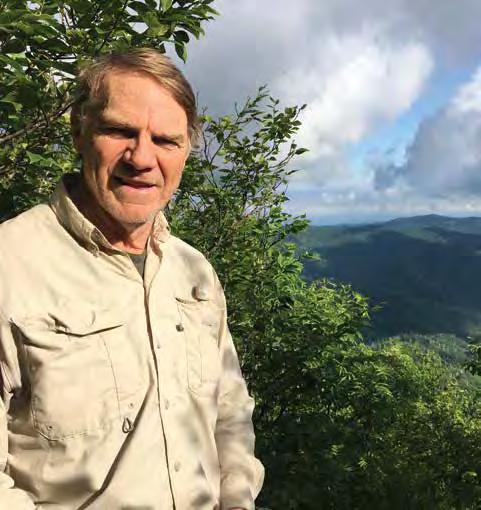
Astral Travel, Including Heavenly Travel with Karen Greenberg • Sunday, June 9, 23, July 7, 14, 21, 28, August 4,11,18, 25, • 5:00 to 9:30 p.m.
• Part One: Learning what is in G-D’s Will, 7 spiritual dimensions, 12 physical dimensions, Archangelic master cell readings, incarnation. Part Two: Preparing ourselves and our space for astral travel. Part Three: Different spiritual dimensions, Akashic records, gates of heaven. Part Four: Celestial locations. Part Five: Different star systems and universes. All previous parts must be completed before advancing. Future dates TBA. $99 per session; 15% discount for each group of four sessions paid up front. For more information contact Karen at (734) 417-9511, email krngrnbg@gmail.com, or visit clair-ascencion.com.
Finding the Heart of Compassion with Lou Weir • Wednesday, June 26 • 6 to 7:30 p.m. • The tender presence of compassion helps us to be less timid about exploring the places that scare us. These teachings will help us to see the ways we close our hearts and support our natural compassion and holding of experience. FREE. For more information contact Lou at diamondworkmichigan@ gmail.com
Sustainable Living Skills
Natural Building Internships at Strawbale Studio with Deanne Bednar • Wednesday, May 1 to Tuesday, May 28 OR Monday, July 1 to Sunday, July 28 • Experience a variety of natural building skill while living & learning onsite at Strawbale Studio. Classes & Hands-on: Foundation, Round pole framing, Thatched & Living Roof, Strawbale walls, Earth Plaster & Cob. Enrichment: Earth Oven, foraging, mushroom log fruiting + more. Some ½ pay worktrade available. $1250 / $950 1 month in advance. Includes room & board. For more information visit strawbalestudio.org.
Learning Tour at Strawbale Studio with Deanne Bednar • Sunday, May 19, Monday, June 22, & Saturday, August 17 • 10:00 a.m. to Noon • Tour the Strawbale Studio & other enchanting natural buildings with thatched & living roofs, Strawbale walls, earth plasters and sculptures! See Rocket Stoves, Earth Oven, Mushroom Garden & more! Ask lots of questions! You may also want to register for the workshop scheduled that day. See website for natural building & craft classes! $20. For more information visitstrawbalestudio.org.
Sustainable Skills Worktrade at Strawbale Studio with Deanne Bednar • Saturday, June 1 through Friday, June 28 OR Thursday, August 1 through Wednesday, August 28 • A unique opportunity to live and work onsite at Strawbale Studio, helping with the grounds, natural buildings and infrastructure, while also being taught sustainable living skills. Nature, purpose, contribution, learning! Includes basic room & board. 25 hours of worktrade a week. For more information visit strawbalestudio.org.
Lou Weir is an Ann Arbor native who attended Pioneer High School, University of Michigan, and Western Michigan University. He practiced law for over 33 years, retiring in 2019. He is a founding teacher with Insight Meditation Ann Arbor, and he also teaches with Diamond Approach Michigan.
As a Diamond Approach Teacher, he works with people using a particular method for self-exploration and discovery—supporting a student in presence—a moment-to-moment exploration into what’s true in our immediate experience. It includes precise questioning, psychological discernment, breath work, body sensing practices and open-ended exploration.
Lou lives in Ann Arbor with his wife, Susan. In his spare time, he enjoys hiking, swimming in Lake Michigan, and playing tennis with his lifelong friends. See his workshop listed in the Spiritual Development section on page 98.
To learn more visit diamondworkmichigan.org.
Tai Chi, Martial Arts, and Self Defense
Chen Tai Chi Chuan with Joe Walters • Ongoing Tuesdays, Thursdays, and Saturdays • 4 to 5:00 p.m.• Instruction in Chen Family Style Tai Chi Chuan. Stance training, silk-reeling exercises, and Chen forms. FREE. For more information email Joe at annarbortaichi@gmail.com or visit annarbortaichi.com
Wu Style Tai Chi Chaun with Marylin Feingold • Sunday, May 5 through August 25 • 4 to 5:00 p.m. • Learn the ancient art of meditation in motion with this “soft style” martial art emphasizing relaxation and balance. In-person,
Something revolutionary happens in the heart when you recognize that every single person you will ever meet is made in the image of God.
– Jackie Hill Perry

The Crazy Wisdom Community Journal • May through August 2024 • Page 98
no meeting on May 26 and July 28. Drop-in, $5 per session collected at the door. For more information contact Jewel Heart at (734) 994-3387, email programs@jewelheart.org, or visit jewelheart.org.
Tai Chi Beginner’s Class with Master Wasentha Young • Mondays AND/OR Thursdays, May 6 through August 8 • Mondays 10 to 11:15 a.m. AND/OR Thursdays 6 to 7:15 p.m.• Tai Chi, often characterized as mindful meditation, is a series of postures linked together in a continuous flow. It integrates the mind and body, promotes relaxation, as well increases balance and concentration. You can attend both sessions at no extra cost! (limit 12 in-person). For more information contact the Peaceful Dragon School at 734-741-0695, email info@ peacefuldragonschool.com, or visit.peacefuldragonschool.com.
Eight Form Tai Chi (Yang Style): Meditation in Motion with Michelle McLemore • Sundays, July 14, 21, & 28 • 1 to 2:30 p.m. • Improve balance, deepen breath, heighten energy flow, and settle into alpha brain waves by learning gentle movements coupled with Qi Gong and grace-giving warmups over three Sunday afternoons. Optional tea following. Outside if good weather. Ages 13 and up. Pre-register. $30. For more information contact Michelle at (517) 270-0986, email energy@michellemlemore.com, or visit michellemclemore.com.
Women’s Health
The Ultimate (Peri)menopause Guide with Christy DeBurton • Self-Paced • This guide will help youlearn about the different stages of (peri)menopause + the most common symptoms; gain knowledge about how to balance your hormones naturally through diet, supplements, herbs + self-care; learn techniques to lower stress and improve your sleep; identify how to exercise smarter for this time of life. $19. For more information contact Christy at info@ christydeburton.com or visit yogaroomannarbor.com.
Writing and Poetry
Crazy Wisdom Poetry Series with Edward Morin, David Jibson & Lissa Perrin
• Workshops: Wednesday, May 8, June 12, July 10, & August 14; Readings: Saturday, May 22, June 26, & July 24
• 7 to 9:00 p.m. • Crazy Wisdom Poetry Series. Hosts: Edward Morin, David Jibson, and Lissa Perrin. Workshop writers discuss their poetry and fiction. Open mic and featured guest readings: Yousef el Qedra, Khaled Jumaa (5/22); Hedy Habra (6/26); Robert Fanning (7/24). Sessions virtual and accessible through Zoom. FREE. For more information contact Edward at (734) 668-7523, email eacmorso@sbcglobal.net, or visit cwcircle.poetry.blog.
5th Annual Write 4 Insight: Irish Hills Writer’s Retreat with Michelle McLemore • Saturday June 18 & Sunday, June 19 • Saturday from 10:00 a.m. to 6:30 p.m. & Sunday 10:00 a.m. to 4:00 p.m. • 1-2 days for writing craft discussion, drafting on your current projects, and self-care time for nurturing or mentoring. Special topic: How do our heart, throat, and brow chakras impact our writing? Assistance if desired on self-exploration via poetry and memoirs. Stay on site for additional fee. Ages 18 and up. Pre-register. $75 one day; $130 both days. Meals and snacks provided. For more information contact Michelle at (517) 270-0986, email energy@michellemlemore.com, or visit michellemclemore.com.
Yoga
Yoga Your Way with Christy DeBurton • Ongoing • Aqua Yoga, Hatha, Vinyasa + Yin Yoga, private sessions, hybrid online courses, retreats, and more. For more information contact Christy at info@christydeburton.com or visit yogaroomannarbor.com.
Open Level Yoga with Michele Bond
• Ongoing Sundays, Tuesdays, & Saturdays • Sundays, 4 to 5:30 p.m., Tuesdays, 6 to 7:30 p.m. & Saturdays 10 to 11:30 a.m.
• Each student is encouraged to honor their own unique abilities and limitations in this mixed level class, with variations offered for all levels. Our method blends the science of biomechanics with an openhearted, uplifting philosophy. Learn to look for the good in yourself and others as you enjoy a dynamic practice. $15 if registered for the semester, $20 drop in with instructor’s permission. For more information contact Michele at (734) 3588546, email michele@yogahouseannarbor.com, or visit yogahouseannarbor.com.
Tuesday and Thursday Yoga with Jillian Diwan
• Ongoing Tuesdays and Thursdays • 10 to 11:00 a.m.
• Ashtanga-based yoga for every body! Limited space. $15. For more information email Jillian at jill@jamhandsbodywork.com.
The Practice with Michele Bond
• Ongoing Wednesdays
• 6 to 7:30 p.m.
• Great for athletes or anyone looking for a strong practice. Enjoy increasing core strength, enhancing flexibility, agility, balance, and mental focus with this fun and energetic practice. Students gain so much mind/body/spirit wisdom that they return year after year to enjoy this life enhancing practice. $15 if registered for the semester, $20 drop in with instructor’s permission. For more information contact Michele at (734) 358-8546, email michele@yogahouseannarbor.com, or visit yogahouseannarbor.com.

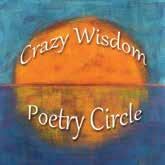

Crazy Wisdom Poetry Series
Hosted by Edward Morin, David Jibson, and Lissa Perrin
Second Wednesdays, 7-9 p.m.: Poetry Workshop. All writers welcome to share and discuss their poetry and short fiction. Sign-up for new participants begins 6:45 p.m.
Fourth Wednesdays, 7-9 p.m.: Featured Reader(s) for 50 minutes. Open Mic reading for 1 hour. All writers welcome to share their own or other favorite poetry. Sign-up begins at 6:45 p.m.
All sessions are virtual and accessible through Zoom. Email cwpoetrycircle@gmail.com for Zoom link.
Featured readers
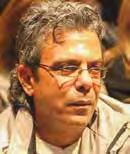
May 22 – Khaled Juma’a was born in Rafah and raised in a Palestinian refugee camp. His 29 publications cover the genres poetry, prose poetry, short stories, children’s stories, TV sketches, plays and over 100 songs. He has held several editorial positions including Head of the Cultural Department in Palestine News and Information Agency (WAFA). A bilingual reading
May 22 – Yousef el Qedra, a poet, novelist, and playwright living in Gaza, expresses the emotional effects of residing in the occupied Palestinian Territory, particularly during the aftermath of Operation Cast Lead (2009) which presaged the current war. He will read his poems in Arabic, matched by Edward Morin and Yasmin Snounu’s co-translations in English.


June 26 - Hedy Habra, poet and artist, will give an illustrated reading from a new ekphrastic collection Or Did You Ever See The Other Side? Her The Taste of the Earth won the Silver Nautilus Award; Tea in Heliopolis won the Best Book Award and Under Brushstrokes was a finalist for the International Book Award.
July 24 – Robert Fanning is the author of five poetry collections: Severance, Our Sudden Museum, American Prophet, The Seed Thieves, and Cage (forthcoming this year). His poems have appeared in Poetry, Ploughshares, and many other journals. He facilitates The Wellspring Literary Series and teaches creative writing at Central Michigan U. www.robertfanning.wordpress. com
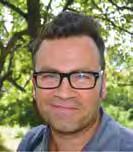
As in other years, we have a writers workshop in August, but no reading on the 4th Wednesday of that month.
Crazy Wisdom Poetry Circle
The Poetry Series is open to all. There is never a charge.
The Crazy Wisdom Community Journal • May through August 2024 • Page 99
https://cwcircle.poetry.blog/
The Crazy Wisdom Calendar
Yoga continued...
Yoga Essentials with Michele Bond
• Ongoing Thursdays • 6 to 7:30 p.m.
• For those new to yoga, or new to this system. Learn universal principles of alignment that are an invaluable aid to learning the postures, deepening your understanding of the body, developing a yoga practice that is safe, joyful, therapeutic, and fun! $15 if registered for the semester, $20 drop in with instructor’s permission. For more information contact Michele at (734) 3588546, email michele@yogahouseannarbor.com, or visit yogahouseannarbor.com.
Saturday Morning Yoga with Jillian Diwan
• Ongoing Saturdays
• 10 to 11:00 a.m.
• Ashtanga-based led yoga class for every body! Donation-based contributions. For more information email Jillian at jill@jamhandsbodywork.com.
Hatha Yoga with Samantha Lieberman
• Thursdays from May 2 to August 29 • 9:15 to 10:15 a.m.
• Sam loves the process of creating and offering safe yet challenging yoga sequencing. She enjoys sharing her love of yoga with all levels of students and is deeply honored to pass the gift of yoga to others. Bring your own mats. Drop-in $15 per session – First visit is FREE! Cash or Venmo at door. Seniors receive 10% discount. Discounted packages available. For more information contact Jewel Heart at (734) 994-3387, email programs@ jewelheart.org, or visit jewelheart.org.
Gentle Yoga Flow at Infinite Light Center with Paula A. Burke • Thursdays from May 2 through August 29 • Noon to 1:00 p.m. • Gentle Yoga Flow for everybody. Starting every class with a little meditation, offering a drop of essential oil, and then going into gentle yoga twists, bends, stretches, and long holds in luxurious poses will help with stress relief, mental & physical relaxation, and restoring energy. $10. For more information contact Paula at (517) 9369064 or email diffusingpeace@yahoo.com.
Teachers, Lecturers, Workshop Leaders & the Centers
Aaron is a discarnate spirit who serves as a wisdom teacher from a realm beyond the Earth plane. He has been a Buddhist monk and scholar in many lifetimes, and expresses as a being of great love, compassion, wisdom, and gentle humor.
Andrea Anzalone is a Yoga instructor, Reiki certified, and an essential oil enthusiast. She has a profound love for animals and is on a unique journey to freedom and healing.
Deanne Bednar has been an instructor at Strawbale Studio since 2003 teaching thatched/ living roofs, strawbale walls, earth plasters, round pole, rocket stoves, and foraging. She also is the illustrator of The Hand-Sculpted House
Carol Blotter has been teaching meditation for almost 25 years. Her practice and study have led to a blending of Buddhism and Non-Duality teachings. She is the primary teacher of Chelsea Meditation Group.
Michele Bond has 800+ hours of training in yoga, therapeutics, meditation, and a lifetime devoted to fitness and wellness. Dance training, martial arts, competitive synchronized swimming, gymnastics,
Yoga + Sound with Rob Meyer-Kukan • Saturday, May 18 • 6 to 7:30 p.m. • Join Sound Healer, Rob Meyer-Kukan and Yoga Instructor, Paul Barr for this heartfelt pairing of Yoga + Sound at 7 Notes Natural Health. $40. For more information contact Rob at (248) 962-5475, email rob@ robmeyerkukan.com, or visit 7notesnaturalhealth.com.
Reiki & Yoga Experience: Rebalancing the Wheels of Life with Paula A. Burke & Andrea Anzalone • Sunday, May 19 • 2 to 4:00 p.m. • We invite you to join Andrea and Paula for a special event focusing on chakra balancing using Reiki and Yoga. This unique session will provide you with a deeper understanding of these healing arts and how they can be used to balance your chakras, promoting health and wellness from the inside out. $33. For more information contact Paula at (517) 936-9064, email diffusingpeace@yahoo.com, or visit diffusingpeace.com.

stunt fighting, and swordplay preceded 20+ years of impactful, lighthearted yoga teaching experience.
Barbara Brodsky, founder and guiding teacher of Deep Spring Center for Meditation and Spiritual Inquiry, has practiced meditation since 1960. Teaching Vipassana meditation and non-dual awareness from the Dzogchen traditions, also an ordained minister. Barbara is a trans-channel for Aaron.
Paula A. Burke has a deep-seated love for reiki, yoga, and essential oils, all of which play a crucial role in her healing sessions. She combines her knowledge of these elements to offer unique experiences tailored to each individual’s needs, striving to create a safe and nurturing space for everyone.
Lama Nancy Burks is the resident lama at Ann Arbor KTC and has completed a three-year retreat in the Karma Kagyu lineage. Her students, Drolma Buchanan and Yeshe Soergel, are advanced students and lay householders.
Dr. Kapila Castoldi is a physicist. She has studied meditation under the guidance of spiritual teacher Sri Chinmoy for over 35 years. Her classes are offered free of charge as a community service.
Rev. Daniel Chesbro became a seminary-trained American Baptist Minister after college. He was guided to start the Order of Melchizedek in 1986. His work has taken him all over the U.S., as well as to Canada, Europe, India, Tibet, and Egypt.
Venerable Thubten Chodron is an author, teacher, and the founder and abbess of Sravasti Abbey, the only Tibetan Buddhist training monastery for nuns and monks in the US. She has studied extensively with His Holiness the Dalai Lama, Tsenzhap Serkong Rinpoche, and Kyabje Zopa Rinpoche.
Jean Chorazyczewski and Lori Fithian are longtime community music-makers, committed to creating events where people of all ages can play music together, without the pressure of rehearsals and performance - singing, strumming, and drumming!
Crazy Wisdom Poetry Circle is a poetry group sponsored by Crazy Wisdom.
The Crazy Wisdom Community Journal • May through August 2024 • Page 100
obsessive intrusive magical thinking by Marianne Eloise
By Christine MacIntyre
Obsessive Intrusive Magical Thinking by Marianne Eloise is a raw and compelling exploration of the author’s journey through the labyrinth of neurodiversity. Eloise candidly invites readers into the intimate corridors of her mind, offering a poignant and authentic account of living with intrusive thoughts, and the relentless pursuit of magical thinking.
The narrative unfolds with a captivating blend of vulnerability and resilience. Eloise’s writing style is both evocative and unapologetically honest, allowing readers to connect with the challenges she faces on a profoundly personal level. The book delves into the intricacies of autism, ADHD, and obsessivecompulsive disorder (OCD), shedding light on the tormenting nature of intrusive thoughts and how magical thinking can manifest as a coping mechanism.
Immediately, Eloise establishes the premise, articulating that her brain “is loaded by an invisible force beyond my control with ideas, phrases, and images, and without an exit ramp they swoop endlessly through the abyss in my head, an infinite figure-eight of looping thought patterns.” Her poignant expression of internal turmoil resonates with numerous readers, captivating the curiosity of almost everyone else. “I am scatty and disorganised, messy, and distracted,” she writes.
Eloise’s ability to articulate the nuances of her experiences with clarity sets this memoir apart. The narrative transcends the clinical aspects of autism, ADHD, and OCD providing a humanistic perspective that dispels misconceptions surrounding mental health. She touches on everything from emotional to physical elements, obsessions, and all-consuming fascinations to independent body movements and self-harm indicating that she feels the world in extremes. Eloise navigates the complexities of her condition with courage, offering readers a glimpse into the daily struggles, triumphs, and setbacks that come with living under the shadow of obsessive thoughts.
The deeply personal nature of OCD manifests both in its debilitating effects and its ability to conceal itself within the individual, contributing to widespread misunderstanding and a lack of accurate representation in popular culture. Throughout her journey, Eloise says she’s tried to untangle the obsessive parts of her brain and those that are simply her. In finding no separation, she discovered a way to appreciate and even like herself for what she is—autistic, obsessive, sincere, empathetic, and sometimes disruptive. Throughout the book, Eloise weaves a narrative that educates readers and advocates for understanding and compassion for those grappling with similar challenges. Through her story, she breaks down barriers and fosters solidarity among individuals. Admissions such as “I always felt like a raw nerve, but then, I thought that everyone did” have a significant impact. She nurtures readers by taking them on a journey through her life from mundane experiences such as homework battles, to learning to understand and conquer the sea, family dysfunction, and other childhood traumas.
Jim Dawson has integrated his longtime Buddhist practice as a director of non-profit advocacy organizations by working for environmental, economic, and racial justice.
The Diamond Approach is a spiritual path which incorporates psychology and non-dual wisdom.
Christy DeBurton, RYT offers Yoga and healthy lifestyle coaching to help you manage stress, restore balance, and feel better in your body.
Kathleen Deignan, CND, PhD is Emerita Professor of Religious and Theological Studies at Iona University in New Rochelle, NY.
Jillian Diwanis a licensed massage therapist, an authorized level 2 Ashtanga yoga teacher, and massage therapist. She has taken many trips to
While Eloise doesn’t pretend her life is perfect, she does highlight many positive aspects of learning to live with OCD and other neurological disorders. “[Obsession has] taken me on journeys across the world in pursuit of the things that interest me, and it always wins against the things that I find hard about being alive.”

Her awareness of her surroundings and seeing things for what they are—an end to time, the inevitability of winter, her relationship to the cruel constraints of the world, that everything good will end—is a gift in a way. Within my capabilities, I make the most of everything. I feel unable to settle for anything less than exactly what I want.” This ability is woven throughout the book. Each chapter discusses a place, event, person, or idea that has significantly impacted her and changed her perception.
For instance, one of the chapters titled, “Yesterday, Tomorrow, and Fantasy” is about Disneyland which Eloise realizes she should despise due to its crowds, noise, and high costs. Yet, she loves it. There, she discovered that it is possible to break free from societal restrictions and embrace what is possible when you stop caring about what others think is acceptable or feasible.
In the chapter “Long Live the New Flesh,” Eloise delves into her complex relationship with her body. While some concepts will likely seem foreign to some readers (such as self-harm or sensory processing issues) others, such as chronic pain and on-again-off-again battles with our bodies will resonate with many. In any case, readers can walk away with new knowledge, insights, and hopefully, new perceptions of themselves and how they fit into the world. She avoids fluff, instead relying on straightforward statements followed up with action that readers can glean from. “My body will always be beyond my control… But it is mine: I am a ghost and my body is my haunted mansion, and I will persevere with tending to its grounds until it falls apart entirely. That is a promise.”
Obsessive Intrusive Magical Thinking is a powerful memoir that promotes empathy and encourages society to have a more educated view of mental health. Eloise shares her journey, inspiring those facing similar battles by letting them know they are not alone. The narrative introduces readers to magical thinking and provides them with viable ways to find it. In conclusion, Marianne Eloise’s memoir is a courageous exploration of neurodivergence that fosters a deeper understanding and empathy for those struggling with obsessive-compulsive disorder.
India and Thailand to further her studies in yoga, yoga philosophy, and massage.
Connie Lee Eiland has studied since 2000 with Sandra Ingerman, Betsy Bergstrom, Nan Moss, Ana Larramendi, and more. She has been teaching for 20 years.
The Enlightened Soul Center has a mission is to spread the light to southeast Michigan and beyond.
Marilyn Feingold began training Tai Chi Chuan in 1996 at Botsford Hospital Rehabilitation Center. Retiring from her job in 1991 after being diagnosed with serious health problems, she began training Tai Chi Chuan as a way to help control pain and maintain good joint and muscle mobility.
Courtney Fitzpatrick, RYT-500 and owner of Verapose Yoga & Meditation House. She took Reiki I and II in 2004 with Ray Golden and completed Reiki III Master Level in 2017 with Frans Steine.
John Friedlander, internationally acclaimed psychic, author, teacher with degrees from Duke University and Harvard Law School. Studied with Jane Roberts in her Seth classes and at Berkley Psychic Institute with Lewis Bostwick. John’s 4th book, Recentering Seth, launched in 2022.

The Crazy Wisdom Community Journal • May through August 2024 • Page 101 Book Review:
Teachers, Lecturers, Workshop Leaders & the Centers
Norma Gentile trained as a professional singer and has always seen auras. She was invited to sing and work with esoteric teachers of many traditions. She has 35 years of experience blending voice and subtle energy healing with her natural channeling ability. Podcast meditations are freely available.
Karen Greenberg is a Success-Tracking Train-theTrainer, certified Essence Repatterning and D.O.V.E. Practitioner, dance instructor, physical therapist (formerly teaching at University of Maryland Hospital), as well as a personal and spiritual growth teacher/author for metaphysical spiritual seekers worldwide.
Guffaw University was created by Debra Metler to promote Laughter Yoga and better health.
Ann Harmon has been in the healing arts for over 30 years facilitating groups, sound healing, and energy medicine sessions. She has been sharing sacred art gatherings as a fun way to manifest with sound, intentions, and art.
Peter D. Harper and Bobbi Llewellyn-Harper are award winning Australian musicians (and sound healers with their band Harper and Midwest Kind. Peter and Bobbi have presented their workshops worldwide in the USA, Canada, Australia, Europe, and China.
Infinite Light Center & Sound Sanctuary in Jackson, Michigan provides a variety of events, classes, and healing services, and sells sound therapy instruments.
Interfaith Center for Spiritual Growth has supported a vibrant and diverse community since 1998.
Jewel Heart is dedicated to bringing the practice of Tibetan Buddhism to everyone.
Jewel Heart Instructors lead participants in a guided meditation using visualization techniques to overcome physical, mental, and emotional suffering and are available to answer participants’ questions before and after the meditation.
David Jibson is a poet, editor, blog-master, and former social worker.

Esther Kennedy, OP is a Dominican Sister of Adrian, Michigan, a retreat leader, and spiritual director. She conducts a monthly Day of Mindfulness at Weber Center.
Jacquelin Kilburn MA, OT is an Occupational Therapist who has devoted more than 40 years to developing expertise in the treatment of the pediatric population. She has worked as a staff therapist, supervisor, educator, manager, a business owner ,and product developer in a variety of places with all ages. Her current professional activity involves her private practice, JUMP-IN Therapy, serving children and adults.
Kathy Laritz served as Gelek Rimpoche’s assistant for 18 years and continues as Jewel Heart Program Director.

Sometimes we can only find our true direction when we let the wind of change carry us.

Jaime Lawrence, founder of Harmony Garden Music Therapy, has led a team of music therapists since 2006, offering therapeutic musical experiences for all ages.
Sam Lieberman has been practicing yoga since 1988. She received teacher training in Yoga Fit and Yoga Medics. Yoga Medics is a medical model approach with an emphasis on alignment and therapeutic needs.
Mary Light ND M, H LMT directs the Ann Arbor School of Massage, Herbal, and Natural Medicine. She has been a teacher and clinical herbalist for 20 years.
Rev. Michelle McLemore, MA is a former English teacher and current freelance writer and editor. She has published a variety of works. She is also an energy practitioner using Tai Chi, yoga, dance, art, and other stress management modalities with her wellness clients.
Debra Metler is a licensed Social Worker, Certified Health Coach, and Certified Laughter Yoga Trainer. Debra’s Laughter Yoga Playshops include the entire Laughter Yoga program as created by Dr. Madan Kataria, the originator of Laughter Yoga in 1995. Prepare to laugh your way to better health.
Rob Meyer-Kukan is a licensed massage therapist, and sound healer. Owner of 7 Notes Natural Health, Rob works with people who suffer from chronic pain, need to relax, and who are looking for natural health alternatives.
Jackie Miller is a Certified Professional Breathwork Practitioner trained by the Transformative Education International in Sydney, Australia. Certified by the Global Professional Breathwork Alliance, an organization for professionalism, ethics, and training standards in breathwork.
Edward Morin is a writer, editor, translator, and former university teacher.
Kirsten Mowrey leads community grief rituals, movement work, and private bodywork and shamanic healing sessions. She has worked with Francis Weller since 2018 and Joan Wilcox in the Inkari lineage since 2017.
Receive our Weekly E-newsletter which features information about new books, audio books, tarot, and more! Get emails when the latest issues of the CW Biweekly magazine and The Crazy Wisdom Community Journal are available.
to subscribe: scan the QR code, click here, or visit crazywisdom.net scan
You will also receive occasional emails, through us, from organizations, centers, and groups that sponsor the kinds of events, classes, and programs that you care about.
We will never sell or share your information!
Guy Newland is a Professor of Religion at Central Michigan University. He has authored, edited, and translated several books on Tibetan Buddhism including the three-volume translation of The Great Treatise on the Stages of the Path to Enlightenment and Introduction to Emptiness
Joan M. Nuth is an Associate Professor Emerita of Theology at John Carroll University in Cleveland, where she taught in the Religious Studies Department since 1987. In 2003 she founded the Ignatian Spirituality Institute, a training program for spiritual directors in the Ignatian tradition.
John Orr received Theravada Buddhist ordinationtraining for eight years as a monk in the 1970’s in Thailand and India. He teaches meditation, leading retreats since 1980. He is the guiding Teacher of New Hope Sangha, in North Carolina and is a retired faculty member of Duke University.
The Crazy Wisdom Community Journal • May through August 2024 • Page 102
QR code
Stay Informed!
.
Mimi Novic
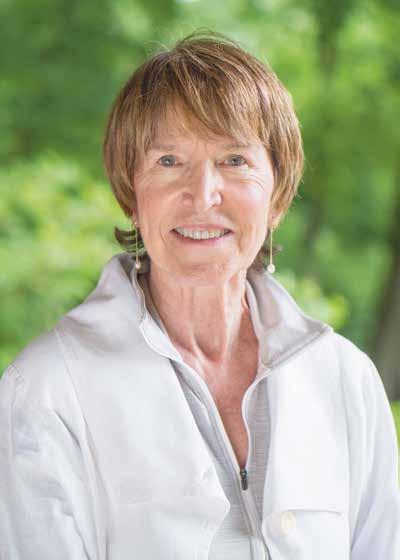
Libby Osgood, CND, PhD, PEng is Associate Professor of Sustainable Design Engineering at the University of Prince Edward Island, Canada.
The Peaceful Dragon School has provided the self-care practices of Tai Chi, and Qigong since 1990.
Lissa Perrin is a poet and former clinical social worker.
Shellie Powers is an Advanced Certified Teacher for Akashic Studies, teaching three certification levels: Practitioner, Advanced Practitioner, and Healing in the Akashic Records, for over a decade, using the Pathway Prayer Process© to access the heart of the Akasha.
The Prison Creative Arts Project brings those impacted by the justice system together with the University of Michigan community for artistic collaboration, mutual learning, and growth.
Merilynne Rush has been training end-of-life doulas since 2016, has an MS in Hospice and Palliative Studies, and co-founded and served as 1st President of the National End-of-life Doula Alliance.
Colette Simone has served as a psychologist, educator, and musician. The Ra Material/Law of One led her to Deep Spring Center in 2017. She serves as channel for Yeshua, Mary Magdalene, Anna, grandmother of Yeshua, and I AM that AM.
Bill Sullivan has a passion for transformation and has built his life’s work around awakening the power we all have inside to transform our lives from the inside out.
Judy Liu Ramsey is a shamanic teacher, professional animal communicator, and interspecies counselor with over 40 years of experience in counseling, teaching, and mentorship.
Kimberly Rieli, founder of Singing for Your Soul, supports clients internationally in healing through holistic voice work.
Marcia Haarer has been a therapist for more than 40 years. She has worked with clients who have severe trauma, anxiety, depression, and deep somatic experiences. Over the years she has learned to respect that there is always a reason that patterns of wounding become chronic and deeply embedded in our way of thinking, feeling, and acting.
Marcia offers a higly personalized approach tailored to each of her clients individual needs and sees individuals, couples, and families. She also holds group and teacher trainings in the Realization Process-a series of practices for opening the body, heart, and mind to non-dual reality. She can be reached at marciahaarer.com
Demo Rinpoche is Jewel Heart’s Resident Spiritual Advisor. He studied at Drepung Loseling Monastery in India under the supervision of the Dalai Lama and holds the highest monastic degree of Geshe Lharampa.
Gelek Rimpoche was the Founder and Spiritual Director of Jewel Heart. Tutored by the great masters in Old Tibet, Rimpoche’s command of western culture allowed him to convey the Tibetan Buddhist tradition with wisdom, kindness, and wit.
Hartmut Sagolla has been studying Tibetan Buddhism for over 30 years. Since 2002, he has served as a Program Director at Jewel Heart. He is a long-time Jewel Heart Instructor and Director of the Bloomfield Hills chapter.
7 Notes Natural Health is Ann Arbor’s premier destination for integrative bodywork, incorporating massage, sound therapy, energy work, and reflexology.
Janene Ternes graduated as a Spiritual Director in 2003 and is currently a supervisor for the Ignatian Spirituality Program at Manresa Jesuit.
Unity of Bay City is an inclusive spiritual community open to everyone. We offer a positive, practical, and progressive approach to spiritual living. As our name implies, we honor the universal truths that unite all spiritual paths.
Joe Walters has practiced Tai Chi Chuan for 30 years.
Gary Arthur Weidman is an armchair practitioner of metaphysical philosophy.

Lou Weir is a Certified Diamond Approach teacher, teaching groups and individuals online and in Ann Arbor. He is also a founding teacher of Insight Meditation Ann Arbor.
Suzy Wienckowski, Reiki Master, has over 40 years of experience in the healing arts. Her training includes study with two Masters initiated by Hawayo Takata and with Hiroshi Doi, a member of the original Usui Reiki Ryoho Gakkai in Japan. She is a Reiki Alliance Member.
Eve Wilson, UCM Reverend and Master Healer, offers cutting edge leadership for world healing and ascension. Award-winning author and blogger, 36 years training and certifying healer practitioners, currently training world healing and ascension workers.
Steve Wyse, is a musician, singer/songwriter, flutemaker, and intuitive.
Wasentha Young is a Master of Tai Chi and Qigong, a practitioner since 1968. She has also received formal instruction in Buddhist and Taoist mindful meditation styles; holds certificates in Acupressure, Five Element Practice, and has a master’s degree in Transpersonal Studies.
Celeste Zygmont has been involved with Deep Spring Center for nearly three decades. Taking part in teacher training programs Venture Fourth and Dharma Path, also serving on the DSC Board of Directors. She facilitates the Sunday and Tuesday online meditations.
If you are a holistic/spiritual/psychological growth practitioner in the area, but don’t regularly lead classes or workshops, you can still be listed for free in our online Holistic Resource Guide. List your practice and add your logo, photo, and even a short video. To claim your listing, please visit AnnArborHolistic.com
The Crazy Wisdom Community Journal • May through August 2024 • Page 103
A Spiritual Film in the Eyes of an Atheist
 by Audrey Hall
by Audrey Hall
My son, an enthusiastic fan of classic cinema, once tried to convince my mother to let him watch a movie called Stalker before he went to bed. Being a sensible woman, she refused to allow her eight-year-old grandson to watch a film with such a foreboding title. He tried to explain to her that “stalker” in this context didn’t mean a dangerous and unwanted follower, but instead described a guide through a magical area called the Zone wherein lies a room that grants wishes. My poor mother again refused him as this explanation made little sense and sounded made up on the spot. I don’t blame my mother at all for this. How was she to know this little boy was genuinely describing the premise of a classic Soviet film from 1979? The premise of Stalker, taken from the novel Roadside Picnic, is not the entirety of what makes it unique and uncanny. The way the film is made and how its story unfolds through its characters brought something new and mystifying to the film scene at the time of its release. What remains timeless to this day is the film’s raw and vulnerable pilgrimage into the depths of the human psyche, a reach toward the divine unlike anything we’ve seen since.
My son, an enthusiastic fan of classic cinema, once tried to convince my mother to let him watch a movie called Stalker before he went to bed. Being a sensible woman, she refused to allow her eightyear-old grandson to watch a film with such a foreboding title.
Pilgrimage as a concept is at the heart of the film’s premise. In more specific terms, the film follows three travelers into a sentient and surreal landscape known only as the Zone. At the center of the Zone is the Room, wherein one’s deepest desires can become manifest. The Zone itself is treacherous, and those who enter tend to disappear. This is where the “Stalker” comes in, a guide learned in the ways of the Zone who can lead pilgrims to the Room. In this journey, he takes a poet and scientist toward the Room, explaining the fickle, dangerous, and ever-changing nature of the Zone as they go. The film’s conflict lies largely in the dynamics between the three main characters as well as what they each experience internally.

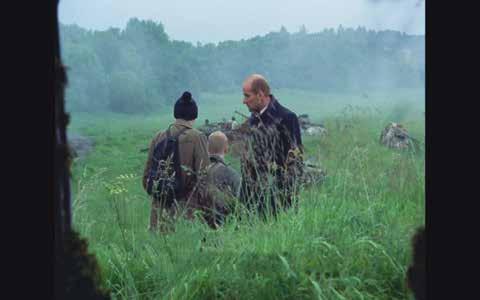
The film follows three travelers into a sentient and surreal landscape known only as the Zone. At the center of the Zone is the Room, wherein one’s deepest desires can become manifest.
Audience interpretation is simultaneously the film’s greatest strength and most glaring flaw as the production is geared largely toward maintaining ambiguity outside of what’s revealed through dialogue. It achieves this through open air and desolation that’s consistent between what we see and what we hear, and sometimes achieved through a deliberate incongruence of the two. Almost nothing is seen within the Zone that one would consider obviously surreal, save for a voice from nowhere issuing a warning to the poet, and a bird vanishing and reappearing. Both instances are brief but pivotal—sharp reminders to the audience that the Zone is truly as surreal as the Stalker insists. Aside from this, the backdrop of the film is mostly abandoned power plants, oscillating between closed, decrepit rooms and corridors and large, open fields of overgrowth and industrial ruin. The deeper the characters trek into the Zone, the more water becomes prominent, with rooms and open spaces flooded more and more. The sound design and score of Stalker is characterized by minimalism.

The empty space also exists in the film’s notoriously sluggish pacing, between its exceptionally long shots and meticulous lingering on each conversation, monologue, or introspection from the characters. One of the most brilliant and interesting scenes in the film is simultaneously its most boring and least engaging on the surface--a slow montage of each character’s facial expressions as they ride the railcar that enters the Zone with metallic noise of the railcar being all the audience can hear. To some, this film has been a deep source of inspiration and paints one of the most incredible and unique visions of a science fiction reality ever crafted. To others, it’s one of the most banal and dissatisfying films they’ve ever seen.
Audience interpretation is simultaneously the film’s greatest strength and most glaring flaw as the production is geared largely toward maintaining ambiguity outside of what’s revealed through dialogue.
The Crazy Wisdom Community Journal • May through August 2024 • Page 104
S t a l k e r
Movie Posters
All this said, the story that unfolds in the mind of the viewer holds depths as varied and rich as there are viewers willing to imagine what’s happening. The film’s story and aesthetics have left an observable imprint on film, music, and many other mediums of art and entertainment, examples including HBO series Westworld as well as films like Annihilation and Chernobyl Diaries.
While obviously there are the abstract and inconceivable portraits of the Zone itself one conjures in place of explicit visual information, there is a deeper and more disarming abstract within the connections formed between the characters as well as the Zone itself. The Zone operates as a device with which each character’s true nature is drawn out in a raw and powerful honesty, each facing themselves on their way to the Room. The wishes granted by the Room are not commands from a person’s mouth, but what lies in the truth of their heart. As the viewer watches these characters experience this disambiguation of their spirit, a step beyond the story itself can be taken, wherein we can turn our empathy toward these characters on ourselves. This onus on the viewer can become a bond to the film not in the interest of being entertained, but as a means of becoming more honest in how we connect (both inwardly and outwardly) with ourselves. The film is an invitation, a mirror granted to each member of the audience with which we can analyze our own motives and biases. There is a call to action to peel away the superficialities within which we hide from others as well as ourselves.
These spiritual depths may be entirely subjective, or even myopic in terms of the film’s intentions, but that’s the beauty of art like this.
It is in this way I see the divine within the subtle depths of the film. I am a materialist, but I find what others describe as a spiritual connection to other people and the world around me through this process of raw honesty and vulnerability with oneself. The film also deliberately evokes a tone of dualistic spirituality, directly with recitations from the Bible and Tao Te Ching, as well as subtly with the atmosphere and psychological journeys of the characters into this realm of unadulterated truth. The superstitious Stalker speaks fearfully of the Zone’s judgment as the poet soliloquizes about existential dread, famously wearing a faux crown of thorns at one point to hammer home the religious angst felt throughout the film. The pilgrimage of the characters reaches a powerful denouement, both simple and clear as day to the watcher who invests completely in the abstract depths of their difficult path. There is only one enigma left to face: the Room itself.
At this film’s resolution, I felt what so many claim to feel when washed in the blood of the Lamb: a deep cleansing. The tranquility of it was a spiritual height I’d never experienced before, a moment of pure peace in the final cathartic release from the film’s carefully curated suspense. I watched in awe as a gentle rain filled the flooded Room with all three characters sitting outside, having finally reached their destination but choosing not to enter. Having faced the truth within themselves, they surrender their desires. They need no wish granted for they finally understand it holds neither peace nor absolution. Their absolution is their surrender. They have been cleansed by the waters of the Zone.

These spiritual depths may be entirely subjective, or even myopic in terms of the film’s intentions, but that’s the beauty of art like this. No matter what medium an artist works with, the most fundamentally important role art plays in our lives is opening us up to other people.. Stalker takes this a step further with its many avenues toward having a truthful relationship with ourselves and others as well as what lies on the surface in its unique production and storytelling. Our connection to the filmmakers and the audience takes on a multidimensional shape, each parallel reality within each viewer’s psyche explored intimately through the film and its many interpretations. Within my atheistic heart this film has conjured up a connection to something larger than myself, and though I may not recommend it for everyone, I wish that everyone could feel what I have felt in watching it over and over again.

6,500 copies of The Crazy Wisdom Community Journal are distributed to more than 235 locations in the Ann Arbor area, including Crazy Wisdom Bookstore, Castle Remedies at the Parkway Center, Kerrytown, Schuler Books, the Zen Temple, Sweetwaters, Pharmacy Solutions, Michigan Union, the Better Health Store, North Campus Commons, U-M, EMU, WCC, Arbor Farms, the Center for Sacred Living, Complete Chiropractic, the Lighthouse Center, Jewel Heart, Tsogyelgar, York, Argus Farm Stop, Michigan Theater, Seva, Booksweet, Clark Pharmacy, and the Weber Center.
We also distribute to the offices of dozens of doctors, holistic health care providers and therapists.
If you'd like us to bring copies of The CW Community Journal to your office, studio or center, please email: bill@crazywisdom.net.

Ann
Face
The Crazy Wisdom Community Journal • May through August 2024• Page 105
The Crazy Wisdom Community Journal?
Where Do We Distribute
734-436-8991
N. MAIN STREET
ARBOR, MI 48104
+
Light Therapy Bed
Tarot
Sha
Reflexology
KWESTSKINBODYSPIRIT.COM
415
ANN
Skin Rejuvenation Organic Facials Massage Pedicure
Manicure LED
Reiki,
Gua
Facial
Yoga, Kundalini
Metaphysical Workshops
Yoga +
Gua Sha Classes
Arbor’s
Holistic
K .WEST
BODY SPIRIT
Luxury
Spa
SKIN
Astrologically Speaking
Taking it Personally—The Inner Planets: Mercury, Venus, & Mars
 By Catherine Carlson
By Catherine Carlson
In astrology, the three planets closest to earth—Mercury, Venus, and Mars— are known as the inner planets, or personal planets. These three planets, along with the Earth, are all in the same neighborhood, and affect us personally.
Mercury: Not Just a Lot of Hot Air
First in the lineup is mighty Mercury. The orbit of this firecracker of a planet is nearly as fast as the sun, and in a birth chart will always be in the same sign as the sun or the sign on either side of it. Known as the winged messenger in mythology, Mercury represents communication in all forms. Mercury is all about how we use our voice and express ourselves such as through talking, writing, or even singing. Mercury’s influence has increased as technology has grown. Mercury represents learning as well, so places like schools and colleges are mercurial locations. Mercury is also connected to modes of transportation, short journeys, and siblings. A person’s Mercury placement may present as a lightning-fast mind, great intelligence, or organized thinking. It can also indicate a strong intuition.
Mercury rules the signs of Gemini and Virgo. If you are a Gemini or a Virgo sun sign, or have a lot of planets in these signs, communication is going to be theme in your life. Maybe you learned to talk early or developed an appreciation for the written word. You could have a gift for debate, public speaking, a career in radio, or other media. Gemini’s influence can be very social, highly curious, with a variety of interests and knowledge—a natural librarian. Virgo’s influence is refined and detail oriented. Virgo’s gift is in analyzing and organizing information. These significations can also become activated during Mercury’s normal orbit.
In 2024 Mercury will travel through all 12 signs, beginning and ending in Sagittarius.

Known as the winged messenger in mythology, Mercury represents communication in all forms.


How Venus shows up in our lives is in what we love, and, of course, who we love.
Venus: She’s Got It!
“A goddess on a mountain top
Burning like a silver flame
A summit of beauty and love
And Venus was her name.”

I always loved the song “Venus” by Shocking Blue, although I’m partial to the remake by Bananarama. Venus represents beauty and love—the archetypal female and all that goes along with her—just as the lyrics suggest. How Venus shows up in our lives is in what we love, and, of course, who we love. How is this love expressed? Ask yourself: Where do you like to shop? What do you like to do if given abundant time and energy? These tell you the qualities of your personal Venus energy. Do you love to buy books? Or are you first in line for the latest phone or new technology?
Someone with a significant Venus placement may indicate they have been blessed with a beautiful physique, or it can mean they are warm and friendly. Venus can represent the women in our lives and the significance and quality of these relationships. Maybe you are very close to your sister, or have a female best friend that you’ve had since kindergarten. Venus is also aligned with finances and can indicate a positive financial influence. It could present as being very profitable and successful.
The thermodynamics of the surface of Venus lends itself to growth. This is why it is aligned with women and fertility. The energy of Venus is receptive and welcoming and is considered to have a positive and advantageous influence. This means, even in difficult times, Venus is going to have a positive effect.
Venus rules Taurus and Libra. If you have your sun or other planets in either of those signs, you will relate to Venusian qualities, but they can also be activated by Venus transits. Taurus’s influence is going to be grounded with strong values, seeking comfort by being focused on finances and the material world. This sign shows up through Venus as having an appetite for the earthly pleasures of food, wine, and plush surroundings like soft blankets or velvet drapes. Libra’s influence expands on this and seeks comfort through harmony and relationships, always trying to create balance. A person could have a knack for art and design, creating beautiful spaces, or a talent for hair or makeup.
In 2024 Venus will travel through all 12 zodiac signs visiting Sagittarius, Capricorn, and Aquarius twice—once at the beginning of the year and again at the end.
The Crazy Wisdom Community Journal • May through August 2024 • Page 106

How Mars shows up in our life is in the quality and quantity of our energy and how it is expressed.

Mars: Seeing Red
Author John Grey wrote his best-selling book series beginning with Men are from Mars, Women are from Venus. This title brilliantly conveys the differences and polarity between these two planets, each sitting on different sides of earth. Mars is an equal and opposite energy to Venus.
Named after the Roman god of war, Mars represents the archetypal male energy, and all that energy encompasses, as well as physical energy in general. How Mars shows up in our life is in the quality and quantity of our energy and how it is expressed. What are we passionate about? What gets our blood moving (or even boiling)? It’s this same energy which lends itself to competitionor, in its most extreme state, war. Are you someone that has to have their daily workout? Or are you less assertive and more reserved?
Mars is a hot, dry, desert-like planet, not conducive to growth. Mars is action oriented—this is the same male energy required for conception. The energy of Mars is sharp and represents tools like knives. A surgeon could have a strong Mars influence, or someone could speak with a sharp tongue. Mars is considered to have a malefic influence, meaning difficult or disadvantageous. In the best-case scenario, it’s going to push you; in the worst it may make you angry.
Mars rules the signs of Aries and Scorpio. If you relate to Martian qualities, Mars probably has a strong influence for you natally. The Aries effect of Mars is going to be fiery--like turning on the ignition and going full-speed ahead. Think athletes, crusaders, and those that always like to have an opponent. Mars comes through the sign of Scorpio in a powerful, but less obvious way, behind the scenes. This is the energy of strategy and the long game with energy reserves and resiliency. Mars is an external energy, so it is more visible. You may also feel the energy of transiting Mars as surplus of energy in your body giving you a strong drive and competitive edge. This is always a time to think twice before you act and speak.
In 2024 Mars will journey through Sagittarius, Aquarius, Pisces, Aries, Taurus, Gemini, Cancer, and Leo.
Unlike the rest of the planets, the orbits of Mercury, Venus, and Mars cycle around the sun many times in an average lifetime and now you know they are not just “out there,” but are personally connected to each and every one of you.

I don’t believe in astrology; I’m a Sagittarius and we’re skeptical.
Arthur C. Clarke

The Crazy Wisdom Community Journal • May through August 2024• Page 107
Spirit Seeds
 By Triana Jones
By Triana Jones
Welcome to Spirit Seeds! I’m Triana, your guide through this journey of inquiry. I am a single mother, a Wounded Healer, Eclectic Witch, and practicing Spiritualist. The last few years I have spent in the pursuit of knowledge which I believe is one of the master keys of life. I received my first oracle deck from my grandfather sixteen years ago and have been reading cards professionally for the past seven years. In 2023, I was certified in Quantum Healing Hypnosis Therapy and Herbalism.
In this new column, we’ll embark on a journey of holistic exploration, delving into ancient practices and unraveling the enigmas of existence. Whether you’re a seasoned enthusiast or a curious newcomer, this column offers a platform for deepening your understanding and expanding your consciousness. Join me as we navigate this fascinating terrain together, where your questions and perspectives are not only valued but essential to our collective growth. Are you curious about a certain metaphysical subject or practice? Seeking advice or perspective on a spiritual or holistic matter? Submit your questions at AskSpiritSeed@gmail.com and have a chance to be featured in our next issue.
What are the most effective techniques for activating a crystal grid, and how do these techniques vary based on the grid’s purpose (such as healing versus protection)?
Activating a crystal grid is super easy and involves harnessing the energies of crystals to achieve specific intentions. The effectiveness of this process greatly depends on the grid’s purpose. For healing, I recommend cleansing your crystals with sage smoke or placing them under running water (first,check the gem’s compatibility with water) to rid them of any stagnant energies. Then, arrange the crystals in a geometric pattern, focusing on your intention for healing. Use a clear quartz or selenite wand to connect the crystals, envisioning a flow of healing energy throughout the grid. Place a central stone, like amethyst or rose quartz, as a focal point. Take a moment to ground yourself and set your intention. What is it that needs healing? Project that intention into the entire grid from your third eye. Visualize the healing happen, and this will program the crystals to your intention.
For protection, a different approach is needed. Begin by grounding yourself through meditation or deep breathing. Choose protective stones like black tourmaline or obsidian and arrange them in a circle or a shield-like formation. Visualize a powerful energy barrier emanating from the crystals, creating a protective shield around you or your space.
In both cases, your intention, focus, and intuition are key to activating the grid successfully, and these techniques can be adapted to suit various purposes from manifestation to spiritual growth. Crystal grids can be left for however long you need them as the effects last as long as the grid stays in place; but, they require maintenance with regular cleansing of the crystals and space around the grid.
What are some examples of sacred sounds and vibrations? How can I incorporate sound frequencies into my spiritual and physical healing practices?
Healing frequencies hold potent effects on well-being. 432 Hz assists in reducing stress, fostering relaxation, expanding awareness, and forging a stronger connection with nature and the universe. It aligns with the Earth’s vibrations and its ability to nurture harmony. This frequency aids in emotional healing and releasing negativity. 528 Hz, the “DNA Repair Frequency,” also known as “The Miracle Frequency,” fosters cellular renewal, enhances immunity, and elevates energy levels. Combined with visualization, this frequency aids in physical healing. Known as “The Love Frequency,” 639 Hz is associated with the heart chakra and helps release negative emotions and thoughts, improving relationships, reducing stress, and enhancing creativity. By incorporating this frequency into your daily routine, you can promote harmony, emotional wellbeing, and overall health. “Spiritual Order Frequency,” 852 Hz, stimulates the Third Eye, enhancing intuition and spiritual insight. 256 Hz grounds the Root Chakra, fostering stability and connection. Select frequencies aligning with your goals and explore guided meditations or music compositions. Combine them with visualization for heightened effects. Trust your intuition for a unique healing journey.
Spotify and YouTube are great resources to find these frequencies to listen to for free. Check out The Healing Power of Sound: Recovery from Life-Threatening Illness Using Sound, Voice, and Music, by Dr. Mitchell L. Gaynor, to read more on the topic.
Is there scientific evidence for the existence of Parallel Dimensions and Alternate Realities?
The concept of parallel dimensions and alternate realities sparks deep contemplation. Scientific evidence may be limited, but theoretical frameworks and phenomena hint at their existence. The double-slit experiment demonstrates that particles like light can behave as waves and particles simultaneously. When light passes through two slits, it creates an interference pattern, indicating wave-like behavior. However, when scientists attempt to observe which slit the particles pass through, the interference pattern disappears, revealing particlelike behavior. It’s mind-blowing when you think about it. This experiment underscores the puzzling nature of quantum mechanics, where particles exhibit dual behavior until observed. Check out Double Slit Experiment Explained! by Jim Al-Khalili on YouTube for an in-depth explanation.
Quantum entanglement implies interconnected realms. This theory suggests particles can become connected in a way that one particle instantaneously influences the state of another, regardless of the distance separating them. Altered states of consciousness reveal alternate realities, as experienced through meditation or near-death experiences. Spiritual traditions emphasize higher planes and realms, so many have a story of what lies on the other side. While traditional science lacks definitive proof, quantum physics, and subjective experiences suggest the existence of parallel dimensions. This concept bridges the gap between science and spirituality inviting ongoing exploration.
How do belief systems and social conditioning influence the success or failure of manifesting intentions, and what strategies can be employed for deprogramming oneself?
Belief systems and social conditioning play a pivotal role in the manifestation process. Our deeply ingrained beliefs and societal norms often create subconscious barriers that either hinder or facilitate our ability to manifest intentions. To succeed in deprogramming oneself, it’s essential first to become aware of these limiting beliefs. Self-reflection, meditation, and journaling can aid in identifying these thought patterns. Once recognized, replace these limiting beliefs with empowering ones that align with your desired intentions. Affirmations, visualization, and daily practice of positive thinking are potent tools for this transformation. Surround yourself with supportive and like-minded individuals who resonate with your aspirations, as they can reinforce the shift in your belief system. By consistently working on reshaping your inner landscape, you pave the way for a more successful manifestation of your intentions, free from the constraints of outdated beliefs and conditioning.
Triana Jones is certified in Quantun Healing Hypnosis Therapy and Herbalism and is the founder of Spirit Seeds, a virtual learning space. She lives in Ypsilanti with her teenage son.
The Crazy Wisdom Community Journal • May through August 2024 • Page 108








Naturopathy (each year 600 hours)
Natural Health Educator.........................1st Year
Natural Health Therapist........................2nd Year
Natural Health Practitioner.....................3rd Year
Certified Naturopath...............................4th Year



4th Year graduates are eligible for Doctor of Naturopathy National Test & Title
Massage Therapy
Therapeutic Bodywork Practitioner...1 Year
Holistic Doula Practitioner
Certificate Course.......3 Classes



Diploma Course.......7 Months
All Classes Meet on Weekends Fri: 5-9pm and Sat & Sun: 9am-6pm
Naturopaths: 1 per month - Massage: 2 per month
Individual Classes:
Herbology - Aromatherapy - Nutrition
Live Food Preparation - Light Healing Touch

Reflexology - Homeopathy & Much More (989) 773-1714


















































25 Years of Experience Licensed and Accredited
Over
Pleasant, MI
~ Belong! Explore! Become! Find Your Way at The Institute!
all the available
of study and apply online at: naturopathicinstitute.org
~ Mount
contact@naturopathicinstitute.org www.naturopathicinstitute.org
Explore
programs

































































































 By Hilary Nichols
By Hilary Nichols























 By Marie Duquette
By Marie Duquette



 By Julie Woodward
By Julie Woodward

 By Sandor Slomovits
By Sandor Slomovits















































































 —Robin Robinson
—Robin Robinson


 Article
Article
























 By Sandor Slomovits
By Sandor Slomovits

 By Grace Pernecky • Photos by Edda Pacifico
By Grace Pernecky • Photos by Edda Pacifico

























 By Hilary Nichols
By Hilary Nichols

















 By Crysta Coburn
By Crysta Coburn







































 By Ellen M. Craine
By Ellen M. Craine


 By Thea Lona Hassan
By Thea Lona Hassan








 By Kaili Brooks
By Kaili Brooks











 By Amy Lagler
By Amy Lagler








 By Christine MacIntyre
By Christine MacIntyre



































 By Judy Ramsey
By Judy Ramsey







 By Miriam Dowd-Eller
By Miriam Dowd-Eller



























 by Audrey Hall
by Audrey Hall






 By Catherine Carlson
By Catherine Carlson








 By Triana Jones
By Triana Jones


























































